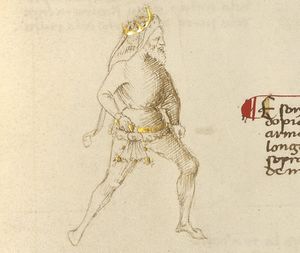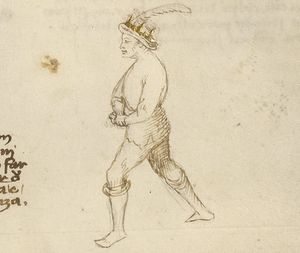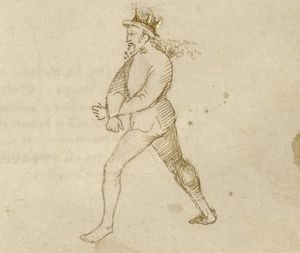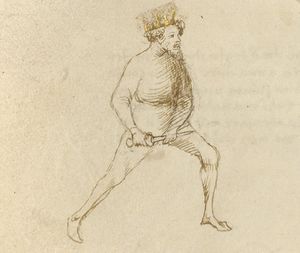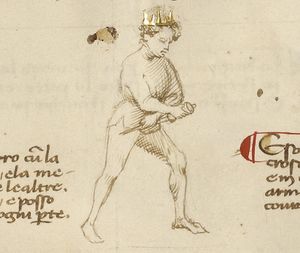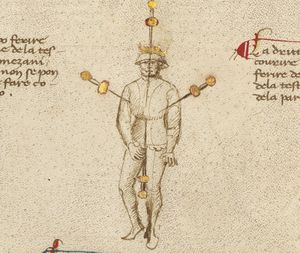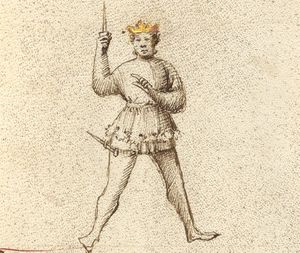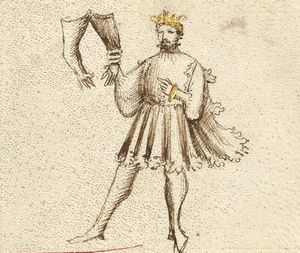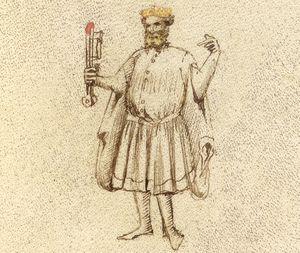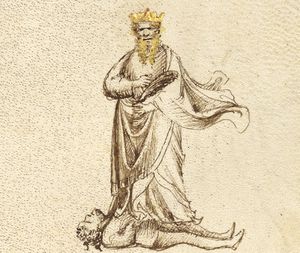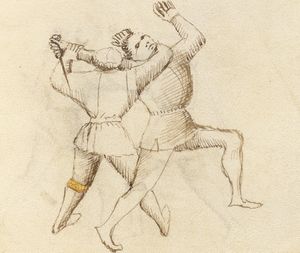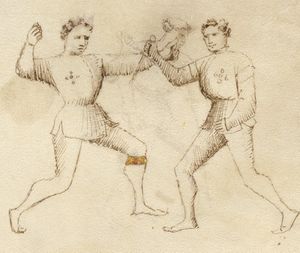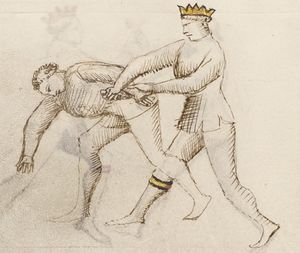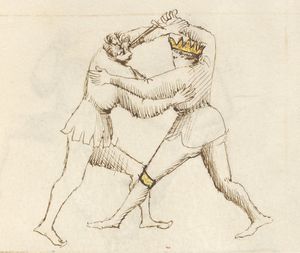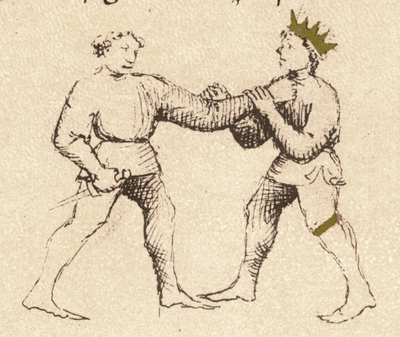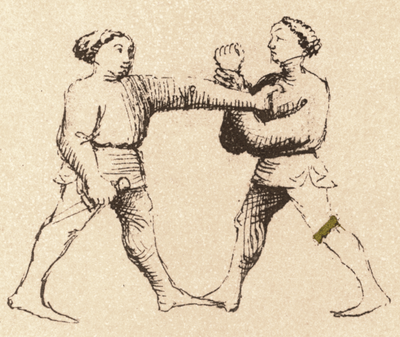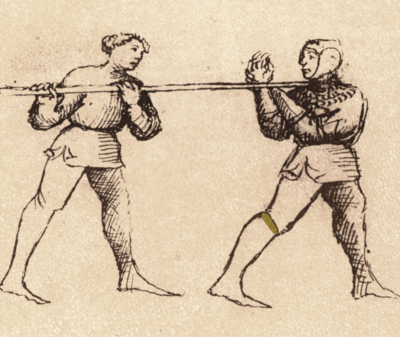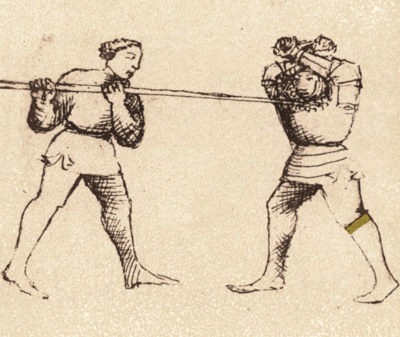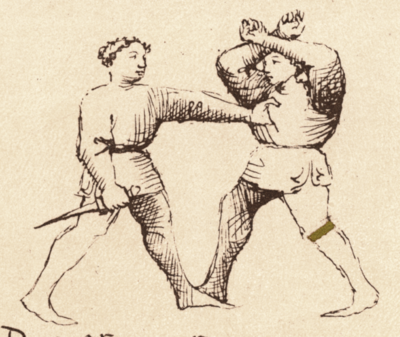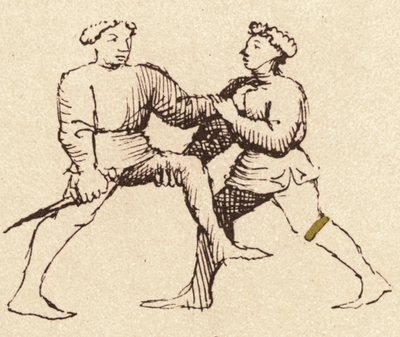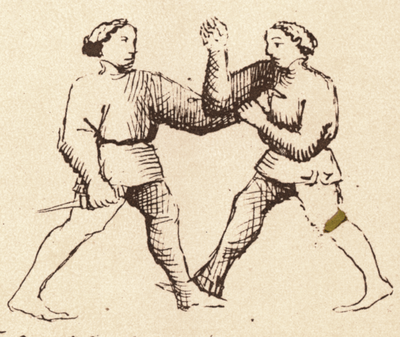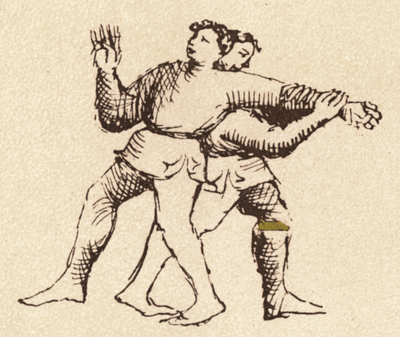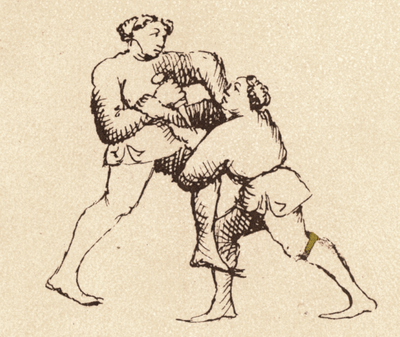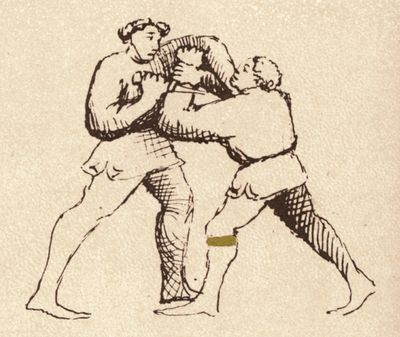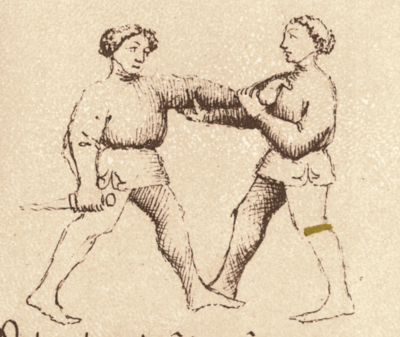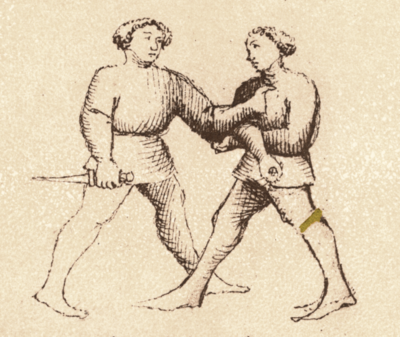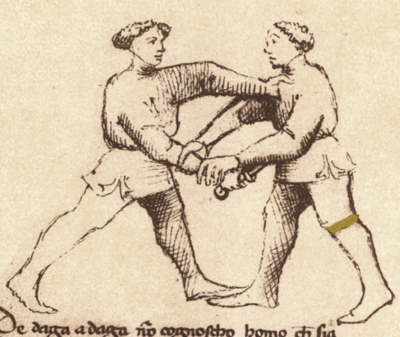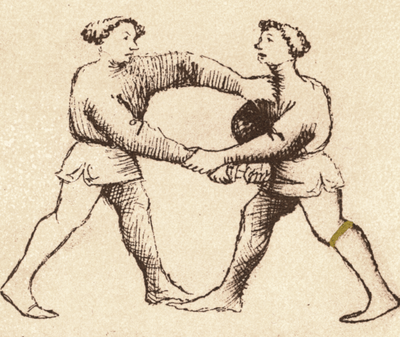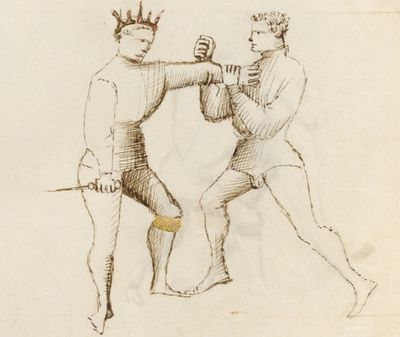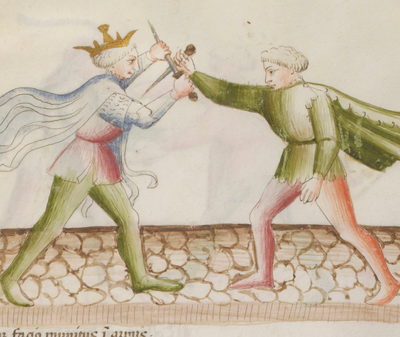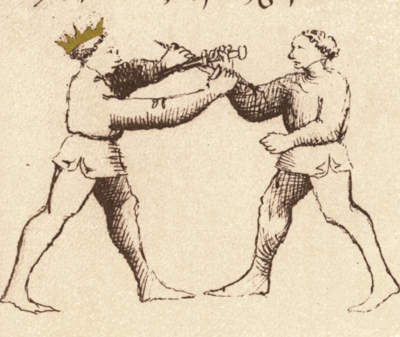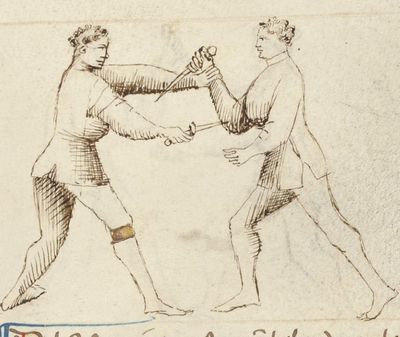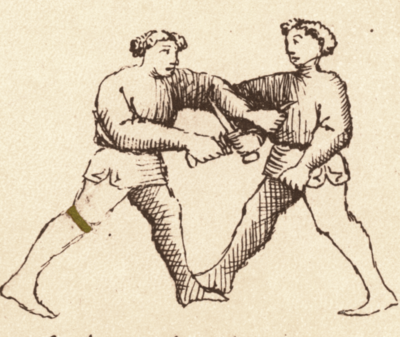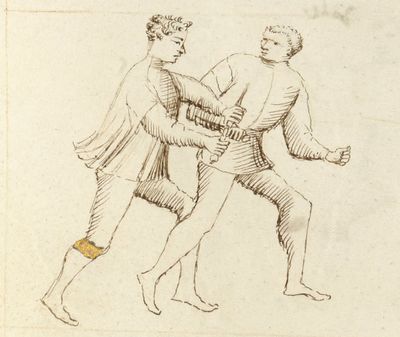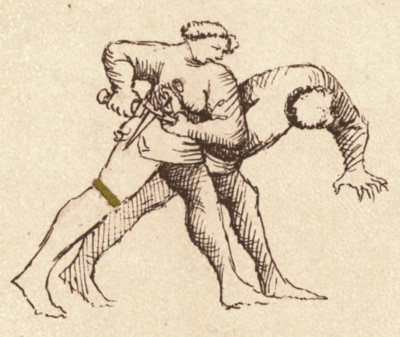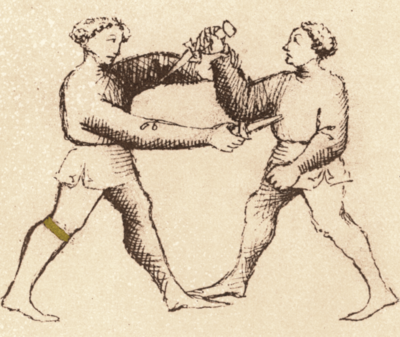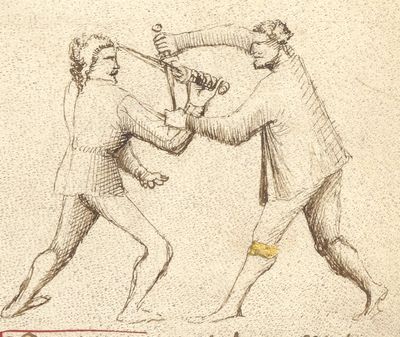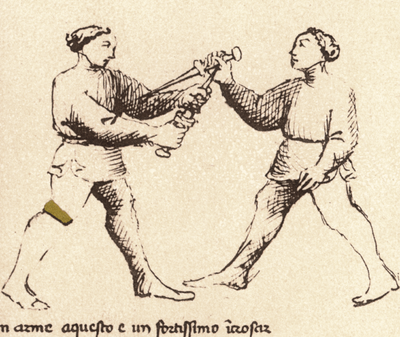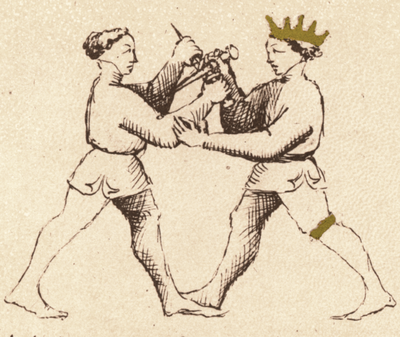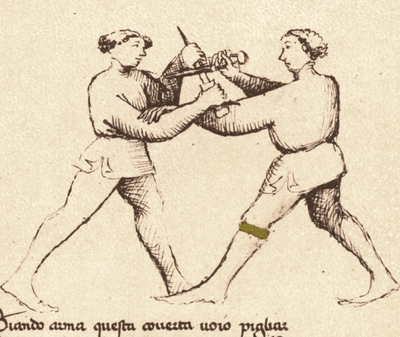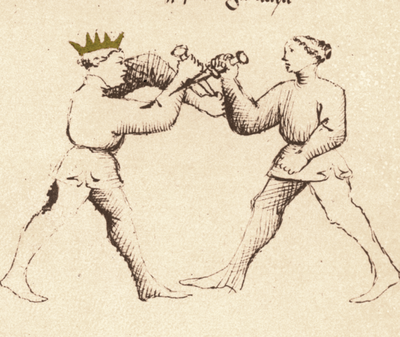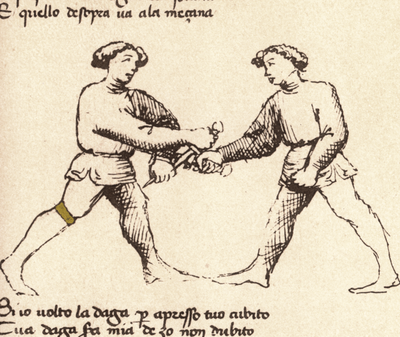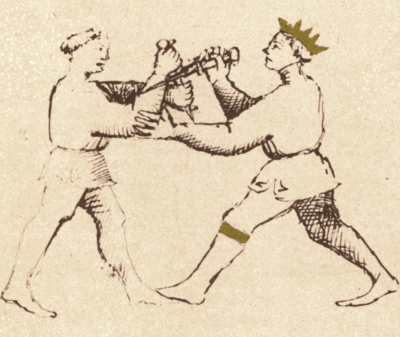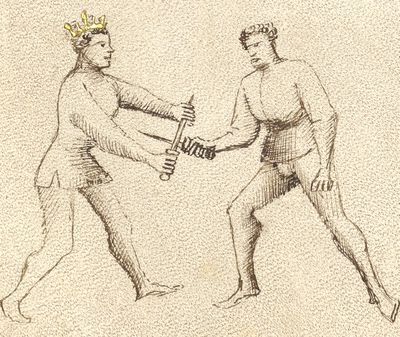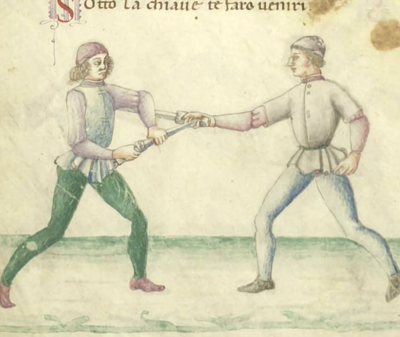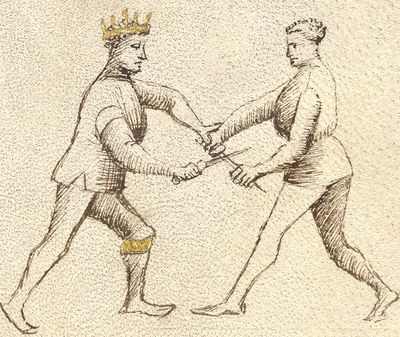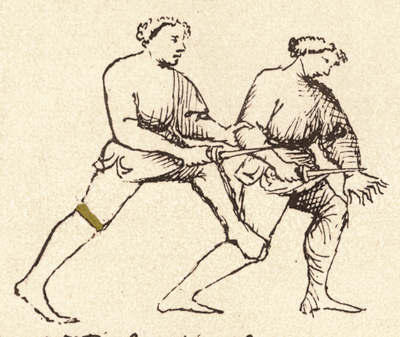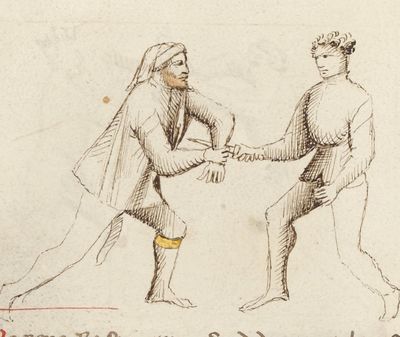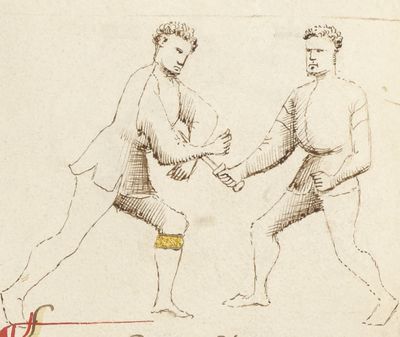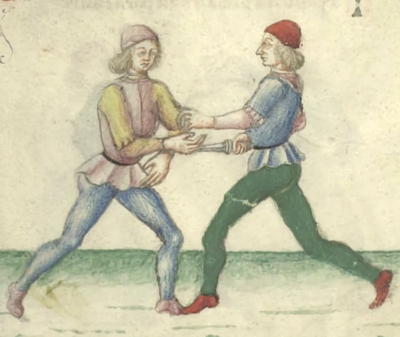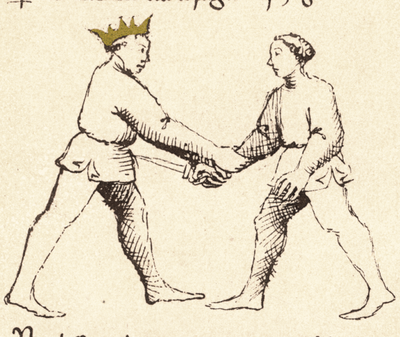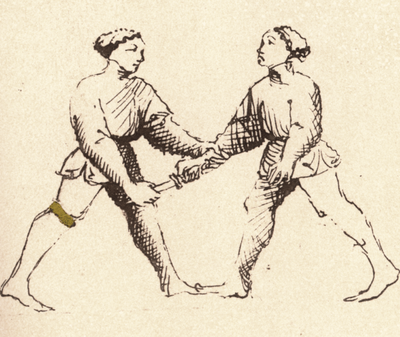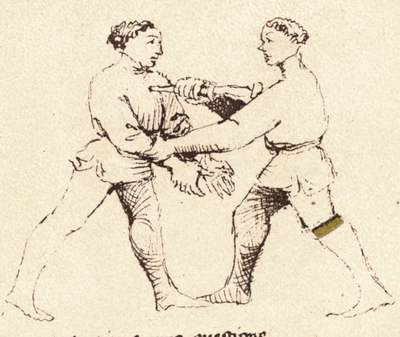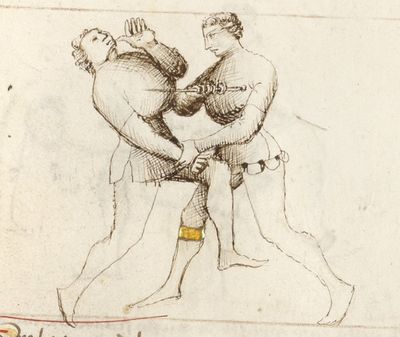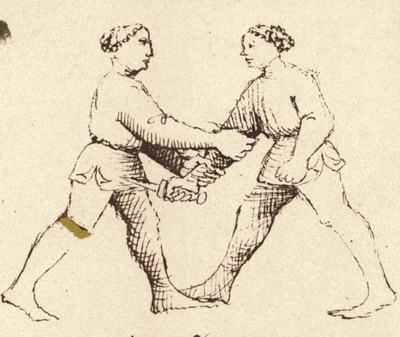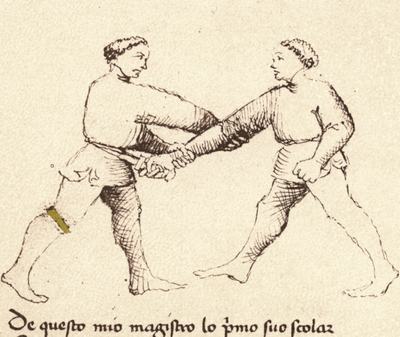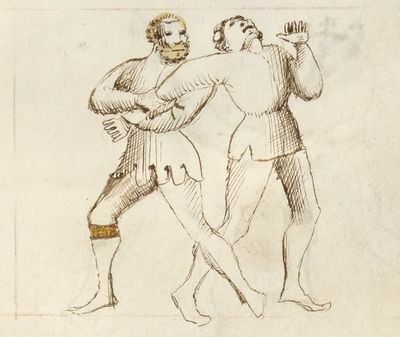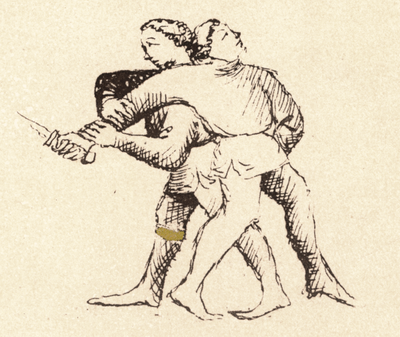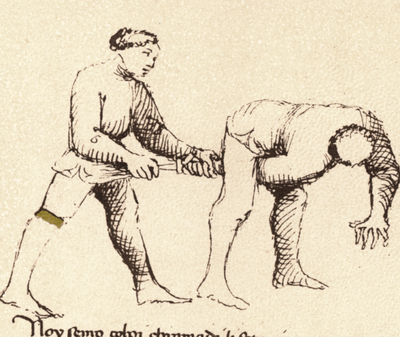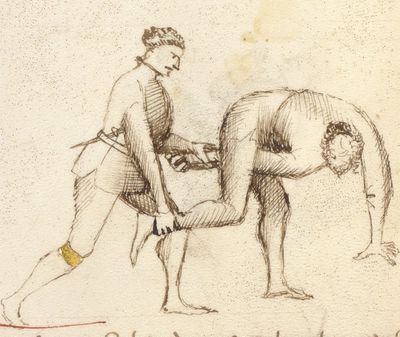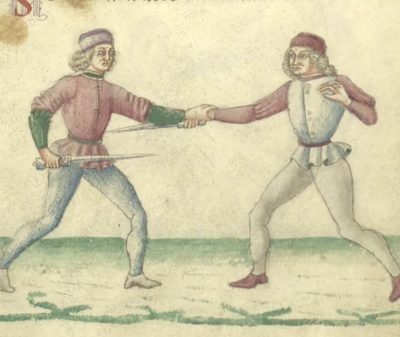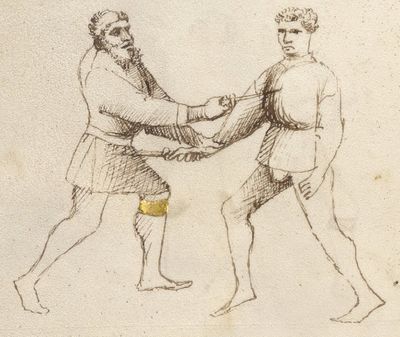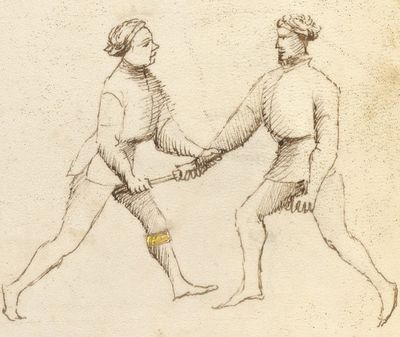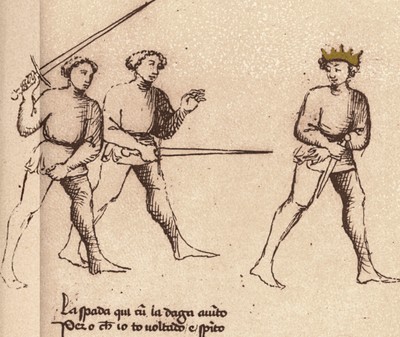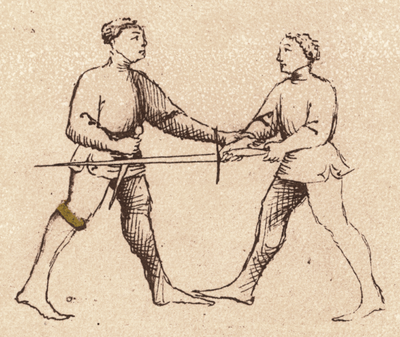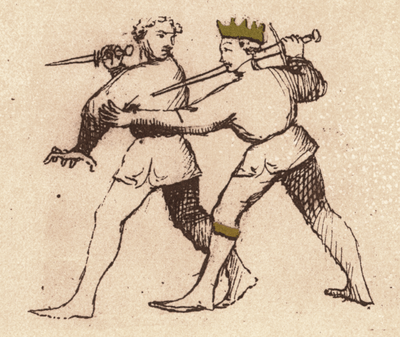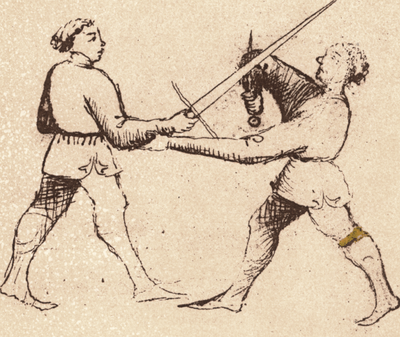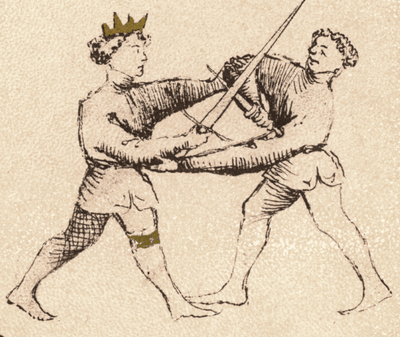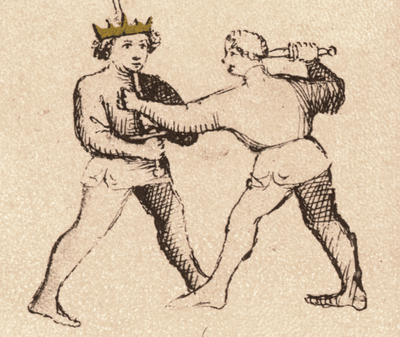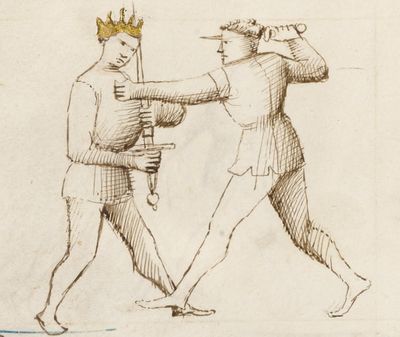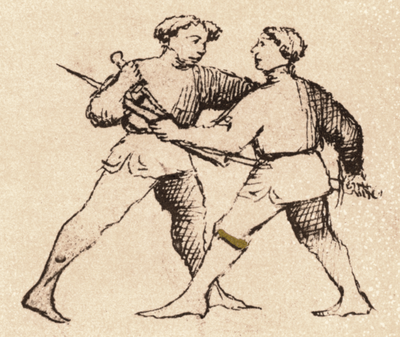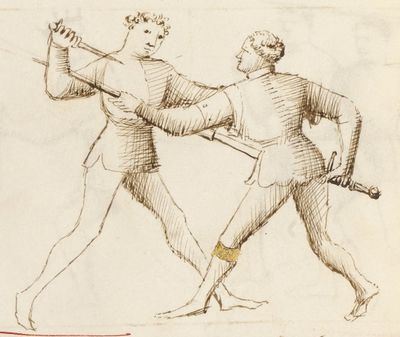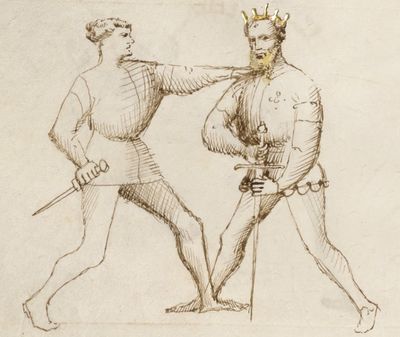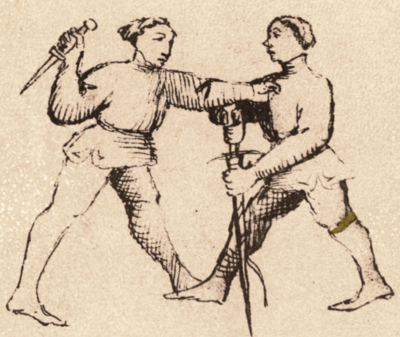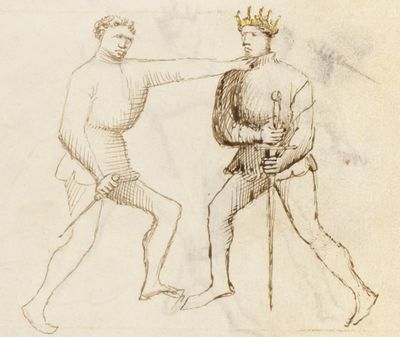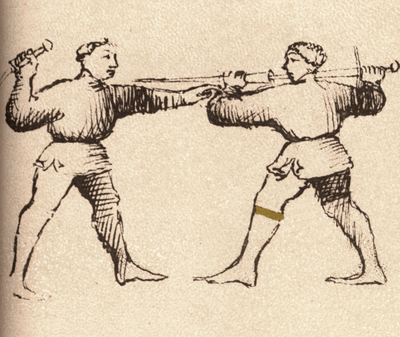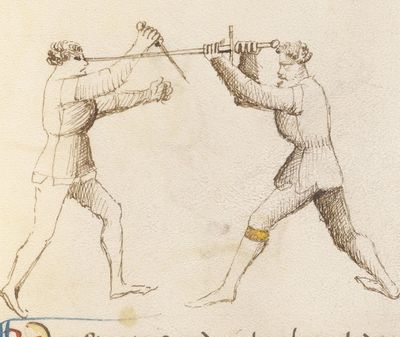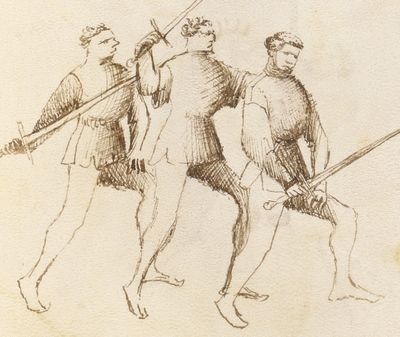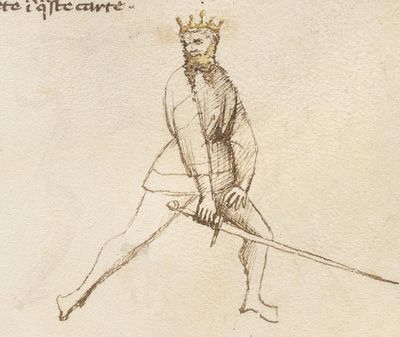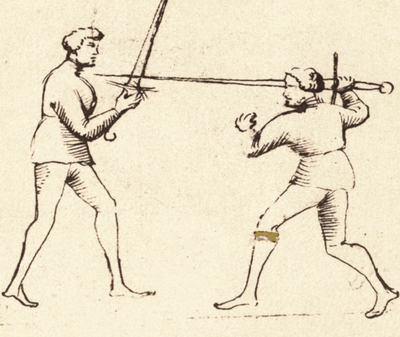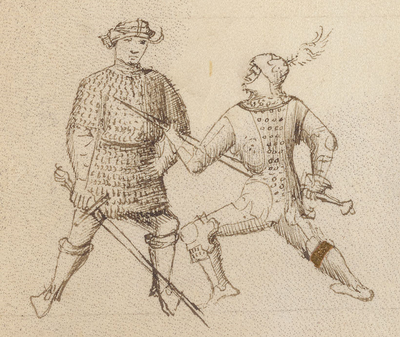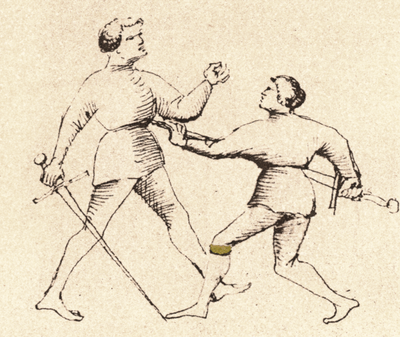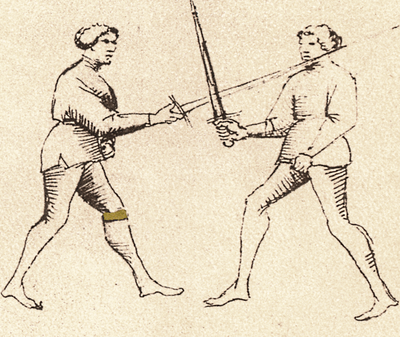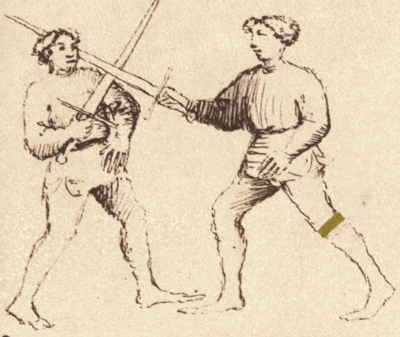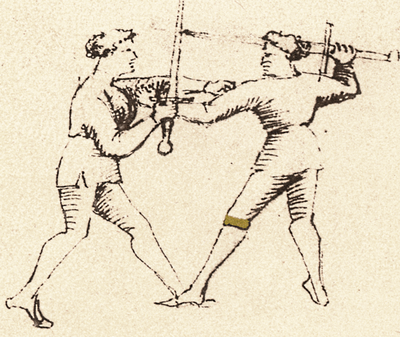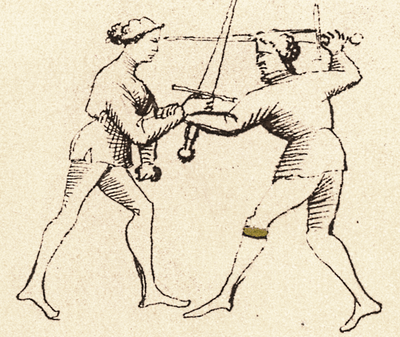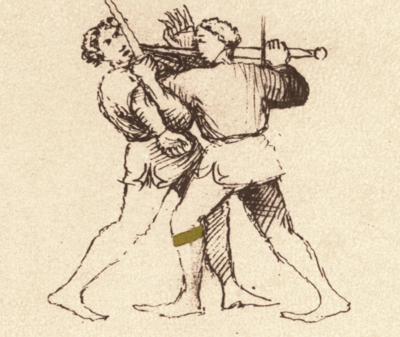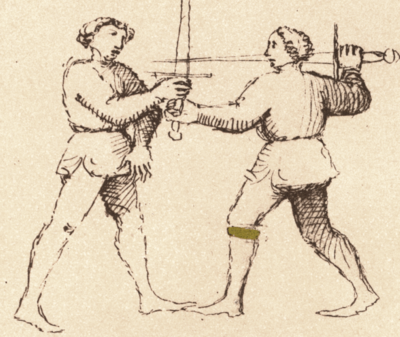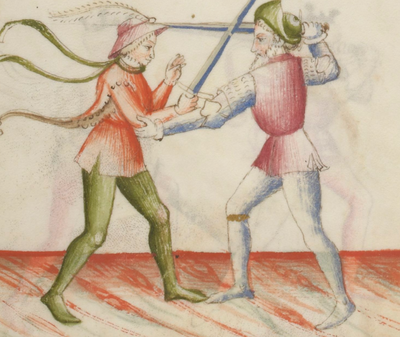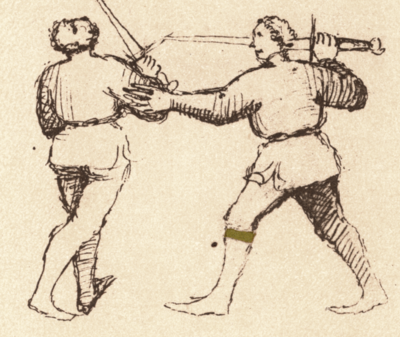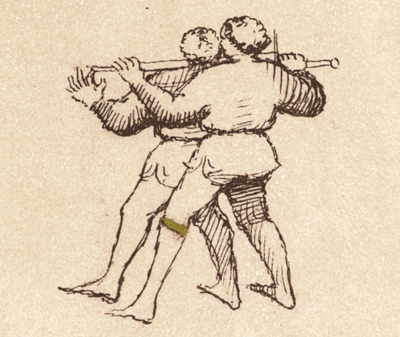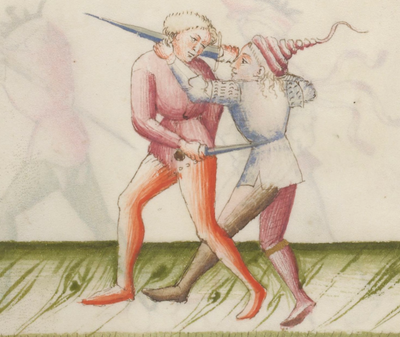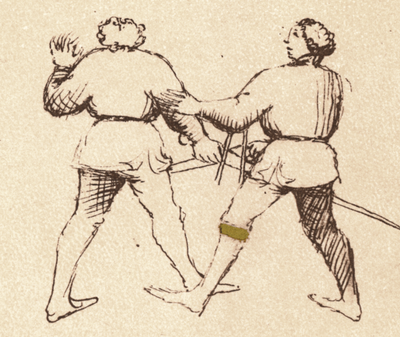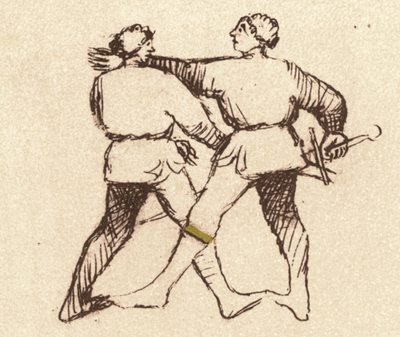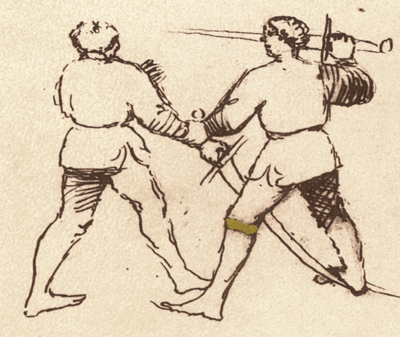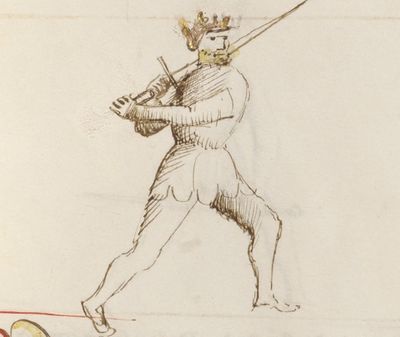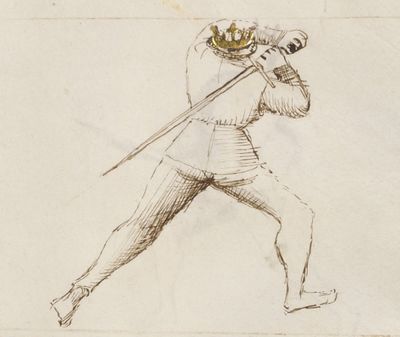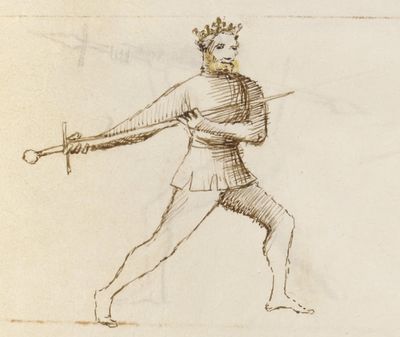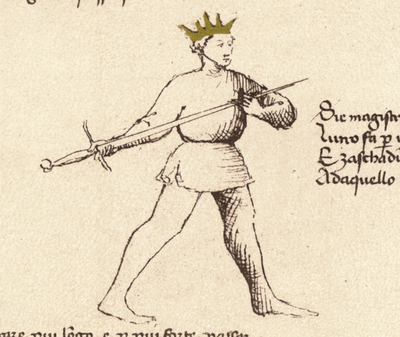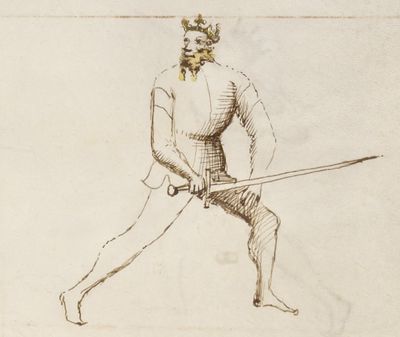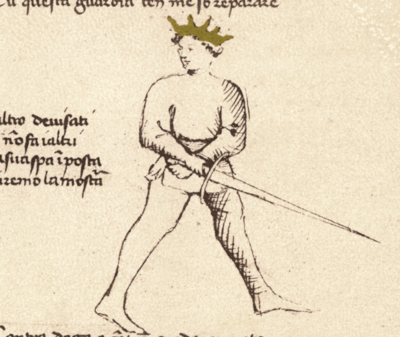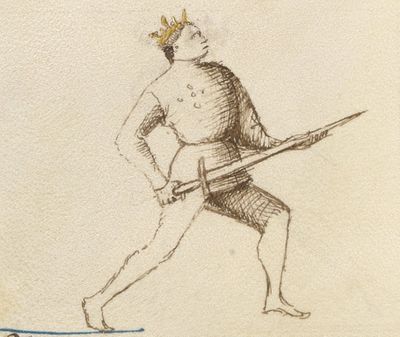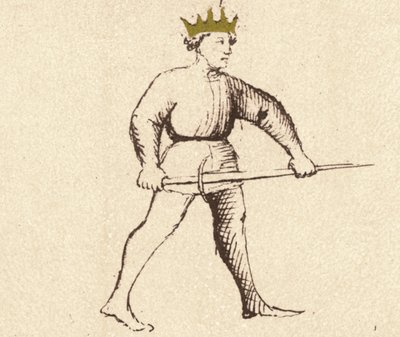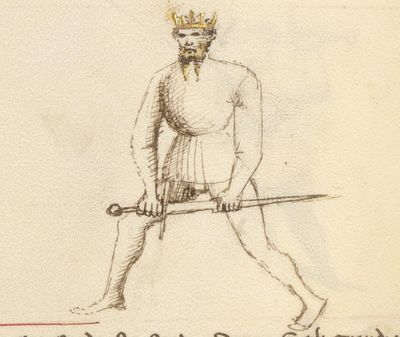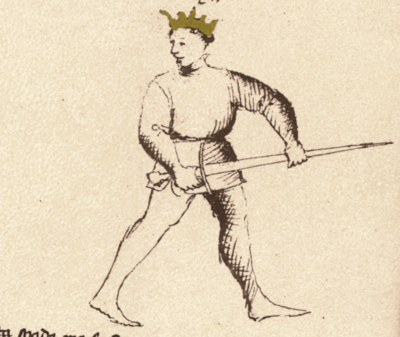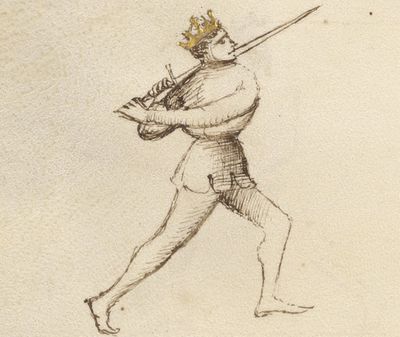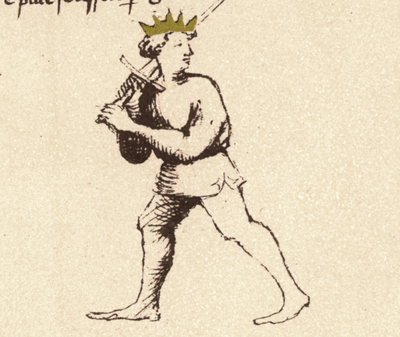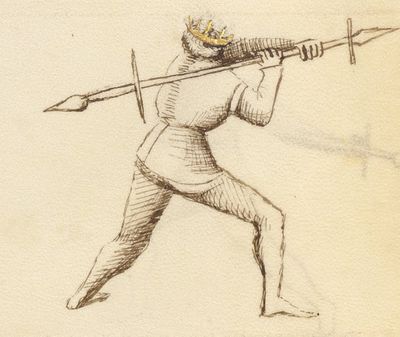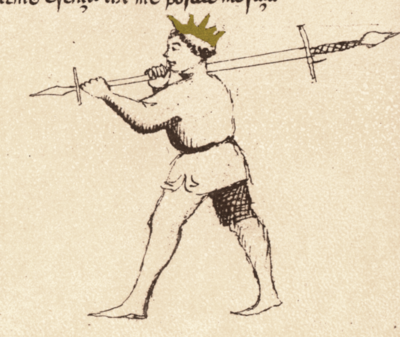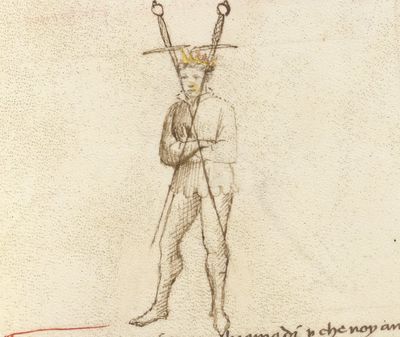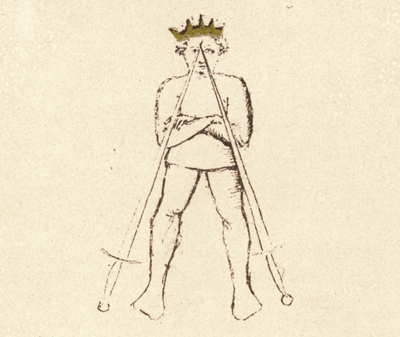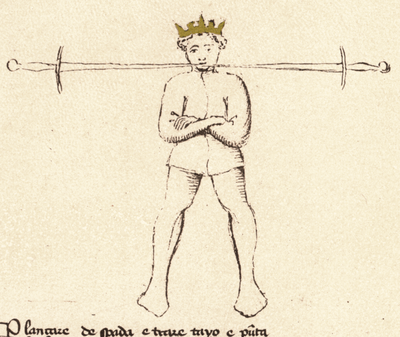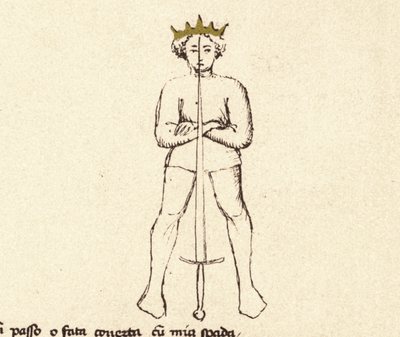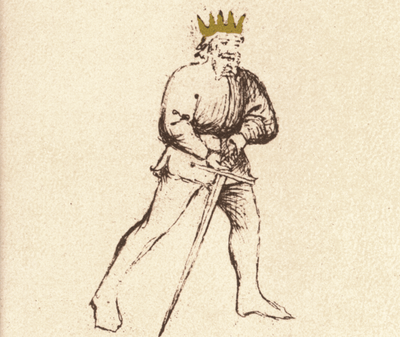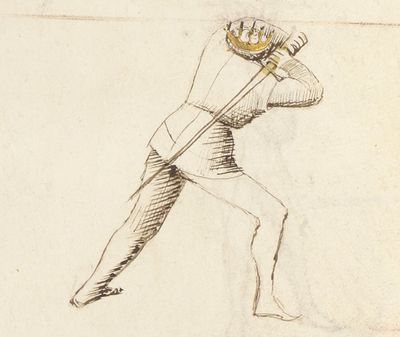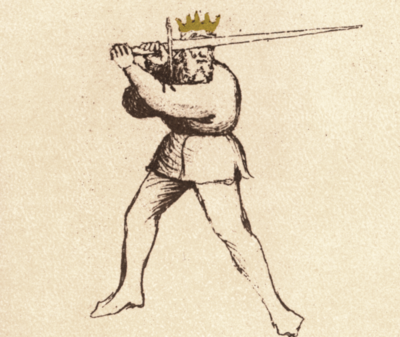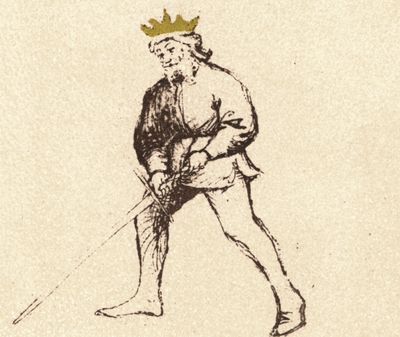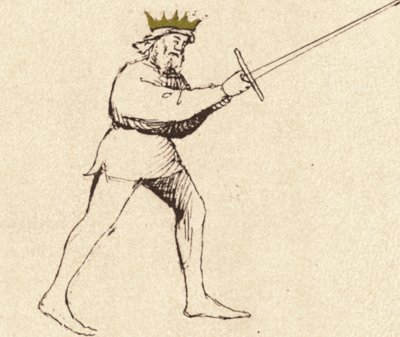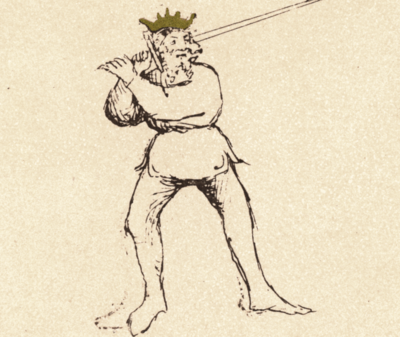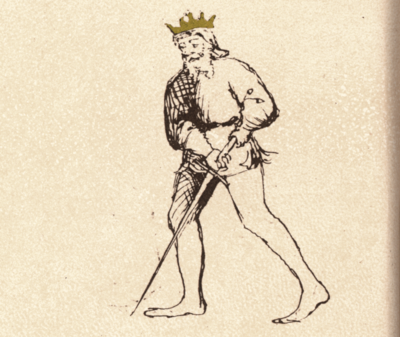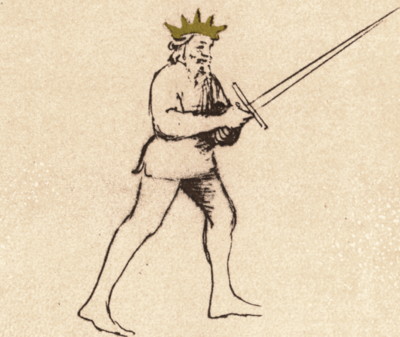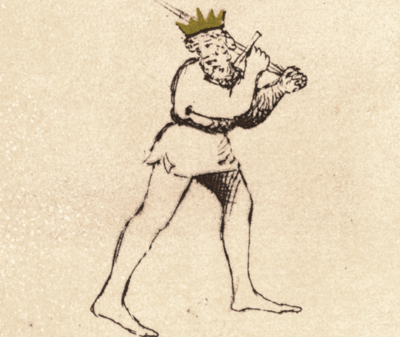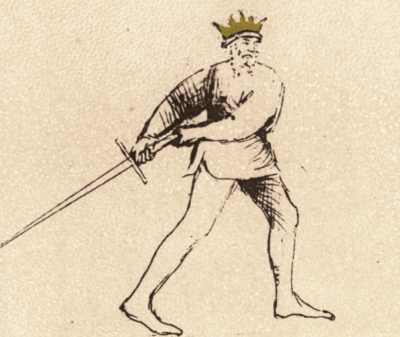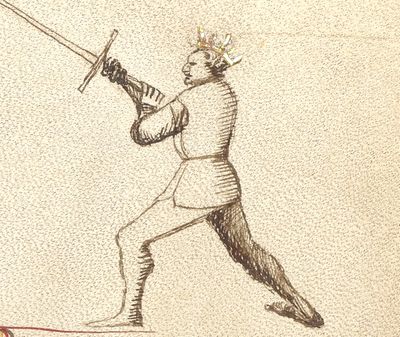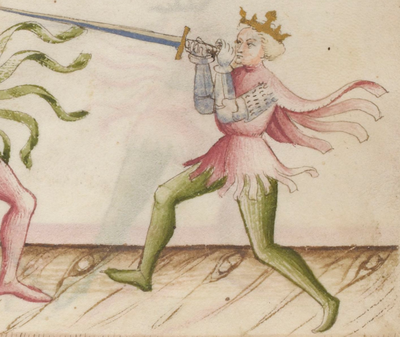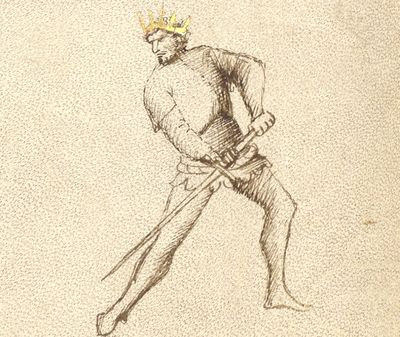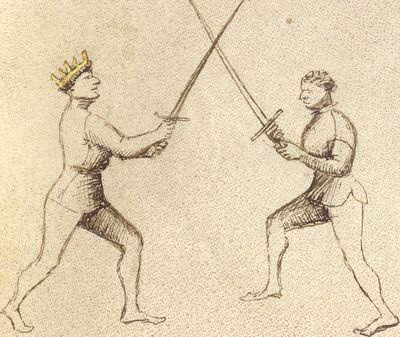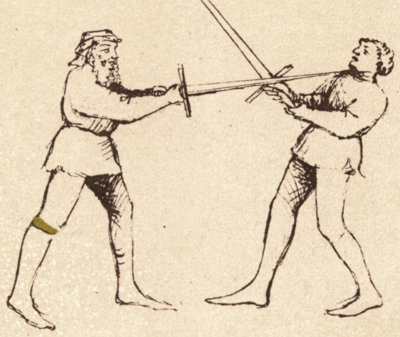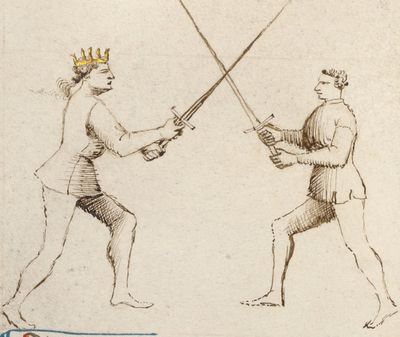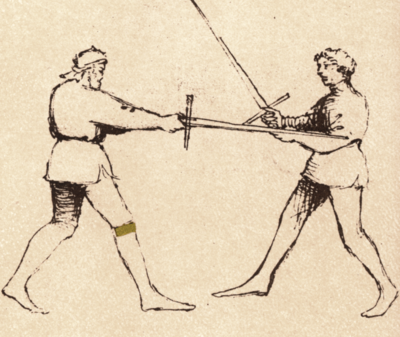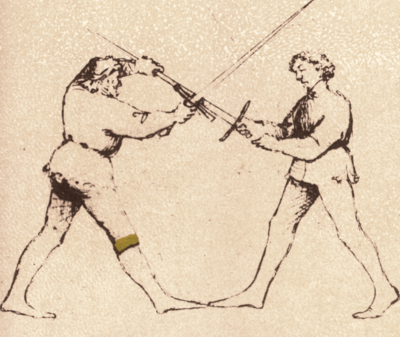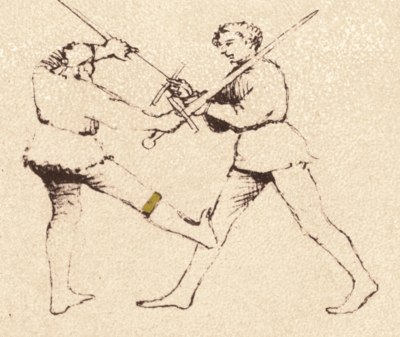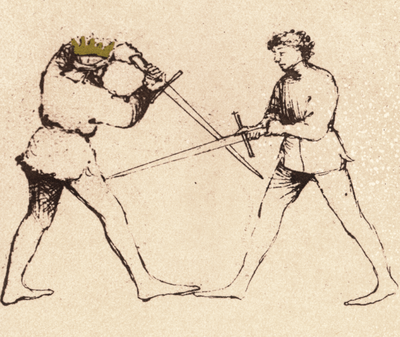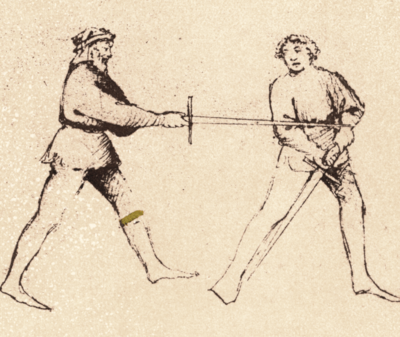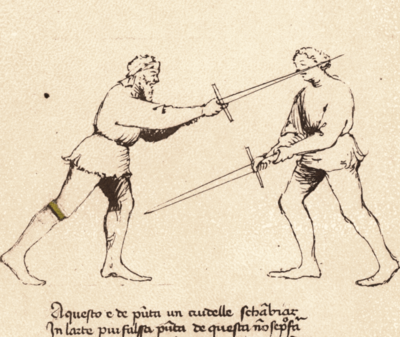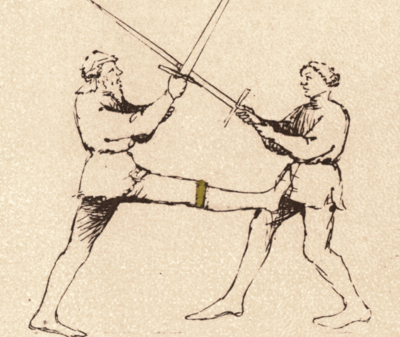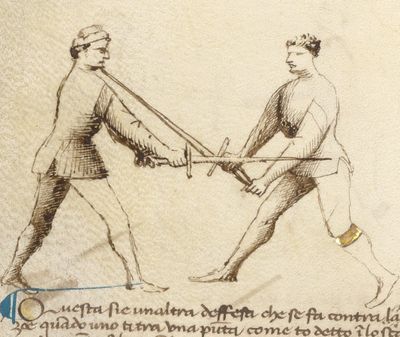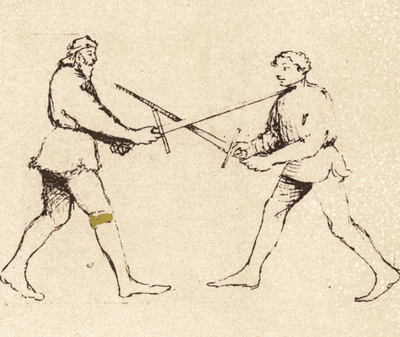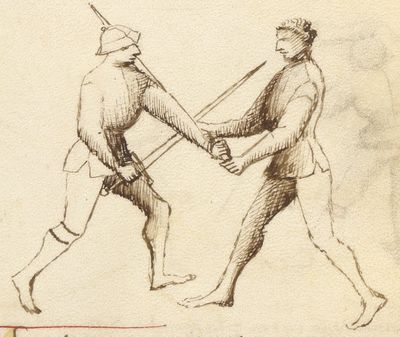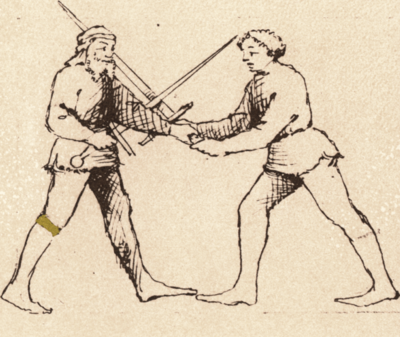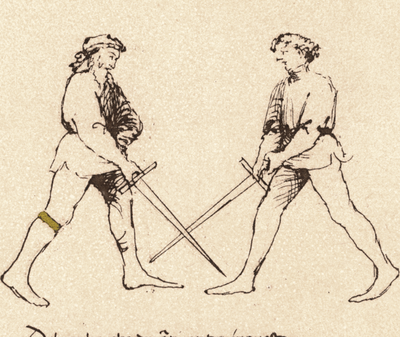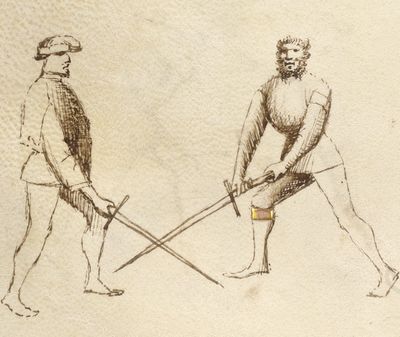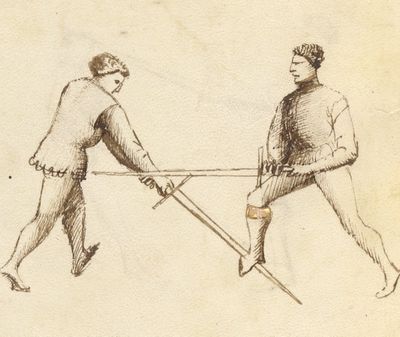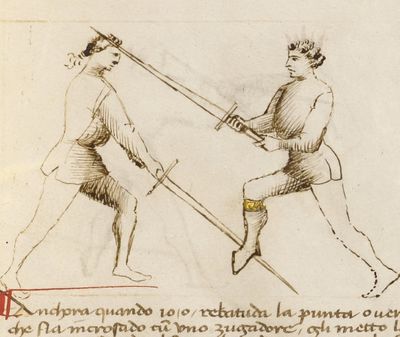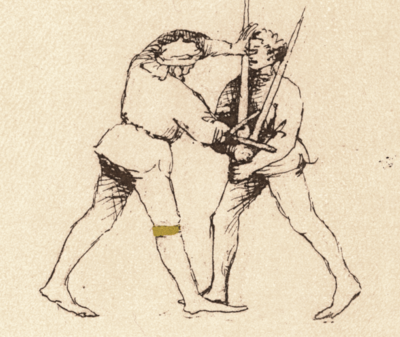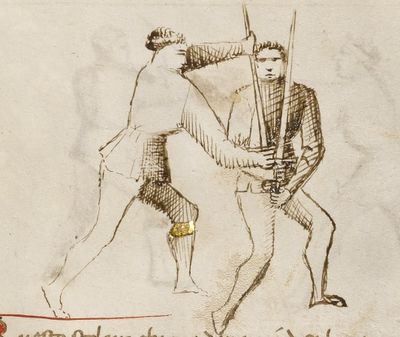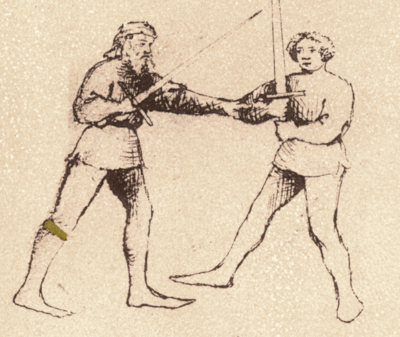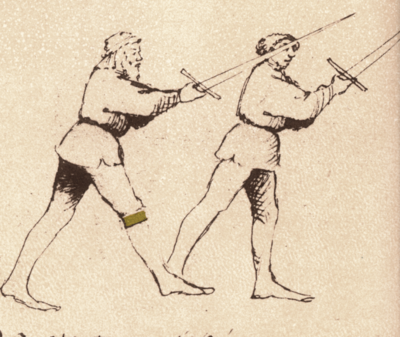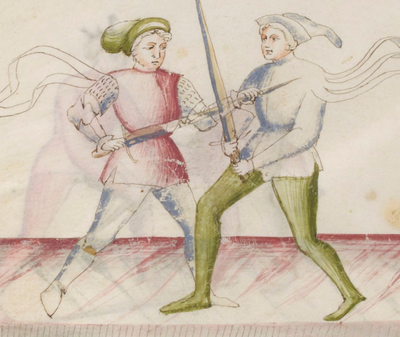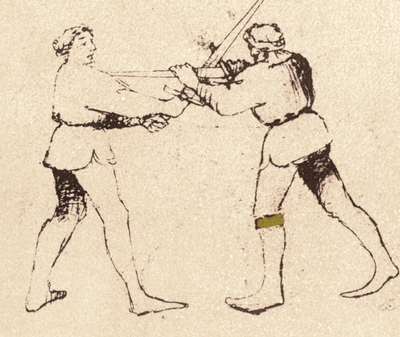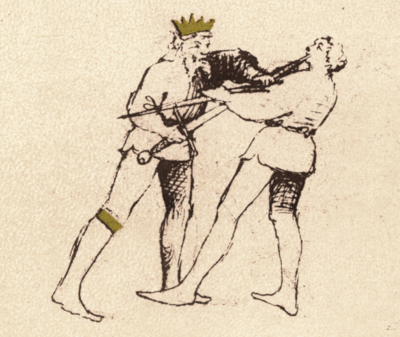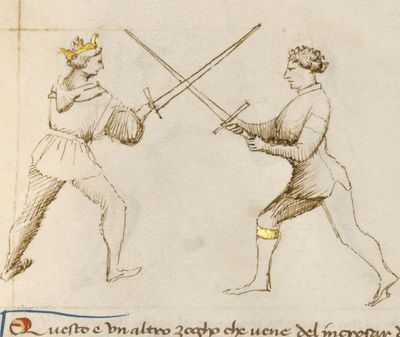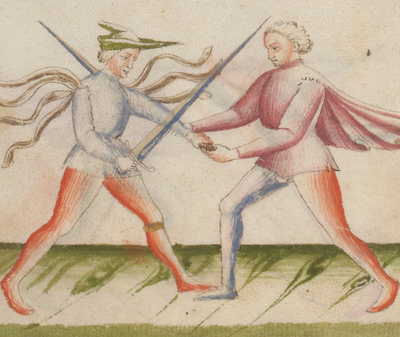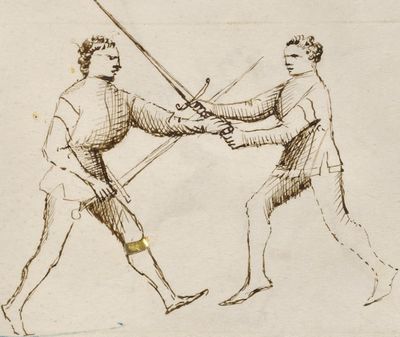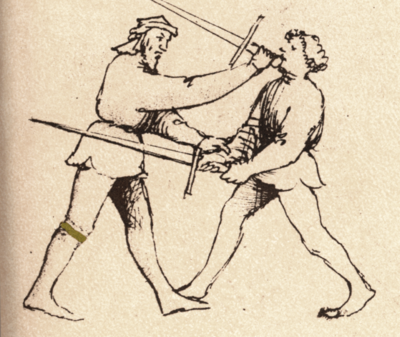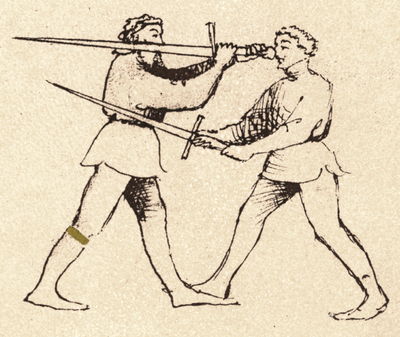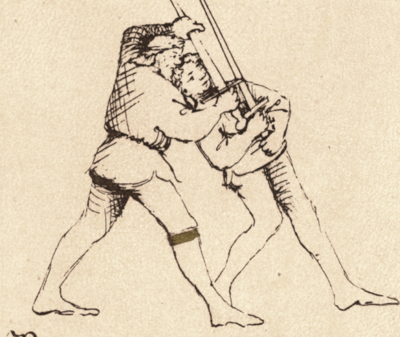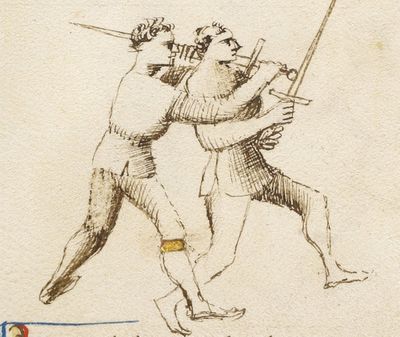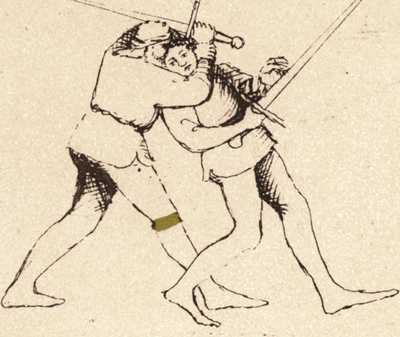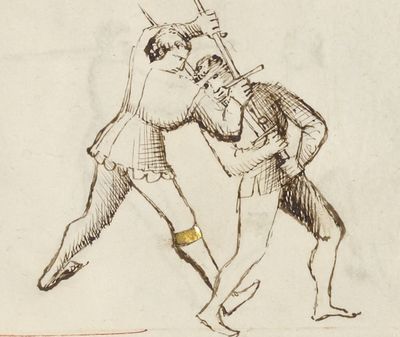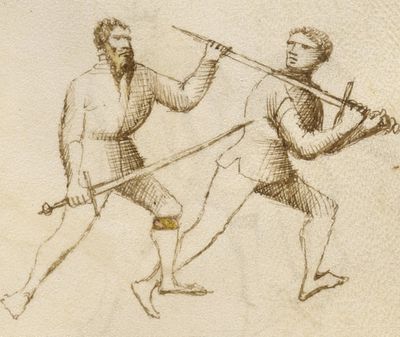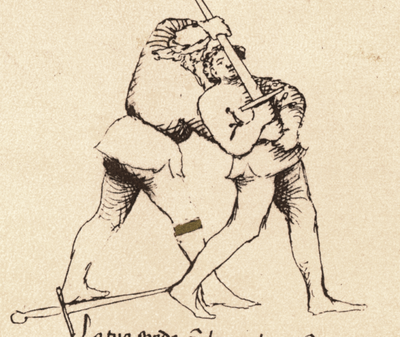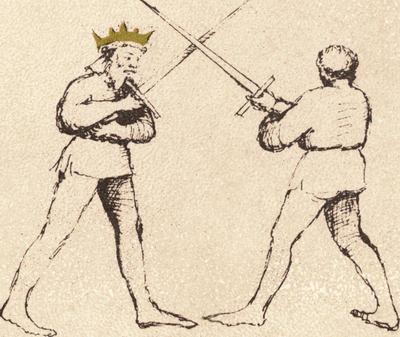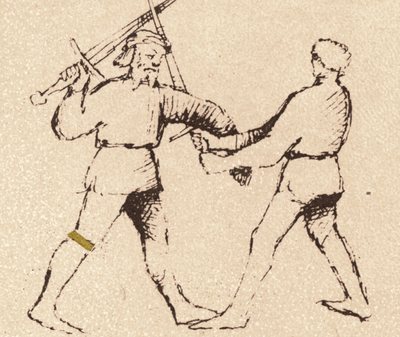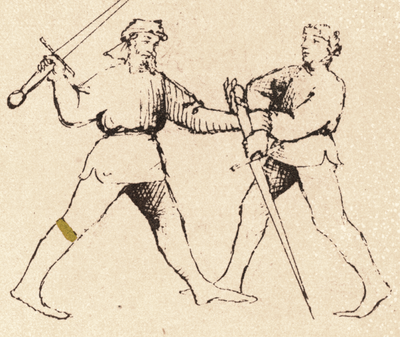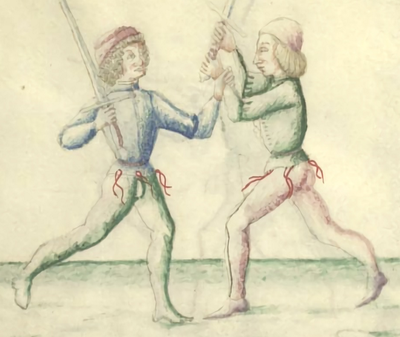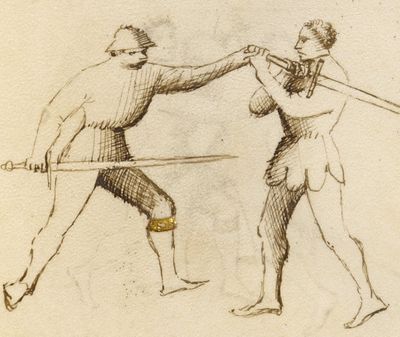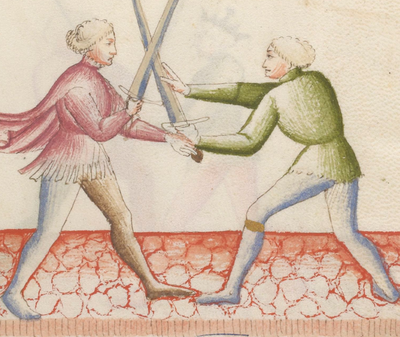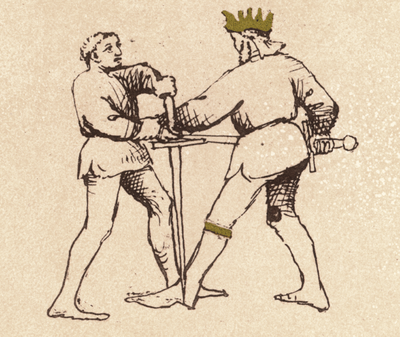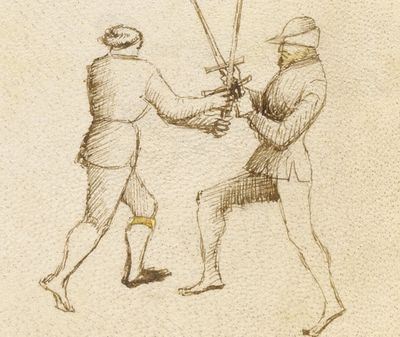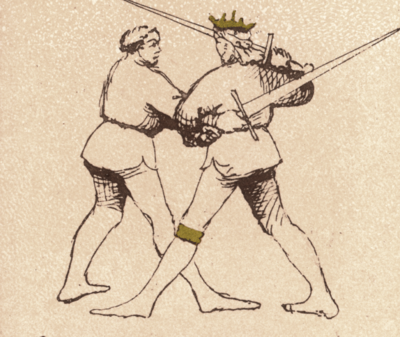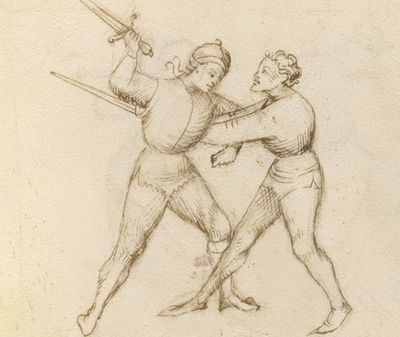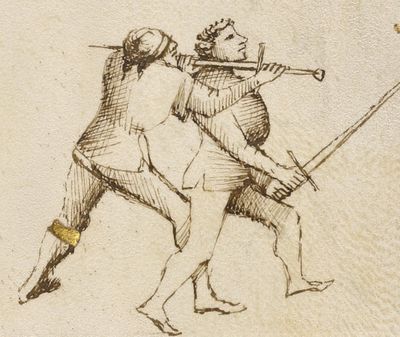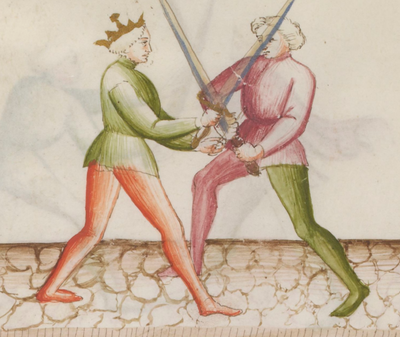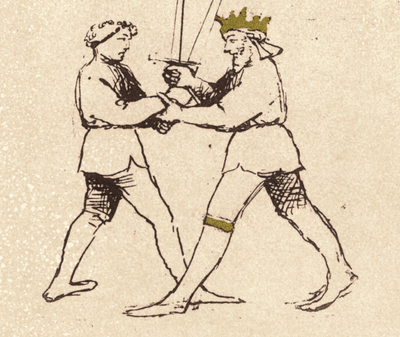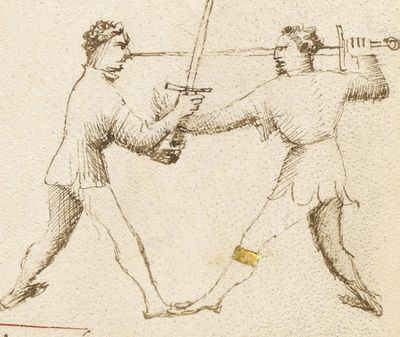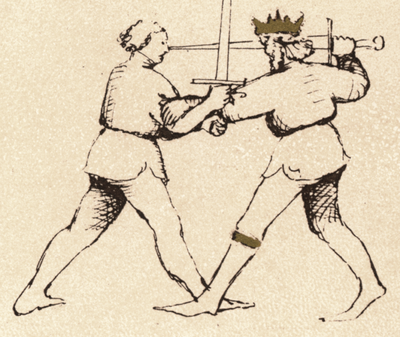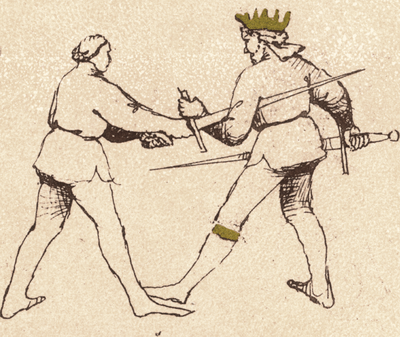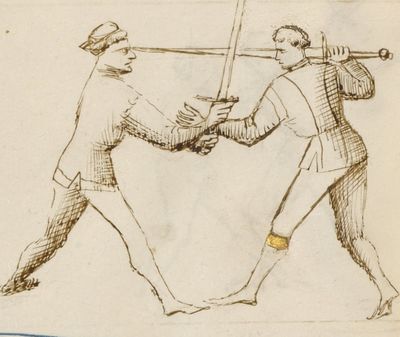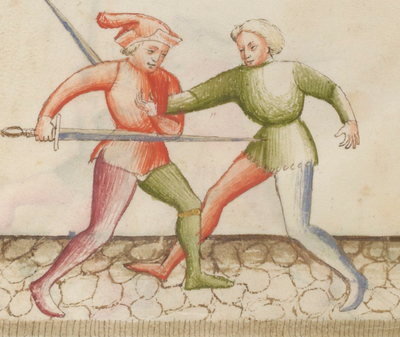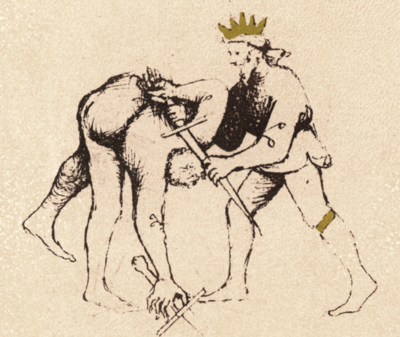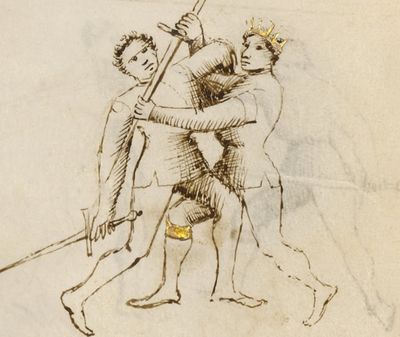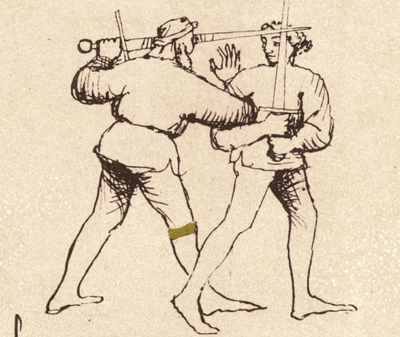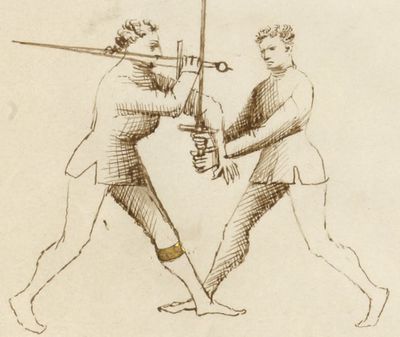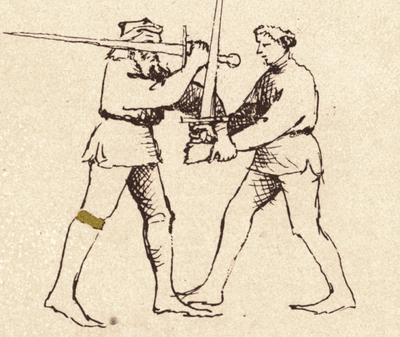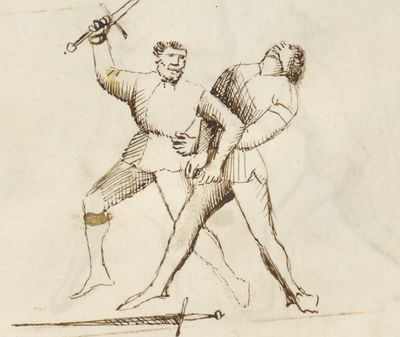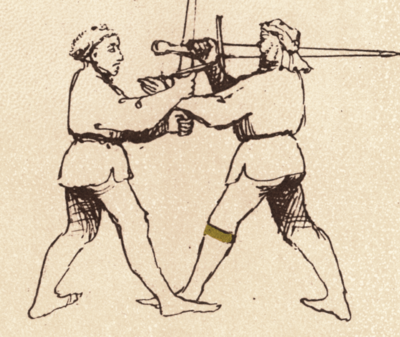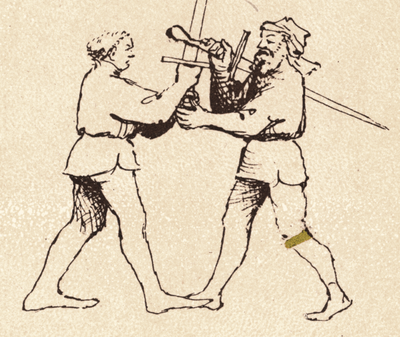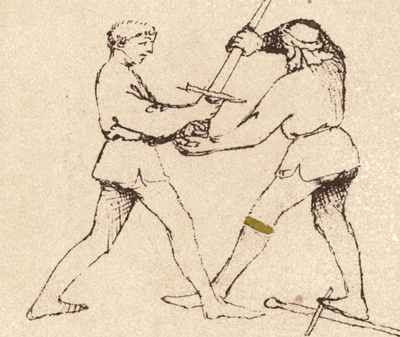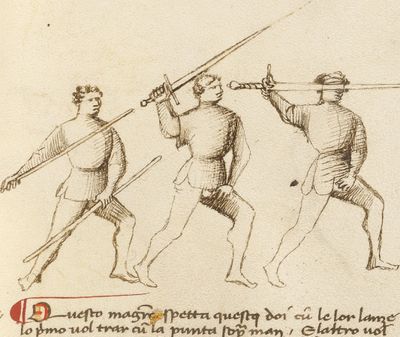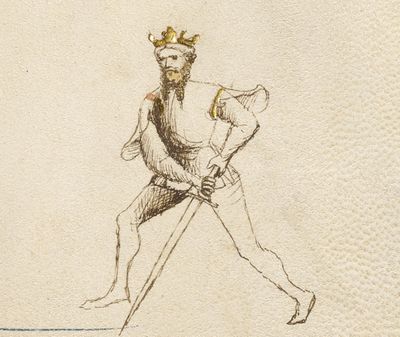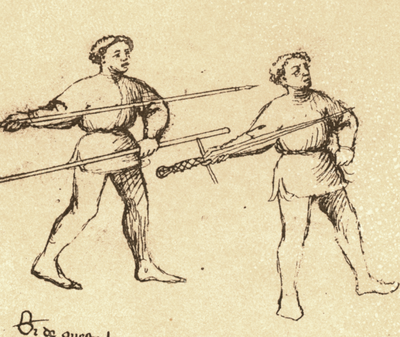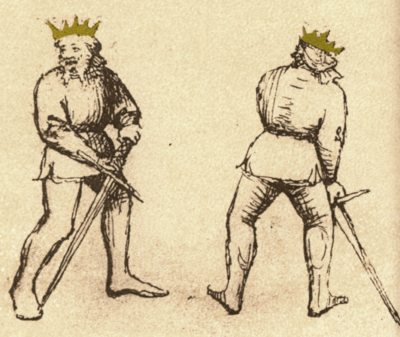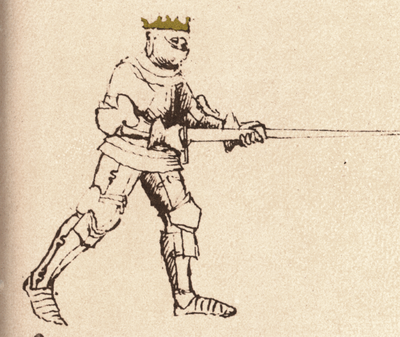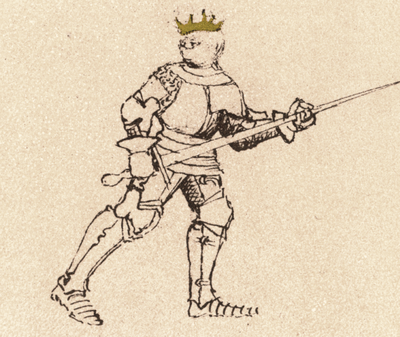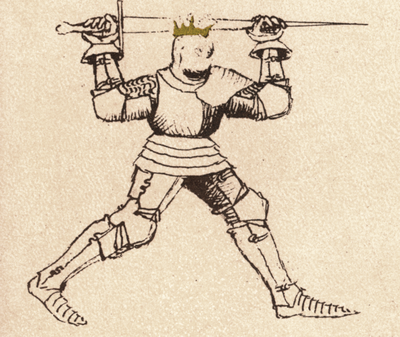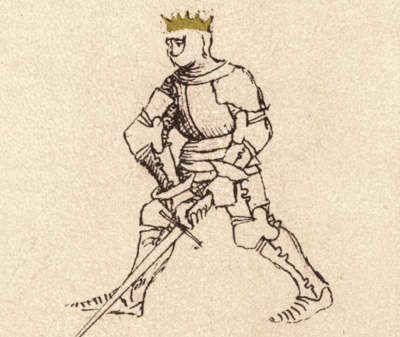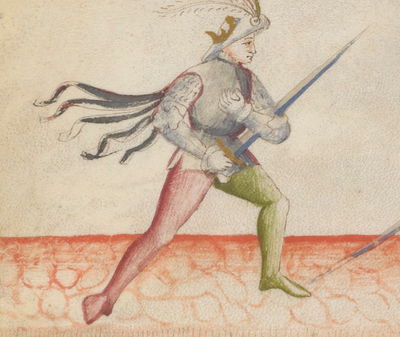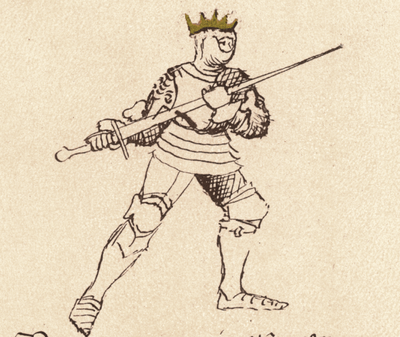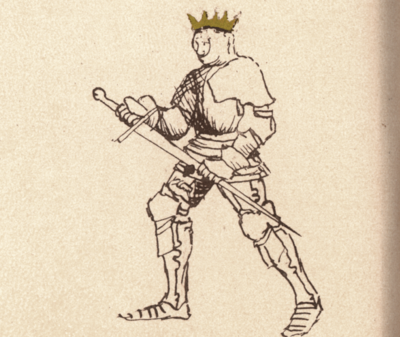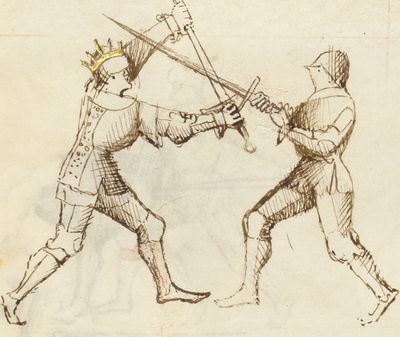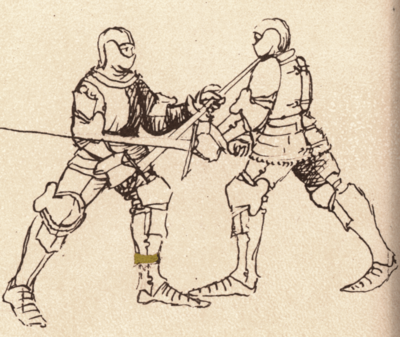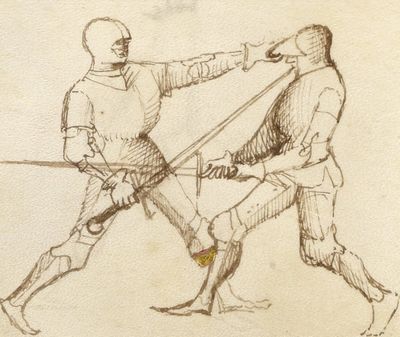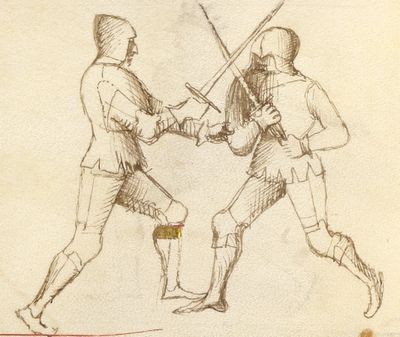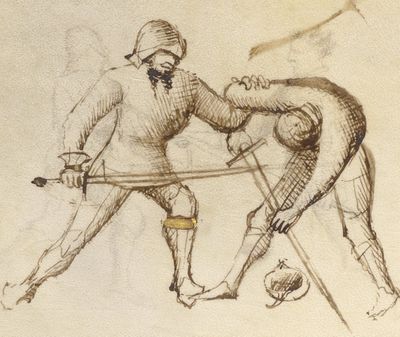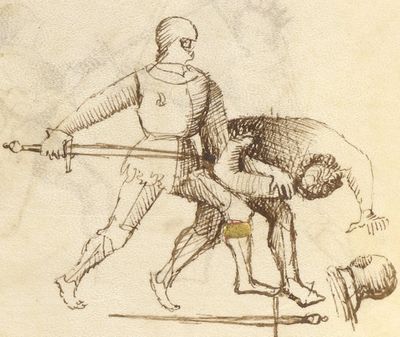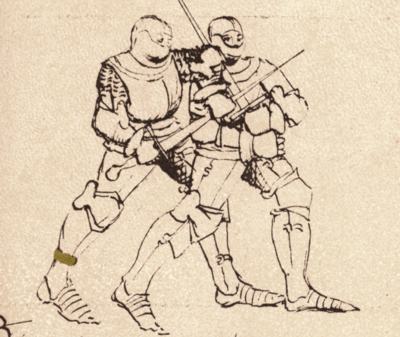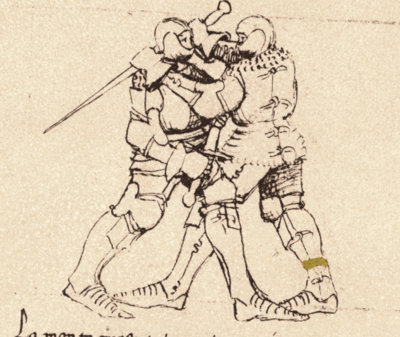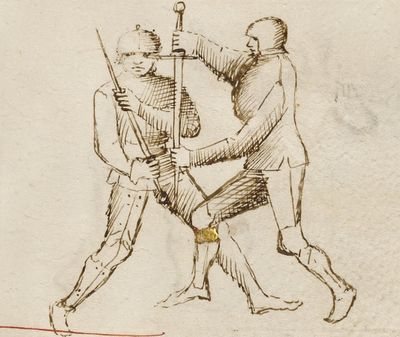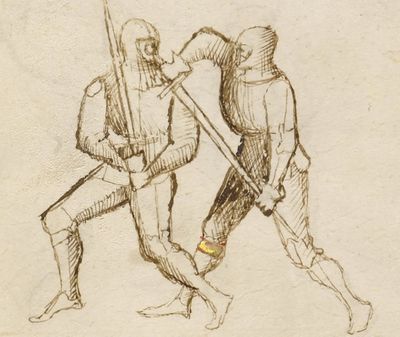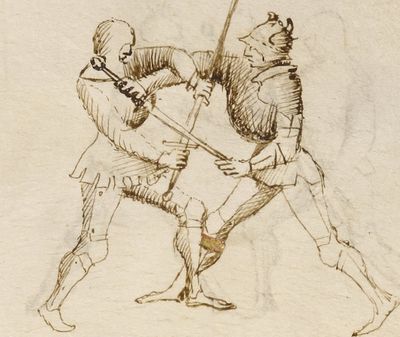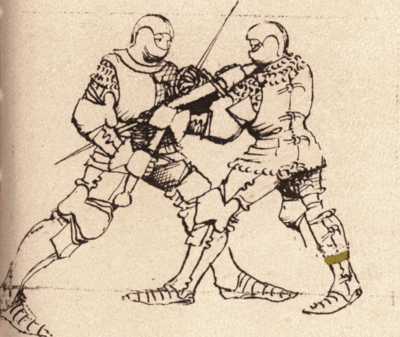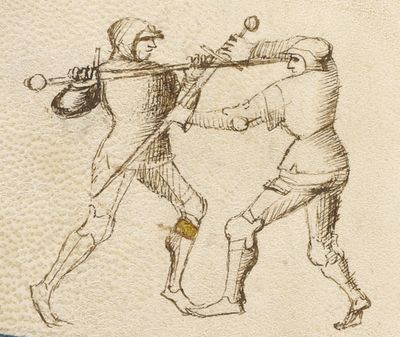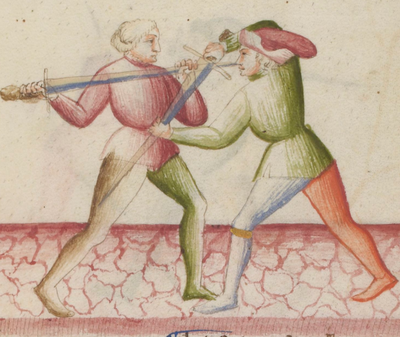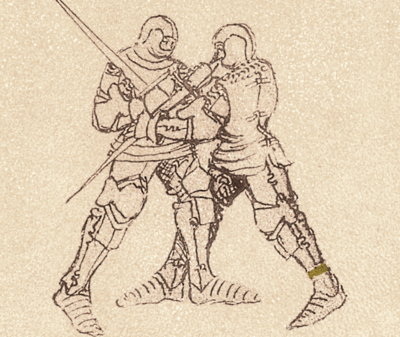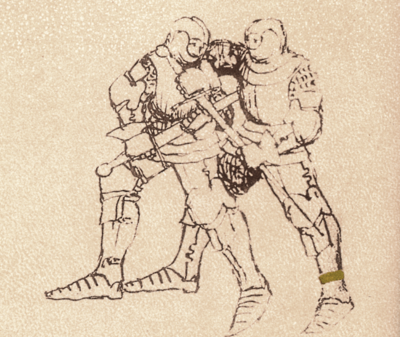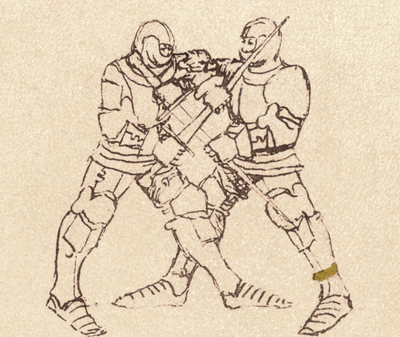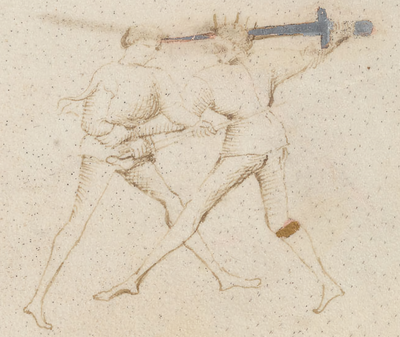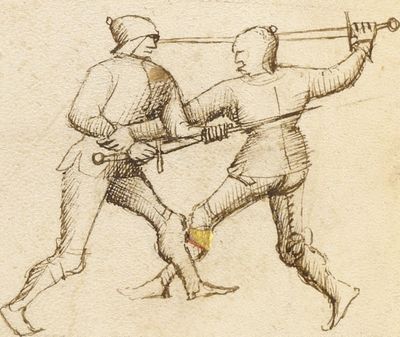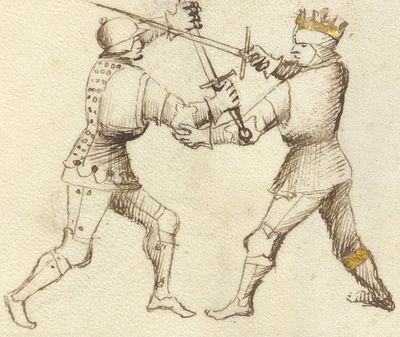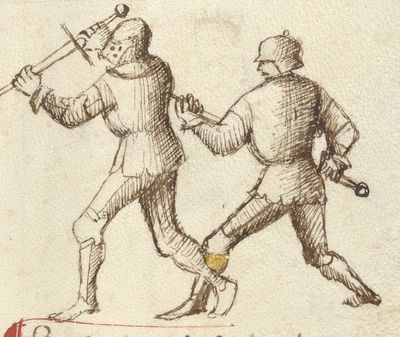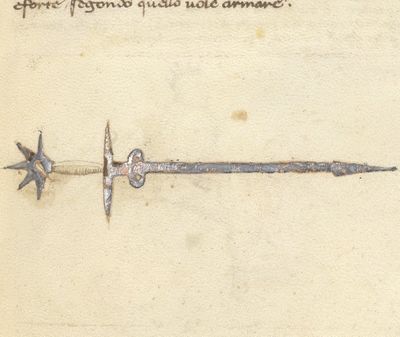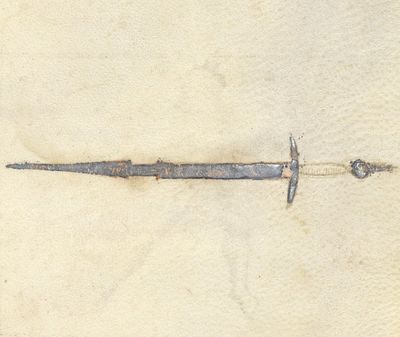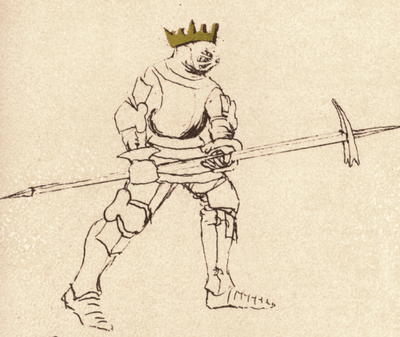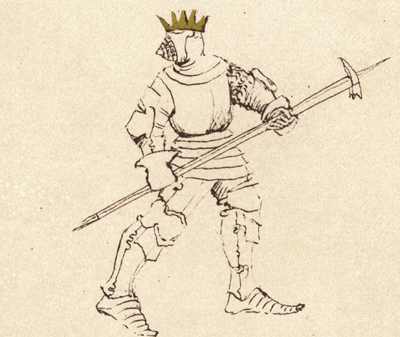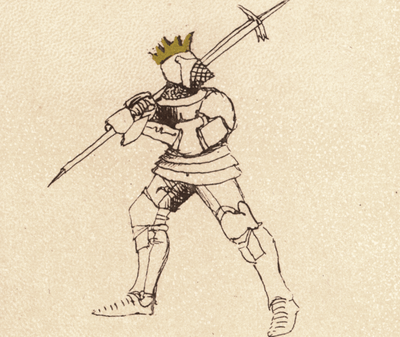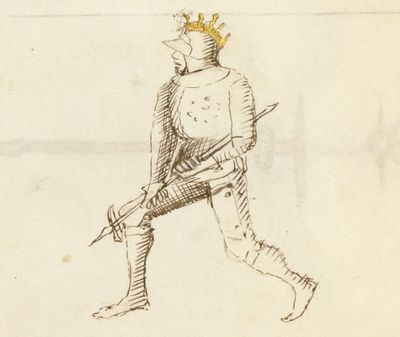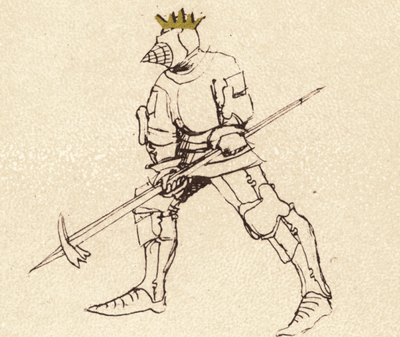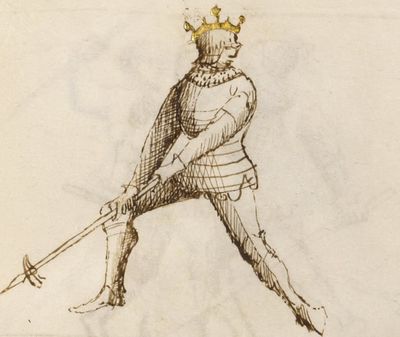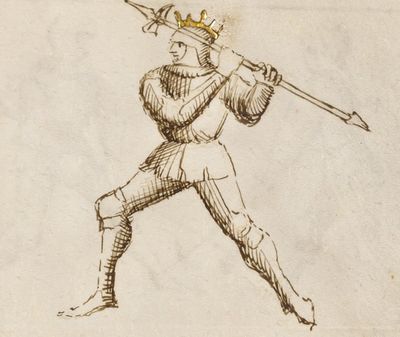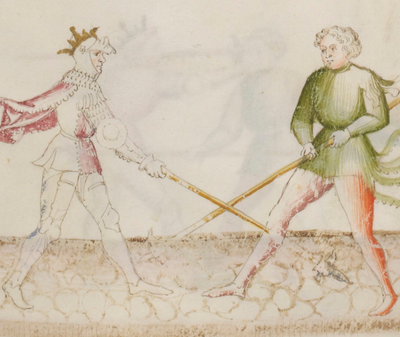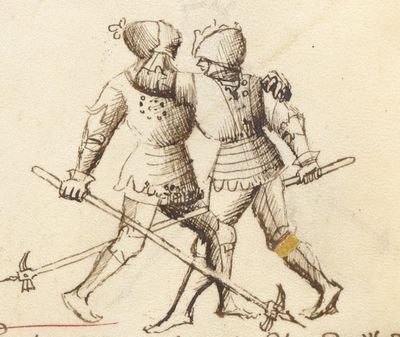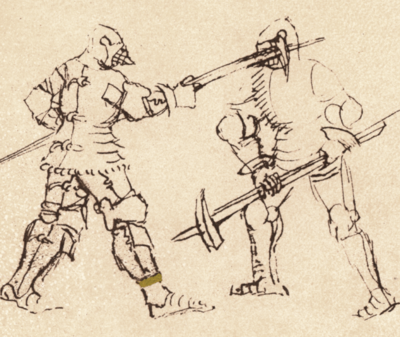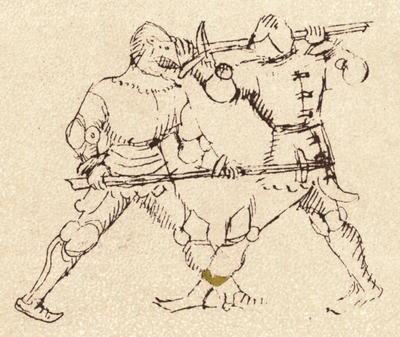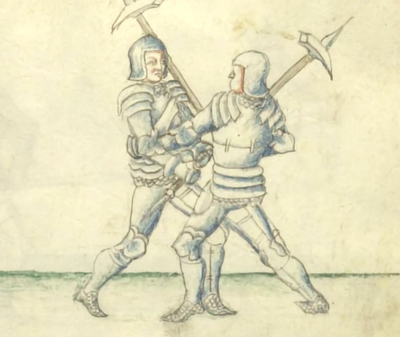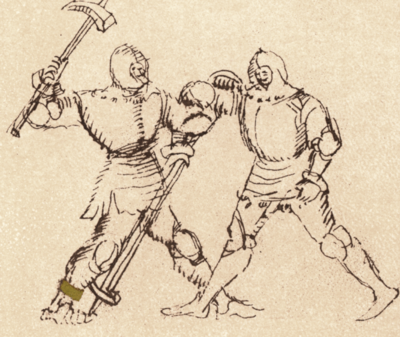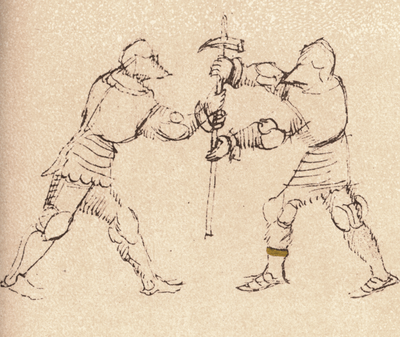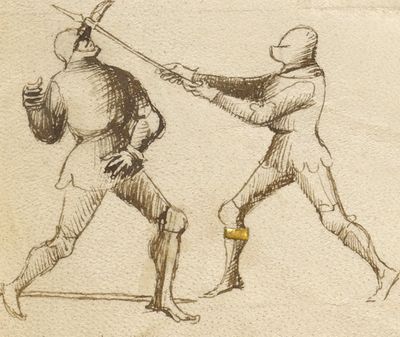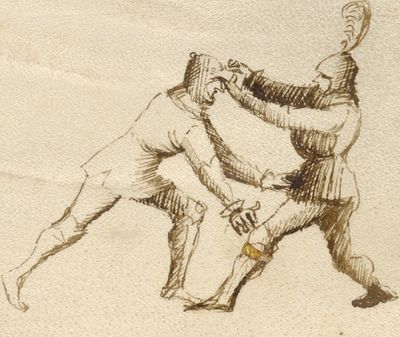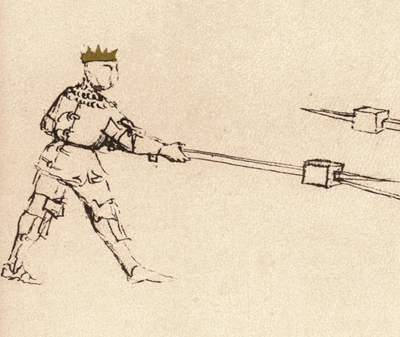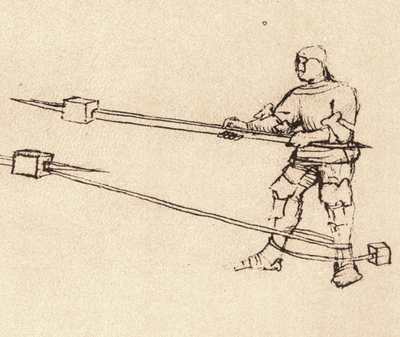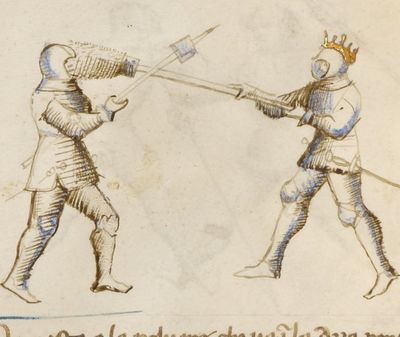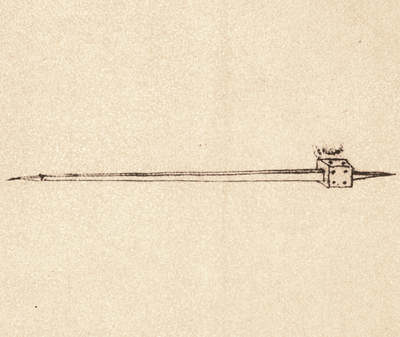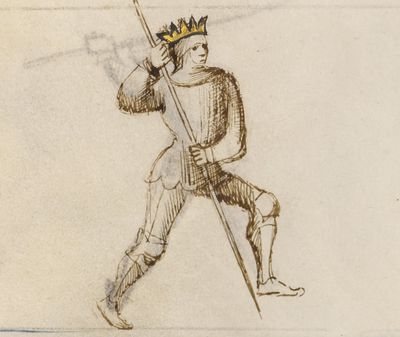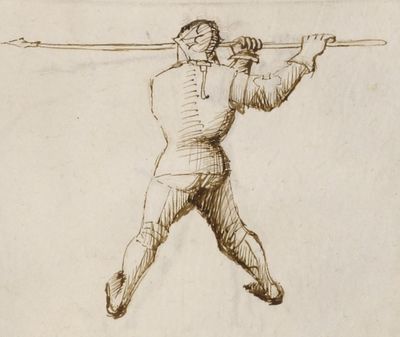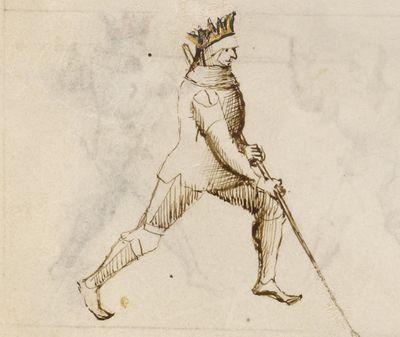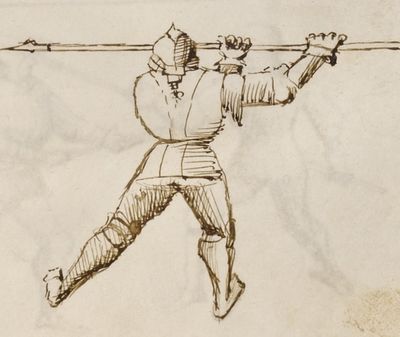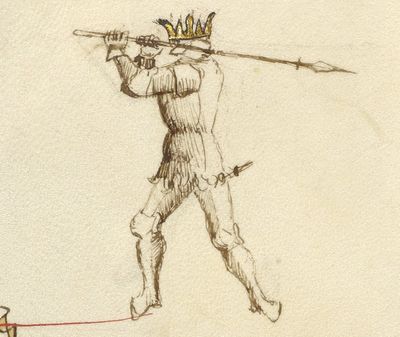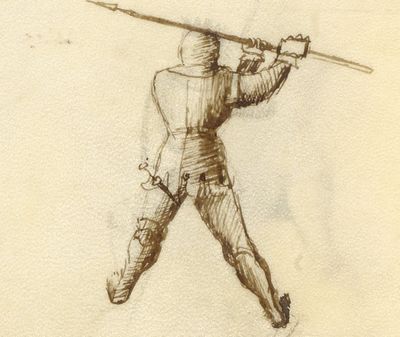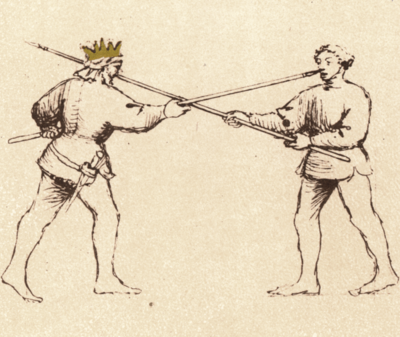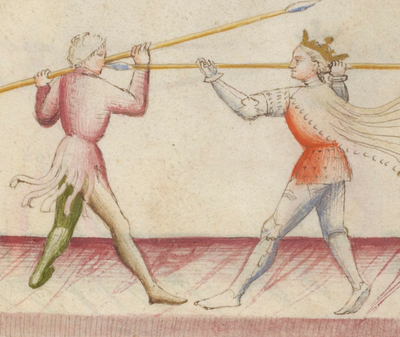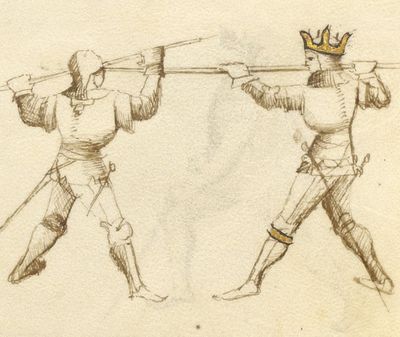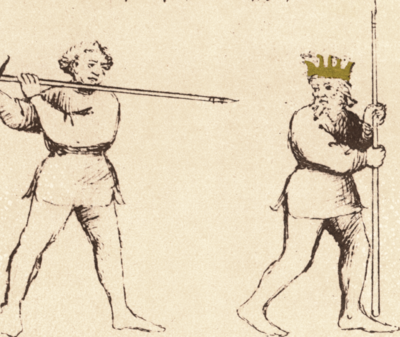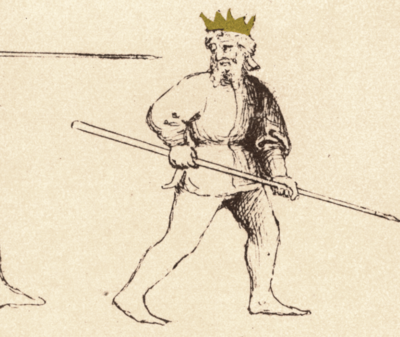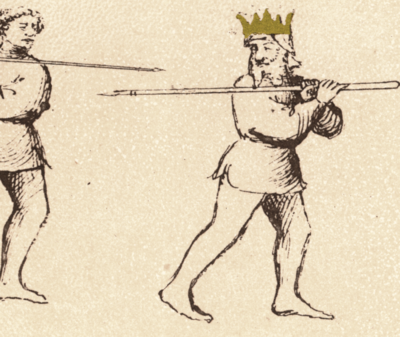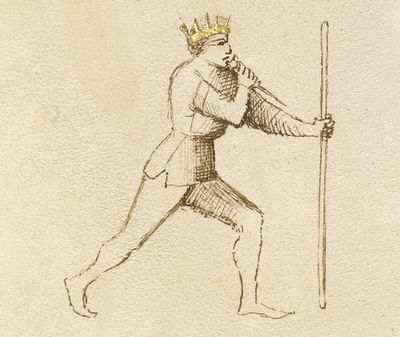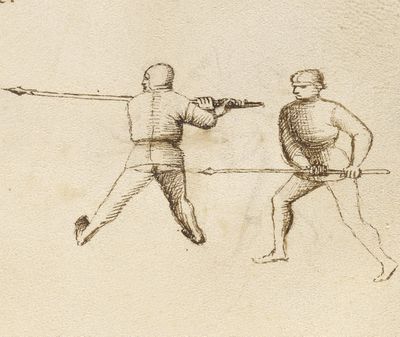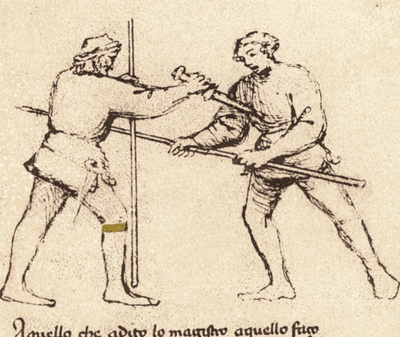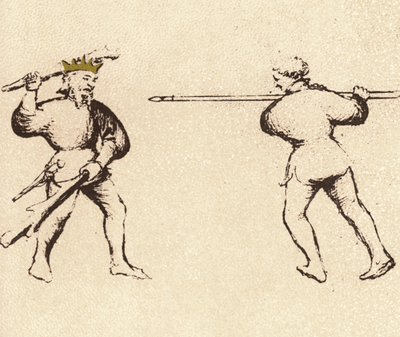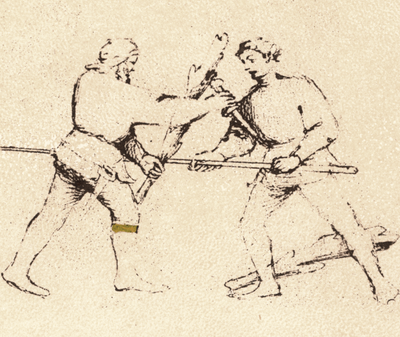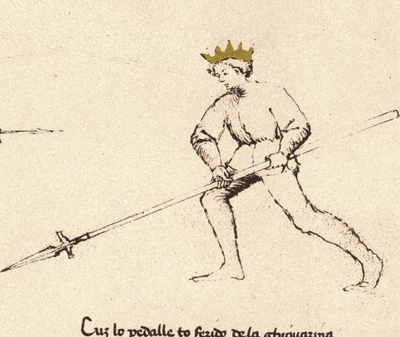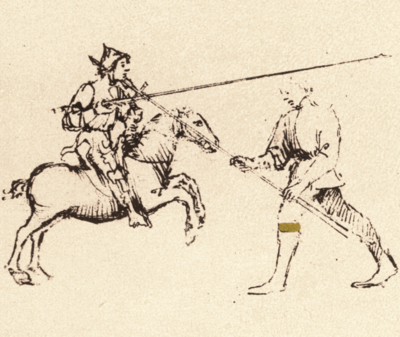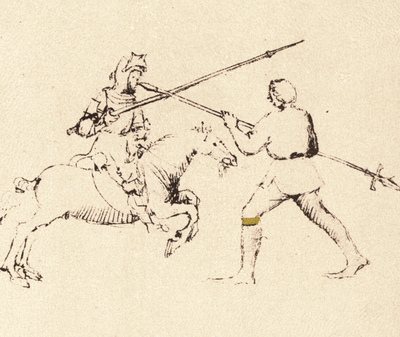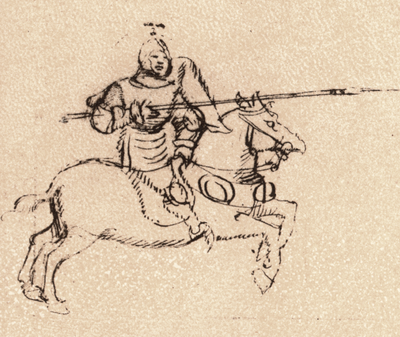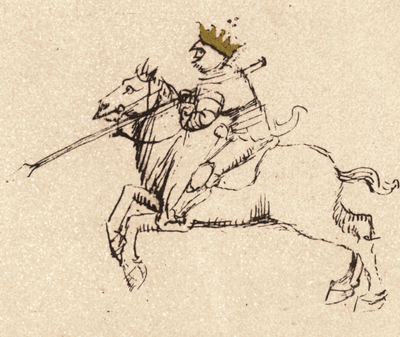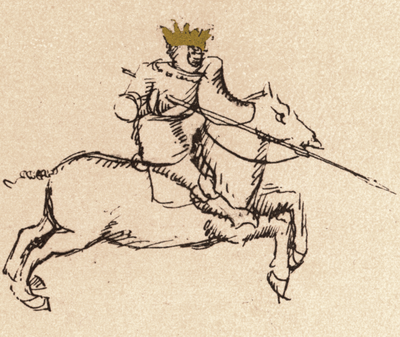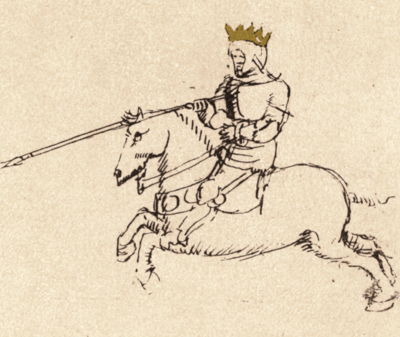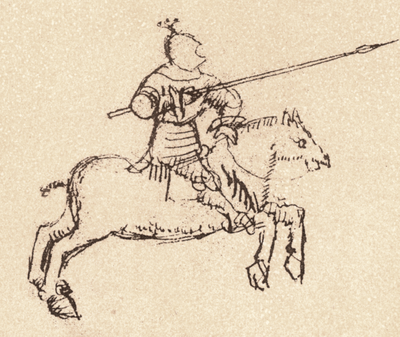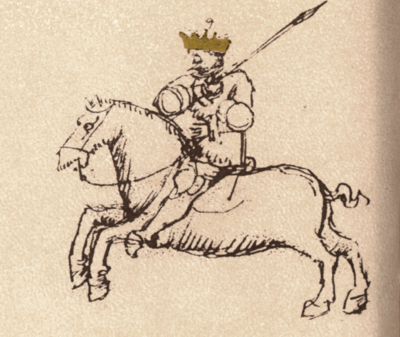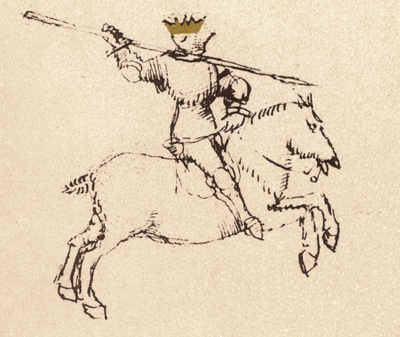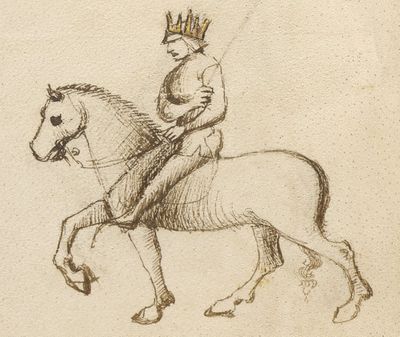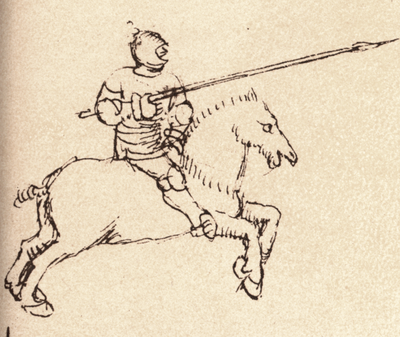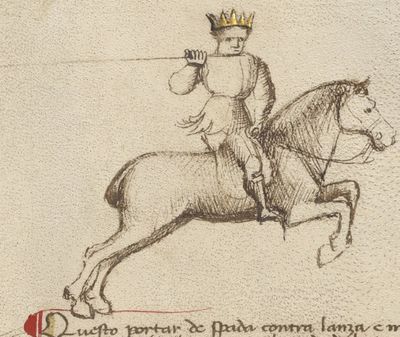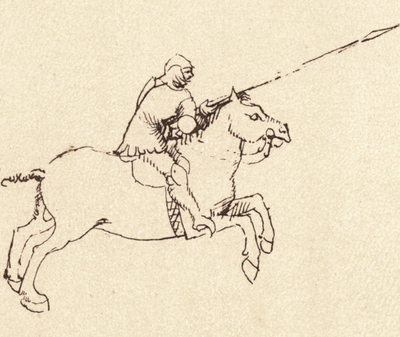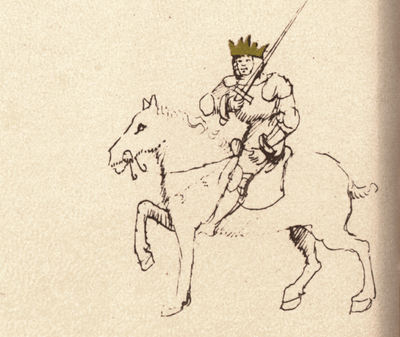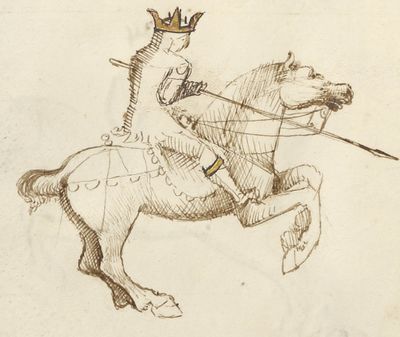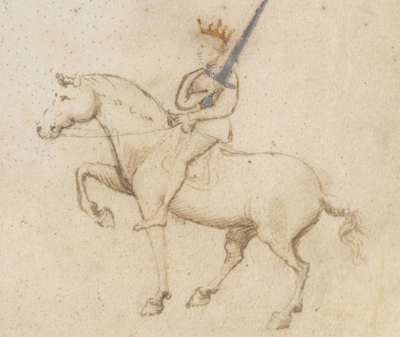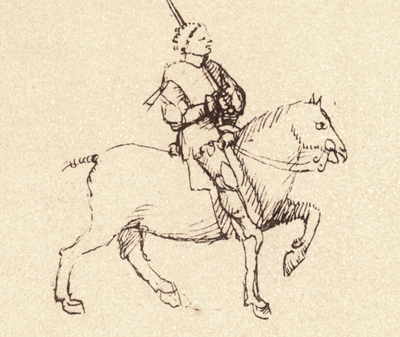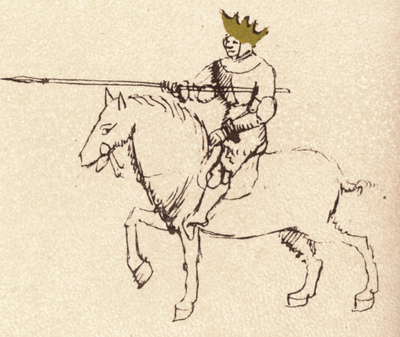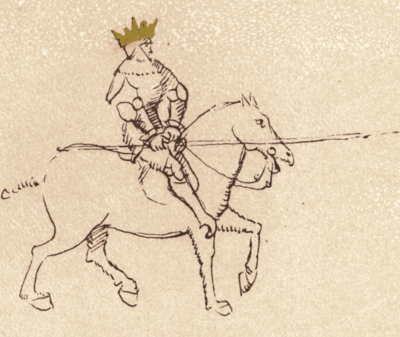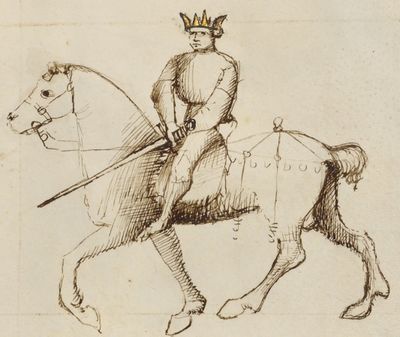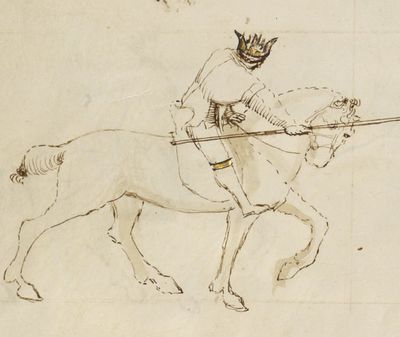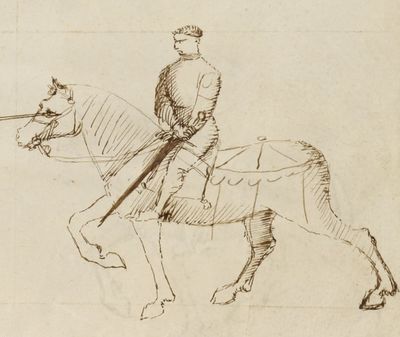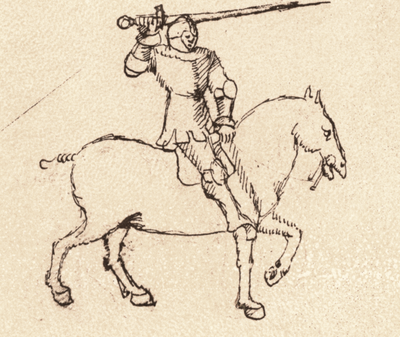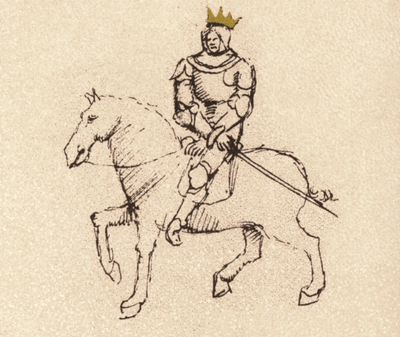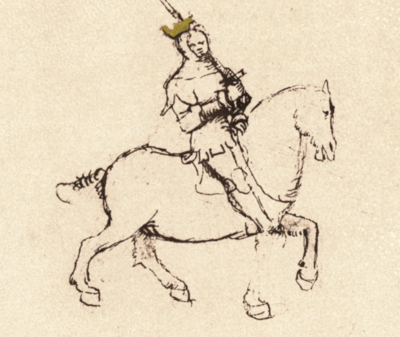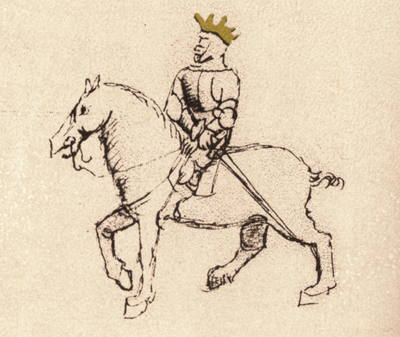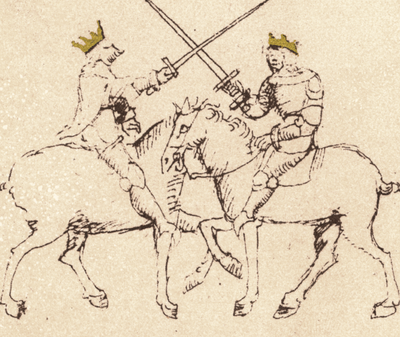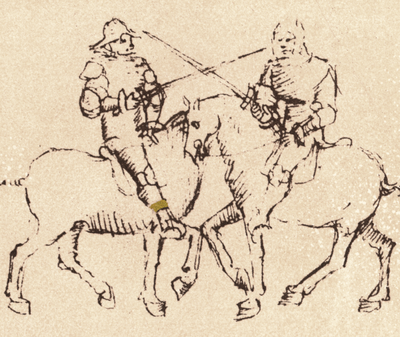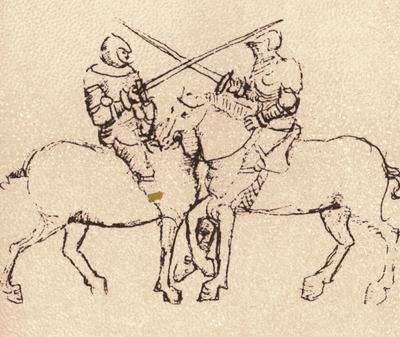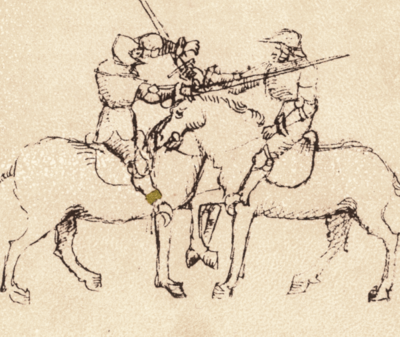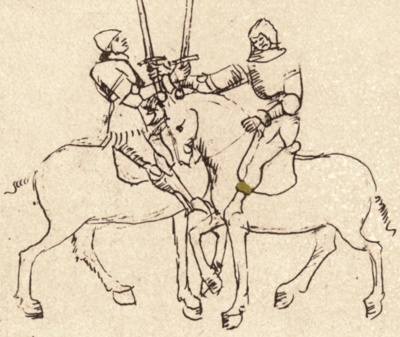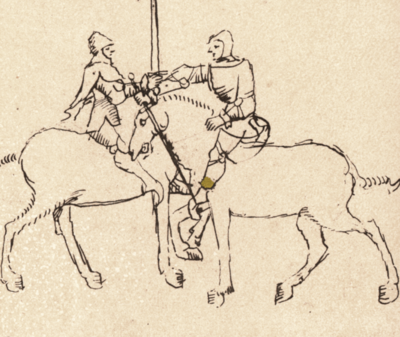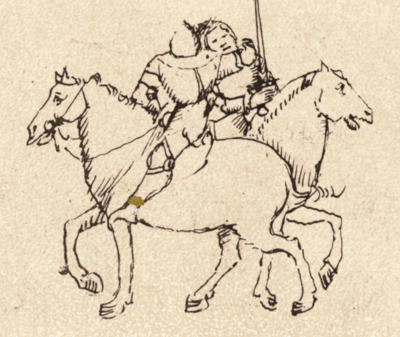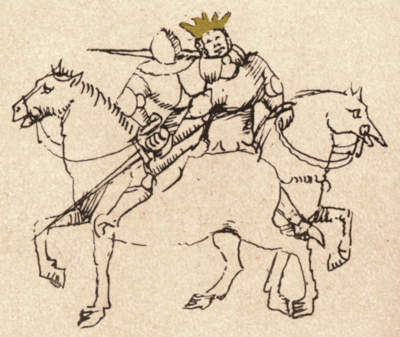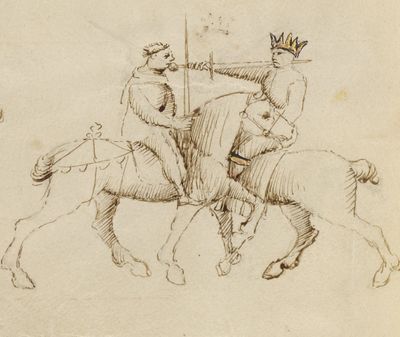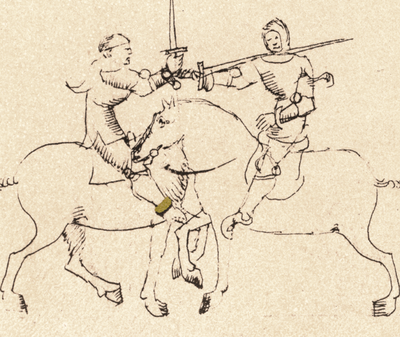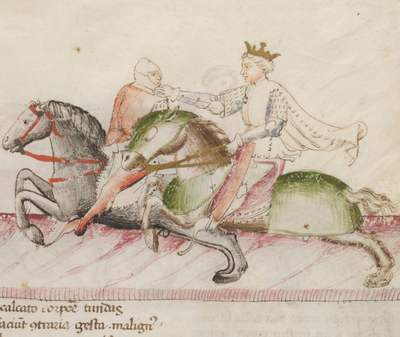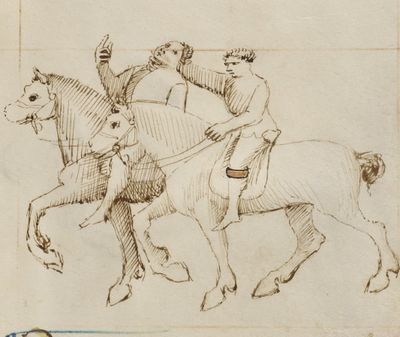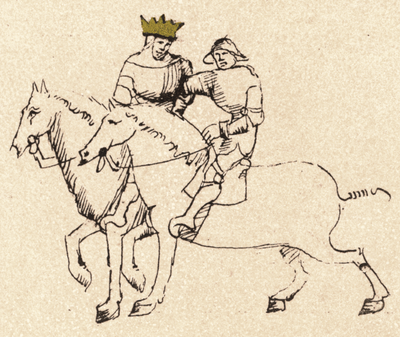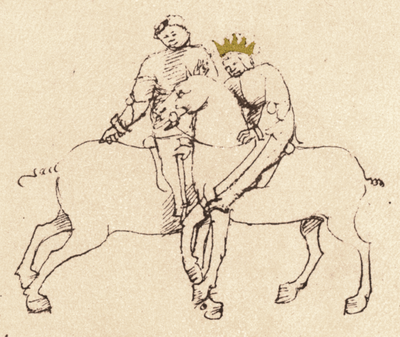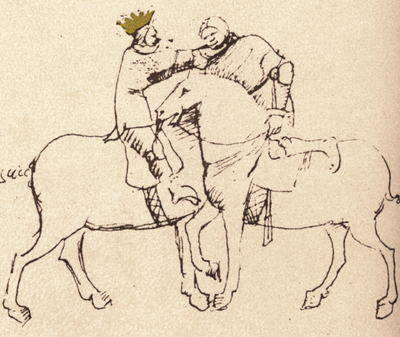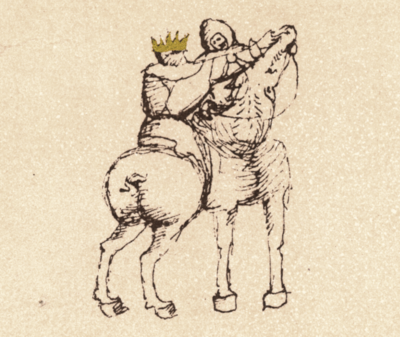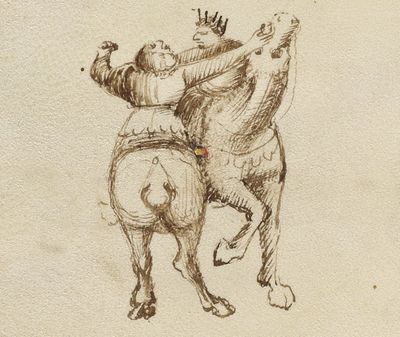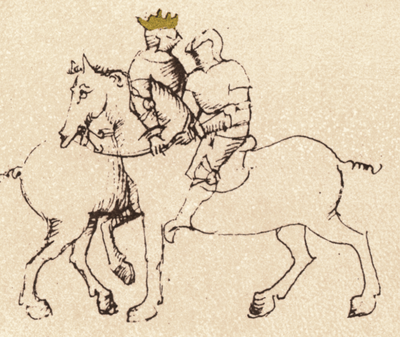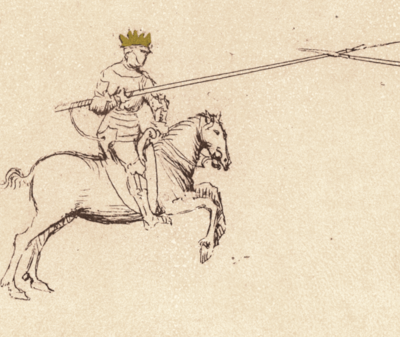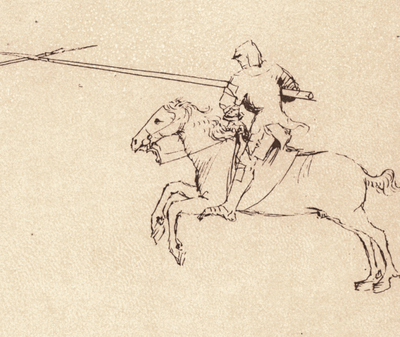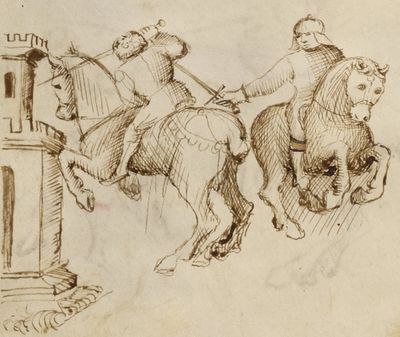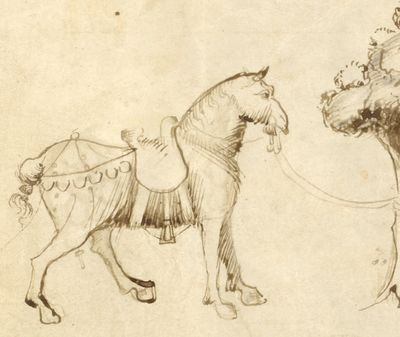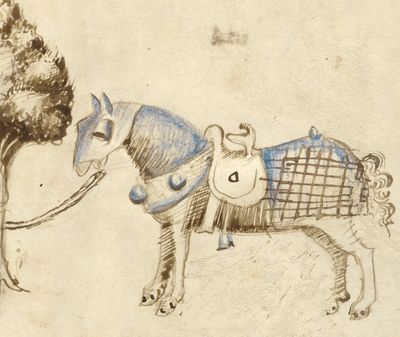|
|
You are not currently logged in. Are you accessing the unsecure (http) portal? Click here to switch to the secure portal. |
Difference between revisions of "Fiore de'i Liberi"
| Line 971: | Line 971: | ||
* [[Fiore de'i Liberi|dei Liberi, Fiore]]; Leoni, Tommaso. ''Fiore de’ Liberi’s Fior di Battaglia''. 1st ed. [http://www.lulu.com/product/paperback/fiore-de-liberis-fior-di-battaglia/5364635 Lulu.com], 2009. 2nd ed. Wheaton, IL: [[Freelance Academy Press]], 2012. | * [[Fiore de'i Liberi|dei Liberi, Fiore]]; Leoni, Tommaso. ''Fiore de’ Liberi’s Fior di Battaglia''. 1st ed. [http://www.lulu.com/product/paperback/fiore-de-liberis-fior-di-battaglia/5364635 Lulu.com], 2009. 2nd ed. Wheaton, IL: [[Freelance Academy Press]], 2012. | ||
* [[Fiore de'i Liberi|dei Liberi, Fiore]]; [[Marco Rubboli|Rubboli, Marco]]; [[Luca Cesari|Cesari, Luca]]. ''Flos Duellatorum. Manuale di Arte del Combattimento del XV secolo''. Rome: [[Il Cerchio Iniziative Editoriali]], 2002. ISBN 88-8474-023-1 | * [[Fiore de'i Liberi|dei Liberi, Fiore]]; [[Marco Rubboli|Rubboli, Marco]]; [[Luca Cesari|Cesari, Luca]]. ''Flos Duellatorum. Manuale di Arte del Combattimento del XV secolo''. Rome: [[Il Cerchio Iniziative Editoriali]], 2002. ISBN 88-8474-023-1 | ||
| − | * Lodà, Francesco. ''Florius. De arte luctandi. Traduzione e cura del testo di Francesco Lodà.'' Rome: Bonanno Editore, 2014. ISBN 978-88-96950-86-9* Malipiero, Massimo. ''Il Fior di battaglia di Fiore dei Liberi da Cividale: Il Codice Ludwing XV 13 del J. Paul Getty Museum''. Udine: Ribis, 2006. ISBN 887-44503-5-4 | + | * Lodà, Francesco. ''Florius. De arte luctandi. Traduzione e cura del testo di Francesco Lodà.'' Rome: Bonanno Editore, 2014. ISBN 978-88-96950-86-9 |
| + | * Malipiero, Massimo. ''Il Fior di battaglia di Fiore dei Liberi da Cividale: Il Codice Ludwing XV 13 del J. Paul Getty Museum''. Udine: Ribis, 2006. ISBN 887-44503-5-4 | ||
* Mondschein, Ken. ''The Knightly Art of Battle''. Los Angeles: [[J. Paul Getty Museum]], 2011. ISBN 978-160-60607-6-6 | * Mondschein, Ken. ''The Knightly Art of Battle''. Los Angeles: [[J. Paul Getty Museum]], 2011. ISBN 978-160-60607-6-6 | ||
* [[Francesco Novati|Novati, Francesco]]. ''[http://www.fioredeiliberi.org/manuscripts/novati/ Flos Duellatorum, Il Fior di Battaglia di Maestro Fiore dei Liberi da Premariacco]''. Bergamo: Instituto Italiano d'Arte Grafiche, 1902. | * [[Francesco Novati|Novati, Francesco]]. ''[http://www.fioredeiliberi.org/manuscripts/novati/ Flos Duellatorum, Il Fior di Battaglia di Maestro Fiore dei Liberi da Premariacco]''. Bergamo: Instituto Italiano d'Arte Grafiche, 1902. | ||
Revision as of 21:12, 28 August 2014
| Fiore Furlano de’i Liberi | |
|---|---|
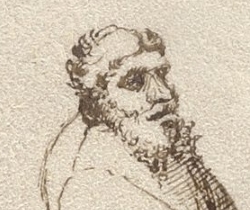 This master with a forked beard appears sporadically throughout both the Getty and Pisani Dossi mss., and may be a representation of Fiore himself. | |
| Born | 1340s Cividale del Friuli, Friuli |
| Died | after 1420 France (?) |
| Relative(s) | Benedetto de’i Liberi |
| Occupation |
|
| Nationality | Friulian |
| Patron |
|
| Influences | |
| Influenced | Philippo di Vadi |
| Genres | |
| Language | |
| Notable work(s) | The Flower of Battle |
| Manuscript(s) |
Pisani Dossi MS (1409)
|
| Concordance by | Michael Chidester |
| Translations | |
Fiore Furlano de’i Liberi de Cividale d’Austria (Fiore delli Liberi, Fiore Furlano, Fiore de Cividale d’Austria; ca. 1340s - 1420s[1]) was a late 14th century knight, diplomat, and itinerant fencing master. He was born in Cividale del Friuli, a town in the Patriarchal State of Aquileia (in the Friuli region of modern-day Italy), the son of Benedetto and scion of a Liberi house of Premariacco.[2][3][4] The term Liberi, while potentially merely a surname, more probably indicates that his family had Imperial immediacy (Reichsfreiheit), either as part of the nobili liberi (Edelfrei, "free nobles"), the Germanic unindentured knightly class which formed the lower tier of nobility in the Middle Ages, or possibly of the rising class of Imperial Free Knights.[5][6][7] It has been suggested by various historians that Fiore and Benedetto were descended from Cristallo dei Liberi of Premariacco, who was granted immediacy in 1110 by Holy Roman Emperor Henry V,[8][9][10] but this has yet to be confirmed.[11]
Fiore wrote that he had a natural inclination to the martial arts and began training at a young age, ultimately studying with “countless” masters from both Italic and Germanic lands.[2][3][4] He had ample opportunity to interact with both, being born in the Holy Roman Empire and later traveling widely in the northern Italian states. Unfortunately, not all of these encounters were friendly: Fiore wrote of meeting many “false” or unworthy masters in his travels, most of whom lacked even the limited skill he'd expect in a good student.[4] He further mentions that on five separate occasions he was forced to fight duels for his honor against certain of these masters who he described as envious because he refused to teach them his art; the duels were all fought with sharp swords, unarmored except for gambesons and chamois gloves, and he won each without injury.[2][3]
Writing very little on his own career as a commander and master at arms, Fiore laid out his credentials for his readers in other ways. He stated that foremost among the masters who trained him was one Johane dicto Suueno, who he notes was a disciple of Nicholai de Toblem;[4] unfortunately, both names are given in Latin so there is little we can conclude about them other than that they were probably among the Italians and Germans he alludes to, and that one or both were well known in Fiore's time. He further offered an extensive list of the famous condottieri that he trained, including Piero Paolo del Verde (Peter von Grünen),[12] Niccolo Unricilino (Nikolo von Urslingen),[13] Galeazzo Cattaneo dei Grumelli (Galeazzo Gonzaga da Mantova),[14] Lancillotto Beccaria di Pavia,[15] Giovannino da Baggio di Milano,[16] and Azzone di Castelbarco,[17] and also highlights some of their martial exploits.[2][3]
Based on Fiore's autobiographical account, he can tentatively be placed in Perosa (Perugia) in 1381 when Piero del Verde likely fought a duel with Pietro della Corona (Peter Kornwald).[18] That same year, the Aquileian War of Succession erupted as a coalition of secular nobles from Udine and surrounding cities sought to remove the newly appointed Patriarch, Philippe II d'Alençon. Fiore seems to have sided with the secular nobility against the Cardinal as in 1383 there is record of him being tasked by the grand council with inspection and maintenance on the artillery pieces defending Udine (including large crossbows and catapults).[6][19][20] There are also records of him working variously as a magistrate, peace officer, and agent of the grand council during the course of 1384, but after that the historical record is silent. The war continued until a new Patriarch was appointed in 1389 and a peace settlement was reached, but it's unclear if Fiore remained involved for the duration. Given that he appears in council records five times in 1384, it would be quite odd for him to be completely unmentioned over the subsequent five years,[6][21] and since his absence after May of 1384 coincides with a proclamation in July of that year demanding that Udine cease hostilities or face harsh repercussions, it seems more likely that he moved on.
After the war, Fiore seems to have traveled a good deal in northern Italy, teaching fencing and training men for duels. In 1395, he can be placed in Padua training the mercenary captain Galeazzo Gonzaga of Mantua for a duel with the French marshal Jean II le Maingre (who went by the war name “Boucicaut”). Galeazzo made the challenge when Boucicaut called into question the valor of Italians at the royal court of France, and the duel was ultimately set for Padua on 15 August. Both Francesco Novello da Carrara, Lord of Padua, and Francesco Gonzaga, Lord of Mantua, were in attendance. The duel was to begin with spears on horseback, but Boucicaut became impatient and dismounted, attacking Galeazzo before he could mount his own horse. Galeazzo landed a solid blow on the Frenchman’s helmet, but was subsequently disarmed. At this point, Boucicaut called for his poleaxe but the lords intervened to end the duel.[22][20][14]
Fiore surfaces again in Pavia in 1399, this time training Giovannino da Baggio for a duel with a German squire named Sirano. It was fought on 24 June and attended by Gian Galeazzo Visconti, Duke of Milan, as well as the Duchess and other nobles. The duel was to consist of three bouts of mounted lance followed by three bouts each of dismounted poleaxe, estoc, and dagger. They ultimately rode two additional passes and on the fifth, Baggio impaled Sirano’s horse through the chest, slaying the horse but losing his lance in the process. They fought the other nine bouts as scheduled, and due to the strength of their armor (and the fact that all of the weapons were blunted), both combatants reportedly emerged from these exchanges unharmed.[16][23]
Fiore was likely involved in at least one other duel that year, that of his final student Azzone di Castelbarco and Giovanni degli Ordelaffi, as the latter is known to have died in 1399.[24] After Castelbarco’s duel, Fiore’s activities are unclear. Based on the allegiances of the nobles that he trained in the 1390s, he seems to have been associated with the ducal court of Milan in the latter part of his career.[20] Some time in the first years of the 1400s, Fiore composed a fencing treatise in Italian and Latin called "The Flower of Battle" (rendered variously as Fior di Battaglia, Florius de Arte Luctandi, and Flos Duellatorum). The briefest version of the text is dated to 1409 and indicates that it was a labor of six months and great personal effort;[4] as evidence suggests that two longer versions were composed some time before this,[25] we may assume that he devoted a considerable amount of time to writing during this decade.
Beyond this, nothing certain is known of Fiore's activities in the 15th century. Francesco Novati and D. Luigi Zanutto both assume that some time before 1409 he accepted an appointment as court fencing master to Niccolò III d’Este, Marquis of Ferrara, Modena, and Parma; presumably he would have made this change when Milan fell into disarray in 1402, though Zanutto went so far as to speculate that he trained Niccolò for his 1399 passage at arms.[26] However, while two surviving copies of "the Flower of Battle" are dedicated to the marquis, it seems more likely that the manuscripts were written as a diplomatic gift to Ferrara from Milan when they made peace in 1404.[23][20] C. A. Blengini di Torricella stated that late in life he made his way to Paris, France, where he could be placed teaching fencing in 1418 and creating a copy of a fencing manual located there in 1420. Though he attributes these facts to Novati, no publication verifying them has yet been located.[27] The time and place of Fiore's death remain unknown.
Despite the depth and complexity of his writings, Fiore de’i Liberi does not seem to have been a very significant master in the development of Italian fencing. That field was instead dominated by the tradition of his near-contemporary the Bolognese master Filippo di Bartolomeo Dardi. Even so, there are a number of later treatises which bear strong resemblance to his work, including the writings of Philippo di Vadi and Ludwig VI von Eyb. This may be due to the direct influence of Fiore or his writings, or it may instead indicate that the older tradition of Johane and Nicholai survived and spread outside of his direct line.
Contents
Treatise
Four illuminated manuscript copies of this treatise are currently known to exist (as well as a 17th century fragment), and there are records of at least two others whose current locations are unknown.[28] The MS Ludwig XV 13 and the Pisani Dossi MS are both dedicated to Niccolò III d'Este and state that they were written at his request and according to his design. The MS M.383, on the other hand, lacks a dedication and claims to have been laid out according to his own intelligence while the MS Latin 11269 lost any dedication it might have had along with its prologue. Each of the extant copies of the Flower of Battle follows a distinct order, though both of these pairs contain strong similarities to each other in order of presentation. In addition, Philippo di Vadi's manuscript from the 1480s, whose second half is essentially a redaction of the Flower of Battle, provides a valuable fifth point of reference when considering Fiore's teachings.
The major sections of the work include: abrazare or grappling; daga, including both unarmed defenses against the dagger and plays of dagger against dagger; spada a un mano, the use of the sword in one hand (also called "the sword without the buckler"); spada a dui mani, the use of the sword in two hands; spada en arme, the use of the sword in armor (primarily techniques from the shortened sword); azza, plays of the poleaxe in armor; lancia, spear and staff plays; and mounted combat (including the spear, the sword, and mounted grappling). Brief bridging sections serve to connect each of these, covering such topics as bastoncello, or plays of a small stick or baton against unarmed and dagger-wielding opponents; plays of sword vs. dagger; plays of staff and dagger and of two clubs and a dagger; and the use of the chiavarina against a man on horseback.
The format of instruction is largely consistent across all copies of the treatise. Each section begins with a group of Masters (or Teachers), figures in golden crowns who each demonstrate a particular guard for use with their weapon. These are followed by a master called "Remedio" (remedy) who demonstrates a defensive technique against some basic attack (usually how to use one of the listed guards to defend), and then by his various Scholars (or Students), figures wearing golden garters on their legs who demonstrate iterations and variations of this remedy. After the scholars there is typically a master called "Contrario" (counter), wearing both crown and garter, who demonstrates how to counter the master's remedy (and those of his scholars), who is likewise sometimes followed by his own scholars in garters. In rare cases, a fourth type of master appears called "Contra-Contrario" (counter-counter), who likewise wears the crown and garter and demonstrates how to defeat the master's counter. Some sections feature multiple master remedies or master counters, while some have only one. There are also many cases in which an image in one manuscript will only feature a scholar's garter where the corresponding image in another also includes a master's crown. Depending on the instance, this may either be intentional or merely an error in the art.
The concordance below includes Zeno's transcription of the Getty preface for reference, and then drops the (thereafter empty) column in favor of a second image column for the main body of the treatise. Generally only the right-side image column will contain illustrations—the left-side column will only contain additional content when when the text describes an image that spans the width of the page in the manuscripts, or when there are significant discrepancies between the available illustrations (in such cases, they sometimes display two stages of the same technique and will be placed in "chronological" order if possible). There are likewise two translation columns, with the the two manuscripts dedicated to Niccolò on the left and the two undedicated manuscripts on the right; in both columns, the short text of the PD and Paris will come first, followed by the longer paragraphs of the Getty and Morgan.
Images |
Images |
English Translation (from the Getty and PD) |
English Translation (from the Paris) |
Morgan Transcription [edit] |
Getty Transcription [edit] |
||
|---|---|---|---|---|---|---|---|
| [No Image] | [1] These five figures are the guards of the dagger; and some are good in armor; and some are good without armor; and some are good both in or out of armor; and some are good in armor but not good without armor; and all these are displayed below. |
||||||
[2] [Full Iron Gate, Single]I am Full Iron Gate Single. And I am good in armour and without armour, because I can ward off an attack with or without moving to grapple. And I can play with or without a dagger when I make my covers. |
[9r-a] ¶ Io son tutta porta di ferro e son sempia. E son bona in arme e senza. Per che io posso rebatter e far cum presa e senza. E posso zugare cum daga e senza e far mie coverte. |
||||||
[3] [Full Iron Door, Doubled]I am Full Iron Gate Doubled, and I am good in armour and without armour, but in all situations I am better in armour than without armour, and with a guard like this I cannot use a dagger. |
[9r-b] ¶ C[!] son tutta porta di ferro e son dopia. e son bona in arme e senza. e pur megliore son in arme che senza. e cum tal guardia non posso usar daga. |
||||||
[4] [Full Iron Door, Doubled and Crossed]And I am Full Iron Gate with the arms crossed and doubled. And I am like a mighty fortress, and in armour I am especially strong. But without armour I am not sufficient, because I cannot cover long. |
[9r-f] ¶ E son tutta porta di ferro cum li brazi incrosadi e son dopia. e son in forte forteça. e in arme io son bona e forte. E sença arme io non son sufficiente per che non posso covrir longo. |
||||||
[5] [Middle Iron Gate, Doubled]I am Middle Iron Gate with dagger in hand and I am doubled, and I am better and more strong than any of the others, and I am good in armour and without armour, and I can cover low and high on either side. |
[9r-e] ¶ Io son mezana porta de ferro cum la daga in mano e son dopia, e la meglore e la piu forte de tutte le altre. E son bona in arme e senza, e posso covrir de sotto e'de sopra & ogni parte. |
||||||
[6] [Middle Iron Gate, Doubled and Crossed]And I am Middle Iron Gate doubled and crossed [with dagger]. And I am good in armour but not without armour, because I cannot cover long, but I can cover above and below, from the right and the left, with or without a dagger. |
[9r-c] ¶ E son meza porta di ferro, e son dopia incrosada. E son bona in arme e non senza per che non posso far longa coverta, e posso covrir de sopra e de sotto, de man dritta e de man riversa cum daga e senza. |
||||||
[7] Everyone should take care when facing the perilous dagger, and your arms, hands and elbows must go quickly against it, to do these five things, namely: take away the dagger; strike; dislocate the arms; bind the arms; and force your opponent to the ground. And never fail to do one or the other of these five things; And may he who seeks to defend himself protect himself in this way. |
[9v-a] ¶ Del curtello periculoso che zaschun de de[30] luii dubito, li brazi le man e'lle chubito doi contra quello va di subito. ¶ A far questo cinque chose in sempre sera. ¶ Zoe tor la daga, e ferir, romper li brazi. e ligargli, e meterlo in terra. ¶ E si di questi cinque zoghi uno l'altro non abandona. ¶ Chi sa deffender si guardi la persona. |
||||||
[8] With the fendente I can strike to the head and the body from the elbow up to the top of the head. But below the elbow I cannot be sure that I can make this strike without danger, and therefore I am reluctant to strike lower. |
[9v-b] De fendente posso ferire la testa e'l corpo del cubito infine ala sumita dela testa. E del cubito in zo non ho sigura liberta sença periculo tanto. et de questo ferire mi dubito. | ||||||
[9] From the left (reverse) side, you can strike from the elbow to end at the temple of the head. And these are called the colpi mezani (middle strikes). And these reverse strikes from the left cannot be delivered if you are still waiting to make cover against your opponent’s attack. |
[9v-c] ¶ Dela parte reversa si pò ferire del cubito in fin ale tempie dela testa. E sono chiamadi colpi mezani, E quelli colpi da reverso, non se pon fare stando parechiado de fare coverta contra'l suo inimigho. | ||||||
[10] From the right side you can strike or cover if needed, and your target ranges from the elbows to the temples of the head. And this strike is more safely made from the right side than made from the left side. |
[9v-d] ¶ La dritta parte po ferire, e po covrire s'ello'e di bisogno, e po ferire delli cubiti in fin ale tempie dela testa, e piu sigura mente dela parte dritta che dela riversa. | ||||||
[11] The dagger that goes through the middle towards the head strikes below the chest and never higher. And while striking you should at all times make cover with your left hand. |
[9v-e] ¶ La daga che va per mezo verso la tua testa po ferire in fin sotto lo petto, e non piu in erto. E sempre cum la mane stancha po andar coverto. | ||||||
[12] I am the noble weapon named the dagger who plays at very close range, and he who understands my malice and my art will also gain a good understanding of many other weapons. And since I finish my fight fiercely and quickly, there is no man who can stand against my method. Whoever witnesses my deeds of arms will see me make covers and thrusts as I move to grapple, and will see me take away the dagger by dislocating and binding arms, and against me neither weapons nor armour will be of any use. |
[9v-f] ¶ Io son la nobele arma chiamada daga che de zogho stretto, molto son vaga. E chi cognosce mie malicie e mia arte, d'ogni sotile armizare avera bona parte. E per finir subito mia crudel bataglia, non e homo che contra me vaglia. E chi me vedera in fatto d'armizare, Coverte e punte fare cum lo abrazare. E torogli la daga cum roture e ligadure. E contra me non valera arme ne armadure. | ||||||
[13] After taking away your dagger, to signify my victoryI hold it in my raised hand in this manner. In my right hand I hold your dagger, and I gained it through my skill, which is so good that if you draw a dagger on me, I will take it from your hand. And I know well how to strike to finish you, no matter what advantage you might have. |
[10r-a] ¶ Per che io porto daga in mia mane dritta, io la porto per mia arte che lla o ben meritada, che zaschun che me trara di daga, io gle'la toro di mano. E cum quella lo savero ben ferire, pero che lo pro e'l contra del tutto so finire. |
[6a-a] Nam palmam tutam signo sic refero dagam |
[21r-a] Nam palma tutam signo sic defero dagam. | ||||
[14] Because I triumph over those who fight with me,I carry torn-off broken arms as a decoration. I choose to symbolize my skill with the broken arms I carry. And I do not lie when I tell you that I have broken and dislocated many arms in my life. And whoever chooses to go against my art, will find me always ready to use that art against him. |
[10r-b] ¶ Per gli brazzi rotti ch'io porto, io voglio dir mia arte, ch'e questa senza voler mentire, che assaii n'o rotti e dislogadi in mia vita, e chi contra mia arte se mettera voler fare, Tal arte sempre io son per voler usare. |
[6a-b] Cum cuntos superem qui possunt bellica mecum |
[21r-b] Cum cunctos superem qui possunt bellica mecum | ||||
[15] Locking the arms of all opponentsIn such a way that none can safely extend their right hand, To show my success I carry a pair of keys in my hand. I am the Master of the unlocking and locking of the arms of those who choose to oppose me. I will cause them great pain and suffering with my techniques of binding and dislocating. And therefore I carry these keys to signify the value of my art. |
[10r-c] ¶ Io son magistro de avrire e anche di serare zoe gli brazi a chi contra mi vol fare, yo lo mettero in grande brige e stente per modo che le ligadure e rotture sono depente. E per zo porto le chiave per insegna, che tal arte ben m'e degna. |
[6a-c] Brachia cumclaudas cuntis bellantibus orbe |
[21r-c] Brachia conclaudas cunctis bellantibus orbe | ||||
[16] You ask how I force others to the ground under my feet with such prowess,I tell you that because I grapple each man and throw him down; The victory palm is appropriately held in my right hand. You ask how it is that I have this man held under my feet. Thousands have suffered this fate because of my art of Abrazare. And I carry the victory palm in my right hand, because no one can stand up to my grappling skills. |
[10r-d] ¶ Me domandavoii per che io tegno questo homo sotto gli miei piedi, per che miglara n'o posti a tale partito per l'arte dello Abrazare. E per vittoria io porto la palma in la man destra pero che dello abrazare za mai non fo resta. |
[6a-d] Queris cur pedibus pessundo gloria talles |
[21r-d] Queris cur pedibus pessundo gloria tales |
Images |
Images |
English Translation (from the Getty and PD) |
English Translation (from the Paris) |
Morgan Transcription [] |
Getty Transcription [] |
||
|---|---|---|---|---|---|---|---|
[17] I am the First Master of the Dagger, full of guile,And with my left hand I will wind the dagger around your arm, And truth to tell I can make many other plays, And my students will do them cunningly. I am the first master and I am called Remedy, because I know how to remedy so well that you cannot harm me whereas I on the contrary can strike you and hurt you. And I cannot make a better play against you than to make your dagger go to the ground, by turning my hand to the left. |
[10v-a] ¶ Io son primo magistro e chiamado rimedio, pero che rimedio tanto e a dire che savere rimediare che non ti sia dado, e che possi dare e ferire lo tuo contrario inimigho. ¶ per questa che meglo non si po fare, la tua daga faro andar in terra. Voltando la mia mane a parte sinestra. |
[6a-e] Magistro primo son de daga pieno de ingano |
[21v-d] ¶ Circum nempe tuum dagam convolvo lacertum. | ||||
[18] If I make a turn around your arm with my dagger,I will strike you in the chest, and it will not be taken from me. I will turn my dagger around your arm. And because of this counter you will not be able to take the dagger from me. And also with this turn I can drive it into your chest without a doubt. |
[10v-b] ¶ Cum mia daga intorno'l tuo brazo daro una volta. E per questo contrario la daga tu non me lla avarai tolta. ¶ Anche cum questa volta ch'io fazo senza dubio io te la fichiro in lo tuo petto. |
[6a-f] Cum mia daga intorno tuo braço faro volta |
|||||
[19] With your right arm locked under my left,I can cause you much harm while keeping you trapped. I will lock your arm in the middle bind, and I will do it in such a way that you will not be able to give me any trouble. And if I wish to put you to the ground I will do so with little effort, and you will have no chance of escaping. [In the Getty, the Scholar steps with his left foot in front of his opponent's right, not behind.] |
[10v-c] ¶ In la mezana ligadura t'o serato'l brazo per sì fatto modo che tu non mi poi fare alchun impazo. E se ti voglo sbatter in terra a mi e pocha briga. e de fuzirme non ti dar fadiga. |
[6b-a] Lo tuo braço drito soto el'mio mancho e serato |
|||||
[20] If you wind around my arm and try to lock it in this way,I will put you in the lower bind and this hold will make things hard for you. I make the counter to the play that came before me. You can see the kind of position that I have put him in. I will break his arm or quickly throw him to the ground. |
[10v-d] ¶ Lo contrario del zogho che m'e dinanzi io lo faro voii possi vedere a qual partido i'l'o posto. Rompero gli lo brazo, o sbatero lo in terra tosto. |
[6b-b] Perche tu m'abii cusi asserato mio braço |
|||||
[21] If I can turn this arm of yours,I will make you suffer with a middle bind. This is a good cover from which to take the dagger from your hand, and with this grip I will be able to bind you well. And this art is so effective that if I place my right hand under your right knee, then I will put you to the ground. |
[11r-a] ¶ In bona choverta per tor ti la daga di mano. Anchora per tal presa te poria ben ligare. E se io metesse la mia man dritta sotto lo tuo dritto zinochio, In terra te faria andare, pero che quest'arte ben la so io fare. |
[6b-c] Si questo braço ti posso voltare |
[24v-a] ¶ Voluere si possum manibus nunc ipse lacertum / | ||||
[22] You will not make me suffer in the middle bindWhen I meet you with this counter and make you let go. I make the counter to the play that came before me, so that you will not be able to throw me to the ground, nor take the dagger from me, nor bind me either. You will have to let go, or else you will be quickly stabbed by my dagger. |
[11r-b] ¶ Lo contrario del zogho che m'e denanzi i'son per fare. Che tu non mi porai zitar in terra, ne tor mi la daga, Ne anchora ligarme. Ma tu convien lassare al tuo mal grado o de mia daga subito sara incassado. |
[6b-d] In la chiave mezana non mi fara stentare |
[24v-d] ¶ Degere non facies mediana in clave. sed isto | ||||
[23] This is a play with no counter, and it is inevitable that the player will go to the ground and lose his dagger if the student performs this technique as depicted. And when the player is thrown to the ground, the student can finish him in various ways. |
[11r-c] ¶ Questo si'e un zogho senza alchun contrario, E convene che per forza lo zugador vada per terra. e ch'ello perda la daga lo scolaro como voi vedete questo che digo al zugador po fare. E quando lo sera in terra altro ara a'terminare. |
||||||
[24] This play is rarely used in the art of the dagger, yet it is an additional defense to know. For after beating aside the attack in this way, the scholar can then strike with a counter to the ribs or the stomach. |
[11r-d] ¶ Questo zogo si'e pocho usado in l'arte di daga, ma purr e defesa e piu savere, che lo scolaro cum tal rebattere fatto in tal modo, fa ferire lo zugadore zoe lo suo contrario in la chossa overo in lo ventre. |
||||||
[25] I counter the First Dagger MasterAnd I will strike your arm from above. [In the Pisani-Dossi, the Master is missing his crown.] |
[8a-a] Delo primo re de daga el'contrario faço |
[43v-b] ¶ Regis ego primi dagam retinentis, aperte | |||||
[26] This bind is easy for me to doAnd from it I will be able to strike you in the back. I am a counter to the First Dagger Remedy Master. Woe to he who remedies with techniques that allow his left hand to be seized. And from this hold I will be able to drive the dagger into his back. [These two images seem to show the beginning and end of the technique.] |
[11v-a] ¶ Io son contrario del primo Re di daga ditto Rimedio. Che male sa rimediare soii zoghi chi la sua mano stancha la lassa piglare. E per tal presa che o, la daga in la schena gli posso fichare. |
[8a-d] Aquesta ligadura a farla non me pena |
|||||
[27] I make the counter-counter to the First Master,For the counter-counter is a fine master. |
[8a-e] Contra contrario io faço per lo magistro primo |
||||||
[28] I make the counter-counter against the First Master,And I will be first to take away the dagger every time. |
[8a-f] Per lo primo re faço contra el'contrario |
||||||
[29] I make the counter to the First MasterWith this cover I will hurt him and worse. I am also the counter of the First Dagger Remedy Master, and when his student grips me like this [10], I will strike him, and make him let go. And if he tries to do other plays against me, I will counter him without hesitation. |
[11v-b] ¶ Anchora mi son contrario di questo primo rimedio di daga, pero che la presa che mi fa lo suo scolaro, Per tal modo lo feriro, e me convegnira lassare. E si altri zoghi vora contra me fare, lo contrario gli faro senza nissun tardare. |
[8a-b] Delo primo magistro lo contrario reço |
[43r-d] ¶ Contrarium primi servo profecto magistri. | ||||
[30] In the previous counter I told you that you could hurt him and worse;Here I show you how this can be done. This flows from the counter referred to in the previous play. It also flows from the counter referred to two plays back [10], where the Counter Remedy Master has trapped the hand of his opponent with his dagger, and where he told you that he can drive the dagger into his opponent’s back. My play comes from that play, but where he says you drive the dagger into your opponent’s back, I drive it into his chest. But this still flows from the previous play, even though I choose to finish it differently. [In the Getty, the Master's right foot is outside (in front) of his opponent's left foot.] |
[11v-c] ¶ Questo e un contrario che non e mio. Anche lo zogho di questo contrario ch'e sopra de mi, zoe lo segondo contrario che ha ligada cum la sua daga la mano del compagno, che dise che'l po fichare la daga in la schena al compagno. E quello so zogho de luii i façço. ¶ Ben che luii dise in la schena. E mi la metto in lo petto, & e pur suo zogho per che chosi po fare. |
[8a-c] Per lo contrario che dise de far mal e, peço |
[43v-d] ¶ Contrario illius, mala quod quam plura minatur | ||||
[31] I am well placed and positioned to force you to the ground;If you do not know the counter, I will throw you down immediately. I am the student of the first Master of [Dagger] Remedies. And with this grip I seek to take your dagger and bind your arm, and since I do not believe that you know how to counter me, I will do this to you without delay. [The Getty resembles the Paris. These two images seem to show progressive stages of the technique.] |
[11v-d] ¶ Io son scolaro del primo Re e Rimedio. E cum questa presa ti voglo tor la daga, e ligarte lo brazzo. Pero che non crezo che lo contrario tu mi sapi fare, E pero ti fare questo sença tardare. |
[6b-e] Per mandarte in terra e son ben acunço e'posto |
|||||
[32] I make the counter like this,And I know well how to strike you from here. I counter you like this, so that you will neither take my dagger nor bind my arm, and my dagger and I will remain at liberty. And then I will be able to strike you when you let go of me in such a way that you will have no defense. |
[12r-a] ¶ Lo contrario per questo modo ti fazzo che tu non mi torai la daga, ne mi ligara lo brazo. E mi e mia daga remaremo in libertate. E poi ti ferirò in lo lassar che tu mi faraii, per modo e maniera che defesa non averai. |
[6b-f] Lo contrario per questo modo o aparichiato |
[25r-d] ¶ Hoc nunc contrarium propero / ceu rite videbis. | ||||
[33] To make a much stronger cover I cross my arms in this manner;And from here I can do all the previous remedies. This cover is known to be much stronger and I make it so as to be able to obstruct you with various plays. And you cannot overcome such a strong cover, because two arms can easily oppose one arm. |
[12r-b] ¶ Questa coverta si chiama pie forteza, e per ço la faço per podere cum parechi zoghi farte impaço. E tal forza non mi poi tu anichilare, per che doii brazi ben po uno contrastare. |
[7a-a] Per piu forteça io crovo[!] aquesto partito |
[25v-a] ¶ Me tego ceu cernis grandi valitudine motus. | ||||
[34] With this counter the previous cover will meet with failure;After I have made you turn I will strike you with my dagger. This is the counter to the cover that came before, that I told you was much stronger. And I will turn him with my left hand. Having turned him, I will not fail to strike him. |
[12r-c] ¶ Questo e'l contrario di questo zogho ch'e denanzi ch'e chiamado piu forteza. E lo voltero cum la mia man stancha. Dada gli la volta a ferirlo no mi mancha. |
[7a-b] Per questo contrario li zoghi denanço conven falar |
|||||
[35] Since my Master’s technique will not fail me,I will break your arm over my shoulder. With this excellent presa that I have made against you, I will not fail to break your arm over my left shoulder. And afterwards I can strike you with your own dagger, since this play will not fail me. |
[12r-d] ¶ Per bona presa che o contra te fatta non mi falla che non ti rompa lo brazo sopra la mia mancha spalla. E poii cum la tua daga te poro ferire, e questo zogho non e miga da fallire. |
[7a-c] Per la presa delo magistro a'mi non falla |
[23r-a] ¶ Propter capturam quam nunc facit ille magister / | ||||
[36] You will not break my arm over your shoulder,For with my counter I will throw you to the ground. I make this counter to you who in the previous play intended to break my arm over your shoulder. I will throw you to the ground to your death with great force and you will cause me no further injury. |
|
[7a-d] In su tua spalla lo mio braço non romperaii |
|||||
[37] Your dagger will quickly be taken from you,When I twist it upwards close by your elbow. I am in a good position to take the dagger from your hand, and to do it I push the point upwards, close to your elbow. And you will lose it, and I will quickly strike you with it. I took the dagger in this way because I was not able to bend your arm. |
[12v-b] ¶ La daga di mane ti toro che son ben aparechiado. e la punta ti traro in erto per apresso lo tuo cubito. E quella perderaii e firiro te cum lei subito. Per che io non t'o possudo piegar lo brazo, tal tor di daga io ti fazo. |
[7a-e] La tua daga ben presta ti sera tolta |
|||||
[38] My dagger will not be taken by your turning it,And I will strike you with it without fail. I make the counter of the play that came before, so that you will not be able to take my dagger in that way. I will press my dagger into your hand, to make you let go, and with the cruel point I will strike you for your trouble. |
[12v-c] ¶ Lo contrario ti faço del zogo ch'e denanci, per che tu no mi togli la daga a si fatto modo. Faro che la mia daga penzando te cum la mano mia stancha, lassaraii. e cum crudele punte te firiro cum tuo guaii. |
[7a-f] La daga non me sera tolta per tuo voltare |
|||||
[39] I will have no problem making you fall to the ground,But you will have a major problem trying to get up. In this way you will be driven into the ground, and you will not be able to make any defense or counter. And I will quickly make the dagger that you hold in your hand go far from you, because of my skillful knowledge of this art. [In the Getty and Paris, the Scholar steps outside of his opponent's right leg.] |
[12v-d] ¶ In terra del tutto ti convien andare e defesa, o ver contrario non poraii fare. ¶ E la daga da ti faro andar luntana, piu tosto che ti la pigliro in mano pero ch'io so quest'arte cum ogni ingano. |
[7b-a] A farte cadere non m'e neguna fadiga |
|||||
[40] I do not want to fall to the ground with the previous play,So with this grip I will take away all of your strength. What you plan to do cannot always be done. I am the counter of the scholar who came before, and this counter will make him look very foolish, because in this way I will make him let go my leg. And I will drive the dagger into his face to demonstrate that he is indeed a great fool. [In the Pisani-Dossi, the Master is missing his crown.] |
[13r-a] ¶ Zo che si dise non ven og'ora fatto. Io so lo contrario del scolaro ch'e denanzi lo qual e un grando matto, che tanto o sapudo fare che la gamba mia convegnu lassare e per questo modo gli metto la daga in lo volto, per mostrar ch'ello sia matto e stolto. |
[7b-b] De andare in terra de questo niente voio |
Images |
Images |
English Translation (from the Getty and PD) |
English Translation (from the Paris) |
Morgan Transcription [edit] |
Getty Transcription [edit] |
||
|---|---|---|---|---|---|---|---|
[45] Here begin the powerful plays of the backhand attack,Through which many have been killed. And the plays of my scholars will follow, And so we begin the defense to the backhand attack. |
[8b-a] Qui comença zoghi de man riverssa zoghi forti |
||||||
[46] With this play of the Master, your dagger will be takenAnd I will strike you a mortal blow. |
[8b-b] Per lo zogho del magistro la daga o guadagnada |
||||||
[47] Here I believe I will throw you to the ground.First I will do this to you, and then I will do worse to you. Here begin the plays of the reverse strikes, through which countless men have lost their lives. And the plays of my scholars will follow, demonstrating the cover made with the right hand. This play depicted is easy to do, and in this way I will throw this man into the ground. [In the Getty and Paris, this Scholar is the Master.] |
[13v-b] ¶ Qui comenzan çoghi di man riversa, per li quali infiniti ano lor vita persa. E li zoghi li mei scolari seguirano, pur per la coverta qual io fazo cum la destra mano. ¶ Questo e un zogho liziero da fare per tal modo chostuii voglio in terra riversare. |
[8b-c] Aqui va in terra ço me creço |
|||||
[48] You will go to the ground because of your lack of knowledge,And in armour this is a particularly safe throw. With this method you will be driven into the ground. And I could not make a safer throw, being armoured. But even without armour, there is nothing you can do. And even if you were strong and powerful, I would still be able to do this to you. |
[13v-c] ¶ Per questo modo in terra saray zitado. E piu sigura mente lo faria se fosse ben armado. Che anchora desarmado non mi poii far niente. E questo ti faria s'tu fosse anchora piu possente. |
[8b-d] Tu va in terra per tuo pocho saver |
|||||
[49] This leads to a broken ruined arm,As you will find out when I have you in this hold. You will go to the ground and your arm will be dislocated by the skill of my crowned Master. And there is not one counter that you can do to me, for I hold you like this and will make you suffer greatly. |
[13v-d] ¶ Tu vaii in terra e lo brazo t'e dislogado per l'arte del mio magistro ch'e incoronado. E nissun contrario non mi poii tu fare. Che qui ti tegno per far te piu stentare. |
[8b-e] Aquesto e un guastare çaschadum braço |
[22v-c] ¶ Frangere quisque potuit socio luctando lacertum | ||||
[50] I will have no trouble dislocating your armAnd I will easily take your dagger from you. |
[8b-f] A dislogarte lo braço non n'o fadiga |
||||||
[51] This is another powerful dislocationFrom which I will be able to kill you with your own dagger. This is a lock that has no counter and no defense. And in this way I can take your dagger, and it will be no trouble to bind or dislocate your arm. You will not be able to get away without my permission. And I can ruin your arm if I choose. |
[14r-a] ¶ Questa e una presa la qual no a contrario ne deffesa. E qui la daga ti posso tore. E a ligarte non m'e fadiga. Dislogarte'l brazo, e non me briga. Partir non ti poii sença mia libertade. E guastar ti posso, a mia voluntade. |
[9a-a] Aquesto e uno altro deslogare forte |
[31r-a] ¶ Denodare potuit socio sibi quisque lacertum. | ||||
[52] I take your dagger as I wish,And now if I choose, I can bind you in the lower lock. You will lose your dagger by the way I hold you. And after taking your dagger I can bind you. and make you suffer in the lower lock, which is one of the key binds, and which I will use on you. And whoever is put into this lock cannot escape, because of the great pain and suffering they will be forced to endure. |
[14r-b] ¶ La daga tu perdi per tal modo che ti tegno. E tolta ti la daga io ti posso ligare. E in la ligadura di sotto ti faro stentare. Quella ch'e la chiave del abrazare In quella ti voglio ligare. E chi gl'intra non gli po essire. Pero grande pene e stente gli conven sofrire. |
[9a-b] La daga ti toio aquesto voio far |
|||||
[53] I will turn your dagger upwards with my right arm,And I will quickly bind you in the lower lock. |
[9a-c] Revoltara tua daga per sopra mio mancho braço |
||||||
[54] This is called the strong lower lock,And it is a bind with a great risk of death But this lock, truth to tell, If not properly applied can be escaped from. This is called the lower lock, also known as the “strong key”, and from this bind I can kill you, whether you are armoured or unarmoured, because from here I can strike you in all of your most vulnerable places. And no one can escape from this bind. And if you are put into it, as depicted in the drawing, there you will remain enduring much pain and suffering. |
[14r-c] ¶ Questa e chiamada ligadura di sotto e la chiave forte. che cum tal ligadura armado e disarmado se po dar la morte, che in tutti loghi pericolosi po ferire. E di si fatta ligadura no po essire. E chi gl'entra gli sta cum briga e cum stenta. Segondo che si vede ne la figura dipenta. |
[9a-d] Questa e chiamata la chiave de soto forte |
[31v-a] ¶ Inferior clavis fertur sub nomine fortis | ||||
[55] This is how to do the counter to the Master's cover to the reverse strike,And with this bind I will make you drop to the ground on your knees. This is the counter to the Third Daga Remedy Master, who covers the reverse attack. I have made this bind against him. Whether he is armoured or unarmoured, this bind is strong and secure. And if I trap a man who is unarmoured in this way, I will ruin his hand and dislocate it. And the pain will be so great I will make him kneel at my feet. And should I wish to strike him, this I can also do. [In the Getty, the Master's left foot is forward.] |
[14r-d] ¶ Questo e lo contrario del terzo Re çoe quello che zogha a man riversa. I o, fatta contra luy questa ligadura. Armado e disarmado ella e bona e sigura. E se un disarmado piglo in queste modo, guasto gli la mane, e anchora la disnodo dislogo. E per doglia sotto gli mie pie lo faro inzenochiare. S'io lo voro ferire, quello poro ben fare. |
[9a-e] Contrario del magistro de man riverssa questo so fare |
[31v-c] ¶ Hoc ego contr:arium perago luctando m:agistri |
[] Images |
Illustrations |
Completed Translation (from the Getty and PD) |
Draft Translation (from the Paris) |
Morgan Transcription (1400s) |
Getty Transcription (1400s) |
Pisani Dossi Transcription (1409) |
Paris Transcription (1420s) |
|---|---|---|---|---|---|---|---|
[66] I want each of my students to know I am the Fifth Dagger Remedy Master who defends against the collar grab made by this player. Before he can strike me with his dagger I destroy his arm like this, because the grip he has on me is actually to my advantage. And I can do all of the covers, holds and binds of the other remedy masters and their students who came before me. And I say this from experience: all who study this art should be aware that you cannot successfully defend the collar grab unless you move quickly. |
You would grasp my chest. Thus far you have not been able to wound me. |
[38r-d] ¶ Io son Quinto Re Magistro per lo cavezzo tenudo di questo zugadore. Inanzi ch'ello mi traga cum sua daga, per questo modo gli guasto lo brazo, per che lo tenir ch'ello mi tene a mi e grande avantazo. Che io posso far tutte coverte prese e ligadure degl'altri magistri rimedii e di lor scolari che sono dinançi. Lo proverbio parla per exempio. Io voglio che ogn'un'ch'a scolaro in quest'arte sazza, che presa di cavezo nissuna deffesa no impaça. |
[10a-e] Io voio che çaschadun de mi magistro saça |
[33v-d] ¶ Pectore me prendis. Nec adhuc mihi ledere posses. | |||
[67] After striking against your elbow, I will continue on This is another way to destroy the arm. And from this play I can move to other plays and holds… |
I would now strike close by your elbow. You will then move past me, |
[38v-a] ¶ Questo e un altro modo di guastarte lo brazzo. E per venir in altri zoghi q e prese, io questo zogho fazo. Anchora digo che se fossi afferradi d'una lanza cum tal firir in lei, overo che me disferraria, overo che l'asta del ferro io partiria. |
[10a-f] Per questo ferire apresso el tuo cubito me conven lassar |
[34r-b] ¶ Te prope nunc cubitum feriam. me deinde relinques. | |||
[68] I will get rid of your spear with my arms in this way, …Also, if you are pinned by a spear then by making this strike against it you will either unpin yourself or break off the haft from the spearhead. |
[16b-d] Cum li braçi a'questo modo me voio disferare |
||||||
[69] If I want to get this spear off me, This is another way to make you let go, and is also a better method of breaking off the head of a spear… |
[38v-b] ¶ Questo e un altro far lassar anchora e meglor da disferar una lanza. Anchora digo che se cum forza io ti fiero in la zuntura dela man che mi tene per lo cavezzo, Io mi tegno certo che io te la dislogaro, se tu non la fuzi via. Lo contrario io lo voglio palentare. In quello che lo scolar vene zo cum gli brazzi per dislogar la mane delo zugadore, subito lo zugadore de tore via la mano del cavezzo delo scolar. E subito cum la daga in lo petto lo po guastar. |
[16b-c] Si de questa lança me voio disferare |
|||||
[70] By striking to your wrist or to your elbow, …Also if I strike you hard in the wrist joint of the hand holding my collar, I am certain to dislocate it unless you let go. I wish to tell you the counter. As the student strikes down with his arms to dislodge the player's hand, the player quickly withdraws his hand from the student’s collar, and he then quickly strikes the student in the chest with his dagger. |
Either I will strike over the elbow, or near the fist, |
[10b-a] Apresso tuo pugno feriro o sopra el cubito |
[34r-d] ¶ Vel supra cubitum feriam vel deprope pugnum. | ||||
[71] I am confident and certain that you will go to the ground, This play will make you let go of me. And in addition, if I advance my right foot behind your left foot, you will be thrown to the ground without fail. And if this play is not enough, I will try others on your dagger, because my heart and my eyes are never focused anywhere other than upon taking away your dagger quickly and without delay. |
I am able to safely believe that you will go into the ground now; |
[38v-c] ¶ Per questo modo in terra ti voglio butare inanzi che la daga mi vegna aproximare. E si la daga tua sara a'mezo camm per me ferire, Le prese ch'i'o lassaro e la tua daga voro seguire. Che tu no mi pora offender per modo che sia, che cum li zoghi deli rimedii ti faro vilania. |
[10b-c] De andar in terra tentene certo e seguro |
[34v-d] ¶ Tutus ut in terram nunc vadas, credere possum. | |||
[72] I choose to try this method of throwing you to the ground, I will throw you to the ground like this, before your dagger can get near me. And if your dagger comes down the center line to strike at me, I will release my grip and deal with your dagger, so that you will not be able to injure me in any way. Then with the remedy plays I will make you suffer. |
I put to the test where I would at once lay you sharply on your back.[42] |
[38v-d] ¶ Questo e un zogho di farse lassar, Salvo che si lo mio pe dritto dredo lo tuo stancho io faczo[!] avanzare, tu porissi andar in terra senza fallo. E si questo zogho a mi non basta, Cum altri, dela tua daga ti faro una tasta. Pero che'l mio chore e'l'ochio altro non guarda, che a tor ti la daga senza dimora e tarda. |
[10b-b] Per riverssarte in terra io voio provare aquesto modo |
||||
[73] You will find out that over my right shoulder This player had me grabbed by the collar, but before he could strike me with his dagger I quickly seized his left hand with my hands and pulled his arm over my shoulder so as to dislocate it, and then I completely dislocated it. But this play is safer to do in armor than unarmored. |
I will not have been cheated of breaking the left shoulder;[44] |
[15r-a] ¶ Questo zugadore mi tegniva per lo cavezzo. & io subito inanzi che ello tressi cum la daga, cum ambe le mie man presi la sua man stancha. E'l so brazzo stancho zitai sopra lo mio dritto per dislogargli lo ditto brazzo. Che ben gl'elo del tutto dislogado. Questo faria piu siguro armado che disarmado. |
[10b-d] Tu senti che sopra la mia drita spalla |
[35r-b] ¶ Non deceptus ero levum frangendo lacertum. | |||
[74] By the way I seize you and hold you, In this way I will hurl you to the ground without fail. And I will surely take your dagger. And if you are armored that may help you, since I will be aiming to take your life with your own dagger. But even if we are armoured, this art will not fail me. And if you are unarmored and very quick, other plays can be made besides this one. [In the Getty and Paris, the Scholar's right foot is inside (in front) of his opponent's left leg.] |
I hold you using this form, and I will catch the lamenting one; |
[15r-b] ¶ In questo modo te zitiro per terra che non mi po fallire. E la tua daga prendero a non mentire. Se tu saray armado, lo te pora zovare, che cum quella propia ti toro la vita. Se noii semo armadi, l'arte non o fallida. Ben che si uno e disarmado e sia ben presto, degl'altri zoghi po far asai & anchora questo. |
[10b-e] Per lo modo ch'io ti tegno e t'o preso |
[35r-d] ¶ Te tali teneo forma / prendoque gementem / | |||
[75] To take your dagger I make a cover like this, This cover is very good in armor or without armor. And against any strong man such a cover is good for covering an attack from below as well as from above. And from this play you can enter into a middle bind as shown in the third play of the First Dagger Remedy Master. And if the cover is made in response to an attack from below, the student will put the player into a lower lock also known as “the strong key”, as shown in the sixth play [38] of the Third [Dagger] Remedy Master who plays to the reverse hand attack. |
Now I make this cover, for which reason <read: in order that> I would be able to take away the dagger, |
[15r-c] ¶ Questa coverta in Arme e senz'arme e molto bona. E contra zaschun homo forte, tanto e bona a chovrir di sotto mane quanto di sopra. E questo zogho intra in ligadura mezana, çoe al terzo zogho del primo Re e rimedio di daga. E si la ditta coverta si fa sotto mane, lo scolaro mette lo zugadore in ligadura de sotto, zoe in la chiave forte ch'e sotto lo terzo Re e rimedio ch'e zoga a man riversa a lo Sesto zogho. |
[10b-f] Per tor tua daga tal coverta io faço |
||||
[76] If I can turn this arm of yours, If I can turn this arm I will be certain to put you into the lower lock also known as “the strong key”. I will however be able to do this more safely if I am armored. I could also do something else against you: if I grip your left hand firmly and seize you under your left knee with my right hand, then I will not lack the strength to put you to the ground. |
If I can now twist your shoulder while fighting, |
[15r-d] ¶ Si questo brazzo posso voltare io non mi dubito che in la ligadura de sotto e chiave forte ti faro intrare. Ben che siando armado piu sigura mente se poria fare. Ancho poria altro contra ti fare se io tegno la mane stancha ferma e cum la dritta ti piglio sotto al zinochio la gamba stancha per metter te in terra forza non mi mancha. |
[11a-a] Si io posso aquesto tuo braço voltare |
[35v-d] ¶ Volvere si possum tibi nunc certando lacertum / | |||
[77] Whether you try to strike at me from above or below, With arms crossed I await you without fear. And I don't care whether you come at me from above or below, because however you come at me, you will be bound. You will be locked either in the middle lock or the lower lock. And if I wished to make the plays of the Fourth Dagger Remedy Master, I would cause you great harm with these plays. And I will have no difficulty in taking your dagger. [In the Getty, the Scholar's left foot is forward.] |
[15v-a] ¶ Cum gli brazzi crosadi t'aspetto senza paura. Tra voii di sotto e voii di sopra che non fazzo niente cura, che per ogni modo che tu mi trara tu sarai ligado. O in la ligadura mezana, o in la sottana tu saraii serato. Ben che se volesse far la presa che fa lo quarto Re, rimedio di daga cum gli zogi soii, asai male te faria. E a torti la daga non mi mancharia. |
[11a-b] Si de soto, o de sovra tu te miti a'trare |
|||||
[78] By holding your arm with my two hands, This grip is sufficient to prevent you being able to touch me with your dagger. And from here I can do the play that comes after me. And I could also certainly do other plays to you. I disregard the other plays for now, however, because this one is good for me and very fast. |
Now because I am holding you using both hands during wrestling, |
[15v-b] ¶ Questa presa mi basta che cum tua daga non mi poii tochare. Lo zogho che m'e driedo quello ti voglo fare. E altri zoghi asaii ti poria fare sença alchun dubito. I'lasse gl'altri per che questo m'e bon e ben subito. |
[11a-c] Per lo tuo braço che cum due man e tegno. |
[36r-b] ¶ Nunc quia te manibus teneo luctando gemellis | |||
[79] The student who came before me did not make this play, This is the play referred to by the student who came before me, and I take away this dagger as he indicated. And to disarm him I push his dagger downwards and to the right as written above. And then by making a turn with his dagger I will thrust the point into his chest without fail. [In the Getty and Paris, the Scholar's left foot is forward, and his opponent's right foot is forward.] |
Now I teach taking the dagger away while wrestling the associate; |
[15v-c] ¶ Questo Scolaro che m'e denanzi questo e suo zogho pero che questo tore di daga io lo façço in suo logho, che cargo la sua daga inverso la terra dritto, per torgli la daga como si sopra e scritto. E per la volta che ala daga faro fare. La punta in lo petto gli mettero senza fallare. |
[11a-d] Lo scolar che denanci non fa suo zogho |
[36r-d] ¶ Tollere nunc doceo dagam ludendo sodalj. | |||
[80] So that this student cannot dislocate my arm, I pull it towards me and bend it. And the farther I pull it towards me and bend it, the better, because in this way I make the counter to the Remedy Master of the close play of the dagger. |
[15v-d] ¶ A ço che questo scolaro non mi possa lo Brazzo dislogare io lo tegno curto e linzinado. E si io li tignisse piu linçinado saria anchora meglio, per chi i faço lo contrario del Re e magistro del zogho stretto dela daga. |
[] Illustrations |
Illustrations |
Novati Translation |
Paris Translation |
Morgan Transcription (1400s) |
Getty Transcription (1400s) |
Pisani Dossi Transcription (1409) |
Paris Transcription (1420s) |
|---|---|---|---|---|---|---|---|
[81] There is no man who knows more about dagger versus dagger than I. I am the Sixth [Dagger Remedy] Master and I tell you that this cover is good either in armor or without armor. And with this cover I can cover attacks from all directions and enter into all of the holds and binds, and strike to finish, as the students who follow me will show. And each of my students will make this cover, and then they will make the plays shown after, as they are qualified to do. |
I do not recognize the man with whom I can’t play. |
[16r-a] ¶ Sesto Magistro che son digo che questa coverta e fina in arme e senç'arme. E cum tal coverta posso covrire in ogni parte. E intrare in tutte ligadure. E far prese e ferire segondo[47] che gli scolari miei vignirano a ferire finire. E questa coverta façça çaschuno mio scolaro. E poii faça li zoghi dredo che si po fare. |
[11a-e] De daga a daga non cognoscho homo che sia |
||||
[82] I made the cover of the Sixth [Dagger Remedy] Master who preceded me. And as soon as I have made this grip I will be able to strike you. And because I position my left hand in this way, I will not fail to take away your dagger. I can also put you in the middle bind, which is the third play [3] of the First Dagger Remedy Master. I could also make other plays against you, without abandoning my dagger. |
[16r-b] ¶ I'o fatta la coverta del Sesto Magistro che m'e denanzi. E subito io fici questa presa per ferir te che far la posso. E a torti la daga non mi mancha per tal modo teglo la mia man stancha. Anchora ti posso metter in ligadura me-[!] mezana ch'e lo terzo zogo del primo Magistro çoe rimedio di daga. Anchora d'altri zogi te poria fare, senza mia daga abandonare. |
||||||
[83] From the cover of my Master which is so perfect, I have made this half turn from the cover of my Sixth Master and I have quickly positioned myself to strike you. And even if you were armored I would care little, for in that case I would thrust this dagger in your face. However, as you can see, in this case I have thrust it into your chest because you are not armored and you do not know the close range game. |
[16r-c] ¶ Meza volta o fatta tegnando la coverta del mio Magistro Sesto. E a ferirte so stado ben presto. E si tu fossi armado, pocha di ti faria cura, che questa daga te meteria in lo volto a misura. Ben che mituda te l'o in lo petto, perche tu non e armado, ne saii zogo stretto. |
[11b-a] Per la coverta del magistro ch'e tanto perfeto |
|||||
[84] With my Master’s cover and with a half turn to the outside, I have not abandoned the cover of my Sixth [Dagger Remedy] Master. I turn my left arm over your right. And moving my right foot at the same time as my left arm I turn myself to the outside. You are now partly bound, and you will have to admit that you will quickly lose your dagger. And I make this play so quickly that I have no concern or fear of your counter. [In the Paris, the Scholar wears a crown, and both he and his opponent have their right feet forward.] |
[16r-d] ¶ Del Sesto mio Magistro non habandonaii la coverta. Lo mio brazzo stancho voltaii per di sopra lo tuo dritto. E concordando lo pe dritto cum Lo brazo stancho voltandome a parte riversa. Tu e, mezo ligado, e la tua daga tu poi dire io l'o tosto persa. E questo zogo io lo fazo si subito che de contrario non temo, ne non ho dubito. |
[11b-b] Per la coverta del magistro cum meça volta di'fora |
|||||
[85] From the cover my Master made Having made the cover of my Master, I made this grip. And I can strike you whether you are armored or unarmored. And I can also put you into the lower lock of the first scholar of the Fourth Dagger Remedy Master. |
[16v-a] ¶ Fatta la coverta del mio Magistro i'o fatta questa presa. Armado e disarmado ti posso ferire. E anchora ti posso metter in ligadura soprana del primo scolar del quarto Magistro rimedio di daga. |
[11a-f] Per la coverta che a fato el mio magistro |
|||||
[86] Without abandoning the cover of the Sixth [Dagger Remedy] Master, I make this turn [with my dagger]. Your right hand will lose the dagger, and seeing that you have been reversed, my dagger will quickly strike you, and your dagger will be lost to you. Also I can make a turn with my left arm and make you suffer in the lower lock. |
[16v-b] ¶ Non abandonando la coverta del Magistro Sesto, i' fazo questa volta. La mano tua dritta per perder e la daga, e vedi che tu la riversi, la mia subito ti ferira, e la tua daga da ti sera persa. Anchora tal volta cum lo brazo stancho posso fare che in la sotana ligadura ti faro stentare. |
||||||
[87] If you and I are both armored,
[This play has been moved to its proper location as given in Fiore's explanation.] |
[16v-d] ¶ Ben che sia posto dredo lo contrario del Sesto zogo io vo per rasone denançi de luii, per che io son so scolaro e questo zogo si e suo zoe del Magistro Sexto. E vale piu questo zogo in arme che senç'arme, pero fiero costuii in la mano, per che in quello logo non si po ben armare. Per che se uno e disarmato çercheria de ferirlo in lo volto o in lo petto. Overo in logo che pezo gl'avenisse. |
[12a-a] Siando ti armato e mi armato |
|||||
[88] With my left hand I will turn you and expose you I make the counter-remedy of the Sixth King [Dagger Remedy Master], turning your body with an elbow push, and in this way I can strike you, because with this elbow push that I quickly do, I will be able to defend against many close plays. And this is a particularly good counter-remedy to the all of the holds of the close-range game. |
|
[11b-d] Cum la man mancha e ti faro voltar o discovrire |
|||||
[89] With my left hand placed in my defense as shown, |
[11b-c] La man stancha o'metuda a'tal deffesa |
[] Illustrations |
Illustrations |
Novati Translation |
Paris Translation |
Morgan Transcription (1400s) |
Getty Transcription (1400s) |
Pisani Dossi Transcription (1409) |
Paris Transcription (1420s) |
|---|---|---|---|---|---|---|---|
[90] If I am armored this is a good cover to choose, |
I, well-fortified, make this cover in arms, |
[11b-e] Siando arma questa coverta voio pigliar |
[36v-c] ¶ Hanc ego tecturam facio munitus in armis | ||||
I am the Seventh [Dagger Remedy] Master and I play with arms crossed. And this cover is better made when armored than unarmored. The plays that I can do from this cover are the plays that came before me, especially the middle bind which is the third play of the first Dagger Remedy Master. Also I can turn you by pushing your right elbow with my left hand. And I can strike you quickly in the head or in the shoulder… |
[17r-a] ¶ Lo Setimo Magistro son che zogo cum le brazze incrosade, e piu vale questa coverta in arme che senç'arme. Quello che posso fare cum tal coverta gli miei zogi sono denançi, zoe la ligadura mezana ch'e lo terzo zogo del primo magistro rimedio di daga. Anchora te posso voltar pençando te cum la mia man stancha lo tuo dritto cubito. E poii ferirte in la testa o in le spalle di subito. E questa coverta e piu per ligare che per far altro, ed'e fortissima coverta contra daga. |
||||||
[91] In armour this is a very strong cover |
That movement certainly prevails over the dagger while held in the cross[ing], |
[12a-c] In arme aquesto e un fortissimo incrosar |
|||||
…And this cover is better for binding than any other cover, and is a very strong cover to make against the dagger. [In the Paris, this Scholar wears a crown.] |
|||||||
[92] You will not be able to put me into the middle bind, |
[11b-f] In la ligadura meçana non son per intrare |
| |||||
This is the counter remedy to the plays of the Seventh [Dagger Remedy] Master who came before me. With the push that I make to his right elbow, let me tell you that this counter-remedy is good against all close range plays of the dagger, the poleaxe, and the sword, whether in armor or unarmored. And once I have pushed his elbow I should quickly strike him in the shoulder. [In the Getty, the Master's right foot is forward.] |
[17r-b] ¶ Questo e lo contrario del Setimo Magistro che m'e denançi. Per la penta ch'io fazo al so destro cubito. Anchora digo che questo contrario si'e bon a ogni zogo stretto di daga, e d'azza, e de Spada in arme e senç'arme. E fatta la penta al cubito, lo ferir in le spalle vol esser subito. |
|
[] Illustrations |
Illustrations |
Novati Translation |
Paris Translation |
Morgan Transcription (1400s) |
Getty Transcription (1400s) |
Pisani Dossi Transcription (1409) |
Paris Transcription (1420s) |
|---|---|---|---|---|---|---|---|
[93] I am the Eighth [Dagger Remedy] Master and I cross with my dagger. And this cover is good both armored or unarmored. And some of my plays are shown before me, and some are shown after me… |
In this way, I carry my dagger while fighting during the cross[ing]. Any defense |
[17r-c] ¶ L'otavo Magistro son, e incroso cum mia daga. E questo zogo e bon in arme e senç'arme. E li miei zogi sono posti alchuni denanzi alchuni di driedo. Lo zogo chi m'e denanzi zoe lo quarto zogo çoe chi fere lo zugadore in la man cum la punta di sua daga per lo simile poria ferir costuii di sotta mano, come ello lo fere di sopra. Anchora poria piglar la sua mano in la zuntura cum la mia man stancha, e cum la dritta lo poria ben ferire, segondo che trovarete dredo di mi lo nono scolaro del nono Magistro, che fere lo zugadore nel petto. Anchora poria fare Lo ultimo zogo ch'e dredo abandonando la mia daga. |
[37r-a] ¶ Hac cruce porto meam dagam luctando. nec obstat | ||||
[94] …In the play that is shown before me, three plays back [72], the Zugadore was struck in his hand with the point of his opponent's dagger. Similarly in this play I could strike downwards to his hand just as in the earlier play I struck upwards to his hand. Also, I could seize his hand at the wrist with my left hand, and then strike him hard with my right hand, just as you will find demonstrated by the ninth student [108] of the Ninth [Dagger Remedy] Master, who strikes the Zugadore in the chest. Also, I could do the last play that follows after [109] where I drop my own dagger and take his. |
|||||||
[95] I am the counter-remedy to the Eighth [Dagger Remedy] Master that preceded me, and to all of his students… [This counter was moved before [97] and [98] because it is unclear how they relate to the Eight Master.] |
[17r-d] ¶ Io son lu contrario del otavo zogo che m'e dinanzi e di tutti soii scolari. E se io alungo la man mia mancha al suo cubito, penzerolo per força, a modo che lo poro ferire ala traversa. Anchora in quello voltare che gli faro, poria butargli lo brazo al collo e ferirlo per asaii modi che si po fare. |
||||||
[96] After this turn that I make you do …If I extend my left hand to his elbow, I can push it so strongly that I can strike him obliquely. Also, as I make him turn I can throw my arm around his neck and hurt him in a variety of possible ways. |
[12a-b] Per la volta che presta t'o fata far |
||||||
[97] This is a guard that is a strong cover in armor or unarmored. It is a good cover because from it you can quickly put your opponent into a lower lock or “strong key.” This is what is depicted by the sixth play [54] of the Third [Dagger Remedy] Master who defends against the reverse hand strike and who uses his left arm to bind the Zugadore’s right arm. |
[17v-a] ¶ Questa si e una guardia e si'e zogo forte in arme e senç'arme. & e bona per che la e subita de mettere uno in ligadura de sotto e chiave forte ch'e depenta lo Sexto zogo del terço Magistro che zoga a man riversa che tene lo zugadore ligado cum lo suo brazo stancho lo suo dritto. |
||||||
[98] This cover that I make like this with arms crossed is good in armor or unarmored. And my play puts the Zugadore into the lower lock, which is also called the “strong key,” which the scholar who preceded me told you about, namely the sixth play [54] of the Third Master who defends with his right hand against the reverse hand strike. And this play is made similarly to the play that immediately preceded me, but is begun in a slightly different way. And our counter–remedy again is the elbow push. [The Master in the right image is missing both garter and crown.] |
[17v-b] ¶ Questa coverta che io fazzo a questo modo cum li brazzi incrosadi, si'e bona in arme e senç'arme. El mio zogo si'e di metter questo zugadore in la ligadura di sotto, zoe quella ch'e chiamada chiave forte, in quella che dise lo scolaro che m'e denanzi, zoe in lo Sesto zogo del terço Re che zoga cum la mane dritta a man riversa. E questo zogo si fa simile mente che se fa questo primo che m'e denançi, ben che'l sia per altro modo fatto. E'llo nostro contrario si'e a pençere ve[!] lo cubito. |
[] Illustrations |
Illustrations |
Novati Translation |
Paris Translation |
Morgan Transcription (1400s) |
Getty Transcription (1400s) |
Pisani Dossi Transcription (1409) |
Paris Transcription (1420s) |
|---|---|---|---|---|---|---|---|
[100] From this grip that I have I can do many plays. I am the Ninth King [and Dagger Remedy Master] and I no longer have a dagger. And this grip that I make from the low attack is similar to the grip made by the Fourth King [and Dagger Remedy Master], only this one is made against the low attack instead of the high attack, and my plays are not the same as his. This grip is good whether in armor or unarmored, and from it you can make many good strong plays, as shown below. Whether in armor or unarmored there is no doubt of their effectiveness. |
[17v-c] ¶ Lo nono Re son, e piu non e di daga, e tal presa che io fazo de sotto, tale presa fa lo Quarto Re di sapramane ch'io faço di sotta. Ma gli miei zogi non si fano cum gli soi nigotta. Questa presa vale in arme e senza che io posso fare zogi assai e forti. E maxima mente quelli che mi fano seguito. In arme e senza di loro non è dubito. |
[12a-d] Per questa presa'che'i'o asaii zoghi posso far |
|||||
[101] If I rotate the dagger close to your elbow, I have followed on from the presa of the Ninth [Dagger Remedy] Master. Taking my right hand from the grip, I seize your dagger as shown and I rotate it upwards close to your elbow. And I will then thrust the point into your face for certain, or I will deal with you as the next student will demonstrate. |
[17v-d] ¶ Lo mio Magistro Nono cum la presa ch'ello ha fatta quella ho seguita Lassando la mia mano dritta dela presa, Piglai la tua daga commo io fazo per apresso lo tuo cubito gli daro volta in erto. La punta ti metero in lo volto per certo. Segondo che lo scolar fa chi m'e dredo. In quello modo ti faro come i'credo. |
[12a-e] Si io volto la daga per apresso tuo cubito |
|||||
[102] The first student of this Master I complete the play of the student who came before me, and from his grip this is how he should finish his play. Other students will make different plays from his grip. Watch those who follow, and you will see their techniques. |
The student will perhaps be able to make this play of that master [of yours], [In the Paris, the Scholar wears a Master's crown.] |
[18r-a] ¶ Questo zogo che fa lo scolar che m'e denanzi, io fazzo suo complimento, per che dela sua presa qui si finisse lo zogo suo. Ben che gl'altri soii scolari farano de tal presa altri zogi. Guardate dredo e vederete gli loro modi. |
[12b-c] De questo mio magistro lo primo suo scolar |
||||
[103] I can dislocate your arm like this, My Master's grip has already been demonstrated. Here my right hand leaves his grip. And if I grip you under your elbow, I can dislocate your arm. And also from this grip I can put you into a bind, namely the “strong key” [lower bind], which is one the third King and [Dagger Remedy] Master showed in his plays In his sixth play [38] he shows you how this one is done. [In the Getty, the Scholar's right foot is forward.] |
I can truly dislocate your shoulder in this same way; [In the Paris, the Scholar wears a crown.] |
[18r-b] ¶ La presa del mio Magistro quella o fatta vista. E la mia man dritta lassai dela sua presa. E si t'o preso sotto lo tuo dritto cubito, Per dislogarte lo brazzo. E anchora cum tal presa ti posso metter in ligadura zoe in chiave forte. Che lo terço Re e magistro reze soi zogi. In lo Sesto zogho sono gli soi modi. |
[38r-c] ¶ Denodare modo simili tibi nempe lacertum | ||||
[104] If I can give your arm a half turn, I have arrived at this position from the grip of my Master [Ninth Dagger Remedy Master], and I do not remain in this grip but move into the lower bind, also known as the “strong key.” This I can do without difficulty, and I can then easily take your dagger. [In the Getty, the Scholar's right foot is forward.] |
I prepare to take away your life using the [In the Paris, the Scholar wears a crown.] |
[18r-c] ¶ Per la presa del mio magistro io son venudo in questa. E di questa presa non faro resta che te mettero in ligadura sottana çoe in chiave forte. Che a mi e pocha di briga. Ben che la tua daga ben possa avere senza fadiga. |
[12b-a] Si a tuo braço posso dare meça volta |
[38r-a] ¶ Inferiore tibi nexura tollere vitam | |||
[105] Without releasing my grip I enter underneath your arm, I have not abandoned the grip of my Master [the Ninth Dagger Remedy Master], but I have quickly entered under his right arm, to dislocate it with this grip. I can do this whether he is wearing armor or not, and once I have him held from behind and in my power, I will show him no mercy as I hurt him. |
Behold! I crossed beneath the shoulder during play, |
[18r-d] ¶ La presa del mio magistro non o abandonada. Anche subito intrai per sotto lo suo brazzo dritto per dislogargli quello cum tal presa. O armado o desarmado questo gli faria. E quando io lo tegniro dredo de lu'in mia bailia per mal fare no gli rendero cortesia. |
[12a-f] Non lassando la presa pasaii per soto tuo braço |
[37v-c] ¶ En ego transivj subter ludendo lacertum. | |||
[106] Although this play is not often employed, I did not abandon the grip of my Master [the Ninth Dagger Remedy Master] and the Zugadore saw that he could not break my grip on his arm. And as he pressed downwards towards the ground with his dagger, I quickly reached through his legs from behind and grabbed his right hand with my left hand. And once I had a good grip on his hand, I passed behind him. And as you can see in the picture, he cannot dismount his own arm without falling. And I can now also do the play that follows me. If I let go of the dagger with my right hand, and I grab his foot I will send him crashing to the ground, and I cannot fail to take his dagger. |
It is granted that this play could scarcely be learned by this art, |
[18v-a] ¶ La presa del mie magistro non abandonai in fin che questo zugador vidi vidi[54] che non lassava la presa. E luii se inchina cum la daga in verso terra E io subito piglai la sua mano cum la mia mancha per enfra le soi gambe. E quando la sua mano hebbe ben afferada, dredo de lu passai. Comomo possete vedere ch'ello non si po discavalcare sença cadere. E questo zogho che m'e dredo posso fare. La man dritta dela daga lassa, e per lo pe lo vegno a piglare, per farlo in terra del tutto andare, e a torgli la daga no mi po manchare. |
[12b-d] Ben che aquesto zogho non sia tropo usado |
[43r-a] ¶ Iste licet ludus vix sit hac cognitus arte, | |||
[107] The student who preceded me performed the first part of this play, and I make the finish by driving him into the ground, as has already been explained. Although this play is not commonly performed in the art, I wish to show you that I have a complete knowledge of it. |
[18v-b] ¶ Questo scolaro che m'e denanzi, a fatto lo principio. & io fazo del so zogho la fine, de mandarlo in terra como ello ha ben ditto. Per che questo zogho non habia corso in l'arte, volemo mostrare che in tutta liei habiamo parte. |
||||||
[108] I made the cover of my Master [the Ninth Dagger Remedy Master] and then quickly I gripped him in this way with my left hand. And then I drew my dagger and thrust it into his chest. And if I do not have time to draw my dagger, I will make the play that follows me. |
[18v-c] ¶ Del mio magistro fese sua coverta e subito cum mia mano stancha, presi la sua a questo modo. E cum la mia dagha gli fazo una punta in lo suo petto. E si la daga mia no fosse sufficiente, Faria questo zogo che a mi e seguente. |
||||||
[109] With this play I complete the play of the student who preceded me, who left his [sheathed] dagger where it was and instead decided to take your live dagger. I have already explained how this play is performed. |
[18v-d] ¶ Questo zogo complisco de questo scolaro che m'e denanzi che lassa la sua daga cativa e vole la tua bona. Questo che io ti fazo, a luii tu la rasona. |
||||||
| [No Image] | [110] The Counter-remedy to this Ninth [Dagger Remedy] Master's play is as follows: when the Zugadore with his left hand has seized your right hand that has the dagger, then you should quickly seize your dagger near the point and strongly draw or pull it back towards you so that he has to let go of it, or alternately press the dagger point into his elbow to make him think twice. |
[18v-f] ¶ Lo contrario dello Nono Magistro si'e questo, che quando lo zugadore a presa la man dritta cum la daga cum la sua man stancha, che subito lo zugadore, pigli la sua daga a presso la punta e tragala overo tiri in verso di si si forte che'la convegna lassare, overo gli daga penta al chubito per farlo svariare. |
Illustrations |
Illustrations |
Novati Translation |
Paris Translation |
Morgan Transcription (1400s) |
Getty Transcription (1400s) |
Pisani Dossi Transcription (1409) |
Paris Transcription (1420s) |
|---|---|---|---|---|---|---|---|
[1] I know how to cover cuts and thrusts with my dagger. Here begin sword against dagger plays, and you will have a significant advantage if you know how to do these.[55] The Master waits in a guard named Boar’s Tusk, a guard that will protect me from both cuts and thrusts. As I beat back[56] my opponent’s sword, I pass backwards with my right foot, for I know the Narrow Play so well it cannot fail me. Attack me one by one as you wish. None of you will escape as I destroy each of you with this turn of my dagger.[57] |
Here the sword and the dagger begin to play. The advantage is great to he who knows how to do it. The Master awaits in this guard with the dagger, and the guard is called Boar's Tusk. Come cuts or thrusts, I know how to guard myself from these: I will withdraw my right foot as I deflect. I understand the narrow play so well that I cannot possibly fail. Come one by one whoever wants to work against me, and if you don't flee from me, I will waste you in one turning. [In the Morgan, the Master is missing his crown.] |
[18r-d] Aqui comenza spada e daga a zugare, lo avantazo si e grande a chi lo sa fare. Lo magistro spetta in questa guardia cum la daga. E lla guardia se chiama dente de zenghiaro vegna tagli e punte che di quelle me so guardiar lo pe dretto cum lo rebatere indredo lo faro tornar. lo zogo stretto so a mente e non lo posso falar. A uno a uno vegna chi contra mi vole fare, che se ello non me fuzi. Io lo guastaro in uno voltare. |
[19r-a] ¶ Qui cominza Spada e daga a zugare. La vantazo e grande a chi lo sa fare. Lo Magistro spetta in questa guardia. E la guardia se chiama dente di zenghiaro. Vegna tagli e punte che di quelle mi so guardare. Lo pe dritto cum rebatter in dredo lu faro tornare. Lo zogo stretto so a mente e non lo posso fallare. A uno a uno vegna chi contra me vol fare. Che se ello non me fuzi io lo guastaro in un voltare. |
[35a-a] Cum mia daga so de taglio e punta covrir |
|||
[2] The proof is found depicted here: I have made the cover against the thrust that my Master showed you, and now I quickly strike my opponent in the face or the chest. With dagger versus sword you should always aim to close with your opponent.[58] Here, since I am at close range I can strike you effectively, and like it or not, you will have to endure it. [In the Getty, the Scholar's left foot is outside of (behind) his opponent's.] |
This is made plain in the picture, constructed with great care, having been pointed out by a witness. My Master makes this cover against the thrust and immediately strikes to the face or to the chest. And with dagger against sword, I always seek the narrow play. Here I am in the narrow and I can strike you well. Like it or not, you must suffer. [In the Paris, this Scholar is the Master and his left foot is outside of (behind) his opponent's.] |
[18v-a] Lo mio magistro contra la punta fa tal coverta e subito fieri in lo volto overo in lo petto. E cum daga, contra spada, sempre vole zogo stretto. Aqui son stretto e ti posso ben ferire. O voi o non tu lo convene sofrire. |
[19r-b] ¶ Lo mio magistro cotra[!] la punta fa tal coverta e subito fieri in lo volto overo in lo petto. E cum daga contra Spada sempre vole zogo stretto. Qui son stretto e ti posso ben ferire, o vogli o no tu lo conven sofrire. |
[35a-b] La prova aqui se trova dipenta |
[20r-a] ¶ Hoc patet in textu pictura teste docente. | ||
[3] The sword has won against the dagger here, If the attacker[59] in the previous picture had known how to defend himself, he would have reached across with his left hand and seized the opponent behind his left elbow, turning him in the manner shown here. Then he would have no need of a counter to the remedy of the dagger Master.[60] |
Your dagger is not strong; I set your back in motion so that I have compelled [you] to turn If the Player that came before me had known to do this defense, he would have put his left hand to the Scholar behind his elbow in this way, turning him in the way that is demonstrated here. Then I should have had no need to make the counter to the Master who is in guard with the dagger. [In the Morgan, the Master is missing his crown.] |
[18v-b] Se lo zugadore che m'e denanci avesse sapindo fare tal defesa. S'ello avesse la mane stancha al scolaro posta aquesto modo dredo lo suo cubito voltandolo per tal modo che aqui se monstra. A me non bisognava far contrario dello magistro che sta cum la daga in posta. |
[19r-c] ¶ Si lo zugadore che m'e denanci avesse sapuda fare tal deffesa, Se ello avesse la mano stancha al scolaro posta a questo modo dredo lo suo cubito voltandole per tal manera che qui si mostra, a me non bisognava far contrario del magistro che sta cum la daga in posta. |
[35a-c] La spada qui cum la daga a'vinto |
[20r-d] ¶ Nil valuit tibi daga / cito tam terga coegi | ||
[4] If someone would attack me with a sword to my head, If the dagger Master is attacked with a downward strike to the head, he passes forward immediately making the cover shown, turns his opponent by pushing his elbow, and then strikes him immediately. He can also bind the opponent’s sword with his arm, as shown in the fourth play of the sword in one hand.[61] You will also find this Middle Bind shown in the third play of the dagger,[62] which is made a hands-breadth from the face.[63] |
And whoever would have struck the sword into me and under the crown of the head, If, to the Master that stands in guard with the dagger against the sword, someone comes attacking with a downward blow to his head, he steps forward and he makes this cover quickly, and from the turn [the Master] pushes his elbow and then he can immediately strike him. Also, he can bind the sword with his arm in the way that the fourth play of the sword in one hand is done, and you can also find the Middle Bind in the third play of the dagger (where the hold is a hand's width from the face). |
[18v-c] Se allo magistro che sta in posta cum la daga contra la spada gli vene trato de fendente per la testa. Ello passa innanzi, e questa coverta ello fa presta e dagli volta penzando lo cubito. E aquello po ferir ben subitto. Anchora la spada cum lo brazo gli po ligare,[64] per quello modo che lo quarto zogo de spada d'una mano sa fare, e anchora in la daga allo terzo zogo troverai, aquella ligadura mezana. Che apresso lo volto sta serada a una spanna. |
[19r-d] ¶ Si a lo magistro che sta in posta cum la daga cum spada gli vene tratto de fendente per la testa, Ello passa inançi e questa coverta ello fa presta e dagli volta penzando lu cubito. E quello po ferir ben subito. Anchora la spada cum lo so brazo gli po ligare per quello modo che lo quarto zogo di spada d'una mane sa fare. E anchora in la daga allo terço zogo troverai quella ligadura mezana. che apresso lo volto sta serada ad una spana. |
[35a-d] Si uno me trasese cum la spada per la'testa |
|||
[5] Because you have not struck me in the back, |
[35b-a] Perche tu non m'abii a'ferir in la schena |
||||||
[6] This match is one of dagger to sword: This is one way to defeat[66] dagger against sword. The man with the dagger grabs the man with the sword by the collar[67] and warns: “I will strike you with my dagger before you can draw your sword from its scabbard.” The man with the sword says “Try and strike me then, for I am ready.” And as the man with the dagger attacks, the man with the sword responds in the manner shown in the next picture. |
This is a match which is of the dagger against the sword. He who has a dagger and holds the swordsman by the chest says "I will strike with my dagger before you draw your sword from the scabbard." He of the sword says "Attack, for I am ready." And with that, the swordsman does that which is depicted hereafter. [In the Morgan, the Master is missing his crown.] |
[18v-d] Questo e uno partito ch'e de daga contra la spada Aquello che ha daga e tene aquello dela spada per lo cavezo dise io te feriro cum mia daga innanzi che tu cavi la spada dela guagina. Quello della spada dise pur tra che sono aparechiado. E cum quello dela spada fa segondo ch'e dipento aqui de dredo. |
[19v-a] ¶ Questo e un partido de daga contra spada Quello che a daga e tene quello della Spada per lo cavezo, dise io te feriro cum mia daga inançi che tu cavi la Spada dela guagina. E quella dela spada dise tra puro che son aparechiado. E come quello dela daga vol trare, quello dela spada fa segondo ch'e depento qui driedo. |
[35b-b] De daga a'spada si'e el'partito |
|||
[7] In this fashion the sword defends against the dagger: When the man with the dagger raises his arm to strike me, I immediately press the sheath of my sword against his dagger arm in such a way that his arm is jammed. I then quickly draw my sword, and I can strike him before he has a chance to even touch me with his dagger. I could also take the dagger from his hand using the method of the First Dagger Remedy Master,[68] or I could put him into the middle bind, using the third play of the First Dagger Remedy Master.[69] |
When he lifts his arm to give it to me with the dagger, instantly I put my scabbard on his dagger arm in such a way that he cannot give me grief. And quickly I draw my sword, and I can strike before he can touch me with his dagger. Also, I can take the dagger from his hand in the same way as does the First Master of dagger. And again, I can bind him in the Middle Bind, which is the third play of the dagger (of the First Master who is Remedy). |
[17r-a] Quando costui leva lo brazo per darme della daga. Subito io gli o posta lada[!] guagina apozada allo brazo suo della daga per modo che non mi po far impazo. E subito io sguaino la mia spada, e si lo posso fer inanzi ch'ello me possa tochar cum sua daga. Anchora poria torgle la daga dela mano per lo modo che fa lo primo magistro de daga. Anchora poria ligarlo in la ligadura mezana, ch'e lo tezo[!] zogo della daga, dello primo magistro ch'e remedio. |
[19v-b] ¶ Quando costuii leva lo brazo per darme dela daga subito gl'o posta la guagina apozada al suo brazo dela daga per modo che non mi po far impazo. E subito sguagino la mia spada, e si lo posso ferire inançi ch'ello mi possa tochare cum sua daga. Anchora poria torgli La daga dela mano per lo modo che fa lo primo magistro de daga. ¶ Anchora porave ligarlo in ligadura mezana che lo terço zogo dela daga del primo magistro ch'e rimedio. |
[35b-c] Per questo modo la spada da la daga se defende |
|||
[8] Here is another way for the sword to defeat the dagger. In this one I hold my sword with its point on the ground, as you see drawn here, and I say to the man with the dagger, who has grabbed me by the collar: “Go ahead and attack me with your dagger from this position. And when you try I will strike against your arm with my sword still in the scabbard, then I will draw my sword as I pass backwards with my right foot, and in this way I will be able to strike you with my sword before you are able to strike me with your dagger.[70] |
That best moving of what will have been played, and [is] careful in the art. |
[19v-c] ¶ Questo si e un altro partito de spada e daga Quello chi tene la spada cum la punta in terra per modo che vedete, dise aquello dela daga che lo tene per lo cavezo, Tra pur cum la daga a tua posta che in quello che tu vora trare cum la daga, io sbatero la mia spada sopra lo tuo brazzo, e in quello sguaginero la mia spada tornando cum lo pe dritto in dredo, E per tal modo ti poro ferire inançi cum mia spada che tu mi fieri cum tua daga. |
[20v-d] ¶ Optimus iste modus ludendi et cautus in arte. | ||||
[9] This is another odd match: This is a similar defense to the one shown before, although it is done slightly differently. As the man with dagger raises his arm to strike, I quickly raise my sheathed sword up under his dagger, aiming the point of my sheathed sword into his face, while at the same time passing back with my lead foot.[71] From here I can strike him as you see drawn in the next picture. [In the Getty, the Scholar wears a crown.] |
[19v-d] ¶ Questo e simile partito a questo qui dinanzi, Ben che non si faça per tal modo ch'e ditto e qui dinanzi. Questo zogo se fa per tal modo ch'e ditto qui dinanzi, che quando questo cum la daga levera lo brazo per ferirme, Io subito levero la mia spada in erto sotto la tua daga metendote la punta dela mia guagina dela spada in lo volto, tornando lo pe ch'e dinanzi indredo. E chossi te posso ferire segondo ch'e depinto dredo a me. |
[35b-d] Questo e un altro stranio partito |
|||||
[10] I will strike the eye in your face with my scabbard This is the continuation of the play of the Master who made the preceding defense. And I am performing it exactly as he said to do it. And as you can plainly see, you will give me no trouble with your dagger. |
[20r-a] ¶ Questo zogo si'e del Magistro che fa lo partito qui dinançi. Che segondo ch'ello ha ditto per tal modo io faço. Che tu vedi bene che tua daga tu no mi poii fare nissuno impazo. |
[36a-a] Cum la guaghina te feriro l'ochio dela testa |
Illustrations |
Illustrations |
Novati Translation |
Paris Translation |
Morgan Transcription (1400s) |
Getty Transcription (1400s) |
Pisani Dossi Transcription (1409) |
Paris Transcription (1420s) |
|---|---|---|---|---|---|---|---|
[1] Here are three opponents who all want to kill this Master. The first aims to kill him with a thrust. The second intends a cut. The third will throw his sword at the master like a spear. If the Master can perform a mighty deed[72] and avoid being killed, then God will have indeed blessed him with great skill.[73] |
We are three players that wish to strike this Master. One would strike with the point, another the edge, and another wants to throw his sword against the aforesaid Master, so that it will be a great feat indeed if this Master is not killed. May God make him suffer. |
[17v-a] Noii semo tri zugadori che volemo ferir questo magistro. Uno gle di trare de punta l'altro de taglo, l'altro vole lanzare la sua spada contra lo ditto magistro. Si che bene sera grande fatto ch'ello non sia morto questo magistro. Che dio lo faza ben tristo. |
[20r-c] ¶ Noii semo tre Zugadori che volemo alcider questo Magistro. Uno gli de trare di punta, l'altro di taglo l'altro vole latt lançare la sua spada contra lo ditto Magistro. Si che ben sara grande fatto ch'ello non sia morto. che dio lo faza ben tristo. |
||||
[2] Whether throwing the sword or striking cuts and thrusts, You are cowards[74] and know little of this art. You are all words without any deeds. I challenge you to come at me one after another, if you dare, and even if there are a hundred of you, I will destroy all of you from this powerful guard. … |
If a wild one throws a sword, or if You are wicked and of this art you know little; you do things that words cannot describe. Come one by one whoever knows what to do and is able, and even if you are a hundred I will waste all of you with this guard (which is so good and strong). … |
[17v-b] Voi sete cativi e di questa arte save pocho. Fate gli fatti che parole non ha logo, vegna a uno a uno chi sa fare e po. Che se voi fosse cento tuti ve guastaro per questa guardia ch'e cosi bona e forte. Io acresco lo pe ch'e denanci uno pocho fora de strada. E cum lo stancho io passo alla traversa. E cum quelo passar io me covro rebatendo le spade, ve trovo discoverti, e de ferire ve faro certi. E si lanza o spada che me ven lanzada, tute le rebatto come i'o ditto passando fora de strada, segondo che vui vederite gli mie zoghi de dredo, de guardagli ch'io ven prego, e pur cum spada a una man faro mia arte |
[20r-d] ¶ Voii seti cativi e di quest'arte savete pocho. Fate gli fatti che parole non ano loco. Vegna a uno a uno chi sa fare e po. Che se voi fossi cento tutti vi guastero, Per questa guardia ch'e chossi bona e forte, Io acresco lo pe ch'e denançi un pocho fora de strada e cum lo stancho io passo ala traversa. E in quello passare mi crovo[!] rebattendo le spade[75] ve trovo discoverti[76] E de ferirre[77] vi faro certi. E si lanza o spada me ven alanzada, tutte le rebatto chome t'o ditto passando fuora di strada, Segondo che vedereti li miei zochi qui dreto. De guardagli che v'in prego. E pur cum spada a una mano faro mia arte, como vederete in queste carte. |
[13a-c] Per lançare de spada e trare taiio e punta |
|||
[3] With a step, I have made a cover with my sword …I will advance my front foot a little off the line, and with my left foot I will step crosswise,[80] and as I do so I will cross your swords, beating them aside and leaving you unprotected. I will then strike you without fail. And even if you throw your spear or sword at me, I will beat them all aside in the same manner I described above, stepping[81] off the line as you will see me demonstrate in the plays that follow, and which you would do well to study. And even though I am only holding the sword in one hand, I can still perform all of my art, as you will see demonstrated in this book. |
Taking a step, I cover my limb using my raging sword; …I advance my forward foot slightly out of the way, and with my left I step to the side. I cover myself during that step, beating your swords and finding you uncovered, and I will be certain to strike you. And whether lance or sword is thrown at me, I will beat them all just as I have said, stepping out of the way according to that which you see in my plays hereafter. Watch what I show to you, and with the sword in one hand I will make my art. |
[13a-d] Cum passo o fata coverta cum mia spada |
|||||
[4] In order to wound you again with this, my point, This is a play where if you wish to make this kind of thrust, you should be armoured. If your opponent strikes at you with a thrust or a cut, you first make your cover, and then quickly counter attack as shown. [The Getty resembles the Pisani Dossi, including the lack of armor.] |
In order to do it again, I will strike a bargain with you using my gloomy point; This is a play in which he who wants to thrust the point wants to be armored. When someone strikes at you with the point, or with the edge, make the cover and immediately thrust this in the way that is depicted. [The Paris resembles the Pisani Dossi, including the lack of armor.] |
[19r-a] Questo e uno zogo che vole essere armato chi vole metere tal punta. Quando uno te d tra de punta, o de taio, tu fai la coverta, e subito metegli questa per lo modo ch'e dipento. |
[21v-c] ¶ Questo e un zogo che vol esser armado chi vol metter tal punta. Quando uno ti tra di punta e de taglio, tu faii la coverta, e subito metti gli questa per lo modo ch'e depinto. |
[13b-a] Per ferirte anchora cum questa mia punta |
|||
[5] Here I have struck you in your head |
Here I struck the forehead, causing a bloody wound, |
[13b-b] Aqui io t'o ferido in la tua testa |
[11r-a] ¶ Hic ego sanguineo percussi vulnere frontem. | ||||
[6] Again I have struck your head without stepping I have rendered you completely unprotected, and now I will easily strike you in the head. And if I choose to pass forward with my rear foot, I can perform close range techniques against you, such as locks, dislocations and grapples. |
I have found you completely uncovered and I have struck you in the head for certain. And if I want to step forward with my rear foot, I can make many narrow plays against you (that is, the binds and breaks of grappling). |
[17v-d] In tuto t'o trovado discoverto, e in la testa t'o ferido per certo. E s'io cum lo mio pe de dredo voio innanzi passar asai zoghi stretti poria contra ti fare, zoe in ligadure roture, e in abrazare. |
[20v-b] ¶ In tutto t'o trovado discoverto, e in la testa t'o ferido per certo. E se io cum lo mio pe di dredo voglio inanci passare Assay zoghi stretti poria contra te fare, zoe in ligadure, rotture, & Abbrazare. |
[14a-a] Anchora la testa t'o ferida sença passare |
|||
[7] In this way, I uncover you to strike you with my point I have done what my teacher[86] told me to do. That is to say I stepped off the line making a strong cover. And having rendered my opponent unprotected I now easily place a thrust into his face. And with my left hand I will demonstrate that I can take his sword, and send it to the ground. |
I uncover you in order to strike a bargain with the point extended. I will avenge after this; I have done that which the Master has said—that is, I stepped out of the way making a good cover. And I found the player uncovered such that I certainly want to thrust my point in his face. And I want to try this with my left hand, to see if I can make your sword hit the ground. [In the Paris, the Scholar wears a crown.] |
[17v-c] Quello che ha ditto lo magistro io l'o ben fatto, zoe ch'io passai fora de strada fazando bona coverta. E lo zugadore trovo discoverto. Si che una punta gle voio metere in lo volto per certo. E cum la man stancha voio provare. Se la tua spada posso in terra fare andare. |
[20v-a] ¶ Quello che a ditto lo magistro io l'o ben fatto, zoe ch'io passai fora de strada façendo bona coverta, E lo zugadore trovo discoverto, si che una punta gli voglo metter in lo volto per certo, E cum la man stancha voglo provare, Se la tua spada posso in terra far andare. |
[13b-d] Per tal modo te discrovo[!] per ferirte de punta |
|||
[8] Because of the hand that I have put beneath your hilt, From this position I can easily strike or stab you. And if I advance my front foot forward, I can lock you in the middle bind, as shown in the third play of the first Remedy Master of the dagger.[89] Alternately I can do the play shown next, and strike and lock you as shown there. [In the Getty, the Scholar's opponent has his right foot forward.] |
You would mock me with your voice, and I shall call you blind; |
[20v-c] ¶ De taglio e de punta ben te posso ferire. Anchora se acresco lo pe ch'e denanzi, io ti posso ligare in ligadura mezana ch'e denanzi dipenta al terzo zogo del primo magistro rimedio di daga. Anchora questo zogo che m'e dredo io ti posso fare. E per tal modo ti posso ferire, e anchora ligare. |
[13b-c] Per la mane ch'i'o posta sotto tuo elzo |
[11r-d] ¶ Derideas me voce tua / cecumque vocato / | |||
[9] With my left arm, I have bound your right Here both your sword and your arm are effectively trapped, and you will not be able to escape before I strike you as described, because you have shown you know nothing of this play. |
[20v-d] ¶ La tua spada e'l tuo Brazo e ben inpresonado e no te'n poii fuzire che non ti fiera a mio modo, per che tu mostra saver pocho di questo zocho. |
[14a-c] Cum lo mio braço stancho lo drito t'o ligado |
|||||
[10] Because of the way in which I have caught your sword, Here I can easily strike you while taking your sword, and by rotating it in your hand I will make you drop it as the only way to prevent yourself being thrown to the ground. |
I decide to pluck the sword out of your slow hands; |
[21r-a] ¶ Qui te posso ben ferire, e la tua spada tore senza fallire. Voltandola in torno la mane, ti faro riversare, per modo che la spada te convien lassare. |
[14a-b] Per lo modo ch'i'o presa la tua spada |
[11v-d] ¶ Arbitror a manibus ensem tibi carpere lentis / | |||
[11] I will make you turn with the left hand Here I can strike you from the front, but this is not enough. By gripping your elbow I make you turn away, then I wrap[91] my sword around your neck from behind, and you will have no defense to this. |
At any time, with the hand, I would have turned the elbow, turning my sword around. |
[21r-b] ¶ Qui ti posso ferire denançi. e questo non mi basta per lo cubito che io ti penço, io ti faro voltare per ferirte di dredo, e la spada al collo ti poro butare, si che di questo non ti poraii guardare. |
[14a-d] Cum la man mancha io te faro voltare |
[12r-d] ¶ Cumque manu voluam cubitum voluendo cruentum | |||
[12] Because of the turn that I have given you by your elbow In the previous drawing I told you I would turn you and then quickly wrap my sword around your neck, as shown here. And if now I fail to cut your throat, then I am a pathetic fool. [The Getty resembles the Pisani Dossi.] |
Now I consider cutting the middle of your neck using the sword; |
[21r-c] ¶ Per quello zogo che m'e denanzi per quello modo ti fe io voltare. e subito la spada mia ti butai al collo. Se io non te taglo la gola di pur che io sia tristo e follo. |
[14b-a] Per la volta che per tuo cubito t'o data |
[12r-b] ¶ Nunc ego perpendo medium scidisse mucrone | |||
[13] This is a good break of the point on the ground You aimed[92] a thrust at me and I beat it to the ground. Do you see how you are now unprotected and can be struck? And I can also turn you and do you even more harm, by striking you from behind. |
[21r-d] ¶ Tu mi zitassi una punta, e io la rebatei a terra. Vede che tu sei discoverto, e che ti posso ferire. Anchora ti voglo voltare per farte pezo. E di dredo te feriro in quello mezo. |
[14b-b] Aquesto e un bon rompere de punta a terra |
|||||
[14] I have sending you to the ground in my thoughts: Because I turned you by pushing your elbow, I have quickly come to this position and from here I can throw you to the ground, where you will no longer be able to fight me or anyone else. |
[21v-a] ¶ Per la volta che ti fiei[!] fare penzando ti per lo cubito. A questo partido so vegnudo ben di subito. Per cason de butar te in terra, per che tu non fazi, ne a me ne altruii guerra. |
[14b-c] De mandarte in terra ii'o mio pensir |
|||||
[15] Either your sword is bent or it is broken This opponent struck at my head, and I beat his sword to the ground, coming to the position you see depicted here. Now after forcing you to turn away I will aggressively[93] wrap my sword around your neck. |
[21v-b] ¶ Questo mi trassi per la testa, & io rebatei la sua spada. Io so vegnudo a questo partido. Anchora ti faro volare voltare per non aver fallito. E la spada te mettero al collo, tanto son io ardito. |
[14b-d] O la tua spada e piegada overo ch'e rota |
Illustrations |
Illustrations |
Novati Translation |
Paris Translation |
Morgan Transcription (1400s) |
Getty Transcription (1400s) |
Pisani Dossi Transcription (1409) |
Paris Transcription (1420s) |
|---|---|---|---|---|---|---|---|
[1] We are two guards that are similar to each other, and yet each one is a counter to the other. And for all other guards in this art, guards that are similar are counters to each other, with the exception of the guards that stand ready to thrust—the Long Guard, the Short Guard and the Middle Iron Gate. For when it is thrust against thrust the weapon with the longer reach will strike first. And whatever one of these guards can do so can the other. And from each guard you can make a “turn in place” or a half turn. A turn in place is when without actually stepping[94] you can play to the front and then to the rear on the same side. A half turn is when you make a step forwards or backwards and can switch sides to play on the other side from a forwards or backwards position. A full turn is when you circle one foot around the other, one remaining where it is while the other rotates around it. Furthermore you should know that the sword can make the same three movements, namely stable turn, half turn and full turn. Both of these guards drawn below are named the Guard of the Lady. Also, there are four types of movement[95] in this art, namely passing forwards, returning,[96] advancing,[97] and withdrawing.[98] [Text spans both images.] |
[22r-a] ¶ Noii semo doi guardie una si fatta che l'altra, e una e contraria del'altra. e zaschuna altra guardia in l'arte una simile del'altra si'e contrario salvo le guardie che stano in punta zoe posta lunga e breve e meza porta di ferro che punta per punta la piu lunga fa offesa inançi. E ço che po far una po far llaltra. E zaschuna guardia po fare volta stabile e meza volta. Volta stabile si'e che stando fermo po zugar denanci e di dredo de una parte. Meza volta si'e quando uno fa un passo o inanzi o indredo, e chossi po zugare del'altra parte denanzi e di dredo. Tutta volta si'e quan uno va intorno uno pe cum l'altro pe, l'uno staga ferma e l'altro lo circundi. E perzo digo che la spada si ha tre movimenti, çoe volta stabile, meza volta, e tutta volta. E queste guardie sono chiamate l'una e l'altra posta di donna. Anchora sono ·ⅲⅰ· cose in l'arte, çoe passare, tornare, Acressere, e discressere. |
||||||
[2] Six Masters we are, and we dispute one to another For throwing I am well-prepared, We are six guards and each of us is different from the other, and I am the first to speak of my purpose. My method is to throw my sword. The other guards follow after me. I believe they will tell you themselves about their particular virtues. |
[22r-c] ¶ Voii[!] semo Seii guardie. & una non e simile del'altra. E io son la primera che digo mia rasone. De lanzar mia spada questa e mia condicione. Le altre guardie che de mi sono dredo, dirano le lor virtude come io credo. |
[17b-t] Sie[!] magistri semo l'un da'l'altro devisati [17b-a] Per alançare e son ben aparichiato |
|||||
[3] Against the grip of hand and also the throw, I am a good guard, in armor or without armor, and against a spear or a sword thrown from the hand, I am confident I will not be harmed, because I know how to beat them aside and thus evade them. |
[22r-d] ¶ Io son bona guardia in arme e senza, e contra lanza e spada zitada fora di mano, Che io le so rebattere e schivarle. Pero me tegno certo che non me pon far male. |
[17b-b] Contra tegner de man e anchora de lançare |
|||||
[4] In order to strike farther and to step stronger I am the guard to use if you want to extend a long thrust, because my grip on the sword increases its reach. I am good to use against you if you and I are armored, because I can make a quick thrust to the front which will not miss you. |
[22v-a] ¶ E son guardia de trar una longa punta tanto che lo mio mantener di spada de longeza monta. E son bona d'andare contra uno che sia luii e mi armato. Per che io habia curta punta denanzi io non saro inaganato. |
[17b-c] Per trare piu longo e per piu forte passar |
|||||
[5] Against dagger and against sword, armored I am a good guard against sword, axe and dagger if I am armored, because I grip the sword with my left hand at the middle. And this is particularly useful against the dagger, which can do more harm to me at close range than the other weapons. |
[22v-b] ¶ Io son bona guardia contra spada azza e daga siando armado. Per che io tegno la spada cum la man mancha al mezo. E'llo faço per fare contra la daga che me po fare dele altre arme pezo. |
[17b-d] Contra daga e contra spada armato |
|||||
[6] This grip is the noble Stance of the Queen: I am named the Guard or Post of the Lady, and[99] I am different from the four[100] sword guards[101] that came before me, even though they are themselves different from each other.[102] And although the next guard that opposes me seems to be my guard also, you will note that I am not using my sword reversed as a poleaxe, whereas that is how he is using his.[103] |
[22v-c] ¶ Guardia e posta di donna son chiamata per che cum queste altre prese de spada e son divisada, che una non e tal presa che l'altra, ben che questa che m'e contra mi pare la mia guardia. Se non fosse forma de Azza che la spada si intrada. |
||||||
[7] This sword I use for a sword and an axe:[105] This sword is being used as both a sword and a poleaxe. And its great force can stop any attack from a lighter weapon. This guard is also the High Guard of the Lady, who with her skill can fool the other guards, because you will think she is going to attack you with a strike, but instead she will attack you with a thrust. All I have to do is raise my arms above my head, and I can then quickly launch a thrust at you. |
[22v-d] ¶ Questa spada si'e spada & Azza. E gli grandi pesi gli licieri forte impaza. Questa anchora posta de donna la soprana, che cum le soi malicie le altre guardie spesso ingana, Per che tu crederai che traga de colpo io traro di punta. Io non ho altro a fare che levar gli brazzi sopra la testa. E posso buttar una punta, che io l'o presta. |
[17b-f] Questa spada me scusa per spada e per aza |
|||||
[8] Downward Blows We are downward blows and we dispute We are the downward blows.[106] In this art our method is to cut with precision[107] from the teeth down to the knee. And we can easily end up in any of the low guards. We are highly effective[108] in breaking the other guards, and with each blow we leave a trail[109] of blood. We downward blows strike fast, and thereafter we return to our guard back the way we came. |
· Colpi Fendenti · [23r-a] ¶ Noii semo fendenti & in l'arte façemo questione de fender gli denti e rivar alo zinochio cum rasone. E ogni guardia che si fa terrena, D'una guardia in l'altra andamo senza pena. E rompemo le guardie cum inzegno. E cum colpi fazemo de sangue segno. Noi fendenti dello ferir non avemo tardo. E tornamo in guardia di vargo in vargo. |
[12b-e] Noii semo fendenti, e façemo questione |
|||||
[9] Under Blows We are the blows called Under, We are the rising blows, and we go from the knee to the middle of the forehead, following the same path that the downward blows follow. And we return[110] down the same path as we ascend, unless we choose to remain high in the Long Guard. |
· Colpi Sottani · [23r-b] ¶ Gli colpi sottani semo noi, e cominzamo alo zinochio, e andamo per meza la fronte per lo camino che fano gli fendenti. E per tal modo che noi montamo per quello camino noii retornamo. Overo che noi remanemo in posta longa. |
[12b-f] Noii semo colpi chiamadi li sotani |
|||||
[10] Middle Blows We middle blows go thwarting; We are the middle blows, and we are so-called because we go crosswise through the middle of the path of both the downward blows and the rising blows. And we strike with the true edge of the sword from the right, and with the false edge of the sword from the left. And our path could be anywhere between the knee and the head. |
Colpi mezani [23r-c] ¶ Colpi mezani semo chiamadi per che noii andamo per mezi gli colpi soprani e sottani. E andamo cum lo dritto taglo dela parte dritta. E dela parte riversa andamo cum lo falso taglio. E lo nostro camino si'e dello zinochio ala testa. |
[13a-a] Noii colpi meçani andamo traverssando |
|||||
[11] The Thrusts Thrusts we are, of greatest offense We are the cruel and deadly thrusts. Our target is the body’s center line, and we can strike anywhere between the groin and the forehead. And we thrusts can be made in five ways: two of us can be made from high guards, one from each side, and two can be made from low guards, also one from each side. The fifth one comes from a center line guard, and can be made from Middle Iron Gate, the Short Guard, or the Long Guard. |
Le punte [23r-d] ¶ Noii semo le punte crudele e mortale. E lo nostro camino si'e per mezo lo corpo cominzando alo petenichio in fin ala fronte. E semo punte de ·Ⅴ· rasone, zoe doii soprane una d'una parte l'altra del'altra. E doii de sotta simile mente un d'una parte e l'altra del'altra. E una di mezo che esse di meza porta di ferro overo di posta lunga e breve. |
[13a-b] Ponte semo de grandissima offensione |
|||||
[12] The Iron Gate (Powerful)[111] We are called stances and guards by name, The Full Iron Gate, I am low to the ground Here begin the guards of the two handed sword, of which there are twelve. The first is the low[112] Iron Gate, which is a very strong guard, and a good guard in which to wait for an attack by every kind of hand-held weapon, whatever its length,[113] as long as you have a good sword that is not too long. And from this guard if you make cover with a passing step you move to the Narrow Game.[114] Or you can exchange thrusts, striking home with yours.[115] Or, as you step, you can beat the opponent’s thrust to the ground.[116] And this guard can cover attacks from all angles. |
Each one <read: us> calls the position by name, and the deceptive guard. I am called the Iron Gate, equal to the earth from all; Here commence the guards of the sword in two hands, and there are 12 guards, and the first is the Full Iron Gate which stands in great strength and is good for awaiting all hand-held weapons, both extended and withdrawn, as long as she has good sword (not one of too much length). She steps with a cover and goes to the narrow, she exchanges thrusts and she delivers her own; she also beats thrusts to the ground and always goes with steps, and against all blows she makes a cover. And whoever joins a brawl with her will make great defense without fatigue. |
[12r-a] Aqui comenzano le guardie de spada a do mane e sono ·ⅻ· guardie, e la prima si e tuta porta di ferro che sta in grande forteza e si e bona da aspetar ogni arma manuale longa, e curta, e pur ch'ello abia bona spada non cura de tropa longheza. Ella passa cum coverte e va ale strette. Ella scambia le punte e le soi ella mette. Anchora rebatte le punte a terra, e sempre va cum passi e de ogni colpo ella fa coverta. E chi in quella gle da briga grande defese fa senza fadiga. |
· Porta di Ferro, pulsativa · [23v-a] ¶ Qui cominzano le guardie di spada a doii man. E sono ·ⅻ· guardie. La prima si e tutta porta di ferro che sta in grande forteza, E si e bona d'aspetar ogn'arma manuale longa e curta[117] E pur che'l habia bona spada non curi[!] di troppa longeza. Ella passa cum coverta e va ale strette. Ela scambia le punte e le soii ella mette. Anchora rebatte le punte a terra, e sempre va cum passo e de ogni colpo, ella fa coverta. E chi in quella gli da briga grande deffese fa senza fadiga. |
[18a] Poste e guardie chiamare per nome si façemo [18a-a] Tuta porta de fero son la piana terena |
[12v] ¶ Nomine quisque vocat[118] situs / et custodia fallax. [12v-a] ¶ Ferrea porta vocor terrena aequaliter ab omni / | ||
[14] The Stance of the Queen on the Right (Powerful) I am the Stance of the Queen, noble and proud This is the Guard of the Lady,[120] from which you can make all seven of the sword’s strikes and cover them too. And from this guard you can break the other guards with the strong blows you can make, and you can also quickly exchange thrusts. Advance your front foot offline, and then pass diagonally with your rear foot. This will take you to a position where your opponent is unprotected, and you will then be able to quickly strike him.[121] |
Brave, elevated, I am the Lady’s Position, high, This is the Stance of the Queen,[122] which can make all seven blows of the sword and can also cover all blows. She breaks the other guards through the great blows that she makes, and she is always ready for the exchange of thrusts: the foot which is in front advances out of the way and the one behind steps to the side. And her companion is made uncovered, and that one can immediately strike him for certain. |
[12r-b] Questa si e posta de donna che po far tuti setti colpi dela spada. E de tuti colpi ella se po covrir. E rompe le altre guardie per grandi colpi che po fare. E per scambiar una punta ella e sempre presta. Lo pe denanci acrese fora de strada, e aquello de dredo passa ala traversa. E llo compagno fa romagner discoverto. E aquello po ferire subito per certo. |
· Posta de donna destraza, pulsativa ·
[23v-b] ¶ Questa si'e posta di donna che po fare tutti gli setti colpi dela spada. E de tutti colpi ella se po crovrire. E rompe le altre guardie per grandi colpi che po fare. E per scambiar una punta ella e sempre presta. Lo pe ch'e denanci acresse fora di strada, e quello di dredo passa ala traversa. E lo compagno fa remagner discoverto, e quello pe ferir subito per certo. |
[18a-b] Io son posta de dona soprana e altera |
[12v-b] ¶ Audax / excelsus / muliebris sum situs. alta | ||
[15] The Stance of the Window (Fluid) I am the royal Stance of the True Window This is the Window Guard who is always quick, skillful[123] and deceptive. She is a master at covering and striking. She threatens all opposing guards, whether high guards or low guards. She moves quickly from this guard to other guards to confuse her opponent. And she is a very good guard from which to make powerful thrusts, break the opponent’s thrust or exchange points. |
I am this the regal Position, certainly, of the True Window, This is the Stance of the Casement Window on the right, which is always ready with malice and trickery, and she is the Master of covering and of striking and with all the guards she makes her disputes (with the high and with the low). She often goes from one guard to another in order to fool her companion, and she throws great thrusts, and knows how to break and to exchange them—those plays she can make very well. |
[12r-c] Questa si e posta de fenestra dextra che de malicie e inganni sempre e presta, E de covrir e de ferir e lla magistra. E cum tute guardie ella fa questione, e cum le soprane, e cum le terene. E d'una guardia a l'altra ella va spesso per inganare lo compagno. E a meter grande punte e saverle rompere e scambiar. Quelli zoghi ella po bene fare. |
· Posta de Finestra instabile · [23v-c] ¶ Questa si e posta di Finestra, che de malicie & inganni sempre la e presta. E de covrir e de ferir ella e magistra. E cum tutte guardie ella fa questione e cum le soprane e cum le terene. E d'una guardia a'l'altra ella va spesso per inganar lo compagno. E a metter grande punte e saver le romper e scambiare, quelli zoghi ella po ben fare. |
[18a-c] Io son posta realle de vera finestra |
|||
[16] The Middle Iron Gate (Stable) The Middle Iron Gate, I am strongest This is Half Iron Door, because it stays in the middle and is a strong guard. But, she wants a long sword. She throws strong thrusts and beats with force the swords upwards, and returns with a downward blow for the head or arms, and returns to its guard. But it is called Door, because it is strong and it is a strong guard that badly it can break without danger, and without coming to the close. |
I am the strong Iron, and named[126] Door[127] in the Middle, This is the Middle Iron Gate because she stands in the middle, and she is a strong guard but she doesn't want her sword extended. She throws strong thrusts and beats swords upward with strength, and returns with a downward blow through the head or through the arms and then simply returns to her guard. But she is well-named "gate" because she is strong; she is a strong guard that cannot be broken easily without danger and coming to the narrow. |
[12r-d] Questa e meza porta di ferro perche sta in mezo, e de una forte guardia ma ella non vole longa spada, ella zetta forte punte, e rebatte per forza le spade in erto, e torna cum lo fendent per la testa o per gli brazi, e pure torna in sua guardia. Per zo vene chiamada porta, per che ella e forte. E de forte guardia che male se po rompere senza pericolo a venir ale strette. |
· Porta di ferro mezana, stabile ·
[24r-b] ¶ Questa e mezana porta di ferro per che sta in mezo. & e una forte guardia, ma ella vole longa spada. Ella butta forte punte, e rebatte per forza le spade in erto, e torna cum lo fendente per la testa o per gli brazzi, e pur torna in sua guardia. Pero ven chiamata porta per che la e forte E'de forte guardia che male se po rompere senza periculo e venire ale strette. |
[18a-d] Meçana porta de fero son la forte |
[12v-d] ¶ Ferrea sum fortis / medianaque Janua dicor. | ||
[17] The Extended Stance (Fluid) I am the Extended Stance with my short sword This guard is the Long Guard, which is full of deception. She is skilled in probing[128] the guards to see if she can deceive her opponent. If she needs to strike the opponent with a thrust, she is well-suited to do it. As for the opponent’s blows, she knows how to avoid them and then strike back with blows of her own. This guard employs deception more than any other guard. |
I remain the short sword, but, however, in this Position I am called This is the Extended Stance which is full of deceit; she probes the other guards to see if she can deceive a companion. If she can strike with a thrust, she knows how to do it well; she voids the blows and she can wound when she is able. More than any other guard, her tactic is deception. |
[12v-a] Questa si e posta longa ch'e piena de falsita. Ella va tastando le guardie se lo compagno po inganar. S'ella po ferire de punta ella lo sa ben fare, gli colpi ella schiva e poi fiere s'ella lo po fare. Piu che le altre guardie le falsitade sa usare. |
· Posta longa, Instabile · [24r-a] ¶ Posta longa si'e questa piena di falsita. Ella va tastando le guardie se lo compagno po ingannare. Se ella po ferir de punta la lo sa ben far E gli colpi la schiva, e po fieri s'ella lo po'fare. Piu che le altre guardie, le falsita sa usare. |
[18b-a] Io son posta longa cum mia spada curta |
[13r-a] ¶ Ense brevi maneo. situs attamen hic ego longus | ||
[18] The Headband Stance called the Crown (Fluid) The Headband Stance, I am called the Crown; This is the Forehead Guard,[129] called by some instructors[130] the Crown Guard. She is a very good guard for crossing swords,[131] and is also very good against thrusts. If she is attacked with a high thrust, she crosses swords while stepping off line . If she is attacked with a low thrust, she also steps offline, but this time she drives the opponent’s sword to the ground . She can also do other things. For example, in response to a thrust she can pass backwards with the front foot and respond with a downward strike to the head or arms, ending in the Boar’s Tusk, then she can quickly throw a thrust or two with advancing steps, then deliver a downward strike, ending in that same guard. |
I am called the famous Crown, the Frontlet Position itself. This is the Headband Stance, and some Masters call her the Stance of the Crown. She is good at crossing, and she is also good against thrusts because if a point comes attacking upwards, she crosses, stepping out of the way. And she also steps out of the way if a point comes attacking low, beating the thrust to the ground. Again, she can do it differently, such that in the attack of a thrust she returns her foot behind and comes with a downward blow through the head and through the arms and goes to the Boar's Tusk, and then suddenly throws a thrust or two with an advance of her foot and returns with a downward blow from her own guard. |
[12v-b] Questa si e posta frontale e alchuni magistri la chiamano posta di corona. Che per incrosar ella e bona, e per le punte, ella e anchora bona che se la punta gle vene trata erta ella la incrosa passando fora de strada. E se lla punta si ven trata bassa anchora passa fora de strada rebatendo la punta a terra. Anchora po fare altramente, Che in lo trar dela punta torni cum lo pe indredo, e vegna di fendenti per la testa e per gli brazi e vada in dente do zenghiaro e subito[133] bute una punta, o doe cum acreser de pe, e torni[134] di fendent cum quella propria guardia. |
· Posta frontale ditta corona Instabile [24v-c] ¶ Questa si'e posta frontale, chiamada d'alchuni magistri posta di corona, che per incrosar ella e bona, e per le punte ell'e ancora bona, che se la punta gle ven tratta erta, ella la incrosa passando fuora di strada. E se la punta e tratta bassa, anchora passa fuor di strada rebattendo la punta a terra. Anchora po far altra mente, che in lo trar dela punta torni cum lo pe indredo e vegna da fendente per la testa e per gli brazzi e vada in dente di cengiaro e subito butti una punta o doe cum acresser di pe e torni di fendente in quella propia guardia. |
[18b-b] Posta frontalle e son chiamata corona |
[13r-b] ¶ Frontalis situs ipse vocor / famosa corona. | ||
[19] [The Stance of the Queen on the Right] Again, I am the Stance of the Queen against the Boar's Tusk; |
I am the Boar’s Tooth Position placed opposite the Lady’s,[135] This is the Stance of the Queen, which can make all seven blows of the sword and can also cover all blows. She breaks the other guards through the great blows that she makes, and she is always ready for the exchange of thrusts: the foot which is in front advances out of the way and the one behind steps to the side. And her companion is made uncovered, and that one can immediately strike him for certain. |
[12v-c] Questa si e posta de donna che po tuti gli setti colpi fare della spada fare. E de tuti colpi ella se po covrire. E rompe le altre guardie per grandi colpi che po fare. E per scambiar una punta ella e sempre presta. Lo pe ch'e denanci acrese fora de strada, e aquello de dredo passa ala traversa. E lo compagno fa romagnire discoverto. E aquello po ferir subito per certo. |
[18b-c] Anchora son posta de dona contra dent de zenchiar |
||||
[20] The Wild Boar's Tusk (Stable) I am the strong Stance of the Boar's Tusk. This is the Boar’s Tusk,[139] because it strikes the way the wild boar strikes.[140] Sometimes it makes powerful thrusts from below up into the face, without stepping forward, and it returns along the same path with a downward strike to the arms. Other times as it thrusts the point of the sword high into the face, it advances the front foot forwards, then returns to its guard with a downward strike to the head or the arms. Then it quickly launches another thrust with another advance of the front foot. And this guard can mount a good defense against the Narrow Game. |
I am the Position of the Wild Boar, brave and immoderate of strength, This is the Wild Boar's Tusk since the tusk of a wild boar has a similar method of striking. She attacks with great underhand thrusts ending in the face and doesn't move a step, and then returns with a downward blow down to the arms. And sometimes she throws her point to the face and goes with the point high, and in that throw of the point she suddenly advances the foot which is in front and returns to her guard, and immediately throws another thrust with an advance of the foot, and thus defends well against the narrow play. |
[12v-d] Questo si e dente de zenghiar, che dello dente de zenghiar fa simile modo de ferir. Ello tra grande punte, per sotto le mane in fin al volto, e non se move de passo, e torna cum lo fendente, zo per li brazi. E alchuna volta tra la punta al volto, e va cum la punta erta, e in quello butar de punta, ello acrese lo pe ch'e denanzi subito, e torna cum lo fendente per la testa, e per li brazi, e torna in sua guardia, e subito zetta un'altra punta cum acresere de pe, e ben se defende dalo zogo streto. |
· Dente di cenghiaro stabile · [24r-d] ¶ Questo si'e dente di zengiaro pero che dello zengiaro prende lo modo di ferire. Ello tra grande punte per sotto man in fin al'volto e no si move di passo, E torna cum lo fendente zo per gli brazzi. E alchuna volta tra la punta al volto, e va cum la punta erta, e in quello zitar di punta ello acresse lo pe ch'e dinanzi subito, e torna cum lo fendente per la testa e per gli brazzi e torna in sua guardia, e subito zitta un'altra punta cum acresser di pe, e ben se defende delo zogo stretto. |
[18b-d] Io son la forte posta de dent de zenchiar |
[13r-d] ¶ Sum situs aprinus audax / et viribus ingens / | ||
[21] The Shortened Stance (Stable) I am the Shortened Stance and I hold my sword long; This is the Short Guard that is more effective with a longer sword. It is a deceptive guard but it is risky to wait in. It is constantly moving, trying to see if it can enter with a thrust and a step against the opponent. And this guard is more effective in armor than without armor. |
I am this, the Shorter Position, and I go back over the long sword. This is the Shortened Stance, which wants a long sword, and she is a malicious guard which doesn't have stability. Also, she always moves and watches to see if she can enter with her point and with a step against her companion, and more appropriate is this guard in armor than without armor. |
[13r-a] Questa si e posta breve che vole longa spada, ed e una maliciosa guarda che non ha stabilita. Anche sempre se move, e guarda se po intrar cum punta e con passo contra lo compagno, e piu e apropiada tal guardia in arme che senza arme. |
· Posta breve stabile · [24r-c] ¶ Questa si e posta breve che vole longa spada & e maliciosa guarda che non a stabilita. Anche sempre si move e vede se po entrar cum punta e cum passo contra Lo compagno. E piu e apropiada tal guardia in arme che senz'arme. |
[19a-a] Io son posta breve e o de spada lungeça |
| ||
[22] The Stance of the Queen on the Left (Powerful) I am the left Stance of the True Window; This is the Guard of the Lady on the left, and she is always quick to cover or strike. She generates powerful blows and easily breaks the thrust, driving it to the ground. Also, because of her skill in traversing, she can quickly enter into the Narrow Game, a game she is very familiar with. |
I[143] am called the On the Left Position itself, and Of the True Window. This is the Stance of the Queen on the left, and she is always ready to cover and to strike. She makes great blows and breaks the thrusts, beating them to the ground, and she enters into the narrow play by knowing how to thwart. Such a guard knows how to make these plays well. |
|
· Posta di donna la sinestra, pulsativa ·
[23v-d] ¶ Questa si e posta di donna la senestra, che de coverte e de ferir, ella e sempre presta. Ella fa grandi colpi e rompe le punte, e sbattele a terra. E intra in lo zogho stretto per lo suo saver traversare. Questi zogi tal guardia sa ben fare. |
[19a-b] Io son la stancha posta de vera finestra |
| ||
[23] The Stance of the Long Tail (Stable) Stance of the Long Tail, I am extended to the ground This is the Long Tail Guard Guard that extends behind you down to the ground. She can attack with a thrust, and can also move forwards to cover and strike. And if she passes forward while striking downwards she can easily enter the Narrow Game. This is a good guard to wait in, because you can quickly transition from it into other guards. |
Behold! I am dragged forward into the ground, the Long Tail Position. And before This is the Stance of the Long Tail which is extended toward the ground. She can thrust the point behind and she can cover and strike in front, and if she steps forward and attacks with a downward blow, into the narrow play she enters without failure. And such a guard is good for waiting, because from her someone can enter into the others quickly. |
[13r-c] Questa si e posta de coda longa ch'e distesa in terra de dredo ella po mettere punta, e denanci po covrir e ferir. E s'ello passa innanci e tra delo fendente. In lo zogo stretto intra senza falimento. Che tale guardia e bona per aspetare. Che de quella in le altre tosto po intrare. |
· Posta di choda longa stabile ·
|
[19a-c] Posta de coda lunga son in terra destesa |
| ||
[24] The Two-Horned Stance (Fluid) I make myself called the Stance of the Anvil This is the Two Horned Guard, which is held so strongly locked in position that its point cannot be moved off the center line. And this guard can do all of the things that the Long Guard can do. And the same is true of the Window Guard and the Forehead Guard. [In the Novati, the left hand is not reversed; this may be due to an error on the part of the artist hired to clean up the Pisani Dossi manuscript images before publication.] |
I am surely called by all the actual Two-Horned[148] Position. This is the Stance of the Two-Horned Anvil, which is so strongly enclosed that she always remains with her point toward the middle of the way. And she can do that which the Extended Stance can do, and this can similarly be said of the Stance of the Window and the Headband Stance. |
[13r-d] Questa e posta de bicorno che sta cosi serada che sempre sta cum la punta per mezo la strada E aquello che po fare posta longa po far questa E similmente dico de posta di fenestra, e posta frontale. |
· Posta di Bichorno instabile ·
[24v-b] ¶ Questa e posta di bicorno che sta cossi serada, che sempre sta cum la punta per mezo dela strada. E quello che po fare posta longa, po fare questa. E simile mente dico de posta di Fenestra. e di posta frontale. |
[19a-d] Posta de bicornio io me faço chiamar |
| ||
[25] The Stance of the Boar's Tusk in the Middle (Stable) This is the Middle Boar’s Tusk, so named because the boar has two tusks, one low and this one in the middle, by which I mean this one stays on the center line. And the Middle Boar’s Tusk can do whatever the Low Boar’s Tusk can do. Just as the wild boar strikes diagonally with its tusks, so you strike diagonally with your sword, in such a way as to displace[150] your opponent’s sword, from which position, having uncovered your opponent, you can launch thrusts, or destroy his hands, head or his arms. |
· Posta di dente zenchiaro mezana, stabile · [24v-d] ¶ Questo si'e dente di cengiaro lo mezano, e per ço che sono doii denti di zengiaro l'uno tutto, l'altro si'e mezo, pero e ditto mezo, per zo ch'ello sta in mezo dela persona, e zo che po fare lo tutto dente, po fare lo mezo dente. E per modo che fieri lo zengiaro a la traversa, per tal modo se fa cum la spada che sempre fieri cum la spada ala traversa dela spada del compagno. E sempre butta punte e discrova lu compagno, e sempre guastagli le mane e tal volta la testa e'gli brazzi. |
Illustrations |
Illustrations |
Novati Translation |
Paris Translation |
Morgan Transcription (1400s) |
Getty Transcription (1400s) |
Pisani Dossi Transcription (1409) |
Paris Transcription (1420s) |
|---|---|---|---|---|---|---|---|
| [No Image] | [26] I am the sword, deadly against all weapons. Neither spear, nor poleaxe, nor dagger can prevail against me. I can be used at long range or close range, or I can be held in the half sword grip and move to the Narrow Game. I can be used to take away the opponent’s sword, or move to grapple. My skill lies in breaking and binding. I am also skilled in covering and striking, with which I seek always to finish the fight. I will crush anyone who opposes me.[151] I am of royal blood. I dispense justice, advance the cause of good and destroy evil. To those who learn my crossings I will grant great fame and renown in the art of armed fighting. |
[25r-t] ¶ Spada son contro ogni arma mortale, ne Lanza ne Azza ni daga contra mi vale. Longa e curta me posso fare. e me strengho e vegno alo zogho stretto, e'vegno allo tor de spada e allo abrazare mia arte si'e roture e ligadure so ben fare de coverte e ferire sempre in quelle voglio finire, chi contra me fara, ben lo faro languire. E son Reale e'mantegno la Justicia, la bonta acresco e destruzo la malicia. Chi me guardera fazendo in me crose, de fatto de armizare gli faro fama e vose. |
|||||
[27] By crossing with you at the tip of the sword Here begins the Wide Play of the sword in two hands.[152] This Master who is crossed at the point of his sword with this player says: “When I am crossed at the points, I quickly switch my sword to the other side, and strike him from that side with a downward blow to his head or his arms. Alternately, I can place a thrust into his face, as the next picture will show.” [In the Pisani Dossi, the player is wearing a crown.] |
I hold the sword constricted in the cross[ing] with the point. Here begins the wide play of the sword in two hands with a little crossing; the honor will be to whoever will know to make it. This Master who is here crossed with this player says "When I am crossed at the tip of the sword, I quickly give a turn to my sword and thus I strike with a downward blow from the other side (that is, through the head and through the arms), or I thrust the point into his face as you see hereafter in my depiction." [In the Paris, both Masters have their right feet forward. In the Morgan, the player is wearing a garter and crown.] |
[13v] Aqui comenza zogo largo de spada a doe mane cum pocho incrosare, lo honore sera de chi meio savera fare. [13v-a] Questo magistro ch'e aqui incrosado cum questo çugadore dise quando io sono incrosado in punta de spada subito io do volta ala mia spada, e si lo fiero del'altra parte cum lo fendente zoe per la testa, e per gli brazi, overo o ch'io gli metto una punta in lo volto. Como vuii vederite qui de dredo da mi dipento. |
[25r-c] ¶ Qui cominza zogho di spada a doii man zogho largo. Questo magistro ch'e qui incrosado cum questo zugadore in punta de spada, dise quando io son incrosado in punta de spada, subito io do volta ala mia spada e si lo fiero dal'altra parte cum lo fendente zo per la testa e per gli brazzi, overo che gli metto una punta in lo volto, come vederi qui dredo depinto. |
[19b-a] Per incrosar cum ti a punta de spada |
[14r-a] ¶ In cruce compressam teneo cum cuspide spatam. ☜ | ||
[28] With the strike of which the Master spoke who came before, I have placed a thrust into his face, as the previous Master said. Also, I could have done what he told you, that is, when my sword was crossed on the right I could have quickly switched sides to the left, striking his head or arms with a downward blow.”[153] |
Now hear my discussion of the earlier master: I have set my point in his face as said my Master who came before. Also, I could have made the [other] play that he said—that is, to have attacked with my sword immediately when I was beside the crossing of the right side: from the other side (that is, from the left) I should have immediately turned my sword into a downward blow to the head and to the arms, as has said my Master that came before. |
[13v-b] Io te ho posto una punta in lo volto, como lo mio magistro ch'e denanci dise. Anchora poria avere fato zo ch'ello dise, zoe avere trato de mia spada, subito quando io era apresso lo incrosare della parte dritta dell'altra parte zoe della stancha io debeva voltare subito la mia spada in lo fendente per in la testa e per gli brazi como ha ditto lo magistro mio ch'e denanci. |
[25r-d] ¶ Io t'o posta una punta in lo volto come lo magistro ch'e denanci dise. Anchora poria aver fatto zo ch'ello dise zoe aver tratto de mia spada subito quando io era apresso lo incrosare dela parte dritta. del'altra parte zoe dela stancha io debeva voltare la mia spada in lo fendente per la testa e per gli brazzi, como a ditto lo mio magistro ch'e denançi. |
[19b-b] Per lo ferir che dise el magistro ch'e denançi posto |
[14r-c] ¶ Audito sermone mei nunc ante magistri | ||
[29] By crossing at mid-sword, I will strike your left arm; I too am crossed in the Wide Play, but this time at the middle of the swords. And immediately after making my cross I let my sword drop down[154] to slide forwards and backwards over his hands. Or, if I choose to pass forward with my right foot and move offline, I can then make a thrust into your chest, as you will see drawn next. [In the Pisani Dossi, the player is wearing a crown.] |
I, the clever one, holding the sword now in the middle, with the sword Again I am crossed here for the long play, at mid-sword. And immediately when I am crossed, I allow my sword to run off over his hands, and if I want to step out of the way with my right foot, I can thrust my point into his chest as is depicted hereafter. [In the Morgan, the player is wearing a garter and crown.] |
[13v-c] Anchora me incroso qui per zogo largo, a meza spada. E subito quando io sono incrosado io lasso discorere la mia spada sopra le suie mane, e se voglo passare cum lo pe dritto fora de strada io gli posso mettere una punta in lo petto come vui vedite qui dredo dipento. |
[25v-a] ¶ Anchora me incroso qui per zogho largo a meza spada. E subito che son incrosado, io lasso discorrer la mia spada sopra le soi mane, e se voglio passare cum lo pe dritto fuora de strada, io gli posso metter una punta in lo petto, come qui dredo e depento. |
[19b-c] Per incrosar a'meça spada el braço stancho te feriro |
[14v-a] ¶ In medio nunc ense tenens ego callidus ensem | ||
[30] From the Master who crosses at mid-sword, Here you see me completing the play of my teacher. I have made his cover, and then immediately I do what he said to do, that is I strike first to my opponent’s arms, and then I continue with a thrust into his chest. |
I strike a bargain with you just as that earlier master before said. The play of my Master I have completed, in that I have made his cover and I have quickly executed his saying: I have struck first his arms, and then I have placed my point in his chest. |
[13v-d] Lo zogho delo mio magistro io l'o compido, che i'o fatto la sua coverta. E subito, o fatto el suo ditto. Che i'o feridi prima gli brazi, e poii gle ho posta la punta in lo petto. |
[25v-b] ¶ Lo zogho del mio magistro io l'o complido, che io o fatta la sua coverta, e subito o fatto lo suo ditto, che io o'ferido prima gli brazzi, e poii gl'o posta la punta in petto. |
[19b-d] Per lo magistro che incrosa a'meça spada |
|||
[31] Also from this same crossing My master previously[158] instructed me that when I am crossed at mid-swords with my opponent, I should immediately advance forward and seize his sword as shown, and then strike him with a cut or a thrust.[159] Also I could destroy his leg as you see drawn next, by stomping with my foot against the side of his knee or under the kneecap.[160] |
My Master who came before has taught me that when I am crossed at the mid-sword, I should immediately advance forward and grab his sword (as in this match) in order to strike him with edge or point. Also, I can waste his leg in the way that you will be able to see depicted hereafter by striking with my foot over the back of his leg or under his knee. |
[14r-a] Ello mio magistro che m'e denanci m'a insegnato che[161] quando a meza spada io son cum uno incrosado che subito me debia acresere in denanci e piglare la sua spada a questo partito, per ferirlo taglo, o punta. Anchora gle posso guastare la gamba per lo modo che voi possete vedere aqui dipento a ferirlo cum pe sopra la schena della gamba, overo sotto lo zinochio. |
[25v-c] ¶ El mio magistro ch'e denanzi m'a insegnado che quando a meza spada io son cum uno incrosado che subito mi debia acresser inanci, e piglar la sua spada a questo partido per ferirlo taglo o punta. Anchora gli posso guastar la gamba per lo modo che possi vedere qui depento a ferirlo cum lo pe sopra la schena dela gamba overo sotto lo zinochio. |
[20a-a] Anchora per quello proprio incrosare |
|||
[32] There is no question of the saying of the earlier Master, As the previous student told you, our Master taught us this technique.[162] Here I show you how it’s done, and as you can see my opponent can do nothing to stop me. |
The Scholar who came before me says of his Master and mine that he has taught this play, and I do it to crumple [my opponent]. Without a doubt, to do it is little trouble to me. |
[14r-b] Lo scolar che m'e denanzi dise del suo magistro, e mio che llo gle ha insignado questo zogo, e per vezuda io lo fazo. A farlo senza dubio ello m'e pocho impazo. |
[25v-d] ¶ Lo scholaro che m'e denanzi dise del suo magistro e mio ch'ello gli ha insegnado questo zogho, e per vizuda io lo fazo. A farlo senza dubio, ello m'e pocho impazo. |
[20a-b] Lo dito del magistro denançi de quello non ne questione |
|||
[33] I have uncovered you well by stepping out of the way This play is named “The Peasant’s Strike”[163] and you do it like this: take a narrow stance[164] with your left foot forward, and wait for the Peasant to attack first with his sword. When he launches his attack, immediately advance your left foot to the left off the line,[165] and step diagonally off line to the left with your right foot, receiving his strike in the middle of your sword. Now let his sword slide off yours to the ground, and then quickly counter-attack with a downward strike to his head or arms, or a thrust into his chest as you see drawn in the next picture. This is also a good play if you are fighting sword versus poleaxe, or against a heavy or light staff. [In the Getty, the Master is missing his crown.] |
This play is called the Villain's Strike, and is made in this way: that is, that one should await the villain in this way until he strikes with his sword. And he who awaits the blow should stand in a small stance with the left foot forward. And in that moment when the villain attacks to harm you, advance your left foot out of the way against the right side.[166] And with your right foot step out of the way to the side, catching his blow at the mid-sword and allowing his sword to run off toward the ground, and then quickly respond with a downward blow (through the head or through the arms) or with your point in the chest as depicted here, this is also good. [In the Morgan, the Master is missing his crown.] |
[14r-c] Questo zogo e chiamado lo colpo del vilano, e si fa per tal modo. Zoe che si de aspetare lo vilano ch'ello traga cum sua spada. E quello che aspeta lo colpo di stare in picolo passo cum lo pe stancho denanci. E in quello che lo vilano te tra per ferirte. Acrese lo pe stancho fora de strada inverso la parte dritta. E cum lo dritto pe passa ala traversa fora de strada, piglando lo suo colpo a meza spada e lassa discorere la sua spada a terra, e subito respondigli cum lo fendente per la testa overo per gli brazi overo cum la punta in lo petto come qui dipento. ancora questo e bono. |
[26r-a] ¶ Questo zogho si'e chiamado colpo di villano e sta in tal modo, Zoe che si de aspettare lo villano che lo traga cum sua spada. E quello che lo colpo aspetta de stare in picolo passo cum lo pe stancho denanzi. E subito che lo villano ti tra per ferire, acresse lo pe stancho fora de strada inverso la parte dritta, E cum lo dritto passa ala traversa fora de strada pigliando lo suo colpo a meza la tua spada. E lassa discorrer la sua spada a terra, e subito responde gli cum lo fendente per la testa overo per gli brazi, overo cum la punta in lo petto come depinto. Anchora e questo zogho bon cum la spada contra la Azza, e contra un bastone grave o liziero. |
[20a-c] Per passar fora de'strada io t'o ben discoverto |
|||
[34] The strike to your arms, that play I make, In the previous drawing you saw the Peasant’s Strike, in which you saw a thrust well-placed into the attacker’s chest. And alternatively he could have struck a downward blow to the opponent’s head or the arms, as I explained previously. Also, if the opponent seeks to counter me by striking back up with a rising blow to my arms from the left, I quickly advance my left foot and place my sword over his, and from this position he can do nothing to me. |
This is the Villain's Strike which appeared here before me, so that I have put my point into his chest well. And so I could [also] have made a cut through the head and through the arms with a downward blow as was said before. Also, if the player wanted to come against me such that he would strike me with a backhand blow under my arms, I would immediately advance my left foot and thrust my sword over his, and then he cannot do anything to me. |
[14r-d] Questo e lo colpo del vilano ch'e qui denanci de mi. Che bene gle ho posta la punta in lo petto. E cosi gle posseva fare uno colpo per la testa, e per gli brazi cum lo fendente como e ditto denanci. Ancora s'eio[!] volesse lo zugadore contra de mi fare che ello volesse ferirme cum lo riverso sotto gli mie brazi. Io subito acrescho lo pe stancho e meto la mia spada sopra la sua, e non mi po far niente. |
[26r-b] ¶ Qui denanci si'e lo colpo del villano, che ben gl'o posta la punta in lo petto. E cossi gli posseva un colpo per la testa fare e'per gli brazzi cum lo fendente comme ditto denanzi. Anchora se'l zogadore volesse contra de mi fare volendo mi ferire cum lo riverso sotto gli miei braççi, io subito acresso lo pe stancho, e metto la mia spada sopra la sua. e non mi po far niente. |
[20a-d] Lo ferire deli braçi aquello zogho te faço |
|||
[35] When a sword flies for your leg If your opponent strikes to your leg, withdraw your front foot, or pass backwards and strike downwards to his head, as shown in the drawing. With a two handed sword it is unwise to strike to the knee or below, because it is too dangerous for the one striking. If you attack your opponent’s leg, you leave yourself completely uncovered. Now, if you have fallen to the ground, then it is all right to strike at your opponent’s legs, but otherwise it is not a good idea, as you should generally oppose his sword with your sword. |
When one strikes for your leg, withdraw the foot which is forward or return it behind, and throw a downward blow to his head as depicted here. Note that the sword in two hands should not attack from the knee down, because the danger to he that attacks is too great. He that attacks for the leg remains wholly uncovered, unless he would drop to the ground—then he could strike the leg well, but otherwise [he could] not when fighting sword to sword. |
[14v-a] Quando uno te tra per la gamba, discrese lo pe ch'e denanci. O tu lo torna indredo e tra dello fendent per la sua testa. Come aqui dipento. Ben che cum spada a doe mane non se de trare dello genochio in zu, perche e tropo grande pericolo aquello che tra. Che lo romane tuto discoverto quello che tra per la gamba. Salvo che se uno fosse cazuto in terra, ben se poria trar per gamba. Ma altramente non stando spada contra spada. |
[26r-c] ¶ Quando uno te tra per la gamba, discresse lo pe ch'e denanzi. O tu lo torna in dredo. e tira del fendente per sua testa come qui depento. Ben che cum spada de doii man non si de trare del zinochio in zu. Pero ch'e troppo grande pericolo a choluii che tra. Ch'ello rimane tutto discoverto quello che tra per gamba. Salvo che se uno fosse cazudo in terra poria si ben trar per gamba. Ma altra mente no, siando spada contra spada. |
[20b-a] Quando la spada per la gamba si volla |
|||
[36] When I am crossed with someone and come to the narrow, This play, where I strike you with a kick to the groin, is made to hurt you so much that your cover will falter. When you make this play you should do it quickly, to prevent your opponent from being able to counter it. The counter to this play must be done quickly, and is made by the player grabbing the student’s right leg with his left hand, and then throwing him to the ground. |
In this match I strike you with my foot in your testicles, and I do it to give you pain and to make your cover waver. Thus, in making this play I want to do it suddenly so that the counter is doubtful. The counter of this play wants to be made quickly, such that the player should catch the Scholar by the right leg with his left hand, and then he can throw him to the ground. |
[14v-b] Aquesto partito che io te fiero cum lo pe in gli coglura el fazo per farte doia, e per farte svariarte la coverta che fazando questo zogo vole essere fato subito, per non aver dello contrario dubito. Lo contrario de questo zogo vole essere presto fatto zoe che lo zugadore de piglare per la gamba dritta lo scolaro, cum sua mane stancha e in terra lo po butare. |
[26r-d] ¶ Questo partido che io ti fiero cum lo pe in li cogloni el fazo per far te doglia e per far te svariare la coverta. Che fazando questo zogho vol esser fatto subito, per non avere del contrario dubito. Lo contrario di questo zogo vol esser presto fatto, zoe che lo zugador de piglare per la gamba dritta lo scolaro cum sua mano stancha, e in terra lo po buttare. |
[20b-b] Quando io me incroso cum uno e'vegno al'streto |
|||
[37] This is a cruel exchange of thrusts: This play is named “The Exchange of Points”,[167] and it is done like this: when your opponent thrusts at you, quickly advance your front foot off the line, and with the other foot step to the side,[168] also moving off the line, crossing his sword with your hands[169] low and with your point high into his face, or chest, as you see drawn here. |
If, suddenly, we turn our sword by means of the play, This play, which is called the Exchange of Thrusts, is made in this way: that is, that when he attacks with the point, quickly advance your forward foot out of the way and with your other foot step to the side (also out of the way), crossing his sword with your arms low and with the point of your sword up in his face or in his chest, as is depicted here. |
[14v-c] Questo zogo che se chiama scambiare de punta, e se fa per tal modo zoe quando te tra una punta subito acrese lo tuo pe denanci fora de strada a cum l'altro pe passa ala traversa anchora fora de strada, atraversando la sua spada cum gli toii brazi bassi, E cum la punta dela spada erta in lo volto o in lo petto come e aqui dipento. |
[26v-a] ¶ Questo zogho si chiama scambiar de punta e se fa per tal modo zoe. Quando uno te tra una punta. subito acresse lo tuo pe ch'e denançi fora de strada, e cum l'altro pe passa ala traversa anchora fora di strada, traversando la sua spada cum cum[170] gli toi brazzi bassi, e cum la punta dela tua spada erta in lo volto o in lo petto come depento. |
[20b-c] Aquesto e de punta un crudelle schambiar |
[15r-a] ¶ Si subito nostrum ludendo vertimus ensem / | ||
[38] Because of your hilt, which I hold in my hand, This play comes from the exchange of points that came before me. If you make the thrust, and your opponent fails to immediately position his point either into your face or into your chest, perhaps because you are in armor, then you should quickly pass forward with your left foot, and seize his sword as shown here. Then strike him hard with your sword, since you have his sword gripped and he cannot escape. |
Although you hold me with hands, anything is overthrown. I would From this exchange of thrusts that came before me comes this play. Given that the Scholar who came before me did not immediately thrust his point into the face of the player, or that he failed such that he could not thrust into [the player's] face nor into his chest, or that the player was armored, then immediately the Scholar should step with his left foot forward, and he should grab [the player] in this manner, and his sword should throw a good strike because the player has his sword caught and he cannot flee. |
[14v-d] De questo scambiar de punta che m'e denanci essi aquesto zogo. Che subito lo che lo scolar che m'e denanci non metesse la punta in lo volto delo zugadore ch'ello la falasse ch'ello non la metesse in lo volto ne in lo petto, o perche fosse lo zugadore armato. Subito debia lo scolar cum lo pe stancho innanci passar. E per questo modo lo debia piglare, e la sua spada metero[!] a bon ferire, po che lo zugadore e presa sua[172] spada non po fuzir. |
[26v-b] ¶ De questo scambiar de punta che m'e denanzi, essi questo zogho, che subito che lo scolar che m'e denanzi non metesse la punta in lo volto del zugadore, e'lassasela si'che non la metesse ne in lo volto ne in lo petto, e per che fosse lo zugador armado, Subito debia lo scolaro cum lo pe stancho inanci passare, e per questo modo lo debia piglare. E la sua spada metter a bon ferire poii che lo zugador a presa sua spada e non po fuzire. |
[20b-d] Per tuo mantigner che io in mia man tegno |
[15r-c] ¶ Quamvis me teneas manibus / quid proderitur. Hac te | ||
[39] Here we stand crossed near the ground: This is another defense you can make against the thrust. When someone thrusts at you as described in the “Exchange of Thrusts”,[173] two plays before me, then you must advance and step off the line. You should do the same thing in this play, except that in the “Exchange of Points” you thrust back with your hands low and your point high, as I explained earlier. But in this play, which is named “Breaking the Thrust”,[174] you proceed with your hands high and as you advances and step off the line you strike downwards, crossing the opponent’s thrust at mid-sword, and driving it to the ground. Then you quickly close to grapple.[175] |
We remain in the form of the cross now in this playing. [The Paris resembles the Pisani Dossi image.] |
[26v-c] ¶ Questa si'e un'altra deffesa che se fa contra la punta zoe quando uno ti tra una punta come t'o detto in lo scambiar de punta in lo segondo zogo che m'e denanzi che se de acresser e passar fora di strada. Chossi si die far in questo zogho, salvo che lo scambiar de punta se va cum punta e cum gli brazzi bassi e cum la punta erta dela spada come detto denanzi. Ma questo se chiama romper de punta che lo scolaro va cum gli brazzi erti e pigla lo fendente cum lo acresser e passare fora de strada e tra per traverso la punta quasi a meza spada a rebater la a terra. E subito vene ale strette. |
[21a-b] Aqui stasemo noii a terra incrosadi |
[15v-a] ¶ In forma crucis hic nos nunc luctando manemus. | |||
[40] I beat your point to the ground very quickly The student who preceded me beat his opponent’s sword to the ground. Now I am going to complete his play, as follows: after I beat my opponent’s sword to the ground I stomp on it with my right foot.[176] This will either break it or prevent him from being able to lift it. But wait—there’s more. As soon as I have pinned his sword to the ground with my foot, I strike him with the false edge of my sword under his beard or into his neck. And then immediately I will return with a downward strike of my sword to his arms or his hands, as you see drawn here. [In the Pisani Dossi, the Scholar stomps with his left foot and his opponent's right foot is forward; the Scholar's opponent is also left-handed.] |
Now your wicked hand would suddenly drag the point through the |
[26v-d] ¶ Lo scolaro che m'e denanzi a rebatuda la spada del zugador a terra. & io complisco lo suo zogho per questo modo. Che rebattuda la sua spada a terra, io gli metto cum forza lo mio pe dritto sopra la sua spada. Overo che io la rompo, o la piglo per modo che piu non la pora curare. E questo non me basta, che subito quando gl'o posto lo pe sopra la spada, Io lo fiero cum lo falso dela mia spada sotto la barba in lo collo. E subito torno cum lo fendente dela mia spada per gli brazzi o per le man come depento |
[21a-a] Rebati tua punta in terra ben subito |
[15v-d] ¶ Nunc tua per terram subito manus impia puntam | |||
[41] From the crossing at the ground which the Scholar makes Here is another drawing of the “Breaking the Thrust” play, that you saw first two drawings previously. After I have beaten his sword to the ground I quickly pin it to the ground with my right foot, and then strike him in the head, as you see shown here. [In the Pisani Dossi, the Scholar stomps with his left foot and his opponent's right foot is forward.] |
So, of course, quickly I would tear open your face by means of this action. |
[27r-a] ¶ Anchora questo zogho del romper di punta ch'e lo segondo zogho che m'e denanzi. Ch'e quando io o rebattuda la spada a terra, subito io fiero cum lo pe dritto sopra la sua spada. E in quello ferire io lo fiero in la testa come voii vedete. |
[21a-c] Per lo incrosar de terra che fa lo scolar |
||||
[42] From the play that came before, I enter into this one: This is another play that flows from the “Breaking of the Thrust” play. After I break his thrust, if he raises his sword to cover as I strike upwards, I quickly drop the hilt of my sword inside his right arm, near his right hand, then I grab my blade near the point with my left hand, and then strike him in his face.[178] Or alternatively, if I chose, I could drive my sword edge into his neck, slicing him across his throat. |
[27r-b] ¶ Questo e anchora un altro zogho del romper de punta, che si lo zugadore in lo rompere ch'i'o rotta la sua punta, leva la sua spada ala coverta dela mia subito io gli metto l'elzo dela mia spada dentro parte del suo brazo dritto apresso la sua mane dritta, E subito piglo la mia spada cum la mia man mancha a presso la punta, e fiero lo zugadore in la testa. E se io volesse, metteria la al collo suo per segargli la canna dela gola. |
[21a-d] Del çogho ch'e denançi entro inquesto |
|||||
[43] I will make you turn by pinching your elbow Also, after I have beaten aside or crossed my opponent’s sword, I can press my left hand to his right elbow and push strongly. This will turn him and leave him unprotected, after which I can strike him. |
[27r-c] ¶ Anchora quando io, o, rebatuda la la punta o vero che sia incrosado cum uno zugadore, gli metto la mia mane dredo al suo cubito dritto, e penzolo forte per modo che io lo façzo voltare e discovrire, e poii lo fiero in quello voltare, che io gli faço fare. |
[21b-a] Per pinçer lo tuo cubito io te'faro voltar |
|||||
[44] Because of the turn that I have given you by the elbow The student who preceded me spoke truly when he told you that he could turn the opponent and cut to his head. In addition, before you could turn back to make cover I would give you a major wound in your back with the point of my sword. |
[27r-d] ¶ Questo scolaro che m'e denanzi dise lo vero che per la volta ch'ello ti fa fare per questo modo dredo de ti la testa ti vegno a taglare. Anchora inanzi che tu tornassi ala coverta, Io ti poria fare in la schena cum la punta una piaga averta. |
[21b-b] Per la volta che t'o dada per lo cubito |
|||||
[45] I appear to come from the right, but I enter on the left This play is named “The False Point” or “The Short Point”,[179] and I will explain how to do it. I make it look like I am making a powerful attack against my opponent with a crosswise strike to his head. As he makes cover I strike his sword but only lightly. Then I quickly turn my sword to the other side of his blade, gripping my sword with my left hand at about mid-sword. From there I can quickly make a thrust into his throat or chest. This play is however better in armor than without armor. [The Getty resembles the Pisani Dossi image.] |
I steal in on [you] in the sly part from the honest part;[180] |
[27v-a] ¶ Questo zogo si chiama punta falsa e punta curta, e si diro come la fazzo. Io mostro de venire cum granda forza per ferir lo zugadore cum colpo mezano in la testa. E subito ch'ello fa la coverta, io fiero la sua spada lizera mente. E subito volto la spada mia del'altra parte piglando la mia spada cum la mane mia mancha quasi al mezo. E la punta gli metto subita in la gola o in lo petto. Ed'e miglore questo zogo in arme che senza. |
[21b-c] Mostraii de'vegner dal drito in lo riversso intraii |
[28v-c] ¶ Obliquam in partem recta d(e?) parte subivj. | |||
[46] To the Deceitful Thrust that you wanted to strike at me, This play is the counter to the previous play, the False Point or the Short Point. And this counter is made like as follows: when the student strikes my sword lightly and then turns his sword around to the other side, I turn my sword around his in exactly the same way, stepping sideways to the left as I do so to gain his unprotected side. From here I can make a thrust into his face. And this counter is good both with or without armor. |
[27v-b] ¶ Questo si'e lo contrario del zogho che m'e denançi, zoe de punta falsa overo di punta curta. E questo contrario si fa per tal modo. Quando lo scolaro fieri in la mia spada, in la volta ch'ello da ala sua spada Subito io do volta ala mia per quello modo che lui da volta ala sua. Salvo che io passo a la traversa per trovar lo compagno piu discoverto. E si gli metto la punta in lo volto. E questo contrario e bono in arme e senza. |
[21b-d] Per punta falssa che tu me volisti ferir |
|||||
| [No Image] | [47] Here ends the Wide Play of the sword in two hands, made up of plays that are all connected to each other, including remedies and counters from both the right and left sides, and counter-thrusts and counter-cuts to each situation, with breaks, covers, strikes and locks, all things that can be easily understood. |
[27v-c] ¶ Qui finisse zogho largo dela spada a doii mani, che sono zoghi uniti gli quali ano zoghi, zoe rimedii e'contrarii da parte dritta, e de parte riversa. e contra punte e contra tagli de zaschuna rasone cum roture coverte, ferire e ligadure, che tutte queste chose liçerissima mente se pono intendere. |
Illustrations |
Illustrations |
Novati Translation |
Paris Translation |
Morgan Transcription (1400s) |
Getty Transcription (1400s) |
Pisani Dossi Transcription (1409) |
Paris Transcription (1420s) |
|---|---|---|---|---|---|---|---|
| [No Image] | [48] Here we begin the Narrow Play of the two handed sword, in which you will see all manner of covers, strikes, locks, dislocations, sword disarms and throws to the ground. There will also be the remedies and the counters needed for each situation, whether you are attacking or defending. |
Here begins the play of the sword in two hands, the narrow play, the method of breaking all thrusts and cuts, in the which will be every method of covering, striking, and binding, and dislocations, and grapples, and takings of the sword, and beating to the ground in diverse ways. And there will be remedies and counters of every category that should offend or defend. |
[16r-t] E qui comenza zogo de spada a doi mane, zogo stretto. E'l modo de rompe tute punte e tagli. In lo quale serano d'ogni rasone, coverte, feride, e ligadure, e dislogadure, e prese, e tore de spada, e sbatere in terra, per diversi modi. E serano gli remedii, e gli contrarii de zaschuna rasone che bisogna a offendere e difendere. |
[27v-d] ¶ Qui cominza zogho de spada a doii man zogo stretto, in lo quale sara d'ogni rasone coverte, e feride e'ligadure. e dislogadure e prese, e tore de spade, e sbatter in terra per diversi modi. E sarano gli rimedii e gli contrarii de zaschuna rasone che bisogna a offender e a defender. |
|||
[49] Because of the way that we stand here crossed, We stand with crossed swords, and from this crossing either one of us can make all of the plays that follow. And as I told you earlier, these plays will follow one after the other. [In the Pisani Dossi, the Scholar is wearing a crown.] |
We stand here crossed and from this crossing that we make, all the plays that follow us can be made, and by one of us as easily as the other. And all of these plays will follow, one after the other, as was previously said. [In the Morgan, the Scholar is wearing a crown.] |
[16r-a] Nui stasemo qui incrosadi e di questo incrosare che noii fazemo. Tuti gli zoghi che noii segueno fargle possemo. Acosi uno de noii, quale l'altro. E tuti gli zoghi seguirano uno l'altro como denanci e dito. |
[28r-a] ¶ Noi stasemo qui incrosadi, e di questo incrosar che noii fazemo, tutti gli zoghi che noii segueno far gli possemo, chosi uno di noii quale l'altro. E tutti gli zoghi seguirano l'uno l'altro come denançi e ditto. |
[22a-a] Per modo che noii stasemo aqui incrosadi |
|||
[50] Because of your hilt which I hold in my hand, Using the crossing my Master made with his right foot forward, I now complete the first play as follows: I pass forward with my left foot, and I reach over my right arm with my left hand, seizing his sword-grip in the middle, between his hands. And from here I can strike him with either my edge or my point. This grip can be made when fighting with the two-handed sword or the one-handed sword. And I can make this grip by reaching either under or over the crossed swords. |
I would strike, and I will hold your sword; restrained by no From the crossing that the Master has made with his right foot forward, I complete the first play—that is, I step with my left foot and I pass my left hand over my [right] arm and grasp the hilt of his sword in between his hands (in the middle of the hilt), and then I could strike with edge and point. And this catch can be made as easily with the sword in one hand as with the sword in two hands, and this catch can be made as easily crossing under the hands as over. [In the Paris, the Scholar's sword is in front of his arm.] |
[16r-b] Per lo incrosar che a fatto lo magistro cum lo pe dritto denanci io comprischo lo primo zogo, zoe che io passo cum lo pe stancho, e cum la mia mane stancha passo di sopra lo mio dritto brazo, e piglo lo suo mantenir dela spada sua, in mezo le soe[!] mane zoe in mezo delo mantenir. E cum taio e punta, Io lo posso ferir, e questa presa se po fare cosi a spada de una mane, come a doe mane, e cosi a incrosar de sotto mane come di sopra se po far tal presa. |
[28r-b] ¶ Per lo incrosare ch'a fatto lo magistro, cum lo pe dritto denanci io complisco lo primo zogho, zoe Che io passo cum lo pe stancho e cum la mia mane stancha passo di sopra lo mio dritto brazzo, e piglo el suo mantenir di'sua spada in mezo le soe[!] mane zoe in mezo delo mantenir. E cum taglo e punta io lo posso ferir. E questa presa si po fare a spada d'una e de doii mane. & a incrosare tanto di sopra quanto di sotta mane si po far tal presa. |
[22a-b] Per lo mantiger[!] tuo che in man io tegno |
[26r-c] ¶ Percutiam nulloque tuum prohibente tenebo | ||
[51] Because my sword has received a blow This is another play that flows from the crossing of my Master. And from that crossing I can make this play and all of the others that follow. In this play I grip my opponent at the elbow as shown, and then strike him in the face with the pommel of my sword. After that I can also strike him in the head with a downward strike before he has a chance to make cover against me. |
I strike to your face using this hilt, obviously ferocious. This is another play that comes from the crossing of my Master, and as he is crossed, he can make this play and the others that follow after—that is, he can make or grasp the player in this way to strike him in the face with the pommel of his sword. Also, he can strike him in the head with a downward blow before [the player] could make a cover ready. |
[16r-c] Questo e uno altro zogo che vene delo incrosar dello mio magistro. E como ello e incrosado ello po fare questo zogo e lli altri po che segueno de dredo, zoe ch'ello po fare overo piglare lo çugadore a questo modo, e ferirlo in lo volto cum lo pomo de sua spada. Anchora po ferirlo de fendente in la testa. Innanci ch'ello fare coverta presta. |
[28r-c] ¶ Questo e un altro zogho che vene del incrosar del mio magistro. E commo ello e incrosado ello po fare questo zogo e'gl'altri che qui dredo siegueno. zoe, Che'lo zugadore po pigliare a questo modo lo zugadore, e ferirlo in lo volto cum lo pomo dela spada sua. Anchora po ferirlo de fendente in la testa, inançi ch'ello possa fare coverta presta. |
[22a-c] Per la mia spada che a'recevudo colpo |
[26v-a] ¶ Hoc capulo vultum ferio tibi nempe feroci. | ||
[52] This is another strike with my pommel, This is another pommel strike, which is effective against a man with or without armor. Make this strike quickly if his face is unprotected, and you will certainly hurt him. I can tell you from experience that with this strike you’ll have him spitting out four teeth. From here, if you wish, you can also throw your sword around his neck, as my fellow student will show you next. |
This second blow is striking the companion in return using the hilt, This is another strike of the pommel and it can be done quickly; if his face is uncovered then do it without fear, because it may be done armored or unarmored. You will bore four teeth from his mouth with this play (as has been proven), and if you wanted, you could throw the sword to his neck as does the Scholar who is after me. |
[16r-d] Questo e uno altro ferir de pomo e se po far subito, se lo volto e discoverto fallo senza dubito, Che lo se po fare armado e disarmado. Quatro denti fora butta de boccha a uno cum tale zogo, che l'a provado. E lla spada se volesse al collo te poria butar come fa dredo da mi quello scolaro. |
[28r-d] ¶ Questo e un'altro ferir de pomo. E se po far subito Si lo volto a discoverto, fa lo senza dubito. Che ello si po fare armado e disarmado. Quatro denti butta Fior[!] di bocha a uno cum tal zogo, si ch'el l'a provado. E la spada al collo se volesse te poria butare, como fa dredo a'mi quello scolare. |
[22a-d] Aquesto e un altro ferir de mio pomo |
[26v-c] ¶ Ictus hic est alter capulo referire sodalem / | ||
[53] I send you to the ground in this match; As the student who preceded me told you, after doing the previous play I now put the sword-edge into your neck. And from here, if I discover that you have no neck armor, I will easily cut your throat. |
I, the great one, throw you to the ground, you anticipating something, From the play that came before me and as the Scholar has said, I have placed my sword at your neck and I could cut your throat well because I feel that you do not have an armored collar. [The Morgan and Paris resemble the Getty, but the Scholar's right foot is inside of (behind) his opponent's right foot.] |
[16v-a] Per lo zogo che m'e denanci, e como lo scolar ha ditto io t'o posta la spada al collo. E lla gola te posso ben taglar. Per o ch'io sento che tu non ai punto di colaro. |
[28v-a] ¶ Per lo zogho che m'e denanzi e como lo scolar a ditto io t'o posta la spada al collo, e la gola te posso ben taglare, per che i sento che tu non hai punto de colare. |
[22b-a] Io te mando in terra a'questo partito |
[27r-c] ¶ Te iacio in terram magno/ quem precipis / actu | ||
[54] From the right cover I have caught you so well, |
A covering more on the right foretells when I will catch [you] by the throat; This play is made in this fashion: that is, that one goes with a middle blow against a middle blow to his left side, and then quickly goes to the narrow with a cover. He throws his sword to the neck of his companion, at the same time grasping his right hand with his left (as you see depicted here). He can then throw him to the ground without fail, thrusting his right foot behind [the player's] right. |
[15r-c] Questo zogo se fa per tal modo zoe che uno vada cum lo colpo mezano contra lo mezano de parte riversa e subito vada cum coverta ale strette. E buta la sua spada alo collo dello compagno, piglando la sua mane dritta cum la sua stancha de si in stesso come aqui dipento. Butarlo po in terra senza falimento metendo lo suo pe dritto dredo lo suo dritto. |
[22b-c] Per drita coverta io t'o cussi ben preso |
[30r-a] ¶ Dexterior tectura monet / ut gutture prendam. | |||
[55] This play is performed as follows: against a crosswise strike from his left, you meet it with a crosswise strike of your own from your left.[182] Then you quickly move to close range under cover, and then throw your sword around your opponent’s neck, as you see drawn here. From here you can easily throw him to the ground. [In the Pisani Dossi MS, the Scholar's right foot is outside (in front) of his opponent's right foot.] |
During a similar play, we bring you down into the deep earth. This is another catch to throw someone to the ground, sword and all—that is, that this Scholar crosses with the player on the right side and steps into the narrow; he pinches the right elbow of the player with his left hand, and then quickly he throws his sword to [the player's] neck, grasping his own sword at the middle (his right foot behind the right of the player). In this way, he throws [the player] to the ground with little honor. |
[15r-d] Questa e una altra presa de butar uno in terra cum tuta la spada. Zoe che aquesto scolar incrosa cum lo zugadore della parte dritta e passa ale strete, e cum la mane sua stancha penze lo cubitto dritto del zugadore. E subito gle butta la spada al collo piglando la sua propia spada al mezo. Ello suo dritto pe dredo lo suo dritto dello zugadore. Acosi lo butta[183] in terra cum pocho honore. |
[30r-b] ¶ Questo zogho se fa per tal modo zoe che uno vada cum lo colpo mezano contra lo mezano de parte riversa e subito vada cum coverta ale strette, e butti la spada al collo del compagno como qui e depento. Buttar lo po in terra senzo fallimento. |
||||
[56] If he covers from his right side, seize his sword with your left hand as shown and strike him with a thrust or a cut. Then after striking him hard, if you wish, you can drop your own sword and cut his face or neck with his own sword, in the manner shown by the student in the next picture.[185] |
This is another method of throwing someone to the ground, and it is done in this fashion: the Scholar crosses with the player on the right side and comes to the narrow. He grasps the sword of the player with his left hand (passing the middle of the sword), … [Text accompanies subsequent image.] |
[15v-a] Questo e uno altro modo de butar uno in terra. E si fa per tal modo lo scolar se incrosa cum lo zugadore dela parte dritta, e si vene ale strette. E cum la mane stancha pigla la spada delo zugadore passando la mezamento della spada, e subito butta la sua spada in terra, e quella del zugadore propia, gle mette al collo piglando lo mantenir al mezo zoe in mezo dela mane del zugadore. E cum lo suo pe dritto dredo lo suo dritto, e per tal modo lo butar in terra cum la sua spada propria. |
[29r-d] ¶ Se uno se covra dela parte dritta, piglia cum la tua mane stancha la sua spada per questo modo, e fierilo di punta voii cum lo taglio. E se tu voii tu gli tagli cum la sua spada lo volto o voii lo collo per lo modo ch'e depinto. Anchora quando io t'o ben ferido, io posso abandonar la mia spada e pigliar la tua per lo modo che fa lo scolaro che m'e di dredo. |
||||
[57] I have in hand the catch that I have sought with you Following on from the play of the student before me, I cut my opponent’s face with his own sword, then force him to the ground. Here I am demonstrating just how effective this art really is. |
I undertake with my hands the special taking for a …and immediately he throws his sword to the ground and thrusts the player's own sword to his neck, grasping the hilt in the middle—that is, between the hands of the player—with his right foot behind [the player's] right. And in this fashion he throws him to the ground with his own sword. |
[29v-a] ¶ Del zogho del scolaro che m'e denanzi, si fazo questo zogho, cum la sua spada gli taglio Lo volto mandandolo in terra. Ben ti mostraro che tal arte sia vera. |
[22b-b] In mane ho la presa che tegho o'cerchada |
[30v-a] ¶ Accipio manibus capturam tempore longo | |||
[58] This is the cover of the backhand |
[23b-a] Questa e coverta dela riverssa mano |
||||||
[59] From the cover of the backhand have I enclosed you here: |
[23b-b] Per la coverta dela riverssa mano aqui t'o aserato |
||||||
[60] This is a strong catch that comes from the backhand: |
[23b-c] Questa e una forte presa che ven de man riverssa |
||||||
[61] If he covers from his left side, grab his left hand including his pommel with your left hand, and pull it upwards and backwards. From there you will be able to strike him with thrusts and cuts. |
[29r-c] ¶ Se uno se covra dela parte riversa, pigla cum la sua mane stancha cum la sua man stancha cum tutto lu pomo dela sua spada, e penzilo in dredo, e cum punta e taglio ben lo po ferire. |
||||||
[62] |
In order for you to be able to overthrow my sword, with the left hand [This Master appears to be missing his crown.] |
[28r-b] ¶ Ut mihi tu posses ensem convellere leva | |||||
[63] In this fashion I have bound you so well If I am crossed at Narrow Play with someone, I can quickly make this move[186] to prevent him from attacking me by taking my sword, or a lock. |
This is another counter against the taking of the sword, and it can be made readily and quickly in this fashion. When one comes to cross with you and steps or advances close with his left foot forward, then grasp his hand at the wrist with your left hand (from under his hilt) and turn his sword toward your left side in such fashion as is depicted here. And thus you strike him in the chest, or in the belly, or wherever he likes least. |
[16v-d] Questo si e uno altro contrario che contra lo tore de spada e fe[!] fa presto e subito per tale modo. Quando uno si vene tego a incrosare, o passa, o acrese stretto cum lo pe stancho denanci, e la tua mane stancha pigla la sua mane in la zuntura della sua mane per sotto lo so mantenir. E volta la sua spada in verso parte riversa per tale modo ch'e aqui dipento. E si lo fieri in lo petto, o in lo ventre o vero li che meio[!] gle piase. |
[30r-a] ¶ Se io incroso ale strette cum uno. Subito fazo questa presa, per che ne cum tor di spada ne cum ligadure non mi faza offesa. Anchora lo posso ferire de punta e de taglio senza mio periculo. |
[23a-c] Per questo modo e t'o ben ligado |
|||
[64] When I am crossed I move to the Narrow Game, and I place the hilt of my sword between your two hands. Then I push your two hands upwards so that your sword is high. From here I throw my left arm over your arms from the left, binding[187] them with your sword pinned under my left arm. Then I will strike multiple times until I am exhausted. The student who follows me will show you what happens next. |
[28v-d] ¶ Quando io son incrosado io vegno al zogho stretto. Ello elzo dela mia spada enfra le toii mane metto. E levo le toii brazze cum la tua spada in erto. E'llo mio brazo stancho butero per sopra li toii a man riversa, e serero li toii brazi cum la tua spada sotto lo mio brazzo mancho. E de ferir non ti lassaro in fin che saro stancho. Lo zogo che m'e dredo che fa lo scolaro. Ello e mio zogo, e quello te voglio fare. |
||||||
[65] I locked your arms with my left arm, The student who is before me has completed the play which I said to do. Your arms have been bound in ligadura mezana (middle bind). Your sword is prisoner, and it can not help you. And with mine I can cause you a lot of injuries. Without doubt I can put my sword to your neck. I can immediately do the play which is after me. |
[29r-a] ¶ Del scolaro che m'e denançi io complisco'l zogho. e quello che luii di far a ditto io l'o fatto. Le braze t'o ligade in ligadura mezana. La tua spada e in prisone e non ti po iutare. E cum la mia feride asaii te posso fare. La mia spada ti posso metter al collo senza dubito. E'l zogo che m'e dredo te posso far subito. |
[23a-a] Toii braçi cum lo mio stancho sono seradi |
|||||
[66] This play follows on from the previous one, where the student struck his opponent multiple times while using his left arm to keep the opponent’s arms and sword pinned. Now I throw my sword at my opponent’s neck as depicted. Then I throw him to the ground to complete the play. |
[29r-b] ¶ Del zogho che denançi si fa questo zogho, che quando lo scolaro a ben ferido lo zugadore tegnando gli brazzi cum la spada ben ligadi cum lo suo brazzo mancho la sua spada gli buta al collo e metilo in questo partito. Se io lo butto in terra lo zogho o complito. |
||||||
[67] I have locked your hand with my sword, |
On my sword I enclose the palm. You, miserable, also endure many wounds |
[23a-d] Serata t'o la mane cum mia spada |
|||||
[68] I have hindered your sword with my arm, When I am crossed, I pass with a cover, and I injure you in your arms in this part. And this thrust you get in the face. And if I advance the left foot, both your arms will be bound. Or, that in the other play after me of grabbing you, you are bound at the sword by the hilt's retention. |
From the crossed swords I pass with cover and bind[190] your arms as shown, then I thrust my sword into your face. And if I advance the left foot forward I can bind both your arms. Or alternately I can do the play shown next, where I bind your sword by gripping your cross-guard.[191] [In the Paris, the Master is missing his crown. In the Morgan and Paris, the Master has his hand in position but hasn't grabbed his opponent's arm.] |
[16v-b] Quando io sono incrosado io passo cum coverta E fiero in gli toii brazi a questo partito. E questa punta pogno in lo to[!] volto. E si lo pe stancho io acresco trambe le brazi ti ligaro. Overo che in questo zogo che m'e dredo te pigliro zoe che te ligaro la spada, e per l'elzo la tegnero. |
[28v-b] ¶ Quando io son incrosado io passo cum coverta, e fiero in gli toii brazzi in questo partito. E questa punta ti metto in lo volto. E si lo pe stancho io acresco trambe le brazze te ligaro. Overo che in questo zogho che m'e dredo ti pigliro, zoe che ti ligaro la spada e per l'elço la tigniro. |
[22b-d] La tua spada cum lo mio braco o intardada |
|||
[69] I have trapped your sword by the hilt, This is the grip that the student before me said to do to you. I can injure you without danger. I retain your sword's hilt, I will give you cuts and thrusts cheaply (with no risk?). And this play breaks all sword-disarms, and doing it immediately spoils the narrow play. [In the Getty, the Master is missing his crown.] |
I, the very strong, seize your sword in the cross[ing]. Here I am making the bind that the previous student told you about, and from this position I can strike you with impunity. I have your sword bound by its cross-guard, and from here I can strike you with both cuts and thrusts. In addition, if done quickly this play can defeat all attempts to take my sword, and if it is done quickly enough it will defeat the opponent’s Narrow Game. [In the Paris, the Master is missing his crown.] |
[16v-c] La presa che dise lo scolar che m'e denanci quella ti fazo, ferir te posso senza impazo e tegno l'elzo de tua spada, de punte e tagli ti faro derada. E questo zogo rompe ogni tore de spada e llo zogo stretto subito farlo quello guasta. |
[23a-b] La tua spada per l'elço si o inpresonada |
||||
[70] This play is taken from the first play of the First Dagger Remedy Master, who places his left hand over the opponent’s wrist[194] to take the dagger from his hand. In similar fashion the student here places his left hand over the opponent’s right forearm, rotating it outwards to remove the sword from his right hand…[195] |
Using the sword to strike back, I become acquainted with your very own shoulder, |
[29v-b] ¶ Questo zogho e tolto del zogho dela daga çoe del primo magistro rimedio, che come ello mette la mane stancha sotto la daga per torgella de mane, per lo simile questo scolaro gli mette la mano stancha sotto la mane dritta del zugadore per trargli la spada di mano. Overo ch'ello mettera in ligadura mezana come lo secondo zogho ch'e dredo lo primo magistro rimedio di daga ch'e ditto denanzi. E quella ligadura si'e di questo scolaro. |
|||||
[71] …Or from here he can transition to a middle bind, as shown in the second play of the above-mentioned First Dagger Remedy Master.[198] And that bind belongs to this student.[199] |
How prudently I drive your very own shoulder and sword by means of [their being] |
[27v-c] ¶ Quam prudenter ago spatam propriumque lacertum | |||||
[72] You wanted to lock my sword under your arm I am the counter to the student who preceded me, if he tries to use the second play of the First Dagger Remedy Master against me that you heard about previously, and this is how I am done. And when I do this play I doubt you will be able to remain on your feet holding your sword.[200] |
You wanted to confine the sword under your very own deceptive |
[29v-c] ¶ Io son lo contrario e si fazo contra lo scolaro che m'e denançi che vol far zoghi de daga zoe del primo magistro rimedio lo suo segondo zogho che gl'e dredo. Se cum tua spada remara in pie quello non te credo. |
[23b-d] Soto tuo braço mia spada volisti serar |
||||
[73] I am also a counter to the student who tried to use the second play of the First Dagger Remedy Master against me.[202] From the previous picture, if I now start to cut into his throat, he will stand up a little, and then if I move quickly, I can throw him backwards to the ground. |
[29v-d] ¶ Anchora son contrario de quello scolaro che vol fare zogi de daga zoe lo segondo zogho che m'e denanci, di quello scolaro faço contra. Si io gli sego la gola pocho monta. E in terra lo posso buttare. Se voglio tosto lo posso fare. |
||||||
[74] From the cover on the right side, thus have I caught you: |
You will be on your back again on the earth, and my sword will hold |
[24a-a] Per la coverta de man drita acossi io t'o preso |
[30v-c] ¶ In terram resupinus ibis. vultumque tenebit | ||||
[75] This taking of the sword is called Above; This is a high sword disarm. With my left hand I pin his hands, while at the same time I press forwards against his blade with the grip of my sword so that he loses his grip on his sword. Then I will deal him several good strikes. The student who comes after me will show how this play finishes with the opponent’s sword lying on the ground. |
That movement by which I rob the man during the playing with the sword This is the taking of the sword from above: with the hilt of my sword I push forward and with my left hand I grasp his arms in such a way that it would serve him well to lose his sword. And then the Scholar who is after will make a bargain with great strikes. This play he demonstrates as the sword of the player is positioned on the ground. [In the Paris, the Scholar reaches in front of his opponent's sword, and his foot is outside of (behind) his opponent's.] |
[15r-a] Questo e lo tore de spada lo sovrano cum lo mantenir de mia spada io penzo innanci, e cum la man mancha io stringo li[203] suoii brazi per modo ch'ello conven perdere la spada. E poi de grandi feride gle faro derada lo scolar che m'e dredo, aquesto zogo mostra como la spada dello zugadore e in terra posta |
[30r-c] ¶ Questo e'l tor di spada lo sovrano cum lo mantenir de mia spada io penzo inançi e cum la mia man mancha io stringo gli soi brazi per modo ch'ello conviene perder la spada. E poii de grande feride gle faro derada. Lo Scolaro che m'e dredo aquesto zogo mostra como la spada del zugadore, e in terra posta. |
[24a-b] Questo tor de spada e chiamato lo soprano |
|||
[76] Following the disarm performed by the student who came before me, you will feel your sword fall to the ground. And now there is no question as to whether I can strike you. |
Because of the catch of the Scholar who came before me which I have made, your sword has fallen to the ground. You can feel that I could thus make you truly wounded. |
[15r-b] Per la presa dello scolar che m'e denanci de mi a fata la spada in terra t'e caduda. Tu lo poii sentir Asai feride te posso fare senza mentire. |
[30r-d] ¶ Per la presa del scolaro che denanzi mi a fatta La spada in terra t'e caduta. Tu lo poii sentire. Asai feride te posso fare senza mentire. |
||||
[77] Here I make the taking of the sword in the middle, This is how you do the middle sword disarm. The rotation of the opponent’s sword is the same as in the first disarm, but the grip on his arm is not the same. [In the Getty, the Scholar's left foot is outside (in front) of his opponent's.] |
I immediately execute the “middle sword taking” This is the taking of the sword from the middle: whoever knows how to make such turnings of the sword makes this one just as the first is made, save only that the catch is not the same. The first taking of the sword binds both of the arms, but I do not want to have such trouble so I separate one arm and hand from the other. He is not so strong that he could hold [his sword] and keep it from falling. As was said above, I am the taking of the sword from the middle, which was made a thousand times by Fiore Furlano. [In the Morgan, the Scholar's left foot is outside (in front) of his opponent's.] |
[15v-b] Questo e lo mezano tor de spada, chi lo sa far tal voltar de spada se fa ad aquesto come se fa allo primar, Salvo che le prese non sono inguali.[205] Lo primo tore de spada liga tr'ambedui gli brazi. Io non voio avere quigli impazi. Io sepero uno brazo e le mane una via dall'altra. El non e si forte che me la possa tegnir, che'l non gle la faza delle mane cadere. Come e ditto de sovra, Io son lo tore de spada mezano, che mille volte l'a fatto Fior furlano. |
[30v-a] ¶ Questo e'l mezano tor de spada chi lo sa fare. Tal voltar di spada si fa in questo, qual al primo. Salvo che le prese non sono eguale. |
[24a-c] Lo meçano tor de spada aqui io faço |
[29r-d] ¶ Accipiens ensem / medianum protinus ictum | ||
[78] This is the taking of the sword from below: This is another sword disarm, named the low disarm. The low disarm is performed in a similar way to the high disarm, with the same rotation of the opponent’s sword, following the same path. With your right hand you press his blade forwards, making his sword handle rotate upwards, and you must keep your left hand on his handle as it turns. |
The sharp sword is seized thus in the lower position, This is another taking of the sword, called Below: make this one in the same way as you do those from above and from [the middle][206]—that is, with a turn of the sword. This one follows the way of the others, with the right hand carrying forward a full rotation with the hilt, and the left hand should follow with a full turn. |
[15v-c] Questo e uno altro tor de spada, chiamado sottano per tal modo se to aquesta, como fa lo soprano, e sotano zoe cum tal voltar de spada. Per lo camino dele altre aquesta vada. Cum la mane dritta cargando innanci volta tonda cum lo mantenir. E lla mane stancha la volta tonda debia seguir. |
[30v-b] ¶ Questo e un'altro tor de spada chiamado sottano. Per simele modo se tole questa como fa lo sottano e'l soprano zoe cum tale voltar de spada. Per lo camino dele altre questa vada. Cum la mane dritta cargando inanci una volta tonda cum lo mantenir. E la mane stancha la volta tonda debia seguir. |
[24a-d] Aquesto e lo tor de spada desoto |
|||
[79] I take this sword for my own: Here’s another way you can take his sword if you are crossed at close range: put your right hand above his and grab his sword at mid-blade keeping it upright, then immediately drop your sword to the ground. Now with your left hand you grab your opponent’s sword under the pommel, and turn it to his left.[208] Then immediately your opponent will be forced to release his sword. |
I consider the sword to be mine, which you certainly see. This is another taking of the sword, and it is done in this way: that when one is crossed in the narrow, the Scholar should thrust his right hand under his [sword] and grasp that of the player at the middle or above, immediately releasing his own sword to hit the ground, and with his left hand he should grasp under the pommel of the player's sword and give it a full rotation to the right, and then suddenly the player will have his sword lost and the Scholar, righting [the stolen] sword with a half turn, can strike the player. |
[15v-d] Questo e uno altro tore de spada ch'e acosi fatto. Che quando uno e ale strette incrosado lo scolar de meter la sua mane dritta per sotto la sua de si insteso. E piglar quella del zugadore quasi al mezo o ben erto. E subito lasar la sua spada andare in terra, e cum la man stancha de piglare sotto lo pomo la spada[209] dello zugadore e dargle la volta tonda[210] a man dritta. E subito lo zugadore avera[211] la sua spada persa. E llo scolar cum meza volta toglandoie la spada po ferir lo zugadore.[212] |
[30v-c] ¶ Uno altro cosi fatto tor di spada, che quando uno e ale strette incrosado, lu scolaro de mettere la sua mane dritta per sotto la sua de si instesso. E piglar quella del zugadore quasi al m[e]zo o'ben erto. e subito lassar la sua andar in terra. E cum la man stancha de piglar sotto lo pomo la spada del zugadore e dargli la volta tonda a'man riversa, E subito lo zugadore avara la sua spada persa. |
[24b-a] Questa spada io la tegno per mia |
[29v-d] ¶ Esse meum reputo quem cernis nempe mucronem |
Illustrations |
Illustrations |
Novati Translation |
Paris Translation |
Morgan Transcription (1400s) |
Getty Transcription (1400s) |
Pisani Dossi Transcription (1409) |
Paris Transcription (1420s) |
|---|---|---|---|---|---|---|---|
[1] Here are three friends who seek to kill this Master, who is waiting for them with his two handed sword. The first intends to throw his sword at the Master like a spear. The second aims to strike him with a cut or a thrust. The third intends to throw two spears he has made ready, as you see drawn here. |
[31r-a] ¶ Questi sono tre compagni che voleno alcider questo magistro che a spetta cum la spada a doii mane. Lo primo di questi tre vole lanzare la sua spada contra lo magistro. Lo segondo vole ferire lo detto magistro de taglio o de punta. Lo terzo vole lanzare doii lanze ch'ello a parechiade, come qui depento. |
||||||
[2] I wait in this guard—the Boar’s Tusk—for these three to attack, but I could also wait in other guards, for example, left side Guard of the Lady or left side Window Guard, and with any of these I would be able to defend just as well as I can with the Boar’s Tusk. Each of these guards uses the same method of defense. I wait unperturbed for them to come at me one after the other, and my defense will not fail against cuts, thrusts, nor any handheld weapon they throw at me. I advance my right front foot off the line and with my left I step obliquely, beating the incoming weapon aside towards my opponent’s left side. And in this way I make my defense, first by making cover and then quickly counter attacking. |
[31r-b] ¶ Io spetto questi tre in tal posta, zoe in dente di zengiarom e in altre guardie poria spettare, zoe in posta de donna la senestra, Anchora in posta di finestra sinestra, cum quello modoe e deffesa che faro in dente di zenghiaro. Tal modo e tal deffesa le ditte guardie debian fare. Senza paura io spetto uno a uno, e non posso fallire, ne taglio ne punta ne arma manuale che mi sia lanzada. lo pe dritto ch'i'o denançi acresco fora de strada, E cum lo pe stancho passo ala traversa del arma che me incontra rebatendola in parte riversa. E per questo modo fazo mia deffesa. Fatta la coverta subito faro l'offesa. |
||||||
[3] We are two Masters that await the throw |
I wait here in the Boar's Tusk for I know all cuts and thrusts, and I know how to turn away thrown lances, and swords, and darts, and I know how to recover from everything. And that which I do, the Stance of the Long Tail (Posta de Coda Longa) could also do: I step out of the way to the side, beating aside that which comes thrown toward me. When I have deflected the point I am doubtful of the advance of the weapon; so that the person doesn't strike me through another turn, it is best that I beat [his weapon] quickly. |
[18r-b] Io aspetto aqui in dente de zenghiar, tuti tagli e punte io so riversar, lanzi lance, e spade, e dardi chi lo sa fare, che de tuti me savero reparare. E zo che io faro, la posta de coda longa lo po fare altre tal. Io passo fora de strada alla traversa rebatendo, zo che me vene alanzado, e quando io hoe rebatuda la punta delo avanzo del'arma io dubito. Che non me fiera la persona per un'altra volta me lla conviene rebater subito. |
[16b-b] Noii semo duii magistri che spetamo lo lançare |
Illustrations |
Illustrations |
Novati Translation |
Paris Translation |
Morgan Transcription (1400s) |
Getty Transcription (1400s) |
Pisani Dossi Transcription (1409) |
Paris Transcription (1420s) |
|---|---|---|---|---|---|---|---|
| [No Image] | [1] We are six guards for armored fencing, We are 6 masters who are very knowledgeable in the art of armed fighting, and each one of us is an expert in this art. Hand-held weapons do not worry us, because we know how to defend against any cuts and thrusts that may come our way. |
We are in deeds of arms six greatly skillful acts. Here begins the sword in armor, and great will be the Master who can make these plays. These Masters are six and each one is in guard; they will not delay in covering and striking. And whoever knows most in this, their art, will have a part in all of the following plays. |
[10r] Aqui comenza la spada de armizare. Ben sera magistro chi tali zoghi sara fare. Gli magistri sono sie e zaschuno in guarda. De covrir e ferir non farano niente tarda. E chi piu savera in questa lor arte, de tuti lor zoghi che segueno avera parte. |
[32v-a] ¶ Noii semo ·ⅵ· Magistri che savemo ben armezare. E zaschuno de noii quell'arte sa ben fare. E de arme manuale curamo ben pocho de tagli e de punte se defendemo s'el zi fa loco. |
[25a] Noii semo sei guardie in fato de armiçar. |
[19v] ¶ Sex sumus in factis armorum valde periti | |
[2] The Shortened Stance, the Serpent I am the Shortened Stance, the Serpent, I am the Short Serpent Guard, and I consider myself superior to the other guards. And when I thrust those I strike will be well-marked. |
I am the Short Position itself. I am called by the proper name Serpentinus; In the Shortened Stance, the Serpent, do I want to come. If you are not well-armored, I will make you feel it! I hold myself better than any other guard for striking with the point. Because of my edges, I sign myself with the cross, and nothing can you do to me. In armor and without I want to prove it. |
[10r-a] In posta breve la serpentina io voio venire. Se tu non e bene armato ben te lo faro sentire per ferir de punta meior delle altre guardie mi tegno. Perche delli tagli cum la crose mi segno e niente mi pon fare. In arme e senza arme lo voio provare. |
· Posta Breve la serpentina · Io son posta breve la serpentina meglor dele altre mi tegno, A chi daro una punta ben gli parara lo segno. |
[25a-a] Io son posta breve la serpentina |
[19v-a] ¶ Sum situs ipse brevis. vocor et sub nomine recto | ||
[3] The Stance of the True Cross I am the stance called the True Cross I choose to use the True Cross Guard against you. And your thrust will fail to strike me. I will make cover to your attack as I make my step, and my thrust will strike you without fail. Neither you or the other guards concern me, because I am so well versed in the art of armed fighting that my crossing cannot fail me. Step, cross and strike, and this art will never fail you. |
In this Position of the Leopard,[213] I truly observe the Serene One, I am the Stance of the True Cross which I want to make to counter you. Your thrusts will not enter into me. I cover myself from you in the step that I make and my thrust will injure you without fail, so that you and the other guards can do little to me. I know armored fencing so well that I can never fail in the crossing (for stepping, crossing, and striking, the art wants these things without fail), and I break all your thrusts and I certainly will not fail: I come over and through, I go under the point and upward. |
[10r-b] Io son posta de vera crose che contra ti voio fare. In mi la tue punte non pon entrar. De ti me covriro in lo passare che faro. E de punta te feriro senza falo. Che ti e lle altre guardie pocho me pono fare. Tanto so bene lo armizare. Che non posso falire lo incrosare. Che in lo passare e in lo incrosar, e in lo ferire, l'arte vole a questo non falir. E rompo tute tue punte, e non faliro per certo vene oltre, e tra voii basso, la punta voi erto. |
· Posta de vera crose · [32v-b] ¶ Posta di vera crose ch'e contra ti voglio fare, In mi le toi punte no pon entrare. De ti me covriro in lo passare che faro, e de punta te feriro, senza fallo, Che ti e'le altre guardie pocho mi pon fare, tanto so bene lo armizare che non posso fallire lo incrosare, che in lo passar e in lo incrosar, e in lo ferire, l'arte vole questo a non fallire. |
[25a-b] Io son posta chiamata vera crose |
[18r-b] ¶ Inque situ aspecto leopardi nempe serenum | ||
[4] The Raised Serpent I am the Raised Serpent, I am the High Serpent and I am well positioned to give great underhand thrusts, since I begin high but end low. I will throw a great thrust into you as I step. That is my skill and I do it well. Your cuts do not concern me in the slightest, because when it is time to hand out great thrusts, you’ll get a large portion from me. |
I am called Serpentinus, and Raised. And, point high, I am the Serpent and I am High and well-armored. I quickly make great underhand thrusts because I am high and return down low. I'll drive a strong thrust to you with a step: this is my art and I know how to do it well. I have not a care for your edges, for I know the art and I will give you the better part of my point. |
[10r-c] Sompuo[!] serpentino son lo soprano, e ben armado grande punte butto subito sotto mane, che son in erto e torno al piano. Una forte punta te butiro cum la passare. Ella e mia arte che lo so ben fare, delli tuoi tagli non me curo niente tanto so in l'arte. Che de grande punte io te daro grande parte. |
·· Sonno serpentino lo soprano · [32v-c] ¶ Sompno[!] serpentino son lo soprano, e ben armado grande punte zetto sotto mano, che son in erto, e torno al piano. Una forte punta ti butiro cum lo passare. Ella e mia arte che la so ben fare. Di toi tagli non me curo niente tanto so in l'arte, che de grande punte io ti daro gran parte. |
[25a-c] E son sonno serpentino Lo sovrano |
[18r-a] ¶ Serpentinus ego vocor / et sopranus, et alta | ||
[5] The Middle Iron Gate I am the Iron Gate in the Middle: My name is Middle iron Gate, and whether you are armoured or unarmored I make strong thrusts. I step offline with my left foot and I put a thrust into your face. I can also place my point and blade between your arms in such a way that I will put you into the middle bind, as depicted and identified earlier. |
I am the guard in the formerly established Middle Iron Gate. Of Iron, I am called the Middle Gate, because in armor or out I give strong thrusts. And I will step out of the way with my left foot and thrust my point in your face, or I will enter [with] my point and with the edge between your arms and force you into the Middle Bind (which was previously depicted and named). |
[10r-d] De ferro son chiamada mezana porta perche in arme e senza e fazo le punte forte. E passaro fuora de strada cum lo pe stancho, e ti mezo una punta in lo volto. Overo che la punta e cum lo taglo enfra gli toii braçi intrero per modo che io te metiro in la ligadura mezana. In quella ch'e denanci dipenta e nominada. |
· Porta de ferro La mezana · [32v-d] ¶ Porta di ferro la mezana son chiamata, per che in arme e senza e fazo le punte forte. E passaro fora de strada cum lo pe stancho e'te metero una punta in lo volto, overo che cum la punta e'cum lo taglio enfra li toi brazzi intrara per modo che io te mettero in ligadura mezana, in quella ch'e denanzi penta e nomenada. |
[25a-d] In porta de fero io son la meçana |
|||
[6] The Archer's Stance I am the Archer's Stance, the sentinel, I am known as the Archer’s Guard, and I throw great thrusts as I step offline. And if strikes or thrusts come against me, I make a strong cover, and then immediately I strike with my counter. This is my skill, and I never vary from it. [The Getty resembles the Pisani Dossi image.] |
Here the sword will shift into a Malignant Position by penetrating; The Archer's Stance, by this name I am called. Great thrusts I give while stepping out of the way. And if you come against me with a blow of the edge, I make a good cover and quickly I strike my counter. This is my art and it does not change. |
[10v-a] Posta sagittaria son per nome chiamata, grande punte io zeto passando fora de strada, e si me ven contra colpo o taglio io fazo bona coverta, e subito io fiero lo mio contrario. Aquesta e mia arte che non svario. |
Posta Sagittaria [33r-a] ¶ Porta[!] sagittaria son per nome chiamada, grande punte e zetto passando fora de strada. E si me ven contra'colpo o taglio, io fazzo bona coverta e subito io fiero lo mio contrario. Questa si'e mia arte in la'qual non svario. |
[25b-a] Io son posta sagitaria la çentille |
|||
[7] The Stance of the Bastard Cross Of the Stance of the Cross, I am the Bastard, I am the Hybrid Cross Guard, and I am related to the True Cross Guard, in that anything it can do, I can do also. I make strong covers, thrusts or cuts, usually avoiding your strike by stepping offline, and my strikes are my greatest asset. |
I am the Position consecrated[216] as the True Cross by many masters. Of the True Cross I am the Bastard Stance (Posta di Crose Bastarda); that which she can do, I also choose to do. For my strategy, I make good covers, thrusts, and cuts, always while voiding blows out of the way, and with my blows I make my greatest bargain. |
[10v-b] Di vera crose son bastarda posta. Zo che ella po far voluntiera lo fazo. Bone coverte e punte e tagli fazo per usanza. Sempre schivando gli colpi fora de strada. E deli mie colpi io fazo grandissima derada. |
· Posta de crose bastarda · [33r-b] ¶ Posta di crose bastarda son di vera crose, Zo che la po fare volontiera lo fazzo. Bone coverte, e punte, e tagli fazo per usança sempre schivando gli colpi fora di'strada. E di miei colpi fazzo grandissima derada. |
[25b-b] De posta de crose io son bastarda |
[19v-b] ¶ Sum situs, et dicor crux multis vera magistris. | ||
[8] With this cover I believe that I can waste anyone, This cover is made from the True Cross Guard, when I step diagonally offline. And so that you can see what can be done from this cover, my students will show the plays that follow it, and since they are experienced in mortal combat, they will show these skills without hesitation. [In the Pisani Dossi, the Master is missing his crown.] |
By using this covering, you would now be sure to repel whomsoever, I come with this cover from the Stance of the True Cross, stepping out of the way to the side. And you will see what I can do from this cover; through my Scholars I can show it, because they make my complimentary plays (those that are for combat to the death). The art they will show without a doubt. |
[10v-c] De posta de vera crose io son ensudo cum questa coverta passando fora de strada ala traversa. E di questa coverta si vedera quello aquello ch'io posso fare. Per gli mie scolari lo posso mostrare. Che li fazano li miei zoghi in complimento. Aqui gli che son da combater ha oltranza, l'arte[217] monstrarano senza dubitanza. |
[33r-c] ¶ De posta di vera crose io son ensudo cum questa coverta passando fora de strada ala traversa. E di questa coverta si vedera quello ch'io posso fare, per gli miei scolari lo posso mostrare, Ch'elli farano gli miei zoghi in complimento, quegli che sono de combatter a oltranza, L'arte mostrarano senza dubitanza. |
[25b-c] Per questa coverta crederia çaschun guastar |
[18r-c] ¶ Hac nunc tectura quemcumque refellere credas / | ||
[9] This thrust exits from the Master's cover, I am the first student of the Master who came before me, and I make this thrust from his cover. You should also know that you can make this thrust from the True Cross Guard and from the Hybrid Cross Guard. As the opponent makes his thrust, the Master or his student who is waiting in one of these guards (or posts) keeps his body low and steps offline crossing the opponent's sword, with his point high into the opponent's face or chest, and with the hilt of his sword kept low, as shown here. [In the Getty, the Scholar's opponent's right foot is forward.] |
I would do other plays if ever it will be pleasing; I am the first Scholar of the Master that came before me, and I make this thrust because it is from his cover. Also, I say that this thrust could quickly be made from the Stance of the True Cross and from the Stance of the Bastard Cross, and I say that immediately as the player throws a thrust to the Master (or Scholar) who was in the aforesaid guards (or stances), the Master (or Scholar) should move lower with his body and step out of the way, crossing the way and thrusting upwards to his face or chest (the cross of the sword held low) as is depicted here. |
[10v-d] E son lo primo scolar delo magistro che m'e denanci, e aquesta punta fazo che la ese della sua coverta. Anchora digo che della posta de vera crose, a de posta de crose bastarda po se fare aquesta punta e digo de subito zoe come lo zugadore tra una punta alo magistro o scolar che fosse in le dite guardie, overo poste, lo magistro overo scolar de andare basso cum la persona e pasar fora de strada atraversando la strada, E cum la punta erta al volto overo al petto cum lo mantenir della spada a basso come dipento aqui. |
[33r-d] ¶ E son lo primo scolaro del magistro che m'e denanzi. Questa punta fazo per che ella esse di sua coverta. Anchora digo che dela posta di vera crose, e de posta de crose bastarda se po fare questa punta, e digo de subito zoe comme lo zugadore tra una punta alo magistro o scolar che fosse in le ditte guardie overo poste lo magistro lo magistro[218] overo scolar de andar basso cum la persona e passar fora de strada traversando la spada del scolaro, e cum la punta erta al volto overo al petto, E cum lo mantenir dela spada basso, come qui depento. |
[25b-d] Dela coverta delo magistro ese questa punta |
[18v-a] ¶ A tectura exit cuspis haec ima magistri. | ||
[10] If I see my thrust cannot penetrate his chest, or his face due to his visor, I can lift his visor in order to thrust into his face. And if this does not satisfy me, I can apply other stronger plays. |
[33v-a] ¶ Quando io vezo che la mia punta no po intrare in lo petto ne in lo volto per la visera, io levo la visera e si gli metto la punta in lo volto. E se questo no me basta io mi metto alli altri zoghi piu forti. |
||||||
[11] When I closed with this opponent, his armor prevented me from striking him as shown in the previous play. So instead I push strongly against his elbow and make him turn away. Let’s see now if his armor is strong enough when he is attacked from behind. |
[33v-b] ¶ Quando io veni a le strette cum questo zugadore a sai lo ferido di denançi e per le arme, niente me zova. Ma per lo cubito lo penzero forte che lo faro voltare Se le suoii arme sarano di dredo forte, voro lo provare. |
||||||
[12] When I saw that my sword was ineffective against you, I quickly applied this grappling technique. I believe, see and feel that your armor will be useless to you when I put you in this strong lower bind, which is shown further in the next[219] picture. |
Indeed, by means of this lower bind you will depart on your face. |
[33v-c] ¶ Quando io vidi che cum la spada, niente ti posseva fare. Subito io presi questa presa d'abrazare, che io creço, e vezo, e sento che le arme non te valerano niente, che ti metero in la forte ligadura de sotto in questa che m'e dredo posta, Io ti faro fare subito la mostra. |
[17v-c] ¶ Inferiore quidem nexura stratus abibis, | ||||
[13] I have you locked in the lower bind or “strong key”, and from this position you cannot escape regardless of how strong you are. I could hurt you or even kill you. I could stop to write a letter and you would not even be able to see what I was doing. You have lost your sword and your helmet, you have been humiliated[220] and you’ll soon be hurting.[221] |
[33v-d] ¶ In la ligadura de sotto e chiave forte t'o serado per si fatto modo che tu no poii ensire, e forza non ti val niente. Stentar ti posso, e'la morte ti posso dare una lettera scriveria che no me'llo porissi vedare. Tu non ai spada ne armadura di testa. tu ai pocho honore e farai breve festa. |
||||||
[14] You go to the ground because of the point of the sword, This play flows from the first Master who showed the True Cross Guard or the Hybrid Cross Guard, as follows: when the opponent makes a thrust at the Student who is waiting in guard, the student quickly steps off line to make cover, and counters with a thrust to the opponent’s face. Then the student advances his left foot behind[222] his opponent’s lead foot as shown, in order to throw him to the ground, using the point of his sword to hook around the opponent’s neck. |
You will depart on your face, with the point of the sword in the ground, When the Scholar that came before me [9] cannot finish the player with a thrust, he advances his left foot behind [the player's] right. And the point of his sword he thrusts under [the player's] throat to throw him to the ground as is depicted here. |
[11r-a] Quando lo scolar che m'e denanci non po fare lo zugadore cum la punta, e llo acrese lo suo pe stancho dredo lo suo dritto. E lla punta de sua spada gle mette sotto, la gola per butarlo in terra como aqui dipento. |
[34r-a] ¶ Questo zogo esse del primo nostro magistro de posta di vera crose e dela bastarda, zoe, Quando uno gli tra una punta e'llo scolaro l'aspetta in la guardia sua, e subito passa ala coverta fora de strada e tra gli una punta in lo volto, e cum lo pe stancho acresse de fora del suo pe ch'e denanzi per questo modo ch'e depento per butarlo in terra che la punta dela spada gl'avança oltra lo'collo. |
[26a-a] Tu va in terra per la punta dela spada |
[18v-c] ¶ Cuspide mucronis in terram stratus abibis. | ||
[15] You feel the sword that I have set at your neck Also let me point out that if the Student has moved to close range, and finds himself unable to destroy his opponent with his sword, then he should use his sword to grapple as shown, that is, he should cast his sword to his opponent’s neck, then step with his right foot behind the opponent’s left foot, and throw him to the ground to the right. |
I hold the point above the neck, and you feel that. This Scholar that came before me [14], if he cannot throw the player to the ground with the point of his sword and with his left foot outside of [the player's] right, he steps with his right foot in front of [the player's] left and throws his sword to his neck. And this play I make on his behalf. |
[11r-b] Aquesto scolar ch'e denanci de mi s'ello non po butar lo zugadore in terra cum la punta de sua spada, e cum lo suo pe stancho dredo lo suo dritto, ello passa cum lo pe dritto dredo lo suo stancho, e la spada gle butta al collo. E aquesto zogo io lo fazo icon in suo scambio. |
[34v-b] ¶ Anchora digo che quando un scolaro e venudo ale strette, che vezando ch'ello non po guastare lo compagno cum sua spada, ch'ello si de metter all'abrazare cum sua spada in questo modo zoe, che lo scolaro debia buttar la spada sua al collo del zugadore, e'lo suo pe dritto debia metter dredo lo pe stancho del zugadore, e butarlo in terra a man dritta. |
[16r-b] ¶ Colla super teneo mucronem. sentis et istud. | |||
[16] When I move from my guard to a close range cover and am unable to strike you with a cut, I strike you with a thrust. If I cannot strike you with either, I strike you with the cross guard or with the pommel, depending on my preference. And when I choose to play at close range, and my opponent believes I intend to use my sword, I switch to grappling when this gives me an advantage, or, if not, I can strike him in the face with my cross guard as I told you before, whichever I like. |
[34r-b] ¶ Quando io vegno dela guardia in la coverta stretta, se non posso ferir de taglio, io fiero de punta E se de questi doi non posso ferire, io fiero del elzo, o del pomo. E questo si fa segondo che gl'intelletti sono E quando io son chossi ale strette, e'llo zugador crede pur dela spada voglio zugare. io mi metto all'abrazare, se io vezo che mi sia avantazo, E se non, io lo fiero del elzo in lo volto come denançi detto segondo che a'mi pare che meglio sta. |
||||||
[17] As you saw, the student who preceded me struck his opponent in the face with the crossguard of his sword. Thereafter he can quickly strike him in the face with his pommel, as you see depicted below. |
[34r-c] ¶ Come voii vedeti che lo scolaro che m'e denançi fieri lo zugadore in lo volto cum lo elzo di sua spada, pr presta mente apresso lo po ferire cum lo pomo in lo volto come veder poteti qui di sotto. |
||||||
[18] Also let me tell you that the student immediately before me who struck his opponent in the face with the pommel of his sword, could also have done what I do, that is, step with his right foot behind his opponent’s left leg, and then hook his opponent’s neck with his sword handle, in order to throw him to the ground as I do. |
[34r-d] ¶ Anchora dico che questo scolaro che m'e denanzi che fieri lo zugadore cum lo pomo dela spada in lo volto, che ello avarave possudo fare come io fazo, zoe acresser lo pe dritto dredo lo suo stancho. E lo mantenir de sua spada meter lo al suo collo per butar lo in terra come io fazo. |
||||||
[19] If I turn myself close on your left side, This student is unable to strike his opponent effectively,[224] so he transitions to grappling as follows: he places his sword point to the inside of his opponent’s right arm. Then the student slides his sword and his left arm under the opponent’s right arm, so as to throw him to the ground, or lock him in the lower bind, known as the “strong key”. |
The sword will fall on your right side. Again I, who am the fourth Scholar, say that our Master can make this play from the cover which he has made—that is, that he should step with his right foot forward, and he should thrust the point of his sword under [the player's] right arm, and then follow the sword with his left arm. And when he has passed the [player's] right arm with his left arm behind the [player's] elbow, he will twist him into the Under Bind without a doubt. That which he has not done, I do for him—he will have the honor, and I the trouble. |
[11r-c] Anchora digo io che son lo quarto scolaro che lo nostro magistro po fare aquesto zogo per la coverta che ello ha fatta zoe che ello de passar cum lo pe dritto innanci. E lla punta della sua spada debia meter sotto lo suo dritto brazo. E cum lo brazo stancho seguisca la spada. E quando ello e passato cum lo suo brazo br stancho, lo suo dritto per sotto lo cubito. Ello revolta in la ligadura sottana senza dubito. Quelo che non a fatto per lui lo fazo. Ello porta lo honore e mi lo impazo. |
[34v-c] ¶ Questo scolaro no possando ferire lo zugadore cum danno, si vole metter al'abrazare per questo modo zoe, che lo scolar mette la sua spada dentro parte della man dritta dello zugadore. E que[ll] fa lo scolaro per intrar cum sua spada e cum lo suo brazzo stancho, sotto lo brazzo dritto del zugadore per sbaterlo in terra, overo per metterlo in ligadura de sotto zoe in la chiave forte. |
[26a-c] Si io me volto streto dela parte riverssa |
[16r-d] ¶ Dexteriore tui cadet ensis parte / sinistra | ||
[20] This play also flows from the True Cross Guard, as follows when a student is in that guard, and an opponent comes against him and suddenly attacks him, then the student should step off the line and thrust his sword point into his face as you see me do here. |
[34v-a] ¶ Anchora questo zogho esse de posta di vera crose per tal modo, zoe. che quando uno scolaro e in quella posta, e uno gli ven incontra, che subito in lo suo trar del zugadore, che lo scolar debia fora de strada passare, e'la punta gli metta in lo volto chome vedeti aqui fare. |
||||||
[21] I have wasted your hand, you can feel it well, [In the Pisani Dossi, the player is wearing the garter.] |
You can perceive that I have beaten[225] your hand[226] with great wounds. My Master has shown me that when I am armored and someone wants to thrust his point in my face in this way, I should thrust the edge of my sword under his left hand and I should step with my right foot behind his left, and in this fashion I can strike his face with my pommel or with my elbow, as can do this Scholar who is after me. If I can perform such a play, it would not fail me. [In the Morgan, both figures wear garters. It's unclear if this Scholar should also wear a Master's crown.] |
[11r-d] Lo mio magistro m'a mostrado che quando io son armado. E uno mi vole metere per tale modo la punta in lo volto. Che io debia meter lo taio della mia spada sotto la sua man stancha. E debia passar cum lo pe dritto dredo lo suo stancho, e per tal modo gle poro ferire cum lo pomo overo cum l'elzo in lo volto. Come po questo scolar che m'e dredo far. S'io lo passo fazo tale zogo non me po falire. |
[26a-d] La man t'o guasta, tu lo poii ben sentir |
[16v-b] ¶ Tu sentire potes. quam magno vulnere palmam[227]
| |||
[22] Here I waste your hand by coming to a bind |
Here I strike you truly in the hand; the thing Again, as the Scholar who came before [21] said, I will not fail in that I could make these two plays that are after me—that is, the first play strikes with the pommel to the face and slams you to the ground; the other (which is the second) follows, that if I can advance my right foot and the cross of my sword, then with that I strike you in the ear and in the cheek, and in that way you will go to the ground without fail. |
[11v-a] Aquello che dise lo scolaro ch'e denanci non falla che io ti posso fare aquesti dui zoghi che dredo me stano, zoe lo primo ferire cum lo pomo in lo volto, e sbaterti in terra. L'altro che segue ch'e lo segondo, quello se po fare acresere lo pe dritto e lo mantenir dela spada, e cum quello lo fiera in la orechia, e in la guanza, per tal modo andera in terra senza dubitanza. |
[26b-a] Aqui te guasto le man per vegner a'ligadura |
[16v-d] ¶ Hic ferio te nempe in manu / ut nexura sit inde | |||
[23] I will send you to the ground with my hilt, |
Learned in my art, I will turn your body face-up onto the ground. The previous Scholar of the Master [22] is well-informed. With my pommel, I strike you in the face and then I throw you to the ground, in such a way that neither your breastplate nor your helmet will save you. [In the Morgan, the Scholar's sword is behind his opponent's.] |
[11v-b] Lo scolaro ch'e denanzi dello magistro, e bene informado che delo pomo te fiero in lo volto e ti sbatero riverso in terra, per tale modo che non ti zovara pancirone ne cervilera. |
[26b-b] Cum lo mantiner in terra io te mando |
[17r-b] ¶ Doctus in arte mea resupino pectore vertam | |||
[24] You will either lose the sword from your left hand, |
Either you will leave your very own sword from the left part, This play has not failed, as said the second scholar that came before [22], because I could come to this play and strike you in the ear and in the cheek, and I hold myself certain of sending you to the ground. You will go to the ground and I will remain upright. [In the Morgan, the player faces away from the scholar as in the previous play.] |
[11v-c] Aquesto zogo non ho falato, come ha ditto lo segondo scolaro ch'e denanci che io posseva venire ad aquesto zogo che te fiero in la orechia e in la guanza, de mandarte in terra io mi tegno certo. Tu andarai al piano e mi staro in erto. |
[26b-c] O dela man mancha tu lassara la spada |
[17r-d] ¶ Vel linques ensem proprium de parte sinistra. | |||
[25] This catch makes me safe from your sword: [In the Pisani Dossi, the Master is missing his crown.] |
This taking makes <me> safe from your sword. Therefore it happens that I have little concern for the Master nor for his Scholars. I do this counter against him with good measure: that is, when he comes with the cover, I beat the elbow of his left arm with my left arm, and because of this he cannot make a defensive grapple and he can be harmed. Again another counter I could make: I could turn his elbow with my left hand. Such a play is done well both armored and unarmored. |
[11v-d] Dello magistro ne de suoii scolari pocho fazo cura. Questo contrario fazo contra lu cum bona misura, zoe quando ello vene cum la coverta, e io cum lo mio stancho brazo rebato lo suo stancho brazo cubito. E per tal mo cosi preso defesa non po fare e po essere offeso. Anchora altro contrario poseva fare. Cum la mia mane stancha per lo suo cubito lo posseva voltar. Che tal zogo in arme e senza arme ben se po fare. |
[26b-d] Questa presa me fa seguro de tua spada |
||||
[26] This is a good strong grapple: as he makes his grip on the opponent’s right arm, the student steps with his left foot behind opponent’s left foot, and thrusts the point of his sword into his face. He can also throw him to the ground to the student’s right. |
[34v-d] ¶ Questa si'e una presa forte e bona, che fatta la presa lo scolar mette allo zugadore lo suo pe stancho dredo lu pe stancho del zugadore. E lla punta dela sua spada gli mette in lo volto. Anchora lo po buttar in terra inverso man dritta. |
||||||
[27] This is the counter to the Remedy Master and all of his students. It is the case that every counter you use against a Remedy Master will also break the plays of all of that Remedy Master’s students. And this is true for the spear, poleaxe, sword, dagger, and grappling, that is, for the entire art. Let me return to address the Remedy Master: when he is making his cover, the Counter-Remedy Master places his left hand behind his opponent’s right elbow and gives it a powerful push, turning him in order to strike him from behind as you see drawn next. |
[35r-a] ¶ Questo si'e lo contrario dello magistro ch'e remedio e di tutti gli soi scolari, Che vera cosa si'e che zaschun contrario che ven fatto allo magistro rimedio, quello contrario rompe lo zogo dello magistro rimedio e di tutti soii scolari. E questo dico di lanza Azza spada daga e abrazzare e di tutta l'arte. Tornemo a dire dello magistro rimedio. Questo magistro contrario si mette la sua mane mancha dredo lo cubito dritto dello zugadore che fa la coverta delo magistro remedio, E si gli da volta per forza per ferirlo de dredo como vedreti qui dredo. |
||||||
[28] I am the student of the Counter-Remedy Master who came before me and I complete his play as follows: when I have turned my opponent, I immediately strike him from behind, either under his right arm, or under his coif into the back of his head, or into his buttocks (excuse my language), or into the back of his knee, or in any other place where he is unprotected. |
[35r-b] ¶ Io son scolaro dello magistro contrario che m'e denanzi e complisco lo suo zogho. Quando lo zugadore e voltado subito io lo fiero di dredo sotto lo brazzo suo dritto. E per sotto lo camaglio in la coppa dela testa, overo in le nadeghe del culo cum riverencia, overo sotto gli zinochi, overo in altro logo che trovo discoverto. |
||||||
[29] This sword can be used as a sword or a poleaxe, and should not be sharpened from the guard down to one hand’s-width from the point. The point should be sharp and the sharp edge should be about a hand’s-width in length. The roundel below the hilt should be able to slide down the blade to a hand’s-width from the point and no further. The hilt needs to be strongly made with a heavy pommel with well-tempered spikes. The spikes should be well-tempered and sharp. The front of the sword should be as heavy as the back, and the weight should be from three and a half to five and a half pounds,[234] depending on how big and strong the man is and how he chooses to be armed. |
[35r-c] ¶ Questa spada scusa per spada e per Azza, e non de tagliare del elço in fin uno somesso apresso la punta e delli inanze vol tagliare, e aver fina punta, e'lo taglio vol esser di lungeza un somesso. E lla rodeletta ch'e sotto lo elzo vol posser corere in fin uno somesso apresso la punta e non piu. E llo elzo vol esser ben temperado, e aver bona punta, e'llo pomo vol esser grave. E quelle punte volen esser ben temperade e ben agude. E la spada vole esser grave di dredo, e lizera denanzi. E vole esser di peso de ·ⅴ· a ⅶ· libre. E segondo che l'omo e grande e forte, segondo quello vole armare. |
||||||
[30] This other sword is fully sharpened from the hilt all the way to the point, except there is an unsharpened section in the middle[235] about a hand’s width, big enough for a gloved hand to be able to hold it there. Just like the previous sword, this sword should be sharp with a fine point. And the hilt should be strong with a heavy pommel and a sharp well-tempered spike. |
[35r-d] ¶ Questa altra spada si vole tagliar per tutto. Salvo che dello elzo in fin ala punta, ale doe parte, in mezo la terza dela punta non de taglier niente, a tanto spacio che una mane cum uno guanto larga mente gli possa intrare. E simile mente vole esser fina di taglio e de punta. E llo elzo vole esser forte, e'aguzzo e ben temperado e'llo pomo vole essere cum bona punta, e vole esser grave. |
Illustrations |
Novati Translation |
Paris Translation |
Morgan Transcription (1400s) |
Getty Transcription (1400s) |
Pisani Dossi Transcription (1409) |
Paris Transcription (1420s) | |
|---|---|---|---|---|---|---|---|
[1] The Stance of the Shortened Serpent I am the Shortened Stance, the Serpent, with axe in hand; I am the Short Serpent Guard and I consider myself better than the other guards. And whoever receives one of my thrusts will bear the scars.[236] This guard delivers a powerful thrust that can penetrate cuirasses and breastplates. Fight with me[237] if you want to see the proof. |
Behold, with grasping hands I am called the Short Spear Position |
· Posta breve serpentina ·
[35v-a] ¶ Io son posta breve la serpentina che megliore dele altre me tegno. A chi daro mia punta ben gli parera lo segno. Questa punta si'e forte per passare coraze e panceroni, deffende ti che voglio far la prova. |
[27a-a] Posta breve son la serpentina cum la aça in mano |
[8v-c] ¶ Manibus astringens Jaculum / brevis: en vocor inter | |||
[2] The Stance of the True Cross I am the strong stance called the Cross: I am named the Guard of the True Cross, since I defend myself by crossing weapons, and the entire art of fencing and armed combat is based on defending yourself with the covers of crossed weapons. Strike as you wish, I’ll be waiting for you. And just as the student of the First Remedy Master of the sword in armor does, so I can do with a step and a thrust with my poleaxe. |
Behold, I am a Position of strength, and I am called the Cross. No blow is |
· Posta de vera crose ·
[35v-b] ¶ Io son posta di vera crose, pero che cum crose me defendo. E tutta l'arte di scarmir[!] e de armizare se defende cum coverte dello armizare incrosare. Tra pur, che ben t'aspetto, che zo che fa lo scolar primo dello magistro remedio della spada in arme cum lu modo e cum lo passar tale punta cum la azza mia ti posso far. |
[27a-b] Io son posta forte chiamada la crose |
| |||
[3] [The Stance of the Queen] I am the Stance of the Queen, of pure loyalty: I am the Guard of the Lady, and I go against the Boar’s Tusk guard. If he waits for me, I will make a powerful strike at him, in which I move my left foot off the line, and then I pass forwards, striking downwards at his head. And if he blocks strongly under my poleaxe with his, then even if I can’t strike him in his head I will not fail to strike his arms or hands. |
Behold, I am pure of faith standing in the Position of the Woman. |
[35v-c] ¶ Posta de donna son contra dente zengiaro, Si ello mi aspetta uno grande colpo gli voglio fare, zoe che passaro lo pe stancho acressando fora de strada, e intraro in lo fendente per la testa. E si ello vene cum forza sotto la mia azza cum la sua, se non gli posso ferire la testa, ello no me mancha a ferirlo o in li[240] brazzi o en le man. |
[27a-c] Posta de dona son de lielta pura |
| |||
[4] [The Wild Boar's Tusk/Middle Iron Gate] I am the Boar's Tusk, full of daring: If my Middle Iron Gate is opposed by the Guard of the Lady, we both know each other’s game, for we have faced each other many, many times in battle with swords and with poleaxes. And let me tell you, what she claims she can do to me, I can do better against her. Also let me tell you that if I had a sword instead of a poleaxe, then I would thrust it into my opponent’s face as follows: when I am waiting in the Middle Iron Gate with my two-handed sword, if he attacked me with his poleaxe with a powerful downward strike from the Guard of the Lady, then I quickly advance forward striking him strongly under his poleaxe as I step off the line, and then I quickly grasp my sword in the middle with my left hand and make the thrust into his face. While there is little difference between we two guards, I am the more deceptive. |
I am the strong Boar’s Tooth and, horribly daring, [The Paris image resembles the Pisani Dossi.] |
[35v-d] ¶ Si posta di donna a mi porta di ferro mezana e contraria, io cognosco lo suo zogo e'llo mio. E piu e piu volte semo stade ale batagle e cum spada e cum azza. E si digo che quello ch'ella dise de poder fare, piu lo posso far a lei ch'ella lo po far a mi. Anchora digo che se io avesse spada e non Aza che una punta gli metteria in la fazza, zoe, che in lo trar che posta di donna fa cum lo fendente, e io son in porta de ferro mezana cum la spada a doii mane,[242] che subito in lo suo venire, io acresco e passo fora de strada, sotto la sua azza per forza io entro, E subito cum la mia man stancha piglio mia spada al mezo e'la punta gli metto in volto. Si che tra noii altro che de malicia e pocha conparacione. |
[27a-d] Dent de zenchiar son pieno de ardiment |
| |||
[5] [The Stance of the Long Tail] I am the Long Tail, used against the Window Guard, and I can strike at any time. With my downward strikes I can beat every poleaxe or sword to the ground, setting me up nicely for close play. As you see the plays that follow, please consider each one in sequence. |
[36r-a] ¶ Coda longa Io son, contra posta de Fenestra voglio fare de tutto tempo posso ferire. E cum mio colpo di fendente ogni Azza e spada in terra sbateria, E al zogo stretto, forte me faria. Come voii troverete qui gli zoghi di dredo, de guardagli a uno a uno che ven prego. |
||||||
[6] [The Stance of the Casement Window on the Left] I am named Window Guard on the left, and I am made with the right arm pulled back.[244] This is not a good guard to wait in.[245] Everything I do is deceptive. You think that I am going to strike a downward strike, but I pass backwards and switch guards. So while I began on the left, I actually enter on the right. And I can quickly transition to the plays that follow. |
[36r-b] ¶ Posta de Fenestra son chiamata la sinestra, uno picolo brazo se fa de mi ala destra. Noii non avemo stabilita. Una e l'altra cerca la falsita. tu credera che io vegna cum lo fendente, e io tornero un pe indredo e mi mudero di posta. Li che era in la sinestra, io entrero in la destra. E crezo entrare in gli zoghi che vegneno dredo ben presta. |
||||||
[7] I have beaten your axe to the ground; These are the plays that these guards put to the test. Each guard can do them, and each guard believes it will prevail. As is drawn here, whoever beats his opponent’s poleaxe to the ground can do these plays, and will succeed as long as the opponent fails to counter him. [In the Getty and Pisani Dossi, the Master is missing his crown.] |
I will certainly throw your poleaxe down to the earth, |
[36v-a] ¶ Questi sono gli zoghi delli quali le guardie fano questione. Zaschuna le vol pigliare, e crede aver rasone. Quello che po sbatter la azza dello compagno a terra come e qui depento, questi zoghi quello fazza, Tutti gli fara se lo contrario non lo impaza. |
[27b-a] La'tua aça in terra o rebatuda |
[9r-c] ¶ In terram projecta fuit tua nempe tricuspis. | |||
[8] This student puts his axe between his opponent’s legs, and covers his eyes with his left hand. When the opponent, who cannot see, tries to turn, he will surely fall to the ground. |
[36v-b] ¶ Lo scolaro ch'a'zza alo zugadore la sua azza enfra le gambe. e cum la man stancha ello gli covra la vista. E quando lo zugador non vede, e se vole voltare, tosto va in terra senza fallare. |
||||||
[9] I have come from the Boar's Tusk with my axe, The previous student can also do this play when he is at close range, as you can see here. He steps with his left foot on top of his opponent’s poleaxe head, and draws back his own poleaxe, then thrusts it into his opponent’s face. [In the Getty, the Scholar's right foot is on his opponent's poleax.] |
Now from the Boar’s Tooth and the particular poleaxe, ready I immediately sprang forth. [In the Paris, the Scholar wears a crown.] |
[36v-c] ¶ Anche lo scolaro che m'e denanzi po fare questo zogho quando ello e ale strette come veder possete Lo pe stancho pogna sopra la sua azza, e tra la sua in dredo. e la punta metta allo zugadore in la fazza. |
[27b-b] De dent de zenchiar son ensudo cum mia aza |
||||
[10] I have lifted your visor—you can feel it— The previous student saw that it was not possible to strike his opponent in the face with his poleaxe, because his opponent’s visor is too strong. So he advances his left foot forward and lifts the opponent’s visor, and drives his point into his face with as much force as he can give to his poleaxe. You can add on this play to any of the previous plays, as well as to any of the plays which follow. |
Lo, I press your very own face with the strong hand, and you feel that. [In the Paris, the Scholar wears a crown.] |
[36v-d] ¶ Lo scolaro ch'e denançi vede che cum la punta dela Azza non a possudo far niente a lo zugadore in lo volto per la visera ch'e forte. Ello acresse lo pe stancho, e levagli la visera e la punta gli mette in la fazza, cum tanta forza ch'ello po dare a la sua azza. Questo zogho che fazo seguisse quelli ch'e denançi, e poii quelli de dredo tutti quanti.[247] |
[27b-c] La tua visera t'o levada tu lo senti |
||||
[11] Because of my hand which I have under your arm With this hold[249] I can strike you in the head with my poleaxe, and with my left arm I will put you in the Strong Lower Bind, which is more deadly than any other lock. [These two images seem to show the beginning and end of the technique.] |
[37r-a] ¶ Per questa presa che io chosi te tegno cum mia Azza te feriro in la testa. e cum mio brazzo mancho ti mettero in ligadura de sotto la forte, che piu che le altre e pericolosa di morte. |
[27b-d] Per mia mane che o soto el tuo braço |
|||||
[12] I will make a quick rotation from this catch: With a half-turn of this poleaxe I will take it from your hands. And once I have taken it from you with this particular turn, I will strike you in the head with it, as the next student shows. And I do not believe you will survive this. |
By means of this taking, I will possibly have made a whirling around. [In the Paris, the Scholar's right foot is forward and he wears a crown.] |
[37r-b] ¶ Cum meza volta ti cavaro questa Azza dele mane. E tolta che io te'lla avero, in quello proprio voltare, io ti feriro in la tua testa come fa questo scolar che m'e dredo, tu cazera morto comme io credo. |
[28a-a] Per questa presa io faro una volta presta |
||||
[13] This play follows on from the student before me. As he clearly told you, you will likely drop to the ground dead after being struck in the head like this. And if this blow is not enough then I can give you another. If I choose I can also drag you to the ground by your visor, which is drawn next. |
[37r-c] ¶ Questo zogho e dello scolaro che m'e denançi che fazo, Quello ch'ello a ditto ben lo crezo che in terra cazerai morto per lo colpo che in la testa io t'o fatto. E se questo colpo non ti basta, uno altro ten posso dare, e poii per la visera in terra te voro tirare. Chome qui dredo depento, e quello ti faro se non mi pento. |
||||||
[14] I am demonstrating what the student before me said he would do to you, that is dragging you to the ground by your visor. This is a grappling technique that is one of the better ones you can do.[251] |
[37r-d] ¶ Quello che dise lo scolaro ch'e denanzi quello io ti fazzo, che per la visera in terra ti voglio zitare. E se volesse quello ti faria cum lo abrazare, che meglio che li altri, e quello so ben fare. |
||||||
[15] This play is easy to understand, and you can clearly see how I can drag him to the ground. And when I have him on the ground, I can drag him behind me. And when the long tail of my poleaxe can no longer hold him, then he’ll feel my strikes. |
[37v-a] ¶ Questo zogho e liçero de intender che ben se vede ch'ello posso in terra zitare. E quando lo sara in terra dredo me'llo voro strassinare. E quando la corda piu non lo tegnera, delle mie feride asai ello avera. |
[36a-cd] [No text] |
|||||
[16] This poleaxe of mine is filled with a powder and is hollow and perforated.[252] And this powder is so strongly corrosive that the moment it touches your eye, you will no longer be able to open it, and you may be permanently blinded. I am the poleaxe, heavy, vicious and deadly. I deliver blows more powerful than any other hand-held weapon. If my first strike misses, then my poleaxe becomes risky to hold on to and is no more of any use to me. But if my first blow is powerfully made on target, then I can stop any other hand-held weapon. And if I am accompanied with good protective armor, then I can defend myself with any of the powerful striking guards of the sword. My most noble lord, my Marquis, there are some vicious things shown in this book that you would never do. I show you them purely to aid your knowledge.[253] |
[37v-b] ¶ Questa mia Azza era piena de polvere, e si'e la ditta Azza busada intorno intorno.[254] & e questa polvere si forte corrosiva che subito come ella tocha l'ochio, l'omo per nissun modo no'l po avrire, e fuorsi maii non vedera piu. ¶ Azza son ponderosa crudele e mortale. mazori colpi fazo che altra arma manuale. E se io falisso lo primo colpo che vegno a fare, la Azza m'e di danno e niente piu non vale. E se io fiero lo primo colpo ch'io fazzo, Tutte le altre Arme manuale io cavo d'impazo. E se son cum bone arme ben acompagnada, per mia deffesa piglio le guardie, pulsative de spada. Signore nobilissimo Signor mio Marchese, assaii chose sono in questo libro che voii tale malicie non le fareste. Ma per piu savere, piazavi di vederle. |
[36a-b] [No text] |
|||||
[17] This is the powder that you use in the poleaxe drawn above. Take the sap of the spurge,[255] and dry it in a warm oven to make a powder. Now take two ounces of this powder and one ounce of powder of fior d'preda,[256] and mix them together. Now load this powder into the poleaxe shown above. You can do this with any good caustic powder, but you won’t find a better recipe than the one in this book. |
[37v-d] ¶ Questa e la polvere che va in la Azza penta qui sopra. Pigla la latte delo titimallo, e seccalo al sole overo in forno caldo e fane polvere, e piglia di questa polvere unce ·ⅱ· e una unza de polvere de Fior de preda, e mescola in sembre. e questa polvere si de metter in la Azza qui de sopra, ben che se po fare cum ogni rutorio che sia fino, che ben ne trovereti di fini in questo libro. |
[36a-b] [No text] |
Illustrations |
Illustrations |
Novati Translation |
Paris Translation |
Morgan Transcription (1400s) |
Getty Transcription (1400s) |
Pisani Dossi Transcription (1409) |
Paris Transcription (1420s) |
|---|---|---|---|---|---|---|---|
| [No Image] | [1] The extended lance which is used in hand; |
[15b] La lança longa che se usa in mano |
|||||
[2] I wait in this guard with my lance shortened: We are three masters using spear guards that are closely related to the sword guards. I am the first, which is the Full Iron Gate. I am positioned to quickly beat aside my opponent’s spear, and to do that I step crosswise off the line with my right foot, crossing his spear and beating it to the left. When you step and beat aside together, that combination is hard to beat. |
This is commonly employed: changing, and withdrawing We are three Masters in guard with our lances, and we conform to the grips of the sword. And I am the first, and I am set in the Full Iron Gate to beat the lance of the player quickly—that is, that I will step with my right foot out of the way to the side, and crossing his lance I will beat it to the left side such that the step and the beat are made in a single pass with the strike. This is a thing that cannot fail. |
[9r-a] Nuii semo tri magistri in guardia cum nostre lanze e convegnemo piglare aquelle della spada. E io non son lo primo che in tuta porta di ferro son posto per rebatter la lanza dello zugadore tosto zoe. Che passaro cum lo pe drito ala traversa fora de strada. E atraversando la sua lanza rebatero in parte stancha. Si che llo passar e llo rebater se fa in uno passo cum lo ferire. Aquesta cosa che non se po falir. |
[39r-a] ¶ Noi semo tre Magistri in guardia cum nostre Lanze, e convegnemo piglare quelle dela spada. E io son lo primo che in tutta porta di ferro son posto per rebatter La lanza del zugador tosto, zoe che passaro cum lo pe dritto ala traversa fora de strada, E traversando la sua lança rebattero in parte stancha. Si che'llo passar e'llo rebatter se fa in un passo cum lo ferire. Questa e chosa che non se po fallire. |
[15b-a] In questa guardia io speto cum curta lança |
[6v-c] ¶ Consuetus mutare tamen, contraque referre | ||
[3] Your lance is extended and mine is shortened: I am positioned in the Middle Iron Gate. My method is to beat aside then counter-strike. Come against me as you will with short spear or staff, when I beat your weapon aside as I step I will never fail to strike you. When you are using a short spear or sword, all guards that are made with the point offline are sufficient for you to wait in when facing any long hand-held weapon. Guards that cover from the right are followed with a step and a thrust. Guards from the left side can also cover and beat aside, but these will wound with a strike, because they cannot effectively place a thrust. |
Although my very own spear is shortened, nevertheless you will I have set myself in the Middle Iron Gate with shortened lance, and to beat and to strike is always my method. Come whoever wishes with extended lance or staff and I will beat with a step and I won't botch the strike. And all the guards that stay off to the side with shortened lance or shortened sword are sufficient to await any extended hand-held weapon; those of the right side cover, and with the cover step and thrust the point, while the guards of the left side cover or beat and then strike with blows, but cannot thrust very well with the point. |
[9r-b] In meza porta di ferro io me ho posto cum curta lanza lo rebater e llo ferire, e sempre mia usanza. E vegna chi vole cum longa lanza, o stanga, che rebater cum passo lo ferire non mi mancha. Che tute le guardie che stano fora de strada, cum curta lanza, e curta spada, Sono soficienti a'spetar, ogni arma manuale longa. E aquelle della parte drita, covrano, e cum coverta passano, e meteno punta. E lle guardie de parte sinistra covrano, o rebateno, e di colpi fierano e non po metere acosi ben punta. |
[39r-c] ¶ In meza porta di Ferro io me o posto cum la lanza Lo rebatter e Lo ferire e sempre mia usanza. E vegna chi vole cum meza lanza o stanga, che rebatter cum passo lo ferir non me mancha. che tutte le guardie che stano fora de strada, cum curta lanza e curta spada sono sufficienti a spettare ogni arma manuale longa. E quelle dela parte dritta covrano e cum coverta passa e metteno punta. E le guardie de parte sinistra covrano e rebatteno e di colpo fierano, e non po metter chossi ben punta. |
[15b-b] La tua lança e longa e curta la mia |
[7r-a] ¶ Sit brevior licet hasta michi, traiectus abibis | ||
[4] I will beat your [lance] with my lance as I step I am the noble Right Side Window, always ready to beat aside and counter-strike, and a long spear hardly bothers me. Also if I was using a sword I would wait for the long spear in this same guard, which beats aside and obstructs all thrusts. I can also exchange thrusts, or beat them to the ground without difficulty. I would finish this play with the play shown next. |
Now penetrating, my spear refutes your javelin, I am the noble Stance of the Casement Window on the right; I am always quick to beat and to strike, and of extended lances I care little. I would also await an extended lance with a sword by standing in this guard, which beats and retards every thrust. I could also make the exchange of thrusts, or beat them to the ground (which cannot fail). In the play hereafter I want to finish. [In the Paris, the Master's spear leaves his face uncovered, appearing to go behind his head.] |
[9r-c] Io son in la nobele posta de fenestra dextra che in rebater, e ferir sempre io son presta. E de lanza longa me curo pocho. Ancora cum la spada e aspetaria la longa lanza siando in questa guarda che ogni punta rebate e si la intarda. E llo scambiar de punta io posso fare. E llo rebater a terra non se po falar. In lo zogo che n'e dredo volemo finire. |
[39v-a] ¶ Io son la nobele posta di Finestra destra, che in rebatter e ferir sempre io son presta. e de lanza lunga me curo pocho. Anchora cum la spada io spetteria la longa lanza stando in questa guardia che ogni punta rebatte, e si la intarda. E llo scambiar de punta io posso fare. E llo rebatter a terra non se po fallare, In lo zogho che n'e dredo volemo finire. |
[15b-c] Cum mia lança rebatero la tua in lo mio passar |
[7r-c] ¶ Hasta tuum telum mea nunc penetrando refellet. | ||
[5] This is the strike of these three previous Masters, The three guards shown above (Full iron Gate, Middle Iron Gate and the overhead Right Side Window) should all finish with this strike, which is used to end the play and demonstrate their skill. Here I show the finishing strike for each of them. [In the Getty, the Master is missing his crown.] |
This particular thing lies in ruins by means of the three preceding masters; it concerns striking back, The three guards which came before should finish in this play—that is, the Full Iron Gate and the Middle Iron Gate and the Stance of the Casement Window, high on the right. In this play they finish the plays of their art. And I strike this man in the face on their behalf… [In the Morgan, the Master is missing his crown.] |
[9r-d] In questo zogo finisseno li tre guardie che denanci son zoe, tuta porta di ferro, e porta di ferro la mezana, e posta di fenestra dextra la soprana in questo zogo elle finisseno li zoghi e la lore[!] arte. Como io fiero a costui in lo volto[257] per lor parte. Aquesto e lo contrario deli tri magistri dela lanza che finisseno in questo zogo, e'l modo voglo dire. Quando gli magistrii credeno la mia lanza fora de lor persona cazare io do volta ala mia lanza, e ferischo cum lo pedale. che a E acosi o bon Ferro in lo pedale ch'ala punta, gli zoghi de quisti magistri pocho me monta. |
[39v-c] ¶ In questo zogho finiseno le tre guardie che denanzi sono, zoe, tutta porta di ferro, e porta di ferro La mezana, e porta[!] de fenestra La soprana destra. In questo zogho elle finisseno li zoghi e la'lor arte. Come io fiero chostuii per lor parte. |
[15b-d] De questi tri magistri denançi aquesto e lor ferir |
|||
[6] This is the counter to the three spear masters shown above, who all finish their play with the strike shown above. Let me explain how to do it: When the Master believes he has driven my spear off-line, I rotate my spear and will strike him with the butt end, which is steel-capped, like the point. Thus, the plays of these masters pose little threat to me. |
So that you would not harm me more, I stir up counters in opposition, …This is the counter to the three Masters of the lance that would finish in this play and in the way that was said. When the Masters believe my lance to be away from harming their persons, I give a turn to my lance and strike with its butt, since it has as good iron in the butt as in the point. The plays of these Masters bother me little. |
[39v-d] ¶ Questo e lo contrario delli tre Magistri dela lanza che finisseno in lo zogho che m'e denanzi, El modo voglo dire. Quando gli magistri credeno la mia lanza fora de lor persona caçare, io do volta ala mia lanza o ferisco cum lo pedale, e chossi o ben ferro in lo pedale che ala punta, Gli zoghi di questi magistri pocho mi monta. |
|||||
[7] We are three Masters who play on the left side: We are three left side guards, and I am the first, in the Boar’s Tusk. The left side guards do the same as the right side guards. We step offline advancing our lead foot, and then we strike with our thrusts on the left side. Both right side and left side guards beat aside then thrust, because other attacks with the spear are not as effective. |
We are three guards of the left side and I am the first, in the Boar's Tusk. Those guards that are on the right side do the same as we do on the left side: we step out of the way, first advancing the foot which is behind (as was said, out of the way), and with our thrusts on the right side we make a bargain. And to finish the beat, both the right side and the left converge in a thrust so that other offenses with the lance cannot follow. |
[9v-a] Nuii semo tre guardie di parte riversa, e io son la prima in dente de zenghiar. Aquelle guardie che sone de parte drita fanno, aquello che fazemo della riversa. Nuii passamo fora de strada innanci acresendo lo pe ch'e denanci como ditto, Fora de strada. E de nostre punte de parte riversa fazemo derada. E tute de parte dritta, e riversa convegnemo in punta rebatendo finir, Che altra offesa cum la lanza non ne po seguir. |
[40r-a] ¶ Noii semo tre guardie di parte riversa, e io son la prima in dente di zengiaro. Quelle che sono da parte dritta fano quello che fazemo dela riversa. Noii passamo fora de strada inanzi acressando lo pe ch'e denançi come ditto fora de strada. E de nostre punte de parte riversa fazemo derada. E tutte de parte dritta e riversa convegnemo in punta rebatendo finire, che altra offesa cum la lanza non de po seguire. |
[16a-a] Noii semo tri magistri che de parte riverssa çugaremo |
|||
[8] I know how to ward any lance with this guard: I am waiting for you in the Guard of the True Cross. You have clearly approached too close to me. I will pass backwards with my leading right foot, beating your spear offline to my right. My thrust will not fail me. Yours however will fail you. |
I wait in the Stance of the True Cross, for you are too close for my play. I return backward the right foot which is in front, and I will beat your lance out of the way toward the right-hand side. My thrust will not fail: yours will be the failure. |
[9v-b] Io in posta de vera croxe, io aspeto, tu m'e tropo apresso zoga netto. Lo pe deritto che m'e denanci in dredo lo tornero. E la tua lanza rebatero fora de strada, in verso man dritta. La mia punta non falira la tua sera falita |
[40r-b] ¶ In posta di vera crose io aspetto. tu m'e troppo apresso, zoga netto. Lo pe dritto che m'e denanzi in dredo Lo tornero, E lla tua lanza rebattero fora de strada, Inverso la man dritta, La mia punta non fallita, La tua sara fallita. |
[16a-b] Cum questa guardia d'ogni lança mi so reparare |
|||
[9] I will finish you without fail in my turn, I am positioned in the Left Side Window Guard. If I do not strike you with a thrust you will be lucky. I will step offline to the left with my left foot, with my point held high and my arms low. Then I will thrust into your face and you will have no defense. The play that follows is the finish used by all three Masters. If you try it once, you won’t wish to try it again. |
I appear in the Stance of the Casement Window on the Left; if I don't strike you with the point, you will have a good deal. I will hold the point high and I will carry my arms low, and I will step out of the way to the left-hand side with the foot that is behind. Then I will thrust the point in your face without any possible defense. We three Masters can all make the play which is after me; once you try it, you will not want to taste any more. |
[9v-c] In posta fenestra sinistra io son aparechiado se non ti fiero cum punta tu naii[!] I bon mercato. La punta tegnero erta, e lli brazi bassi portero cum lo pe ch'e dredo cum quello io passaro fora de strada a man riversa. La punta ti metero in lo volto senza nesuna defesa. El zogo che m'e dredo noii tre magistri aquello possemo noi fare una volta lo provi non lo voraii piu provare. |
[40r-c] ¶ In posta de fenestra sinistra io son aparechiado, Se non ti fiero cum punta tu naii[!] bon merchado. La punta tegniro erta e li brazzi bassi portero cum lo pe ch'e dredo cum quello io passaro fora de strada a'man riversa, La punta ti mettero in lo volto senza nissuna deffesa. El zogho che m'e dredo, noii tre Magistri quello possemo fare. Se una volta lo provi, non lo voraii piu provare. |
[16a-c] Io ti firiro sença fallo in lo mio voltar |
|||
[10] The art of the lance makes its end here. Here we end the plays of the spear that are made from the left side against threats and attacks. These three guards shown above are carefully chosen to easily defeat the long or the short spear, since they are effective in offense or defense.
[In the Getty, the Master is missing his crown.] |
The play of the lance finishes here and I make it from the left side; I am besotted with their plays. These three guards which were previously make me think that they will not fail against lance extended or shortened, for they are guards of great protection (in that in one jaunt they make both defense and offense). And the counter to this thrust can be done well. When the thrust is broken with that strike, the butt should be turned [forward]. This may be enough of the play of the lance.
|
[9v-d] Lo zogo dela lanza aqui finisse che io lo fazo della parte riversa de lor zoghi me impazo. Aqueste tre guardie che sono denanci fano pensir, de lanza longa, o curta, de non la falir, che le sono guardie de si grande difesa, che in uno vargo le fanno defesa e ofesa. E llo contrario de questa punta, aquello bene si po fare. Quando cum quello ferir la punta se rompe lo pedale se de voltar. Dello zogo dela lanza bene po aquesto bastare. |
[40r-d] ¶ Lo zogho dela lanza qui finisse che io lo fazo dela parte riversa de'lor zoghi mi impazo. Queste tre guardie che sono denanzi fano pensier de lanza longa, o curta de non la fallir, che elle sono guardia de grande deffesa che in uno vargo elle fano offesa e deffesa. E llo contrario di questa punta ben si po fare, quando la punta se rompe lo pedal se de voltare, e cum quello ferir dello zogo dela lanza ben po questo bastare. |
[16a-d] L'arte dela lança aqui fa sua finisone |
Illustrations |
Illustrations |
Novati Translation |
Paris Translation |
Morgan Transcription (1400s) |
Getty Transcription (1400s) |
Pisani Dossi Transcription (1409) |
Paris Transcription (1420s) |
|---|---|---|---|---|---|---|---|
[11] In this way I wait with the dagger and with the staff: This master awaits these two with their spears. The Master, who is waiting with a staff and a dagger, sees that the first intends to attack with an overhand strike, while the second intends to strike underhand. Before one opponent attacks with his spear,[262] the Master tilts his staff to the right, similar to the guard Full iron Gate, turning himself without moving his feet nor lifting the staff off the ground. And the Master waits in this guard. As one opponent attacks, the Master pushes the spear aside with his staff to the left, using his dagger too if needed. Following that cover, the Master steps and strikes. Both attackers with their spears will discover that this is his defense. |
In the same way, holding fast to dagger and staff, For this play, which is of staff and dagger against a lance, the Scholar awaits him of the lance in the Full Iron Gate, turning his body but not moving his feet from the ground nor his staff toward the right side. And as he of the lance attacks the Scholar with his lance, the Scholar advances his left foot out of the way, beating and voiding the lance. And he steps close to him without delay and with the dagger he can strike him. This play he wants to make without fail. |
[18r-c] Ad aquesto partito si e de bastone, e daga contra lanza lo scolar aspeta quello da la lanza in tuta porta di ferro voltandose la persona, e non movendo gli pie di terra nel bastone inverso parte dritta. E come quello dal lanza tra al scolaro cum sua lanza. Lo scolaro acresce lo pe stancho fora de strada rebatendo, e schivando la lanza. E passa adosso de lui senza tarda, e cum la daga lo po ferire, questo zogo se vole fare a non falire. |
[31r-c] ¶ Questo magistro spetta questi[263] doi cum le lor lanze lo primo vol trar cum la punta sopra man, E l'altro vol trare sotto man. questo si vede. Lu magistro che aspetta cum lo bastone e cum la daga, quando uno di questi gli vol trare cum sua lanza, lo magistro piega lo baston in verso parte dritta zoe quasi in tutta porta di ferro voltando la persona, non amovendo gli pie ne lo baston di terra. E rimane lo magistro in guardia. E come uno di questi tra, ello rebatte la sua lanza cum lo bastone, e cum la daga s'ello bisogna a man stancha, e cum quello rebatter ello passa e fieri. E questa e la sua deffesa come troverete dredo questi doi de lanze. |
[15a-a] In tale forma cum la daga e cum el baston aspeto |
|||
[12] This is the play of the Master who awaits the two opponents with their spears. The Master has a dagger in his right hand, and with his left hand he holds a staff vertically in front of him. He can show you this play, but I will demonstrate it for him. If my opponent had known what to do he could have easily avoided my dagger strike. If he had widened his grip on his spear, and made cover under my dagger (that is, a crossing) with the back end of his spear, then this would not have happened. If he had known how to do this counter with his spear, he would have destroyed me. |
[31r-d] ¶ Eramo ambi doi disposti de ferire questo magistro ma segondo lo so ditto non poremo far niente. Salvo se noii no l'inganamo per questo modo zoe noi volteremo gli ferri dele lanze di dredo, e traremo cum lo pedale dela lanza. E quando ello rebattera lo pedale dela lanza, noii volteremo nostre lanze, E feriremo lo del'altra parte cum gli ferri dele lanze. E questo fara[!] lo suo contrario. |
||||||
[13] In that way that the previous Master has said, This is the play of the Master who waits for those two with spears. The Master has in his right hand a dagger, and he keeps a stave straight in front of him in his left hand. He can do the play in this way. And I do it for him in his place. But if this player knew how to do well, he could have avoided the dagger’s point. If he had lifted his hands with the spear, and with the rest of the spear which remains at the rear-end, he had covered under my dagger, which means crossing, it would not have happened to him. And he could have damaged me with his spear, if he knew how to do this counter to me. |
[31v-a] ¶ Questo si'e lo zogo del magistro che aspetta quelli doe cum doe lanze. Lo magistro a in la'mane drita una daga, e in la'mancha tene lo'bastone in pe dritto. denanzi defi[!].[265] Ello po fare in questo modo zogo. & io lo fazo per luii in so scambio. Ma se questo zugadore avesse sapiudo ben fare di questa punta de daga se posseva ben schivare, Se ello avesse largado le mane dela lanza, e cum lo avanzo dela lanza che avanza di dredo avesse coverto sotto la mia daga zoe incrosado, questo non gli saria incontrado. E cum sua lanza mi posseva guastare, si tal contrario m'avesse sapudo fare. |
[15a-b] Per quello modo che lo magistro denançi a'deto |
|||||
[14] I wait here with two sticks and a dagger: This Master defends with two cudgels against a spear, as follows: when the spear man approaches to attack, the Master with strikes at his opponent’s head with the cudgel in his right hand. Then he quickly strikes with the cudgel in his left hand so as to make cover against the spear, and then he strikes his opponent in the chest with his dagger, as is shown next. |
Here, I delay you with two clubs at the same time and also a dagger. |
[31v-b] ¶ Questo magistro fara deffesa cum questi[266] doi bastoni contra la lanza in questo modo, che quando quello dela lanza gli sara apresso per trare, lo magistro cum la mane dritta tra lo bastone per la testa di quello dela lanza. E subito cum quello trare, va cum l'altro bastone ala coverta dela lanza, e cum sua daga gli fieri in lo petto segondo ch'e depento a qui dredo. |
[15a-c] Cum duii bastoni e una daga aqui t'aspeto |
||||
[15] That which the Master has said, so do I do, I show the play of the Master before me. If he had known the counter, he would have obstructed me as follows: he would have lifted my hands with his spear by rotating it under my dagger, and in that way he would have been able to obstruct me and destroy me. So take this, since you know nothing. |
This deed having been done, [that] which the master now says will be told, |
[31v-c] ¶ Io fazo lo detto del magistro qui denanzi. Si lu contrario avesse sapudo, averissi mi fatto impazo per tal modo. Avere levado le mane cum la tua lanza sotto la mia daga. e per tal modo m'aresti possudo guastare. Habi questo che non sapesti niente fare. |
[15a-d] Aquello che a'dito lo magistro aquello faço |
[8v-a] ¶ Hoc operor factis, quod nunc narrando magister | |||
[16] Here are three opponents who wish to kill this Master. The first intends to strike underhand, and he carries his spear at the mid-point. The second carries his lance couched and fully extended. The third intends to throw his spear. They have agreed that no one will make more than one strike each. Also they will take it in turns. |
Here are three companions who want to strike this Master: the first wants to strike underhand and carries his weapon at the middle of the lance; the other carries his weapon in rest at the full of the lance; the third wants to throw his lance. And they are agreed that none should strike more than one blow per man, and that they should do it one by one. |
[8r-c] Aqui sono tri compagni che volemo ferire aquesto magistro lo primo vole ferire sotto man che porta sua lanza a meza lanza l'altro porta sua lanza a restada a tuta lanza, lo terzo lo vole alanza cum sua lanza E si a de patto che nesuno non debia fare piu de uno colpo per homo, anchora debano fare a uno a uno. |
[46r-a] ¶ Qui sono tre compagni che voleno alçider questo magistro. Lo primo lo vole ferir sotto man che porta sua lanza a meza lanza, L'altro porta sua lança restada a tutta lança, Lo terzo lo vole alanzare cum sua lanza. E si'e de patto che nissuno non debia fare piu d'un colpo per homo, Anchora debano fare a uno a uno. |
||||
[17] Even if Rolando and Pulicano were to make me an invitation with lances, Attack me one after another if you choose. For I am not going anywhere. I am ready and waiting for you in the Boar’s Tusk guard. When the spear is launched against me, whether fixed grip or thrown from the hand, I quickly step off line by advancing my right foot and stepping crosswise with my left foot, beating aside the spear that comes to strike me. Even if I were attacked a thousand times, my defense would not fail me even once. What I can do with my ghiavarina I could also do with a staff or a sword. The defense I make against the spear I could also make against a sword or a staff. My plays are shown next. |
If Roland, and likewise Pulicanus and the rude one, would attack me, the foot-soldier Come one by one whoever wants to come, and I will run from no one. Again, I am positioned in the Boar's Tusk to wait, and when the lance will come against me (carried or thrown by hand) I immediately avoid its path—that is, I advance my right foot out of the way and with my left I step on the traverse, beating the lance that comes to strike me such that of a thousand, I couldn't fail to beat even one. This I do with the spear, and with the staff or with the sword I would also do it, and the defense that I make which is against the spear, I could also make against the sword or the staff. I ask that you view the plays that are hereafter. |
[8r-d] Vegna a uno a uno chi vole venire, che per nesun di qui non per partir. Anche in dente de zenghiar sono posto per aspetare, quando la lanza contra me vignira portada overo de man zitada, subito io schivo la strada zoe che io acresco lo pe dritto fuora de strada, e cum lo stancho passo ala traversa rebatendo la lanza che mi vene per ferir. Si che de mille una non poria falir. Aquesto io fazo cum la chiavarina cum bastone cum spada lo faria. E la defesa ch'io Fazo le contra le lanze contra spada contra bastone aquello faria li mie zoghi sono di dredo, guardagli ch'io ven prego. |
[46r-b] ¶ Vegna a uno a uno chi vol venire, che per nessuno di qui non mi son per partire, Anche in dente di cenghiaro son presto per aspettare. Quando la lanza contra me vignira portada overo de mane zitada, subito io schivo la strada zoe che io acresco lo pe dritto fora de strada e cum lo stancho passo ala traversa rebattendo la lanza che mi vene per ferire. Si che de mille[268] una non poria fallire. Questo ch'io façço cum la ghiavarina, cum bastone e cum spada lo faria. E'lla deffesa ch'io fazo contra le lanze, contra spada e contra bastone, quello faria li mie zoghi che sono dredo. |
[34a-b] Si rolando e pulicano cum lanca me fesse invito |
|||
[18] I cut you in the head with my spear This is the play of the Master who waits with his ghiavarina in the Boar’s Tusk for an attack from the three on horseback. To enter into this play he steps off line and beats aside his opponent’s spear. And although he knows this play, I will demonstrate for him that my ghiavarina is so fast that I can strike my opponent with both thrusts or cuts against his head. |
Now that lance cuts your gloomy head with a great wound. This play belongs to the Master who came before, who awaits him of the horse with his spear in Boar's Tusk. In stepping out of the way and beating as he does, he enters into this play and so that it is understood, I do according to his word and with the edge and the point I could strike him in the head, since I carry my spear with such readiness. |
[8v-a] Aquesto zogo si e delo magistro ch'e denançi che aspetta cum la chiavarina quisti da cavallo in dente de zenghiar. In pasar fora de strada e rebater ch'ello fa ello intra in questo zogo, e perch'ello sia inteso, io lo fazo in suo logo. Che cum taglio e punta lo posso ferir[276] in la testa. Tanto porto la mia chiavarina ben presta. |
[46r-c] ¶ Questo si'e zogho del magistro ch'e denanzi che aspetta cum la ghiavarina quegli da cavallo in dente di çenghiaro in passar fora de strada e rebatter ch'elo fa ello intra in questo zogho. E per che ello sia inteso, io lo fazo in suo logo, che cum taglio e punta lo posso ferire in la testa, Tanto porto La mia ghiavarina ben presta. |
[34a-c] Cum mia ghiavarina te tagio la testa |
|||
[19] With the butt I have struck you with my spear, This is also a play made by the Master above, who waits in the Boar’s Tusk. In his place I can make this play instead of the other: if he beats aside my spear with his spear, I rotate my spear and strike him with the butt, which is capped with well-tempered steel. |
I, the clever one, strike your lips with this hard thrust, Again is this the play of the aforesaid Master who was previously in the Stance of the Boar. In his stead I do this, which he also could have done: when the lance is beaten, I turn my spear and I strike him with the butt (since it is well-tempered iron). |
[8v-c] Anchora e aquesto zogo dello ditto magistro che denanci in posta de zenghiar in suo scambio io fazo aquesto ch'ello po fare, quando la lanza e rebatuda Io volto mia lanza e si lo fiero cum lo pedale. Che aquesto ferro si e temperado e de tuto azale. |
[46r-d] ¶ Anchora e questo zogho del ditto magistro ch'e denanzi in posta de dente de zenghiaro, in suo scambio io fazo questo ch'ello lo po fare. Quando La lanza e rebattuda, io volto mia lanza, e si lo fiero cum lo pedale, che questo ferro si'e temperado e di tutto azale. |
[34a-d] Cum lo pedalle t'o ferido dela ghiavarina |
Illustrations |
Illustrations |
Novati Translation |
Paris Translation |
Morgan Transcription (1400s) |
Getty Transcription (1400s) |
Pisani Dossi Transcription (1409) |
Paris Transcription (1420s) |
|---|---|---|---|---|---|---|---|
| [No Image] | [1] I am a noble weapon, Lance by name: |
Here begins the art of the noble weapon called Lance; in the beginning of battle, on horse and on foot, is its use. And whoever watches it with its dashing pennant should be frightened with great dread. And it makes great thrusts which are dangerously strong, and with a single one it can give death. And if in the first blow it makes its due, then axe, sword, and dagger will all be upset.[279] |
[9r] Aqui comenza l'arte de nobele arma chiamada lanza principio de bataglia a cavallo, e a pe e sua usanza. E chi la guarda cum so bello penone e polito de grande paura doventa smarido. E la fa grande punte, e pericolose forte. E cum una sola po dar la morte. E si lo primo colpo el suo debito ella fara, Azza spada e daga de impazo tute le cavara. |
[29a-a] Io son la nobelle arma per nome lança |
|||
[2] I carry my lance in the Boar's Tusk: I carry my lance in the guard Boar’s Tooth, because I am well-armoured and have a shorter lance than my opponent. My intention is to beat his lance offline as I raise mine diagonally. And this will result in our lances crossing each other at about an arm’s length from the point. My lance however will then run into his body, while his will pass offline far from me. And that is how this is done. (This text applies to the drawing on the right.)[280] |
[Now] I bear [my] spear, but brandishing with the Boar’s Tooth I carry my lance in the Stance of the Wild Boar's Tusk because I am well-armored and have a shorter lance than my companion. And so I make my strategy to beat his lance out of the way (so that it is off to one side and not high), and thus will I strike with my lance to his and enter with an arm on my haft, and my lance will run into his person. And his lance will go out of the way far from me, and in such fashion will I do it as is written and depicted here. |
[41r-a] ¶ Io porto mia lanza in posta di dente di cenghiaro per che io son ben armado, e si, o curta lanza piu che lo compagno, e si fazo rasone de rebatter sua lanza fora de strada zoe ala traversa overo in erto. E si firiro cum la mia lanza in la sua, uno brazo in entro cum uno brazo dela mia hasta, E la mia lanza discorrera in la sua persona.[281] E lla sua lanza andara fora di strada lonze de mi e per tal modo faro. |
|||||
|
[3r-b] Io porto mia lanza in posta di dente di zenghiar perche io son bene armado, e si o curta lanza piu che lo compagno. ¶ E si fazo rasone de rebatere la sua lanza fora de strada, zoe ala taiversa[!] e non in erto. E si firiro Cum la mia lanza in la sua uno brazo in entro cum uno brazo dela mia asta. ¶ E la mia lanza discorrera in la sua persona. E lla sua lanza andera fora de strada lonze de mi e per tal modo faro como e dipento e scripto aqui. |
[41r-b] ¶ Questa glosa va al Re di qua. |
[29a-b] Io porto mia lança a'dent de çenchiar |
|||||
[3] In the Boar's Tusk I carry my lance; This is the counter to the previous play when one rides against another with sharp steel, but one has a shorter lance than the other. When he who has the shorter lance carries it low in the Boar’s Tusk, then he with the longer lance should similarly carry his lance low, as drawn here, so that the short lance cannot beat aside the long lance. |
[41r-c] ¶ Questo si'e lo contrario dello zogho de lanza ch'e denançi che quando uno corre contra l'altro a ferri moladi, e uno a corta lança piu che l'altro. Quando quello che a curta lanza porta la sua lanza bassa in dente di cenghiaro quello che a la lanza longa debia simile mente portarla bassa la sua, per che la curta non possa rebattere la longa per lo modo che qui e depento. |
[29a-c] A dent de cenchiar io porto la mia lança |
|||||
So that you won't have advantage over me with your lance, [In the Getty, the Master on the right is missing his crown.] |
This is the counter to the play of the lance which came before, that here one runs against the other with sharp iron and he has a shorter lance than the other. When he that has a short lance carries his low in the Boar's Tusk, he that has the long lance should similarly carry it low in the way which is depicted here, so that the short cannot beat the long. |
[3r-d] Aquesto si e lo contrario dello zogo de lanza ch'e denanzi. Che qui uno corre contra l'altro a ferri amoladi, e uno a curta lanza piu che l'altro. ¶ Quando aquello che a curta lanza la porta la sua bassa in dente de zenghiar, Aquello che ala lanza longa debia similmente portarla bassa la sua, ¶ perche la curta non possa rebater la longa per lo modo ch'e aqui dipento. |
[29a-d] Pero che cum tua lança de mi non habii avantaço |
||||
[4] Because of the short lance that I hold, I come in the Stance of the Queen: This is another way to carry your lance when fighting another lance. This Master has a short lance, so he carries it in Guard of the Lady on the left as you can see, so he can beat aside his opponent’s weapon and strike him. |
Behold! I come, holding the lance in the Woman’s [Position] at the chest. This is another way to carry the lance. This Master has a short lance and carries it in the Stance of the Queen on the Left as you can see, to beat and then to strike his companion. |
[3v-b] Aquesto e uno altro portar de lanza. Aquesto magistro a curta lanza, e si la porta in posta de dona la sinistra como voii vedite, per rebater, e ferire lo compagno. |
[41v-b] ¶ Questo e un altro portar de lanza contra lanza. Questo magistro a curta Lanza e si la porta in posta de donna la sinistra como voii vedete, per rebatter a ferir lo compagno. |
[29b-b] Per curta lança che io ho in posta de dona vegno |
[2r-d] ¶ En venio retinens muliebrj pectore telum. | ||
[5] To waste you or your horse, I make this throw: [In the Getty, the Master on the left is missing his crown.] |
If I throw my lance into the chest of your horse, your beat will fail. And as soon as I’ve thrown my lance, I will take up the sword for my defense and with your lance you will not do me offense. |
[3v-c] S’io lanzo mia lanza in lo petto dello tuo cavallo, lo tuo rebatere fallo. E subito lanzada mia lanza la spada pigliro per mia defesa. E cum tua lanza non mi faraii offesa. |
[29b-c] Per guastar ti o tuo cavallo faço questo lançar |
||||
This Master also carries his lance in Guard of the Lady on the left, in order to knock aside the spear his opponent is about to throw at him. Just as he can beat it aside using his lance, so too he could beat it aside using a staff or a short sword. [In the Pisani Dossi, the Master on the right is missing his crown.] |
Again, this Master carries his lance in the Stance of the Queen on the Left to beat the lance that the companion wants to throw. And that beat which he wants to strike with the lance he could also do with a staff or with a sword—except that if he throws his lance into the chest of my horse, my beat will be turned to failure. [In the Morgan, the Master on the right is missing his crown.] |
[3v-d] Anchora a questo magistro porta la sua lanza in posta di donna sinistra per rebater la lanza che lo[285] compagno gli vole lanzare. E aquello rebatere che lo vol cum la lanza fare, Aquello cum uno bastone o curta spada far lo poria. Salvo che s'ello buta sua lanza in lo peto delo mio cavallo lo mio rebater tornera fallo. |
[41v-d] ¶ Anchora questo magistro porta la sua lanza in posta de donna la sinistra per rebatter la lanza che lo compagno gli vole lanzare. E quello rebatter ch'ello vole cum la lanza fare, quello cum uno bastone o curta spada far lo poria. |
||||
[6] Fleeing, I cannot make any other defense This master who is fleeing is not wearing armor and rides a horse built for speed, and as he flees he constantly throws his lance point behind him so as to strike at his opponent. And if were to turn his horse to the right he could quickly enter into the Boar’s Tusk guard with his lance, or he could take the left side Guard of the Lady, to beat aside his opponent’s weapon and finish him in similar fashion to the first and the third plays of the lance. [In the Pisani Dossi, the Master is missing his crown.] |
Correct in opposition, I would make you strong pains. This Master who flees is not armored and is on a running horse, and he is always throwing thrusts with his lance backward to strike his companion. And if he were to turn to the right side he could easily enter into the Boar's Tusk with his lance or into the Stance of the Queen on the Left, and beat and strike as he could do in the first and third plays of the lance [on foot]. |
[4r-b] Aquesto magistro che fuge non e armado, e si e bene a cavallo corrente, e sempre va butando le punte cum la sua lanza deriedo da si, per ferire lo compagno. E s'ello si voltasse della parte dritta ben poria intrar in dente de zenghiar cum sua lanza, overo in posta di donna la sinistra, e rebater, e ferire como si po fare, in lo primo & in lo terzo zogo de lanza. |
[42r-b] ¶ Questo magistro che fuzi non e armado, e si a bon[286] cavallo corente, e sempre va buttando le punte cum la sua lanza dredo de si per ferire lo compagno. E si ello se voltasse dela parte dritta ben poria intrar in dente di zenghiaro cum sua lanza, overo in posta di donna la sinistra, e rebatter e finire come si po far in lo primo e in lo terzo çogho de lanza. |
[30a-b] Fuçando non posso far altra deffesa |
|||
[7] With my sword, I will beat your lance, This method of carrying the sword against the lance is well suited for beating aside your opponent’s lance when you are passing him on his right side. And this guard is effective against all hand held weapons, namely pole axe, staff, sword etc. |
The regal Form of the Woman is suitable, and piercing you This carry of the sword against the lance is very good for beating the lance while riding to the right side of your companion. And this guard is good against all other handheld weapons—that is, against the ax, the staff, the sword, and so forth. [Morgan text accompanies subsequent pairing.] |
[4r-d] Aquesto portar de spada contra lanza e molto fino per rebatere la lanza, cavalcando dela parte dritta delo compagno. E aquesta guardia si e bona contra tute altre arme manuale, zoe contra azza, bastone spada, &c. |
[42r-d] ¶ Questo portar de spada contra lanza e molto fino per rebatter la lança cavalcando dela parte dritta dello compagno. E questa guardia si'e bona contra tutte altre arme manuale, zoe contra Aza, Bastone, spada, & cetera. |
[30b-b] Cum la spada tua lança io rebatero |
|||
[8] I make the counter to your guard, This is the counter to the previous play. This Master attacks with his lance held low in order to strike his opponent’s horse either in the head or the chest, and the opponent will be unable to beat aside such a low attack with his sword. [In the Getty, the Master on the right is missing his crown. In the Pisani Dossi, both Masters are missing their crowns.] |
This is the counter to the play that came before. And this Master with the lance carries it low to strike the horse in the head and in the chest, because his companion cannot reach so low with his sword. |
[4r-c] Aquesto si e lo contrario dello zogho ch'e denanci. Che questo magistro cum la lanza la porta bassa per ferire lo cavalo in la testa, o in lo petto, che lo compagno non po rebater cum la spada tanto basso. |
[42v-a] ¶ Questo si'e contrario del zogho ch'e denanzi che questo magistro cum la lanza la porta bassa per ferir lo cavallo, o in la testa, o in lo petto che lo compagno non po rebatter cum la spada tanto basso. |
[30a-c] Lo contrario dela tua guardia io faço |
|||
This carry of the sword is very fine, and it is called by a name that was said before: I carry my sword in the left Queen's Stance. And if this one comes to me with the lance in rest (to strike me and not my horse), I will beat his lance and I will strike him with my sword without fail. Note that the sword cannot defend below the neck of a horse. [Morgan text accompanies previous pairing.] |
[4v-b] E aquesto portare di spada e molto fino ch'e ditto denanci che se porta contra lanza come e ditto denanci. Che porto la mia spada in posta donna sinistra. E da questo mi vene cum la lanza in resta per ferirmi, e non el cavallo, rebatero la sua lanza, e cum mia spada lo feriro senza fallo che la spada non po defendere basso per lo collo del cavallo. |
||||||
[9] So that you do not beat my lance out of the way, This is another counter of lance versus sword. In this one, the man with the lance couches his lance under his left arm, so that his lance cannot be beaten aside. And in this way he will be able to strike the man with the sword with his lance. |
Again this is another counter of lance against sword. He of the lance sets his lance in rest under his left arm so that his lance cannot be beaten aside. And in this fashion he can strike him of the sword with his lance. [In the Morgan, the Master's opponent is wearing a crown.] |
[4v-d] Anchora e aquesto uno altro contrario de lanza contra spada. Che aquello dela lanza, meti e resta sua lanza sotto lo suo brazo stancho perche non sia rebatuda sua lanza. E per tal modo pora ferir cum sua lanza aquello della spada. |
[42v-d] ¶ Questo e un altro contrario de lanza contra spada, che quello dela lanza metti e resta sua lanza sotto lo suo brazo stancho per che non gli sia rebattuda sua lanza. E per tal modo pora ferir cum sua lança quello della spada. |
[30b-d] Perche tu non rebati mia lança fora destrada |
|||
[10] At mid-lance thus I come, well-enclosed [In the Pisani Dossi, the Master on the right is missing his crown.] |
Drawing the members close at the same time, I, the harsh one, seize the javelin <I delay the javelin> [In the Paris, the Master on the right is missing his crown.] |
[5r-a] [No text] |
[43r-a] [No text] |
[31a-a] A meça lança io vegno acossi ben asserato |
|||
Here the man with the sword awaits the man with the lance, and he is waiting in the Boar’s Tusk guard. As the man with the lance approaches him, the Master with the sword beats aside the lance to the right side, covering and striking with one turn of the sword. [In the Getty, the Master on the left is missing his crown.] |
This one with the sword awaits him with the lance. He waits in the Boar's Tusk as he with the lance comes, and then the Master with the sword beats his lance away toward the right side. And thus can the Master do with the sword—that is, he can cover in one rotation of the sword. [In the Morgan, the Master on the left is missing his crown.] |
[5r-b] Aquesto cum la spada aspeta aquesto cum la lanza, e si lo aspeta in dente de zenghiare, como aquello cum la lanza gli vene apresso, lo magistro cum la spada rebati sua lanza in fora verso parte dritta. E acosi po far lo magistro cum la spada. ch'ello po covirre[!] in uno voltar de spada. |
[43r-b] ¶ Questo cum la spada spetta questo cum la lanza e si lo spetta cum dente di cenghiaro, Come quello cum la Lanza gli vene apresso, lo magistro cum la spada rebatti sua lanza in fora in verso parte dritta. E chossi po far lo magistro cum la spada, ch'ello po covrir e ferir in un voltar di spada. |
[31a-b] [No text] |
[2v-d] [No text] | ||
[11] So that you cannot cross your sword with my [weapon], This is the counter to the preceding play of lance versus sword. Here the man with the lance strikes his opponent’s (the man with the sword) horse in the head, because he cannot beat aside the lance with his sword since it is too low. [In the Pisani Dossi, the Master is missing his crown.] |
This is the counter of the play of the lance and the sword that came before: that is, that he with the lance strikes to the head of the horse of his enemy (that is, of him with the sword), because he cannot beat a lance or sword which is so low. [In the Morgan, the Master's opponent wears a crown.] |
[5r-c] Aquesto e lo contrario dello zogo de lanza, e spada ch'e denanzi zoe che aquello cum la lanza fieri in la testa lo cavallo del suo inimigo zoe aquello dela spada perché non po rebater la lanza cum la spada si a basso. |
[43r-c] ¶ Questo e lo contrario dello zogho di lanza e de spada ch'e denanzi, çoe che quello cum la lanza fieri in la testa lo cavallo dello suo inimigho, zoe quello della spada, per che non po rebatter la lanza cum la spada si basso. |
[31a-c] Perche cum tua spada cum mi non possi incrosar |
|||
[12] Such a carry of the sword gives me four plays to make: This way of carrying the sword is named “the Long Tail Guard”. When you are riding to your opponent’s right side, this is a very good guard to use against the lance and all other hand held weapons. Keep firmly in your mind that thrusts and strikes from the left side should be beaten aside to your outside line, beating them diagonally upwards, not vertically. And the downward strikes should similarly be beaten aside to the outside, lifting your opponent’s sword a little as you do so. You can make these plays as these drawings show. |
Truly there are four ways of carrying a sword; This carry of the sword is called the Stance of the Long Tail, and it is very good against lance and sword and against all other handheld weapons, while riding to the right side of the enemy. Bear in mind well that the thrusts and the backhand blows should be beaten out to the side and not upward, and the downward blows should also be beaten to the side (lifting the sword of the enemy slightly); [this guard] can make all the plays corresponding to the figures that are depicted. |
[5v-b] Aquesto portar di spada si chiama posta de coda longa e si e molto bona, contra lanza e sp[ada], e contra ogni arma manuale. Cavalcando della parte dritta delo suo iminigo. E tente bene a mente che le punte e li colpi riversi si dibano rebater in fora zoe ala traversa e non in erto. E lli colpi di fendent si dibano rebater anche in fora levando un pocho la spada dello suo inimigo, e po fare gli zoghi segondo le figure depente |
[43v-b] ¶ Questo portar di spada se chiama posta de coda longa, e si e, molto bona contra lanza, e contra ogni arma manuale, cavalcando dela parte dritta dello suo inimigho. E tente ben a mente che le punte e li colpi riversi si debano rebatter in fora, zoe, ala traversa e non in erto. E li colpi de fendenti, si debano rebatter per lo simile in fora, levando un pocho la spada dello suo inimigo, E po fare gli zoghi segondo le figure depente. |
[31b-a] |
|||
[13] Of these two guards I make no comparison; This version of the Long Tail Guard is a good guard when your opponent attacks you from his sword on his left shoulder, as this opponent is shown doing here. And be advised that this guard will work against all attacks from both the right and the left sides, and against anyone, whether right handed or left handed. Hereafter begin the plays from the Long Tail that always begin with beating aside the opponent’s weapon, as you saw drawn in the first guard of the Long Tail. [In the Getty, the Master on the left is missing his crown.] |
Again this same Stance of the Long Tail is good when one comes against you with the sword on the left-hand side, as this enemy of mine does, and know that this guard counters all blows from the right side and from the left side, and counters anyone, be they right- or left-handed. And hereafter commence the plays of the Long Tail, which always beats in the fashion that was said earlier in the first Guard of the Long Tail. |
[5v-d] Anchora aquesta propria guardia de coda longa si e bona quando uno gli vene in contra cum la spada a man riversa, come vene questo mio inimigo, e sapia che questa guardia e contra tuti colpi de parte dritta e di parte riversa, e contra zaschuno che sia drito o manzino. E aqui de driedo comenzano gli zoghi de coda longa che sempre rebati per lo modo ch'e ditto denanci in prima guardia de coda longa. |
[43v-d] ¶ Anchora questa propia guardia de choda longa si'e bona quando uno gli vene incontra cum la spada, a man riversa come vene questo mio inimigo. E sapia che questa guardia e contra tutti colpi de parte dritta e di parte riversa, e contra zaschun che sia, o dritto o manzino. E qui dredo cominzano gli zoghi di coda longa che sempre rebatte per lo modo ch'e ditto denanzi in prima guardia de coda longa. |
[31b-c] De queste due guardie io non faço conperacion |
|||
[14] This is an equal crossing, without advantage; |
These two Masters are here crossed at the full of the sword. And that which one can do, the other can do also—that is, he can do all the plays of the sword with this crossing. But crossing is of three categories (that is, from the full of the sword to the tip of the sword), and whoever is crossed at the full of the sword can withstand a little, and whoever is crossed at middle of the sword can withstand less, and whoever at the tip of the sword can withstand nothing at all. So the sword, as such, has three matters—that is, a little, less, and nothing. |
[6r-b] Quisti doi magistri sono aqui incrosadi a tuta spada. E zo che po far uno po far l'altro, zoe che po fare tuti zoghi de spada cum lo incrosar. Ma lo incrosar si e de tre rasone, zoe a tuta spada, e punta de spada. E chi e incrosado a tuta spada pocho gle po stare. E chi e incrosado a meza spada meno gle po stare. E chi a punta de spada niente gle po stare. Si che la spada si ha in si tre cose, zoe pocho, meno, e niente. |
[32a-b] Questo e uno ingualivo e sença avantaço incrosar |
||||
[15] This point I gladly have set in your throat This is the first play that comes from the Long Tail Guard shown above. Here the Master beats aside his opponent’s sword, and then places a thrust into his chest or his face, as you see drawn here. |
I pierced through the exposed neck with the point of my sword. This is the first play which belongs to the Guard of the Long Tail which appeared here before: that is, that the Master beats the sword of his enemy and thrusts the point into his chest, or into his face as depicted here. [In the Paris, the Scholar wears a crown.] |
|
[44r-a] ¶ Questo e lo primo zogho che esse dela guardia de coda longa ch'e qui denanzi, zoe ch'ello magistro rebatte la spada dello suo inimigo, e mettigli la punta in lo petto, o vole in lo volto come qui depento. |
[32a-a] Questa punta in la golla volentera t'o posta |
[3v-a] ¶ Cuspide mucronis transfigo guttur apertum | ||
[16] Per the first Master that is in guard with the sword This is the second play that you can do after beating aside your opponent’s weapon. Here I strike this man over the head, because I see his head is unarmored. |
Using a wound, I, the fighting one, terrify the neck with a wound. This is the second play which can give a beat. I strike this man over the head, for I see well that he is not armored on his head. [In the Paris, the Scholar wears a crown.] |
[6r-c] Aquesto si e lo segondo zogo che puo de quello rebater Io fiero a costui sopra la testa che vezo bene che ello non e armado in la testa. |
[44r-b] ¶ Questo si'e lo segondo zogho ch'e pur di quello rebatter, Io fiero costuii sopra la testa che vezo ben ch'ello non e armado la testa. |
[32a-c] Per lo primo magistro che sta in guardia cum spada |
|||
[17] By crossing ahead of your sword I have deviated it This is the another play, the third, where, after beating aside your opponent’s sword, you grab it with your left hand and strike him in the head. You could also strike him with a thrust. |
Here is another play, which is the third that beats the sword of his enemy; he grasps with his left hand and strikes the [enemy's] head, and he could also strike thusly with the point. |
[6r-d] Aquesto e uno altro zogo ch'e llo terzo che rebatuda la spada dello suo Inimigo ello la pigla cum la mane stancha e si gle feri la testa e acosi gle poria ferire de punta. |
[44r-c] ¶ Questo e un altro zogho lo terzo, che rebattu da la spada dello suo inimigho, ello la piglia cum la mane stancha, E si gli fieri la testa. e cossi gli poria ferir de punta. |
[32a-d] Per lo incrosar denançi tua spada io o'suariada |
|||
[18] You will lose your sword because of this catch This is the fourth play, in which the student strikes his opponent in the head and then takes his sword in the manner shown here. |
You, shamefaced, on account of this will either perhaps abandon your sword, This is the fourth play that the scholar wants to make—that is, take the sword in this way that you can see depicted here. [In the Paris, the Scholar wears a crown.] |
[6v-a] Aquesto si e lo quarto zogo che lo scolar gle vole fare zoe tore la spada per questo modo che vuii possite vedere aqui depento. |
[44r-d] ¶ Questo si'e lo quarto zogho che lo scolaro gli vol ferir la testa e tor gli la spada per questo modo che vedete qui depento. |
[32b-a] La tua spada perderaii per questa presa |
[4r-b] ¶ Tu pudibundus obhoc ensem vel forte relinques | ||
[19] So that my sword would not be taken from me This is the sixth [fifth] play, where you take away your opponent’s sword. You use the hilt of your sword to lift his hilt upwards, which will make his sword fall from his hands. [This Master is missing his crown.] |
This is the fifth play, in which he wants to take the sword of his companion with the hilt of his sword; the other hilt he will have above, and the sword will fall from [his companion's] hand for certain. |
[6v-b] Aquesto si e lo quinto che vol tore la spada al compagno. Cum lo mantenir dela spada, l'altro mantenir lavera in erto. Dela mane gli cadera la spada per certo. |
[44v-b] ¶ Questo si'e lo Sexto che vol tore la spada al compagno. cum lo mantenir dela spada, l'altro mantenir Levera in erto, della mane gli cadera sa[!] spada per certo. |
[32b-b] Perche la mia spada non me sia tolta |
|||
[20] From horse to ground it will behoove you to go; This is the fifth [sixth] play that flows from the cover where you beat aside his sword. Here I throw my arm around his neck and turn quickly, and with the base of my sword I drive him to the ground. My counter is the second play that follows me, but this counter will not work if your opponent is armored.[298] |
He disengages lest I trample the beating heart on the ground. This is the sixth play that makes a cover with the beating of the sword. I throw my arm to his neck and quickly turn, and I will throw you to the ground, sword and all, without a doubt. My counter is here after and is the seventh play. Well that he has not achieved being armored. [In the Paris, the Scholar wears a crown.] |
|
[44v-a] ¶ Questo si'e lo quinto zogho che fa la coverta cum lo rebatter de spada. Io gli butto lo brazzo al collo allo voltar subito, cum tutta la spada in terra lu buttiro senza dubito. E lo mio contrario de dredo si'e lo segondo zogho. Ben che siando armado, di farlo, non a logo. |
[32b-c] Da cavallo in terra te conven andar |
[4r-c] ¶ Expedit ut terram calcato pectore pulses. | ||
[21] If it would behoove me to go to the ground, [sword] and all, This is the seventh play, which is the counter to the fifth [sixth] play above. It employs a strike to your opponent’s leg. But if your opponent is armored, you can’t trust this counter to work. |
This is the seventh play which is the counter—that is, the strike that he makes to the leg of the other one. If your companion were armored, you could not rely on this. [In the Morgan, the Master is missing his crown.] |
|
[44v-c] ¶ Questo si'e lo Settimo zogho ch'e contrario del quinto. Lo ferir ch'ello gli fa in la gamba a quello e desso. Se lo compagno fossi armado non te infidar in esso. |
[32b-d] Si del tuto in terra me conven andar |
|||
[22] I want to make my defense against the point and the edge, This is the eighth play, which is the counter to all of the preceding plays, but especially the plays of the mounted sword when the masters are in the Long Tail guard. When the Masters or their students are in this guard, and when I strike or thrust at them, and when they quickly beat my attack aside, then I quickly turn my sword and strike them in the face with my pommel. Then I move quickly from my position[301] and strike them in the back of the head with a horizontal backhand strike. |
I now protect myself from the cutting, and also the strong point. This is the eighth play and it is the counter to all the plays that came before, and especially of the plays of the sword on horseback and of the Masters that are in the Guard of the Long Tail. And when the Masters or Scholars stand in the aforesaid guard and I strike with a thrust or another blow, and they quickly beat my sword, I immediately give a turn to my sword and with my pommel I strike them in the face. And I can pass with my cover quickly and strike them behind the head with a backhand middle cut. |
[7r-a] Aquesto si e lo ottavo zogo ch'e contrario de tuti li zoghi che mi sono denanci. E maximamente deli zoghi de spada a cavallo, e deli lor magistri che sono in guardia de coda longa. Che quan li magistri, o scolari stano in la ditta guardia e io tra una punta, o altro colpo. E subito elli me rebateno, o taio, o punta che faza. Quando elli me rebateno subito io do volta ala mia spada e cum lo pomo mio io fero in lo volto. E poii passo cum la mia coverta presta. E cum lo riverso tondo gli fero dredo la testa. |
[44v-d] ¶ Questo si'e lo ottavo zogho ch'e contrario di tutti gli zoghi che mi sono denançi. e maxima mente delli zoghi de spada a cavallo, e delli lor magistri che sono in guardia de coda longa. Che quando li magistri, o scolari stano in la ditta guardia, e io gli tro[!] una punta o altro colpo, e subito elli me rebatteno o taglo o punta che faza, Quando elli me rebateno, subito e io do volta ala mia spada, e cum lo pomo mio, io gli fiero in lo volto. E poii passo cum la mia coverta presta e cum lo riverso tondo gli fiero dredo la testa. |
[33a-a] Per punta e taglio voio far mia deffesa |
|||
[23] So that you could not hit me in the face with your pommel, I am the ninth play, which is the counter to the counter that preceded me. When he turns his sword, I quickly place my hilt as you see drawn here, so that he cannot strike me in the face with his pommel. And if I raise my sword up, and turn it to the left, you[304] could well have your sword taken away. And if I am unable to do that, I could instead strike you with a backhand strike to the face, or with a quick turn of my sword strike you in the head with my pommel. Here ends the plays of sword against sword on horseback. If you know more of this, please share it. Here ends the plays of sword against sword on horseback. If you know more of this, please share it. [This Master is missing his crown.] |
The ninth I am, who makes the counter to that which came before me, so that when he gives a turn to his sword I quickly thrust my hilt (as you see depicted) so that he cannot strike me in the face with his pommel. And if I raise my sword high and give a turn to the left, it could very well be that his sword will be taken from him. And if that fails me and I cannot do it, so quickly will I make the turn that I will give to his face with the false edge of my sword (or I will strike him in the head with my pommel). This finishes the mounted play of sword against sword, and whoever keeps it in mind will give a good deal. |
[7r-b] Lo nono sone che fazo lo contra lo contrario che m'e denanci. Che quando ello da volta ala sua spada, subito lo mio mantenere meto como vuii vedeto depento, che cum lo pomo in lo volto non me po ferire, e s'io levo la spada in erto e dello riverso io piglo volta. Ben poria essere che la spada ti sara tolta. E si aquello mi falla che io non lo faza, dello riverso dela spada ti daro in la faza overo dello pomo ti firiro in la testa tanto faro una volta presta. Aqui finisse lo zogo a cavalo de spada a spada chi piu ne sa men dia una bona derada. |
[45r-a] ¶ Lo nono son che façço contra lo contrario che m'e denançi. Che quando ello da volta ala sua spada subito lo mio mantenir metto, comme voii vedete depento che cum lo pomo in lo volto non me po ferir. E s'io levo la spada in erto, e dello riverso io piglio volta, ben poria esser che la spada ti saria tolta. E si quello mi falla che io non lo faza, dello riverso dela spada ti daro in la faza. Overo delo pomo te feriro in la testa, tanto faro mia volta presta. ¶ Qui finisse lo zogho a cavallo de spada a spada. Chi piu ne sa men dia una bona derada. |
[33a-b] Perche tu non me daghi del pomo in lo volto |
|||
[24] In such a way have I grabbed you, running up behind, This is a grappling play, that is a play of the arms,[305] and this is how you do it: if your opponent is fleeing from you, you come up behind him to his left side. Now with your right hand grab the cheek piece of his bascinet, or if he is unarmored, grab him by the hair or by the right arm from behind his shoulder. In this way you will make him fall backwards to the ground. [In the Getty and Pisani Dossi, the Master is missing his crown.] |
I hold you captured by the helmet, whereby you turn your back backward. This is a play of grappling, and inasmuch as it is a play of grappling it is a play of the arms, and it is done in this way: when one flees from you and you come up behind him from the left side, grab him on the cheek of his helmet with your right hand (or, if he is unhelmed, grab him by the hair or the right arm from behind his shoulder), and in this way you will make him fall backward such that you will make him go to the ground. [In the Morgan, the Master is missing his crown.] |
[7v-a] Aquesto e zogo de abrazar e tanto, e a dire zogo de abrazar che zogo di braci, e si fa per tal modo. Quando uno te fugi e dela parte stancha tu gli ven apresso Cum la man dritta tu lo pigli in lo sguança dello bacinetto, e s'ello e desarmado per gli cavili, Overo per lo brazo dritto, per dredo le sue spalle, per tal modo lo faraii arivesare, Che in terra lo faraii andare. |
[45r-b] ¶ Questo e zogho de Abrazare zoe zogho de brazi, e si fa per tal modo. Quando uno ti fuzi e dela parte stancha tu gli ven apresso, Cum la man dritta tu lo pigli in le sguanze dello bacinetto, e se ello e disarmado, per gli cavigli, overo per lo brazo dritto per dredo le soy spalle, per tal modo faralo riversare, che in terra lo farai andare. |
[33a-c] Acossi come io t'o preso corandoti dredo |
|||
[25] You wanted to throw me from my horse This is the counter to the previous play, and that play will not work when this counter is quickly applied as follows: when he grabs you from behind you quickly switch hands on the reins, and with your left hand you lock him up as shown here. |
It is useful that you merely beat the ground This is the counter to the play that came before; this counter goes in this way with the catch that was made: that is, that quickly when he grabs him from behind, [the Master] should immediately exchange the hand on the reins, and with his left arm he should grab him in this fashion. |
[7v-b] Aquesto e contrario dello zogo che dinanci me va per tal modo aquesto contrario cum tal presa se fa zoe che subito quando ello per dredo lo piglia la man della brigla debia subito scambiare. E cum lo brazo stancho, per tal modo lo de piglare. |
[45r-c] ¶ Questo e contrario del zogho ch'e denanzi ne val per tal modo, questo contrario cum tal presa se fa zoe subito quando ello per dredo lo piglia, La man dela briglia debia subito scambiare, e cum lo brazo stancho per tal modo lo de pigliare. |
[33a-d] Da cavallo me vulisti pur butare |
|||
[26] I want to lift your leg with the stirrup, This student is about to throw his opponent off his horse, by grabbing the stirrup and pulling it upwards. If his opponent does not fall to the ground, he’ll be helpless in the air, and unless his opponent is tied to his horse, this play will not fail him. If he does not have his foot in the stirrup, the student can grab him by the ankle and raise him up into the air in the same way, as I described above. [In the Getty, the Master is missing his crown.] |
Lifting the leg simultaneously by the stirrup, this, my Powerful right [hand], turns you to the furthest. Nor will your leg be made better. This Scholar wants to throw this one from his horse—that is, he grabs him by the stirrup and lifts him up. If he doesn't go to the ground, he would clearly be floating in the air! Assuming he isn't lashed to his horse, this play cannot fail. If he does not have his foot in a stirrup, grab him by the ankle and it will be even easier to lift him up than I said before so do as was written here earlier. [In the Morgan, the Master is missing his crown.] |
[7v-c] Aquesto scolar vole butar questo da cavallo zoe che lo pigla per la staffa e levalo in erto. S'ello non va in terra in aere stara per certo. Salvo che se non e a cavallo ligado. Aquesto zogo non po essere falado. S'elo non ha lo pe in la staffa per lo collo del pe lo pigla che piu vale levando in erto come denanci e ditto, fate aquello ch'e denanzi aqui scrito. |
[45r-d] ¶ Questo scolaro vole buttar questo da cavallo çoe ch'ello lo piglia per la staffa e levalo in erto. Se ello non va in terra in aere stara per certo, Salvo s'ello non e[308] al cavallo ligado, questo zogho non po esser fallado. E se ello non a, lo pe in la staffa per lo collo del pe lo piglia che piu vale levandolo in erto come denanzi ditto. Fate quello ch'e denanzi qui scritto. |
[33b-a] La staffa cum la gamba te voio levar |
|||
[27] You wanted to throw me well from my horse; Here is the counter to the previous play: when your opponent grabs your stirrup or your foot, throw your arm quickly around his neck, and in this way you will be able to unhorse him. Follow this advice and he’ll end up on the ground for sure. |
Look how strongly I hold your neck by the shoulder, <in front of you> This here is the counter of the play that appeared before it, so if one grabs you by the stirrup or by the foot, throw your arm to his neck. You should do this quickly, for in this fashion you could dismount him from his horse; if you do this, he will hit the ground without fail. |
[7v-d] Lo contrario aqui del zogo ch'e denanci aparechiado et se uno te pigla per la staffa overo per lo pe, Butagle lo brazo allo collo, aquesto subito far se de. E per tal modo lo porai descavalcare da cavallo. S'tu fai aquesto ello andera per terra senza fallo. |
[45v-a] ¶ Lo contrario del zogho denançi qui e parechiado, che se uno ti piglia per la staffa, overo per lo pe, buttagli lo brazo al collo, e questo subito far si de. E per tal modo lo poraii discavalcare da cavallo. S'tu fa questo ello andera in terra senza fallo. |
[33b-b] De cavallo tu me volisti ben butare |
|||
[28] I want to throw you and your horse to the ground; This is a method of throwing your opponent to the ground by throwing his horse. It’s done like this:[315] when you and your mounted opponent close, ride to his right side. Then throw your right arm over the neck of his horse, and grab the bridle close to where the bit enters its mouth, and forcefully wrench it upwards and over. At the same time make sure your horse’s shoulders[316] drive into his horse’s haunches[317] In this way you will bring down both him and his horse at the same time. [In the Getty, the Master is missing his crown.] |
I will throw you and your horse, prevented by none, This is a play of throwing one to the ground, horse and all: that is, the Master rides to the right side of his enemy and throws his right arm over the neck of his [enemy's] horse. And he grabs the bridle of his [enemy's] horse behind the bit, rotates the head of the horse up, and he should spur his horse with his foot striking the rump or flanks. And in this way he will fall, horse and all… |
[8r-a] Aquesto e uno zogo de butare uno in terra cum tuto lo cavallo zoe che lo magistro cavalcha dela parte dritta dello suo Inimigo, e buta lo suo brazo dritto per sopra lo collo dello suo cavallo. E pigla la brena delo so cacavallo[!] apresso lo morso, revoltando la testa dello cavallo in erto e llo suo debia speronare che lo suo cavallo cum lo suo petto fiera in gropa overo in gli fianchi del suo cavallo. E per tal modo cadera cum tuto[318] lo cavallo. Lo contrario de questo magistro che vole butare in terra lo suo inimigo cum tuto lo cavallo. Si e aquesto che subito quando lo magistro pigla la sua brena. Che ello debia butare lo brazo al collo per modo che fa lo quarto zugadore che m'e denanci per tal modo andera in terra. |
[45v-b] ¶ Questo si'e un Atto de butar uno in terra cum lo cavallo. Lo rimedio di buttar uno in terra cum tutto lo cavallo per tal modo si fa. Quando tu scontre uno a cavallo. Cavalca dela sua parte dritta. E llo tuo brazo dritto buttalo per sopra lo collo del suo cavallo, e pigla la sua brena a presso lo morso che gli sta in bocha, e rivoltalo in erto per forza. E llo petto del tuo cavallo fa che vada per mezo la groppa del suo cavallo. E per tal modo convene andar in terra cum tutto lo cavallo. |
[33b-c] Ti e'l tuo cavallo per terra voio butar |
|||
[29] This is the counter to the play before, where you throw your opponent to the ground together with his horse. This is an easy counter: when the student throws his arm over the neck of your horse to grab the bridle, you should quickly throw your arm around the student’s neck, and you will effectively make him let go. Just do as the drawing shows. |
…This is the counter of the play that came before in which he wants to throw his companion to the ground along with his horse. This is an easy thing to remember, that when the Scholar throws his arm over the neck of his horse to grab the bridle, the player should quickly throw an arm to the neck of the Scholar, and thus he is forced to release it. Following that which you see depicted here, so should you do. |
[45v-c] ¶ Questo si'e lo contrario di questo zogho qui denanzi che vole buttar in terra lo compagno cum tutto lo cavallo. Questa e lizera chosa da cognossere che quando lo scolaro butta lo brazo per sopra lo collo del cavallo per piglar la brena, de subito ello gli de buttar el brazo lo zugador al collo dello scolaro, e per forza ello convien lassar. Segondo vedeti qui depento si debia fare. |
|||||
[30] I seek to take the bridle from your hands In this play you take the reins of your opponent’s horse out of his hands, as you see drawn here. When you and your mounted opponent close, ride to his right side, and throw your right arm over his horse’s neck and grab the reins near his left hand with your right hand turned down. Now pull the reins over his horse’s head. This play is safer to do in armor than unarmored. [In the Getty, the Master is missing his crown.] |
This is a play of taking the bridle of a horse from the hand of your companion in the way that you see depicted here. The Scholar, when he goes against another on horseback, should ride to the right side and throw his right arm over the neck of the horse, grabbing its bridle near his hand on the left-hand side, and so take the bridle off the horse's head. And this play is more secure in armor than unarmored. |
[8r-b] Aquesto e uno zogho de tore la brena dello cavallo dela maane[321] delo compagno per modo che voii vedite aqui dipento, lo scolar quando ello se scontra cum uno altro da cavallo, ello gle cavalcha dela parte dritta, e butagli lo suo brazo dritto per sopra lo collo del cavallo, e pigla la sua brena[322] apresso la sua man sinistra cum la sua man riversa. E tra la brena delo cavallo dela testa. E aquesto zogo e piu seguro armado che disarmado. |
[45v-d] ¶ Questo si'e un zogo di tore la brena delo cavallo de mane del compagno per modo che vedeti qui depento. Lo scolaro quando ello se scontra cum uno altro da cavallo, ello gli cavalca dela parte dritta, e butta gli lo suo brazo dritto per sopra lo collo dello cavallo, e pigla la sua brena apresso la sua man sinestra, cum la sua mane riversa. E tra la brena dela testa del cavallo. E questo zogo e piu siguro armado che disarmado. |
[33b-d] Per tor la brena de mano aquello cercho de far
E dela testa del tuo cavallo la voio tirar E quando la brena sera dela testa tirada A mia posta io te menaro in altra contrada |
|||
[31] This Master has lashed a cord to his saddle This Master has bound one end of a strong rope to his horse’s saddle, and the other end to the butt of his lance. First he strikes his opponent, then he will cast the lance to the left side of his opponent, over his opponent’s left shoulder, and in this way he can drag his opponent from his horse. |
This Master has lashed a strong cord (that is, one end) to the saddle of his horse, and the other end is lashed to the foot of his lance. First he wants to strike, and then to put the tied part of the lance to the left of his enemy, throwing it over his shoulder, and thereby to be able to pull him off his horse and onto the ground. |
[2v-a] ¶ Aquesto magistro ha ligada una forte corda alla sella dello suo cavallo, zoe uno cavo, e l'altro cavo si a ligado alo pe della sua lanza primo lo vol ferir e poii la lanza a cosi ligada della parte stancha delo suo inimigo sopra la spalla la vole butar, per poterlo zo dello cavallo strasinare. |
[46v-a] ¶ Questo magistro a ligada una forte corda ala Sella del suo cavallo zoe uno cavo, L'altro cavo sia ligado allo pe dela sua lanza. Primo lo vol ferire, e poii la Lanza chossi ligada della parte stancha dello so inimigo sopra la spalla la vola buttare, per posserlo lo zo del cavallo strassinare. |
[34b-a] Questo magistro si'a ligada una corda ala sella |
|||
[32] This scoundrel was fleeing from me towards a castle. I rode so hard and fast at full rein that I caught up with him closed to his castle. And I struck him with my sword in his armpit, which is a difficult area to protect with armor. Now I withdraw to avoid retaliation from his friends. |
[46v-c] ¶ Questo Ribaldo mi fuziva a una forteza. tanto corsi che io lo zunsi apresso la fortezza sempre corando a tutta brena. E de mia spada lo feri sotto la lasena, Li che male si po l'omo armare. E per paura de soii amisi voglio retornare. |
||||||
Here ends the Flower of the Art of Combat, Here ends this book that was written by Fiore the scholar, who has published here everything he knows about this art, that is to say, everything he knows about armed fighting is contained within this book. This same Fiore has named his book “The Flower of the Battle”. Let he for whom this book was made be forever praised, for his nobility and virtue have no equal, Fiore the Friulian, a simple elderly man, entrusts this book to you. |
Florius, the most skilled authority, previously[323] brought forth |
[46v-d] ¶ Qui finisse lo libro che a fatto lo scolaro Fiore che zo ch'ello sa in quest'arte, qui l'a posto, zoe in tutto la armizare, in questo libro e lo fiore Fior di Bataglia per nome ello e chiamato. Quello per chi ello e fatto sempre sia apresiato che de Nobilita e virtu non se trova Lo parechio, Fior Furlan a voii si recomanda povero vechio. |
[36b-a] Aqui finisse el fior de'l'arte delo armiçar |
[44r-c] ¶ Florius hunc librum quondam pritissimus auctor |
Additional Resources
- Charrette, Robert N. Fiore dei Liberi’s Armizare: The Chivalric Martial Arts System of Il Fior di Battaglia. Wheaton, IL: Freelance Academy Press, 2011. ISBN 978-0-9825911-7-8
- dei Liberi, Fiore; Leoni, Tommaso. Fiore de’ Liberi’s Fior di Battaglia. 1st ed. Lulu.com, 2009. 2nd ed. Wheaton, IL: Freelance Academy Press, 2012.
- dei Liberi, Fiore; Rubboli, Marco; Cesari, Luca. Flos Duellatorum. Manuale di Arte del Combattimento del XV secolo. Rome: Il Cerchio Iniziative Editoriali, 2002. ISBN 88-8474-023-1
- Lodà, Francesco. Florius. De arte luctandi. Traduzione e cura del testo di Francesco Lodà. Rome: Bonanno Editore, 2014. ISBN 978-88-96950-86-9
- Malipiero, Massimo. Il Fior di battaglia di Fiore dei Liberi da Cividale: Il Codice Ludwing XV 13 del J. Paul Getty Museum. Udine: Ribis, 2006. ISBN 887-44503-5-4
- Mondschein, Ken. The Knightly Art of Battle. Los Angeles: J. Paul Getty Museum, 2011. ISBN 978-160-60607-6-6
- Novati, Francesco. Flos Duellatorum, Il Fior di Battaglia di Maestro Fiore dei Liberi da Premariacco. Bergamo: Instituto Italiano d'Arte Grafiche, 1902.
- Rapisardi, Giovanni. Fiore de’ Liberi Flos Duellatorum - in armis, sine armis equester et pedesta. Gladitoria Press, 1998. ISBN 978-888-94041-6-4
- Richards, Colin. Fiore dei Liberi, 1409: Wrestling & Dagger. Arts of Mars Books, 2007. ISBN 398-11627-0-6
- Vadi, Filippo. Arte Gladiatoria Dimicandi: 15th Century Swordsmanship of Master Filippo Vadi. Trans. Luca Porzio and Gregory Mele. Union City, CA: Chivalry Bookshelf, 2002. ISBN 1-891448-18-8
- Vadi, Filippo; Rubboli, Marco; Cesari, Luca. L’arte Cavalleresca del Combattimento. Rome: Il Cerchio Iniziative Editoriali, 2005. ISBN 88-8474-079-7
- Zanutto, D. Luigi. Fiore di Premariacco ed I Ludi e Le Feste Marziali e Civili in Friuli. Udine: D. Del Bianco, 1907.
References
- ↑ This estimated birth date is derived from Fiore's statement that in 1409 he had been studying the art of arms for 50 years, based on the fact that nobility generally began instruction in the martial arts around the age of ten. See Mondschein, p 11. The death date listed assumes that the story about his activities in Paris is correct; see note 27, below.
- ↑ 2.0 2.1 2.2 2.3 Fiore de'i Liberi. Fior di Battaglia [manuscript]. MS M.383. New York City: Morgan Library & Museum, ca. 1400. ff 1r-2r.
- ↑ 3.0 3.1 3.2 3.3 Fiore de'i Liberi. Fior di Battaglia [manuscript]. MS Ludwig XV 13 (ACNO 83.MR.183). Los Angeles: J. Paul Getty Museum, ca. 1400. ff 1r-2r.
- ↑ 4.0 4.1 4.2 4.3 4.4 Fiore de'i Liberi. Flos Duellatorum [manuscript]. Pisani Dossi MS. Italy: Private Collection, 1409. f 1rv.
- ↑ He is never given such a surname in any contemporary records of his life, and the term only appears when introducing his family in his own treatises.
- ↑ 6.0 6.1 6.2 Mondschein, p 11.
- ↑ Howe, Russ. “Fiore dei Liberi: Origins and Motivations”. Journal of Western Martial Art. Electronic Journals of Martial Arts and Sciences, 2008. Retrieved 2012-02-08.
- ↑ Giusto Fontanini. Della Eloquenza italiana di monsignor Giusto Fontanini, vol. 3 (in Italian). R. Bernabò, 1736. pp 274-276.
- ↑ Gian Guiseppe Liruti. Notizie delle vite ed opere scritte da' letterati del Friuli, vol. 4 (in Italian). Alvisopoli, 1830. p 27.
- ↑ Novati, pp 15-16.
- ↑ Malipiero, p 80.
- ↑ “PIERO DEL VERDE (Paolo del Verde) Tedesco. Signore di Colle di Val d’Elsa.”. Note biografiche di Capitani di Guerra e di Condottieri di Ventura operanti in Italia nel 1330 - 1550. Retrieved 2012-02-08.
- ↑ Leoni, p 7.
- ↑ 14.0 14.1 “GALEAZZO DA MANTOVA (Galeazzo Cattaneo dei Grumelli, Galeazzo Gonzaga) Di Mantova. Secondo alcune fonti, di Grumello nel pavese.”. Note biografiche di Capitani di Guerra e di Condottieri di Ventura operanti in Italia nel 1330 - 1550. Retrieved 2012-02-08.
- ↑ “LANCILLOTTO BECCARIA (Lanciarotto Beccaria) Di Pavia. Ghibellino. Signore di Serravalle Scrivia, Casei Gerola, Bassignana, Novi Ligure, Voghera, Broni.”. Note biografiche di Capitani di Guerra e di Condottieri di Ventura operanti in Italia nel 1330 - 1550. Retrieved 2012-02-08.
- ↑ 16.0 16.1 Malipiero, pp 94-96.
- ↑ Fiore his masters and his students. Hans Talhoffer ~ as seen by Jens P. Kleinau. Retrieved 2013-05-08.
- ↑ This is the only point when both men are known to have been in Perugia at the same time; Verde died soon after this in 1385. See Fiore his masters and his students. Hans Talhoffer ~ as seen by Jens P. Kleinau. in English and “PIERO DEL VERDE (Paolo del Verde) Tedesco. Signore di Colle di Val d’Elsa.”. and “PIETRO DELLA CORONA (Pietro Cornuald) Tedesco. Signore di Angri.”. Note biografiche di Capitani di Guerra e di Condottieri di Ventura operanti in Italia nel 1330 - 1550. in Italian. Retrieved 2013-05-08.
- ↑ Malipiero, p 85.
- ↑ 20.0 20.1 20.2 20.3 Easton, Matt. “Fiore dei Liberi - Fiore di Battaglia - Flos Duellatorum”. London: Schola Gladiatoria, 2009. Retrieved 2012-02-08.
- ↑ Malipiero, pp 85-88.
- ↑ Malipiero, pp 55-58.
- ↑ 23.0 23.1 Mondschein, p 12.
- ↑ Malipiero, p 97.
- ↑ Fiore states in the preface to the Pisani Dossi MS that he had studied combat for fifty years, whereas the comparable statement in the MS M.383 and MS Ludwig.XV.13 mention the slightly shorter "forty years and more".
- ↑ Zanutto, pp 211-212.
- ↑ In 1907, fencing master C. A. Blengini di Torricella mentioned that “In 1904, a historical work by Francesco Novati, Director of the Academy in Milano and Gaffuri, Director of the graphical institute in Bergamo was published… These two prominent scholars uncovered documents, found in different archives, …Rules for Fencing were printed by Fiore dei Liberi in 1420… And how could then dei Liberi have taught fencing lessons in Paris in 1418?” (translated from Norwegian by Roger Norling). See Blengini, di Torricella C. A. Haandbog i Fægtning med Floret, Kaarde, Sabel, Forsvar med Sabel mod Bajonet og Sabelhugning tilhest: Med forklarende Tegninger og en Oversigt over Fægtekunstens Historie og Udvikling. 1907. p 28.[Full citation needed]
- ↑ The Codex LXXXIV (or MS 84) consisted of 58 folia bound in leather with a clasp, and whose first page showed a white eagle and two helmets; the Codex CX (or MS 110) was a small, unbound volume consisting of only 15 folia. See Novati, pp 29-30. It is conceivable that one of the four extant versions is the MS 84, but no evidence in support of this proposition has yet surfaced.
- ↑ "senza" appears twice, but neither is struck out.
- ↑ "de" appears twice, but neither is struck out.
- ↑ Maybe "laevo".
- ↑ This can also be read as "me".
- ↑ Could be “praesto”, Latin adv. “ready, available” or Italian “presto”.
- ↑ Added later: "scilicet occidam"
- ↑ The character ꝑ (a p with a stroke through the descender) would indicate that it should be read as per, but since romperer isn't a word and the stroke is much shorter than usual, I think it was an error and the scribe stopped writing it as soon as he realized. I have thus transcribed it as a normal p.
- ↑ Added later: "scilicet ego".
- ↑ Interestingly, this page appears to be dirty and damaged; the recto looks like it’s warped from water damage. The next several pages also show warping; the art quality has also declined substantially.
- ↑ Added later: "scilicet ego".
- ↑ This page has lots of dirt smudges, drips, and stains; some—to the left of the combatants in the upper register, and just below the verse in the lower—look like they might be handwritten smudges, but without clear meaning.
- ↑ Added later: "scilicet revolutum".
- ↑ Note: pectora is plural, perhaps meant to indicate both halves of the chest.
- ↑ Or “I put to the test where I would at once bend you back acutely.”
- ↑ Added later: "vel probabo(?)".
- ↑ Or “I will not be deceived while breaking the left shoulder.”
- ↑ Or possibly “weighed”.
- ↑ Added later: "~ ut".
- ↑ Written as segnodo, but with a mark that seems to indicate the letters should be switched.
- ↑ The mo~us abbreviation can also be read motus
- ↑ "lo" appears twice, once at the end of a line and once at the beginning of the next line, but neither is struck out.
- ↑ N.B. “I will enter” begins the fourth line in the Latin. It was moved to fit English sentence structure.
- ↑ Variant of "namque".
- ↑ This is read as a corrected error, in which the scribe began to write aufa, crossed out the 'a', continued the 're' and used the 'er' abbreviation above the incorrect letter.
- ↑ There's a marginal note that's hard to interpret: "n p o" or perhaps "R P O".
- ↑ "vidi" appears twice, but neither is struck out.
- ↑ Meaning “if you know how to use a dagger to fight against a sword”.
- ↑ The word Fiore uses is “rebatter” which means “to beat back”. This suggests a hard block, not a gentle parry.
- ↑ Fiore just writes “with a turn” (“in un voltare”), but I have added language to make it clearer that he is talking about the move with his dagger as well as the footwork.
- ↑ Here Fiore literally says “you need the close game”. Note that “zogo stretto” can mean both “Narrow Play”, or the “Narrow Game”, or simply “close range”. Here I believe the translation “close with your opponent” works best.
- ↑ “Zugadore” means “player”. Here I’ve used “attacker” to make the translation more understandable.
- ↑ Fiore is pointing out that this play is made early, after the opponent has made cover with his dagger but before the opponent has had time to launch a Remedy. Since the Remedy was never launched, no Counter is needed. Note Fiore calls the man with the dagger “the Master who waits in guard with his dagger”. I have shortened this to “dagger Master”.
- ↑ See Getty 20v-c and 20v-d.
- ↑ See Getty 10v-c.
- ↑ I can see no relevance to Fiore’s comment here that the middle bind is made “a hands-breadth from the face”. The middle bind technique in the dagger section is NOT made close to either your own face or your opponent’s face. It remains a mystery, other than to point out that the entire text of the Getty is written in loose rhyme. Here Fiore chooses the word “spana” to rhyme with the earlier word “mezana”. That appears to me to be the sole reason for its use here.
- ↑ Corrected from "u" to "a".
- ↑ Added later: "scilicet si".
- ↑ Meaning here is a play where the attacker with the dagger is defeated.
- ↑ Cavezo means “collar”, that is, the front of the tunic up at the neck. In modern terminology it is a lapel grab.
- ↑ See Getty 10v-a.
- ↑ See Getty 10v-c.
- ↑ The conclusion to this play is not illustrated in Fior di Battaglia, but does appear in Blume des Kampfes; see Cod.5278 202r, MS B.26 32v, and Cod.10799 199r.
- ↑ Fiore literally says “returning my foot that is in front to the back”. This refers to a passing step backwards with the right foot.
- ↑ A “grande fatto” is something of great worth, like a mighty deed.
- ↑ “Tristo” can mean “sad”, but it can also mean “crafty”, “clever”, or “skillful”
- ↑ “Cativi” means “cowardly wretches”. Here Fiore’s Master is talking directly to the three men who seek his death.
- ↑ The "s" replaces an earlier letter that was scraped off, possible "S".
- ↑ Written as "e" and then corrected to "i".
- ↑ Word contains both an abbreviation for "r" and another letter was overwritten to "r"; it could also be read as "ferirere", but that's not a word.
- ↑ The second letter appears to have been corrected.
- ↑ A pun for ridere/riddare?.
- ↑ “ala traversa”—crosswise. Here this means sideways.
- ↑ Remember, “passando” might mean “passing” (passing step) or it might mean simply “stepping”.
- ↑ Tentative reading; badly damaged
- ↑ Tentative reading; badly damaged
- ↑ Tentative reading; badly damaged
- ↑ Badly damaged; also, could be a variant spelling of laeva.
- ↑ “Magistro” means both “Master” and “Teacher”. The translation “teacher” works well here.
- ↑ Lit. “made to the fingernails”, an expression meaning to be a perfect person.
- ↑ This page shows signs of scraping and rewriting.
- ↑ Getty 10v-c
- ↑ Romans used dative to describe body parts
- ↑ “Butare” actually means to “cast” or “throw”. I decided “wrap” would work better here.
- ↑ “Zitassi” means “cast” as in “threw”.
- ↑ “Ardito” means “bold”, “passionate” (“ardent”). But here I went after the meaning as I understand it, which is with intensity, thus “aggressively”.
- ↑ The expression “stando fermo” translates literally as “remaining firm”. In the context of Fiore’s art I interpret this “volta” when referring to step (footwork) to refer to weight transfers between the two feet with the feet turning slightly on the balls of the feet, but without actually stepping. Used in relation to the crossed swords, I translate “stando fermo” as “maintaining pressure”. In my interpretation this refers to crossed swords in front of the opponent’s sword attack, maintaining strong pressure against his blade, crossing his blade at the “front”, i.e. the incoming sword, and then thrusting to the “back”, i.e. at the opponent’s body. The “volta” or “turn” of the sword involved here is a clockwise rotation of the sword around its long axis, i.e. a “screwing” motion as you turn the sword from crossguard more vertical to crossguard more horizontal. This motion is of course the Germanic tradition “winden” or “winding” of the sword. Thus I translate “volta stabile” as a “turn in place”.
- ↑ Fiore’s word is actually “cose”—“things”. In this context it is better translated as “movements”, “steps” or “footwork”.
- ↑ “Tornare” literally means “to return”. Thus it is a “returning” step. Note it does NOT mean “to turn”. In certain instances “tornare” refers simply to a passing step backwards, i.e. the reverse of a passing step forwards. Elsewhere it is used by Fiore to show a second movement that returns along the path the first movement took.
- ↑ “Accressere” means literally “to increase”. The noun form would be “accresso” or “accressimento”. As I interpret it it refers to a shuffle step in any direction where the lead foot moves out away from the body first, resulting in an increase in distance between the feet. Fiore does not include passing steps forward or backward under this term.
- ↑ “Discressere” means literally “to decrease”. The noun form would be “discresso” or “discressimento”. As I interpret it this refers to a shuffle step in any direction where the first foot that moves, moves back towards the body, i.e. the distance between the feet is shortened (decreased). A shuffle step forwards thus is made up of two of Fiore’s “cose”: first an “accresso” as the lead foot moves forward, then a “discresso”, as the rear foot moves forwards too.
- ↑ The word Fiore uses is not “and” (“e”) but is “perche”, which usually translates as “because”. But if we translate the line with “because” then it reads “I am named the guard or post of the Lady, because I am distinct from the other sword grips.” That line then makes no sense at all, and certainly does NOT tell us WHY the high guard over the shoulder is named “Guard of the Lady”. I’ve changed it to make more sense.
- ↑ Fiore actually says “these other guards” (“queste altra prese”), not “the four sword guards shown above” but I have changed this so that the sentence makes more sense. Fiore is comparing the Guard of the Lady, which is number five out of the six guards shown in this section, with the previous four guards. This section is one of Fiore’s most poorly written passages, very hard to understand and a challenge to translate!
- ↑ Fiore uses the expression “prese de spada” which means literally “grips of the sword”. He means the guards.
- ↑ This sentence is confusing. I have therefore made an interpretive translation to make sense of the sentence. Here I believe Fiore means that the Guard of the Lady is different from the prior four guards shown, which are all low guards, in that the Guard of the Lady is a high guard (held above the shoulder).
- ↑ The sixth guard is indeed also the Guard of the Lady but the sword is held reversed so as to use it like a poleaxe. The character in the drawing here is simply pointing out that while you might think the two guards (fifth and sixth) are the same guard (both hold the weapon high on the right shoulder), they are different in that the sixth is wielding the sword reversed like an axe. The text of the sixth guard points out that notwithstanding this, this guard too is named “Guard of the Lady”.
- ↑ Word bisected by sword.
- ↑ For more information about this sword, see Armored Sword 29.
- ↑ Fiore sometimes spells the word “fendente” for the plural, and sometimes “fendenti”.
- ↑ “Cum rasone” literally means “with reason”, which makes no sense. I decided to translate this as “with precision”, since “rasone” suggests mental calculation is involved.
- ↑ Fiore actually says “cum inzegno”—“cleverly”. But there is nothing “clever” about a fendente strike. It is a big downward hit. So I changed this word to “effectively”.
- ↑ Fiore actually uses the word “sangue segno”—“a sign of blood”, but I think the expression “trail of blood” works better.
- ↑ Another use of the “returning” concept—here making it clear that the verb is “return” not “turn” by spelling it “retornamo”—“we return”.
- ↑ “Pulsativa” actually means “good for hitting”. Fiore names only a few of his guards “pulsativa”, namely the ones from which you can strike really hard. Hence my choice of the translation “powerful”.
- ↑ The word is “tutta” Iron Gate. While this is sometimes translated as “Whole Iron Gate”, “Full Iron Gate” or “Complete Iron Gate” (“tutta” also meaning “all”), none of these translations make much sense to me. I note however that in the Morgan manuscript (Morgan 6r-b) Fiore uses “tuta” to refer to the base of the sword (at the crossguard). Thus in that case “Tuta” or “Tutta” carries the meaning of “at the base”, from where I get my translation “Iron Gate at the base”, or simply “low Iron Gate”.
- ↑ Fiore’s words are “longa e curta” (“long and short”). I’ve liberally translated that as “whatever its length.”
- ↑ “Strette” literally means “narrow”. At times Fiore uses it to refer to swordplay made when the defender covers (crosses swords) in front of the opponent’s blade with the right foot forward instead of the left. Fiore terms this configuration (both parties’ right foot leading at the crossed swords position, with the defender’s sword crossed in front of the attack), the “Narrow Game”, or “Zogho Stretto”. Why this “game” is “narrow” is beyond the scope of these footnotes.
- ↑ Fiore is referring here to the “scambiar de punta” (“Exchange of Thrusts”) of Getty 26v-a.
- ↑ Fiore is referring here to the “rompere de punta” (“Breaking of the Thrust”) of Getty 26v-c.
- ↑ The intent of this word seems clear, but the letter forms look almost like anta.
- ↑ Added later: "scilicet nobis".
- ↑ Added later: "+".
- ↑ I have deliberately translated this “Guard of the Lady” and not “Lady’s Guard” so as to leave open the possibility of a link between Donna and the Madonna. “Donna” means a “Lady”, with perhaps a reference to “Our Lady”, the Madonna.
- ↑ The last two words “per certo” (“for sure”) serve no purpose other than to rhyme with “discoperto”, so I have omitted them.
- ↑ “Donna” means noble lady or mistress, and is also the name of the chess piece. I use the latter translation because I believe the name is a reference to the versatility of the guard.
- ↑ “Di malizie” can mean “malicious” but can also mean “skillful”. I’ve chosen “skillful” as it makes more sense here.
- ↑ I.e. quick.
- ↑ Added later: "i.e. velocem". We also considered a volverem reading.
- ↑ This is an additional instance of “dicor,” which on 19v we identified as a pun (also meaning consecrated) when used to describe the True Cross.
- ↑ Note that this verse says “janua” rather than “porta” in the previous Iron stance; we’ve rendered “porta” as gate and “janua” as door.
- ↑ The word Fiore uses is actually “tastando”—“tasting”. I’ve translated this as “probing”.
- ↑ Frontale means “front” or “forehead” (The “frontale” is the name given to the armor a war horse wears around its head, protecting its forehead all the way down its nose). So the guard could translate as simply the Front Guard. I like the name Forehead Guard because Fiore links it to another part of the head when he says it is also named (by others) the Crown Guard.
- ↑ “Magistro” can mean “Master”, or simply “Instructor”.
- ↑ “Making the cross” i.e. crossing the opponent’s incoming sword with yours, is one of the fundamental skills of Fiore’s system.
- ↑ I.e. I show compassion to no one
- ↑ Word bisected by sword.
- ↑ Word bisected by sword.
- ↑ The text contains an error here; the illustration shows the Lady’s Position, not the Boar’s Tooth.
- ↑ Versito: full of stratagems, wily, cunning
- ↑ A revelation: the umlauts placed over the words seem to correspond with two words which form the name of a guard but which are not placed near each other.
- ↑ Added later: "aftraro"?.
- ↑ “Dente” means “tooth”, but Fiore is clearly here using the image of the boar’s tusks. The wild boar, when fighting, hooks diagonally with its tusks (elongated lower teeth).
- ↑ My translation here is fairly liberal. Fiore says literally “because it takes its method of striking from the wild boar.”
- ↑ potentially remeatio, but written as *tior to rhyme with brevior, minor, and revertor
- ↑ Or "saepe" (often), which may be more likely than "sepe" (hedge or defensive barrier)
- ↑ The umlaut theory falls down here: there’s only one. Possibly, the “i” in ipse is meant to have two dots, which would make the pair here “I Myself.”
- ↑ Corrected from "e" to "i".
- ↑ More likely laevus than levus
- ↑ Post is written above this paragraph and then mostly erased.
- ↑ The last word seems faded
- ↑ The superscript says “certainly I”; we believe this note represents an incorrect reading of the line, and have not incorporated it into our translation.
- ↑ Added later: "scilicet ego."
- ↑ The expression “ala traversa” here just means crossing swords diagonally, but based on what comes after this I prefer my translation.
- ↑ The word Fiore uses is “languire” to make someone collapse, without either strength or spirit.
- ↑ “Spada a doy man” means “two handed sword” or “sword in two hands”. I prefer the latter however, because Fiore’s “sword in one hand” (shown elsewhere) is not a single hand or arming sword. It is the Italian “longsword” being wielded in one hand. In both “sword in one hand” and “sword in two hands” the same sword is being used—the two handed sword. So strictly speaking here this section is “the two handed sword being used with two hands”.
- ↑ In translating this text I have left out the repetition of the expression “what the previous Master told you”, as it is redundant. Generally when I translate Fiore I try to make the text make sense to the modern reader. This may sometimes mean leaving words out, altering an expression, or altering the tense of verbs entirely.
- ↑ “discorrere” means to run backwards and forwards. This suggests a sawing motion if applied to the sword, i.e. a push forward and a pull back.
- ↑ Levum previously appeared on 13v; it is likely laevum (“left”, rather than levum, “light” in the weight sense) despite not having the ae ligature used on earlier pages in this text (an e with a narrow loop sticking off the lower left side, pointing down and left). Several of these e-for-ae substitutions have happened; maybe he has stopped using the ae symbol.
- ↑ Added later: "dixit".
- ↑ Added later: "con? ut."
- ↑ “Denanzi” or “denanci” means “in front of” when applied to position, and “previously” or “before” when applied to time.
- ↑ Fiore rarely uses the word “taglio” when talking of the sword striking as opposed to thrusting. For hitting he usually uses the word “colpo”, a “blow”.
- ↑ Fiore actually writes “against the back of his leg or under his knee” which makes no sense. The stomp depicted is effective against the inside of the knee joint from the side or just under the kneecap from the front. This is an example where my personal knowledge of the mechanics of this stomp contradicts the literal text, and where the literal text thus makes no sense.
- ↑ "m'a insegnato che" partially effaced.
- ↑ “Zogho” translates as “play” or “game” but could also translate as “technique”.
- ↑ A “Villano” is a peasant, i.e. a person not of noble birth. Fiore uses the term “Villano” to refer to a man lacking in skill. Fiore’s art, in Fiore’s own words, was not taught to commoners. The “Peasant’s Strike” is an over committed and uncontrolled downward strike, a strike that does not stop on the center line but continues to the ground. Because it is uncontrolled it lies outside Fiore’s Arte e Scientia. Thus it is attributed to a Peasant, who is unskilled in sword-fighting.
- ↑ Another example where the word “passo” does NOT mean “a passing step”. Here it translates best as “a stance” (foot position).
- ↑ Fiore actually writes that you should move your left foot off the line “inverso la parte dritta”, which translates “towards the right side”. However, you are NOT moving your left foot to your right side but to your left side. The translation “towards the right side” only makes sense if you translate it as “towards your opponent’s right side.”
- ↑ I understand "against the right side" to mean "toward the left side", but it's an odd expression.
- ↑ “Scambiar de punta” could translate as either “exchange of points” or “exchange of thrusts”. Both work here, but I favor the translation “exchange of points”.
- ↑ “Passa a la traversa” means “step crosswise”. I've used "step to the side". You will note that only a few words later Fiore uses the word “traversando” which here means “crossing” as in “crossing swords.”
- ↑ Fiore actually says “brazzi” (“arms”) low, but he means your hands.
- ↑ "cum" appears twice, but neither is struck out.
- ↑ Madentem means dripping with either sweat or tears.
- ↑ Word bisected by sword.
- ↑ There is a pun here, since this play could be called both “Exchange of Thrusts” and/or “Exchange of Points” (“punta”).
- ↑ There is a pun here too, since this play could be called both “Breaking the Thrust” and/or “Breaking the Point” (“punta”).
- ↑ “Le strette” (“La stretta”) means “close range” here.
- ↑ Fiore literally writes: “I put with strength my right foot above his sword.” I’ve translated all that simply as “I stomp on it.”
- ↑ Added later: "pro operarj".
- ↑ Fiore says strike to the head, but clearly in this play the sword blade will strike into the opponent’s face. Thus it would not be an effective move if the opponent had a steel visor protecting his face.
- ↑ Other translations translate “Punta Falsa” as “False Thrust”. However, this is not a false thrust. It is a false (pretend) strike. The final killshot is a thrust, as Fiore says “into the throat or chest”, but that thrust is not “false”, i.e. not a feint. Therefore I choose to translate it as “False Point” or “Short Point”.
- ↑ Or “I extend underneath into the oblique part from the straight part.”
- ↑ The compound subject in the Latin necessitates the plural comparison, but would be rendered with a singular in English.
- ↑ I’ve added some language here to make the description understandable.
- ↑ Word bisected by sword.
- ↑ Added later: "ego".
- ↑ Fiore actually writes “per lo mood ch’è depento”, “in the manner shown”, but this move is actually not shown until the next drawing.
- ↑ A presa is a grappling move, a grip (hold) or a grapple.
- ↑ Fiore uses “ferero” which translates as “strike” or “wound”, but this is clearly a bind.
- ↑ While contra is not normally a noun and contrario has been the noun for counter thus far, it seems to work best here to make contra a noun.
- ↑ This might be a typo for efficit, which is supported by the use of 'ipse', and the fact that the next clause has the speaker working against this action
- ↑ Again Fiore actually says “fiero in gli toy brazzi”, “I hurt your arms”. But the move is a bind.
- ↑ “Elsa”, “elso”, “elzo”,”elço” are all variations on the word for “hilt”. But the picture clearly shows the bind is around his sword blade and the grip is made on the opponent’s cross-guard, not his sword handle. Hence I have translated “elzo” as “cross-guard”.
- ↑ "a farlo subito" appears twice, but neither is struck out.
- ↑ These umlaut-like dots appear on a few other pages, where they indicate words that should be read as a pair. Here the marked words are both part of a phrase naming a technique, similar to other times the dots appear. Interestingly, on this page it looks like the dots were written by the original scribe (for example, the dots over the a in spataeque have the same faded look as the a). However, appearing on so few pages, these dots don't seem to be part of the overall orthographic style of the manuscript.
- ↑ Fiore actually writes that you grip him “below the dagger” Fiore means you grip the opponent’s dagger arm around the wrist. This play is taken from the dagger play at Getty 10v-a. I’ve changed the language to make this understandable.
- ↑ I’ve again added some language here to make this play more understandable.
- ↑ Added later: "cum". Potentially could be read as "eum" but we believe "cum" is a useful clarification of this sentence.
- ↑ While lacertos and brachia refer specifically to the upper and lower arms respectively, this is probably an attempt by the translator to avoid repetition, rather than specific parts of the arm that are affected by the actions. We have retained the specificity for linguistic reasons. We used arm instead of shoulder in the following couplet because the technique does not work with the shoulder.
- ↑ The second play of the First Dagger Remedy Master (the middle bind) is found at Getty 10v-c.
- ↑ “Ligadura” translates as “bind”, or “lock”, as in binding or locking a joint so that it cannot move. By “That bind belongs to this student” Fiore means that it is this student from this position who could demonstrate it for us.
- ↑ Meaning he is going to drive you forwards face first into the ground. Note, this counter is also seen in the dagger plays and is taken from Getty 10v-d.
- ↑ This abbreviation can also be read "sed"
- ↑ Meaning another counter against the student in Getty 29v-b.
- ↑ Corrected from "o" to "i".
- ↑ The mo~us abbreviation can also be read motus.
- ↑ "se fa ad... sono inguali" partially effaced.
- ↑ Text says "from below", but appears to be referring to the previous two sword-takings.
- ↑ Added later: "+".
- ↑ Fiore says “a man riversa”, which means “to the left”. The turn however is clockwise, which is to your right. That means HIS left.
- ↑ Word bisected by sword.
- ↑ Word bisected by sword.
- ↑ Word bisected by sword.
- ↑ Word bisected by sword.
- ↑ The position shown is called True Cross in Fiore’s other manuscripts, whereas Vadi calls it the Leopard’s Tail. Vadi also has a Serene Leopard, but it is Fiore’s Bastard Cross (which is called the True Cross in this manuscript).
- ↑ This may also be read as immanis but inanis is closer to the Italian
- ↑ Added later: "pro cum".
- ↑ Dicor could be a present passive indicative first person conjugation of either dicere (say, talk, name/call, et c) or dicare (dedicate, consecrate, deify, devote)—since the stances are usually named using the verb vocor, perhaps this was intentionally chosen as a pun. Also, in other Fiore texts this is the Bastard Cross.
- ↑ Interrupted by a sword.
- ↑ "lo magistro" appears twice, but neither is struck out.
- ↑ Here the word “subito” (immediately, quickly) means the picture following immediately after this one.
- ↑ Literally “lost your honor”.
- ↑ Literally “You’ll have short comfort.” The use of “festa” here is so as to rhyme with “testa” before it.
- ↑ Fiore actually says “outside the lead foot”, but I’ve translated it as a step behind the lead foot to make the meaning clearer.
- ↑ Corrected from "de".
- ↑ Fiore says unable to strike “cum danno”, “with danger”. “Effectively” seems a good choice here.
- ↑ Lit. “pounded to pulp”.
- ↑ Lit. “palm”.
- ↑ Added later: "scilicet manum".
- ↑ Bipennifera (two-edged axe) likely refers to the poleaxe, even though in that section the manuscript refers to it as “three-pointed” instead.
- ↑ Added later: "scilicet me".
- ↑ Likely haec
- ↑ Added later: "scilicet ensis".
- ↑ The period after habetur may be a later addition, since it overlaps the final stroke of the r.
- ↑ There's a light mark above Arte that looks like the abbreviation for haec.
- ↑ A Medieval Italian pound was an approximate measure equal to 300-350 g, or 0.66 to 0.77 standard pounds. Fiore indicates here that the sword should be 5 to 7 [Italian] pounds, so taking the upper and lower values as bounds, this gives a potential range of 3.3 to 5.4 lbs. Values are derived from this link: Measurement in the Middle Ages.
- ↑ The “terza” of the sword is the same as the “mezza spada” or middle of the blade.
- ↑ Fiore literally says “will be marked”.
- ↑ Fiore literally says “defend yourself”.
- ↑ Literally “trident”, perhaps referring to the three striking surfaces of the weapon’s head (axe or hammer, hook, and spear point).
- ↑ Added later: "quisquam".
- ↑ Corrected from "e" to "i".
- ↑ Marginal note: "+ ecce".
- ↑ The text says "a doii mane cum la spada" with symbols next to "a" and "cum" apparently indicating that it should move. Since "cum a doii mane" makes no sense, I've moved the whole phrase "cum la spada".
- ↑ This may be an error for fascis.
- ↑ Literally “I am made with a short right arm”.
- ↑ Literally “We do not have stability.”
- ↑ Added later: "scilicet subito".
- ↑ Word partially effaced.
- ↑ Added later: "+ tibi".
- ↑ “Presa” means a hold, a grip or a grapple.
- ↑ We are translating 'captura' as 'the taking' or 'the takings'. Other possible contexts for this word in Latin are from hunting (captura=prey, the fishing catch, the bag of animals brought in) or from economics, in which 'captura' refers to ill-gotten or immorally gained profits.
- ↑ Fiore actually writes that this grappling move is “better than the others”, but gives us no clue as to what the “others” are.
- ↑ As in full of holes.
- ↑ I believe this is not an apology for the poleaxe itself but an apology for showing the dirty trick of the corrosive powder. As such it should really be placed higher up.
- ↑ "intorno" appears twice, but neither is struck out.
- ↑ “Titimallo” refers to a plant named spurge, genus Euphorbia. Used in medieval medicine as a laxative, spurge has a poisonous milky white latex-like sap. For more information, see "Pollaxe in Armour" by Matt Easton and "Being wrong can lead to wonderful things" by Guy Windsor.
- ↑ Tom Leoni notes that this is a flower also used to create a powder commonly used as makeup. It had a swelling effect on the skin.
- ↑ Word partially effaced.
- ↑ Added later: "…trare".
- ↑ Possibly “pulsating/throbbing teeth”.
- ↑ contraria is the most common term marked with a + in this text.
- ↑ This verse has a bracket shape to its right that encloses the second line and the space below it, similar to an enjambment bracket.
- ↑ Fiore actually writes “When the opponent attacks…” But the guard must be assumed before the attack, not during it.
- ↑ Changed from "o" to "i".
- ↑ A tiny note (M, perhaps) may have been removed above “agitando”.
- ↑ Probably meant to be "de si".
- ↑ Corrected from "e" to "i".
- ↑ Added later: "+ hoc ego".
- ↑ Corrected from "e" to "l".
- ↑ Added later: "nomen properum".
- ↑ Added later: "nomen properum".
- ↑ Added later: "de fresne".
- ↑ To the right, a multi-line note has been removed.
- ↑ Added later: "matreque?".
- ↑ There was a multi-word note here.
- ↑ Or “the precaution of the proud master moves me”.
- ↑ "e" changed to "r".
- ↑ Black light reveals there used to be a note here. The thing that looks like : is all that remains.
- ↑ Added later: "reparer renouvelir".
- ↑ Note that in the Morgan, this octave is used to introduce the spear, but a very similar sestet is used in the Pisani Dossi to introduce the mounted fencing. They are included here in the mounted section rather t han the spear because the Pisani Dossi has a separate introduction for the spear.
- ↑ Fiore means that the text of 41r-a actually applies to the drawing at 41r-b (i.e. the drawing to the right, who is the rider winning the engagement, hence the “Re” [King]). I assume this was an error by the scribe. I've expanded the line so that it is comprehensible.
- ↑ The abbreviation ꝑa for "persona" isn't attested in Capelli, but he does list ꝑam for "personam", which is close enough. Morgan has ꝑsona.
- ↑ The second line has been over-written to darken worn-away letters. If there were annotations, they have not survived.
- ↑ This pair of verses has a bracket at the end, which has been posited as indicating enjambment of the lines by Mondschein. As there is clearly a period at the end of the first line, this cannot be the case here.
- ↑ Depending on the interpretation of the final abbreviation, the last line may be read in different ways; the final verb might be perdet (loses), raedet (pillages), or prodet (thrusts forward). We have chosen the last of these as it is least specific to whether the lance in question is winning or losing the fight, which is unclear from the rest of the verse.
- ↑ Up to this point, the text is partially effaced.
- ↑ Corrected from "e" to "o".
- ↑ Added later: "ego".
- ↑ Added later: "de la pointe".
- ↑ Added later: "remoror [!] jaculum".
- ↑ The translator appears to be using 'stringere-refringere' as a pair, as both words are associated with defending and attacking fortified gates, for rhetorical effect; however, English doesn't have a good oppositional pair that also conveys the meanings of the words.
- ↑ Added later: "eqqus". Probably meant to be “equus”, but the two q’s are fairly clear.
- ↑ This word was obliterated somehow (“et” and “cesura” both show uncorrected damage) but has been written over by a later hand in similarly-colored ink. Further, someone has tried to write something above it, perhaps a French equivalent—the superscript is unreadable, but the second word, above cuspide, appears to end in “te” and could be “pointe”. The superscript above “acute” may have been in the D1 or F hand, but not enough is clear. There may have been a superscript above mucronem that was erased, although the remaining strokes look like they may have suffered the same damage as the rest of the page. None of the superscripts are clear enough to certainly identify the hands.
- ↑ A bracket, similar to the enjambment bracket, hangs off the last line.
- ↑ "ue" is mostly effaced.
- ↑ Supposing cuspide means sword and not point, ense could mean something other than sword, such as “sword technique” or “sword position”.
- ↑ There is an erasure above “cervice”, but we were not able to discern any letters.
- ↑ Rebecca notes: small words like et or hoc may be left out in order to shape it into something like meter.
- ↑ I’ve expanded this sentence so that it makes more sense.
- ↑ This paragraph is written with a wedge-shaped gap in the text. This might be a coincidence, or it might indicate that the manuscript being copied had the text flowing around the sword of the player (as is done on the next page), and the scribe assumed that would be the case here as well.
- ↑ This paragraph is partially effaced and hard to read.
- ↑ Fiore actually writes “Then I pass from my quick cover” but the words make no sense, since he is not in a cover but has just hit his opponent in the face with a pommel strike. I’ve altered it to give it more sense.
- ↑ Added later: "te juc g???et".
- ↑ Added later: "de la poignee".
- ↑ Note the switch from “he” to “you”. This is something Fiore does quite a lot.
- ↑ Abrazare comes from “A brazi”—“with the arms”.
- ↑ There is an erased note here with multiple words, but the letters are not very clear. One speculated reading of the second word is "heaume."
- ↑ This abbreviation can also mean "modo"
- ↑ Literally "ē", which would be read as "en", but in context it seems to make more sense as è, a conjugation of essere.
- ↑ To the right of the verse are a bracket, a +, and some erased words. The binding did not open wide enough to reveal these with ultraviolet photography.
- ↑ We have rendered per terram as “to the ground” rather than “through the ground”.
- ↑ Added later: "pro tui".
- ↑ This can also be read "conatus"
- ↑ Added later: "scilicet".
- ↑ This separation between the initial letter and remainder of the first word of the line is inconsistent with the rest of the text.
- ↑ I’ve removed the redundant repetition.
- ↑ Petto means chest but no part of a horse is named the “chest”, so I changed this to “shoulders” which refers to the area of the horse Fiore is talking about that would ram the opponent’s horse.
- ↑ The “groppa” means the crupper, which refers to the horse’s hind quarters.
- ↑ Corrected from "i"; probably intended to be a "u", but looks like an "a".
- ↑ Added later: "eqquus".
- ↑ Added later: "cert mords de bride".
- ↑ Overwritten and difficult to decipher.
- ↑ Written over a previously-effaced word that can't be deciphered.
- ↑ This word was the source of considerable trouble. We initially assumed, as others have, that it denoted that Fiore was deceased when the manuscript was prepared (quondam Florius, “the late Fiore”). However, further research on the word (which seemed merited since it could indicate a significant biographical fact) indicated that such a reading was simply not possible for most examples of the word in Medieval literature, e.g. “ubi quondam Deus” is probably not seeking to describe a deceased God. In fact, “quondam” is generally an adverb rather than a quasi-adjective, and some dictionaries, such as Lewis & Short, specify that it only has the meaning of “the late” if the person it is applied to is deceased. Rather than becoming trapped in a loop of circular reasoning (assuming Fiore is deceased and translating quondam that way, and then concluding that Fiore is deceased due to the translation of quondam), we interpreted the word in its more normal adverbial sense and applied it to “edidit”. For more definitions of quondam, see the entries in Logeion: http://logeion.uchicago.edu/index.html#quondam

